Celebrating Rural America Since 1882
CREATE A POLLINATOR PLOT FOR Bees,Butterflies, and Other Bene cial Wildlife
















STAY SAFE DURING Weather-Related Power Outages









Grow Beans TO SAVE MONEY ON GROCERIES

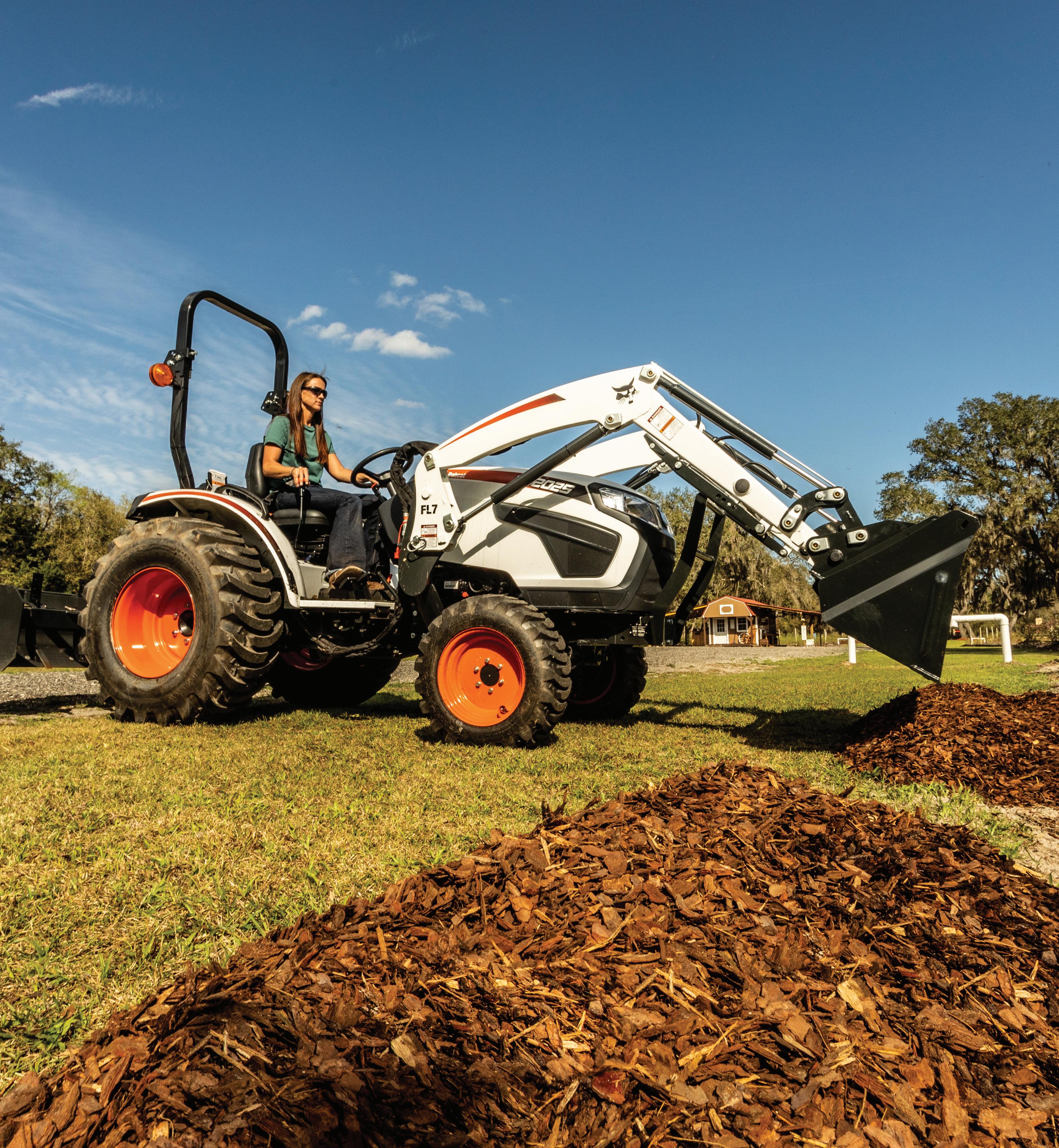

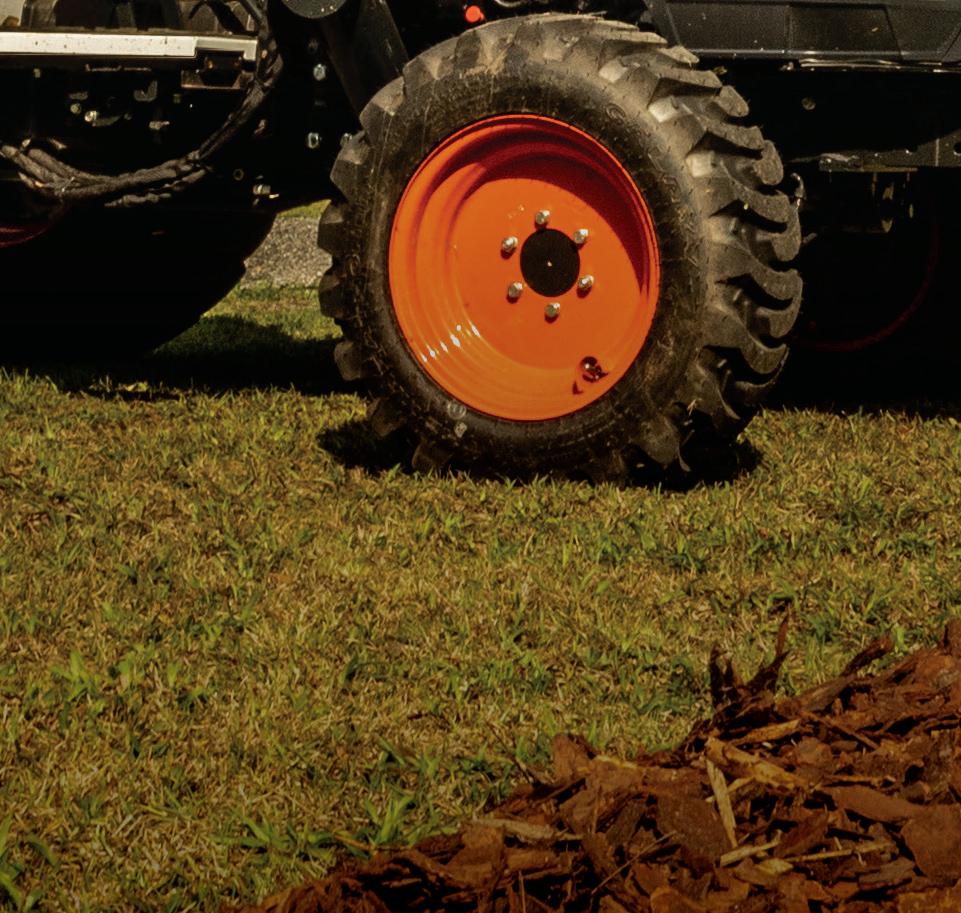
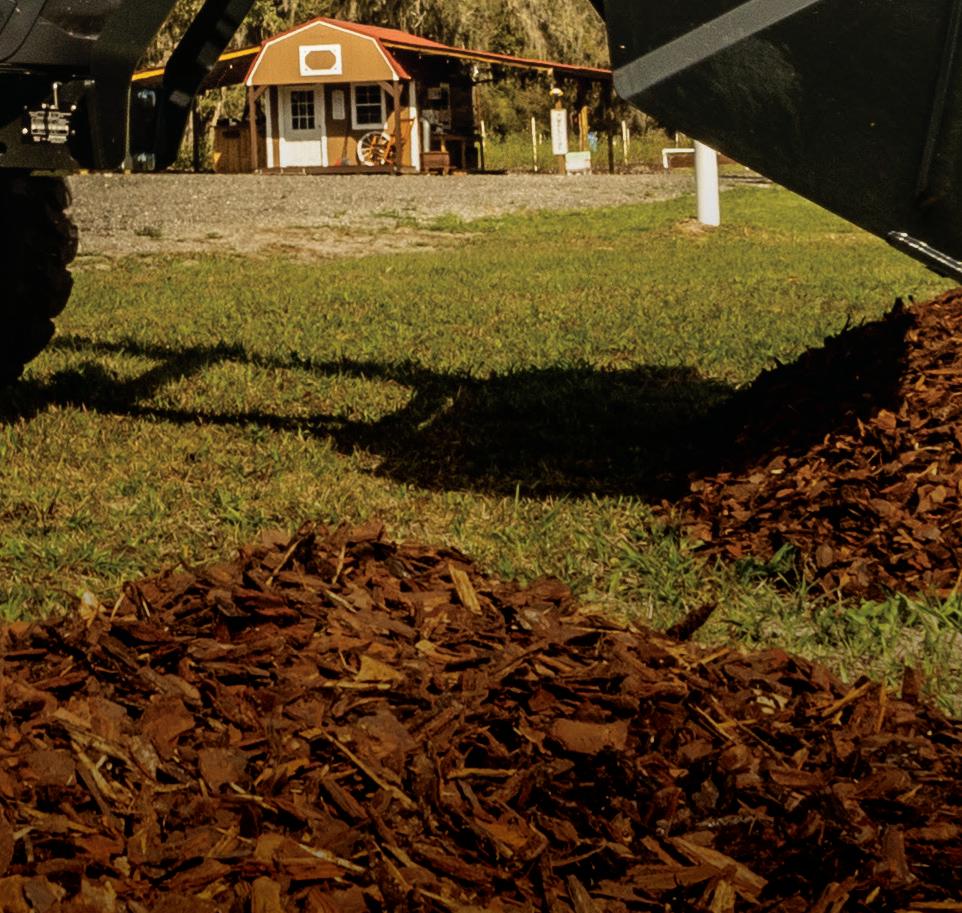








Do the most challenging chores with a Bobcat Compact Tractor. If you have the will to tackle difficult jobs on your property, we have the way. Bobcat Company is a member of the Doosan Group. Doosan is a global leader in construction, grounds maintenance and material handling equipment, power and water solutions, and engineering that has proudly served customers and communities for more than a century. Bobcat ®, the Bobcat logo and the colors of the Bobcat machine are registered trademarks of Bobcat Company in the United States and various other countries. ©2023 Bobcat Company. All rights reserved. | 1544 BOBCAT.COM LOOK FORWARD TO TOUGHER DAYS.
16 Growing Beans

Learn the basics of one of the easiest garden veggies to raise.
20 Practical Pollinator Plots





Begin a year-round garden of bountiful and beautiful native plants.


32 When the Lights Go Out: Weather-Related Power Outages

Knowledge and preparedness is key to anticipating the spectrum of damage that hurricanes, winter storms, and more can bring to the grid.


Healthy Home Cooking
13 Cooking with Goose Eggs
These eggs will quickly become the star ingredient in your favorite dishes, from custards to pastas.




56 A Healthy Dose of Oats

Oats aren’t just for breakfast! Use this versatile food in sweet and savory recipes that are delicious any time of day.

Critter Care

4 Gazette: Giving Feral Kittens a Second Chance

With help, one woman rescues 14 feral kittens and prepares them for adoption.
36 Breeding Ratios for Chickens and Ducks


Find out how many males you need in your flock for fertile eggs.

48 Mobile Poultry Feeder
For easy and efficient meal delivery, this DIY cart is at the top of the pecking order.
70 Making Decisions About Disbudding & Despurring




Knowing when or if you should disbud or despur your animals isn’t always easy.

On the Farm

26 The Power of Hand Tools
Discover eight tools that pack a punch without draining electricity.
30 DIY Garden Spiral
Boost your planting square footage and your garden’s visual appeal by building a spiraling structure in which herbs and flowers can flourish.
40 Tilling a New Garden Bed
Prepare your plot for a new year of growing with this simple yet effective technique.

44 Solid Stonework: Building Thrifty Fence Posts



Turn your extra field stones into homegrown posts, all without using cement.
52 Dickering: The High Art of Going Low
Build camaraderie while standing your ground to get the best bargain in a country negotiation.
F ROM TOP A DOBE S TOCK PASPHOTOGRAPHY ; A DOBE S TOCK / PIYASET
16 In Every Issue 2 Our View 3 Through the Grapevine 8 Mail Call 11 Social Circle 80 Roodoodle Cover: Adobe Stock/HANK GREBE Cover Design: Shelly Bryant MARCH/APRIL 2023 ESTABLISH POLLINATOR PLOT PREPARE FOR POWER OUTAGES GROW BOUNTIFUL BEANS VOL. 141 ISSUE Celebrating Rural America Since 1882 Grow Beans TO SAVE MONEY ON GROCERIES STAY SAFE DURING Weather-Related Power Outages CREATE A POLLINATOR PLOT FOR Bees,Butterflies, and Other BeneficialWildlife Contents March/April 2023
32
On the Cover
Stories with this logo are available in audio form online!
SHARING SPACE
■ This time of year, I find myself thinking more about animals wildlife, farm animals, and pets. No surprise there, as springtime brings an abundance of bounding new life. I can look out my window at any given time and see at least one baby bunny bouncing around in my yard. Yes, they’ll grow up to become menaces to my garden, but for a few short weeks, they bring me joy.
Growing up, I remember animals were a regular part of life on the farm, and I’m guessing many of you can say the same. Some were utilitarian, like the cows we raised for meat; some were beloved pets; some, like the barn cats, fell somewhere in between; and others, like the coyotes we’d hear at night, were wildlife we’d try to deter from coming too close to the property.
At an early age, we were taught to respect and care for animals of all shapes and sizes, but to recognize when an animal was a permanent part of the farm and when it was there to serve a temporary, utilitarian purpose. Don’t get attached to the cows, for example. Treat them well and give them a good life while they’re here, but don’t grow too fond of them. This mindset isn’t always met with agreement, but it’s the way of life on a farm. And few people love and care for their animals as well as farmers and ranchers do. From pulling calves in sub-zero temperatures to staying up multiple nights with a sick animal, there’s little farmers won’t do to care for the creatures under their stewardship.
These days, the only animal in my care is a persnickety house cat. Beyond catching mice, his main job is to provide warm snuggles and keep my internal clock ticking he never lets me forget it’s time for a meal. He may not be the most utilitarian of animals, but he’s an adored member of the family.
Outside of the house, and my immediate care, there are plenty of wild creatures running around my neck of the woods. I particularly enjoy the wild birds. I’ve taken to feeding them the past few years, and, this time of year, it’s exciting to see the springtime feathered friends return. I live in a neighborhood, but that doesn’t stop the opossums, squirrels, aforementioned rabbits, groundhogs, and foxes from making a regular appearance as well. Though it means I have to guard my garden with extra fortitude, and it highlights the troubling fact that humans have encroached far into wildlife habitat, I can’t help but smile when I see those baby bunnies.
What creatures, large or small, are part of your life? I’d love to hear about them and see photos, if you have them. Drop me a note at ASarkesian@ OgdenPubs.com.
Happy spring!
Allison Sarkesian, Senior Editor ASarkesian@OgdenPubs.com
VOLUME 141, ISSUE 2

ISSUE EDITORS
ALLISON SARKESIAN, Lead Editor

OSCAR H. WILL III, Editor at Large
EDITORIAL TEAM
INGRID BUTLER
KARMIN GARRISON
REBECCA MARTIN
JESSICA MITCHELL
ILENE REID
AMANDA SORELL
JEAN TELLER
CARLA TILGHMAN
ADVERTISING DIRECTOR
BRENDA ESCALANTE; BEscalante@OgdenPubs.com
ART/PREPRESS
SHELLY BRYANT, Art Director
WEB AND DIGITAL CONTENT
TONYA OLSON, Digital Content Manager
DISPLAY ADVERTISING
800-678-5779; AdInfo@OgdenPubs.com
CLASSIFIED ADVERTISING

866-848-5416; Classifieds@Grit.com
CUSTOMER CARE 866-803-7096
CustomerService@OgdenPubs.com
BILL UHLER, Publisher
MARISSA AMES, Editorial Director
CHERILYN OLMSTED, Circulation & Marketing Director
BOB CUCCINIELLO, Newsstand & Production Director
BOB LEGAULT, Sales Director ANDREW PERKINS, Director of Events and Business Development
TIM SWIETEK, Information Technology Director ROSS HAMMOND, Finance & Accounting Director
Grit Magazine (ISSN 0017-4289)

March/April 2023, Vol. 141, Issue No. 2. Grit is published bimonthly by Ogden Publications, Inc., 1503 S.W. 42nd St., Topeka, KS 66609-1265. Periodicals Postage Paid at Topeka, KS and additional mailing offices. POSTMASTER: Send address changes to Ogden Publications, Inc., 1503 S.W. 42nd St., Topeka, KS 66609-1265. For subscription inquiries call: 866-803-7096
• Outside the U.S. and Canada, call 1-785-274-4361 • Fax: 785-274-4305
SUBSCRIBERS: If the Post Office alerts us that your magazine is undeliverable, we have no further obligation unless we receive a corrected address within two years.
©2023 Ogden Publications Inc.
Printed in the U.S.A.
In accordance with standard industry practice, we may rent, exchange, or sell to third parties mailing address information you provide us when ordering a subscription to our print publication. If you would like to opt out of any data exchange, rental, or sale, you may do so by contacting us via email at CustomerService@ OgdenPubs.com. You may also call 866-803-7096 and ask to speak to a customer service operator.
A llison s A rkesi A n
® Our View March/April 2023 2
Here’s how to make a natural oven cleaner. Pour ¼-inch layer of baking soda over the bottom of your oven. Next, wet the baking soda with water using a spray bottle, and spray every few hours so the baking soda doesn’t dry out. Let sit overnight. In the morning, clean out the dried baking soda and grime and rinse the residue.

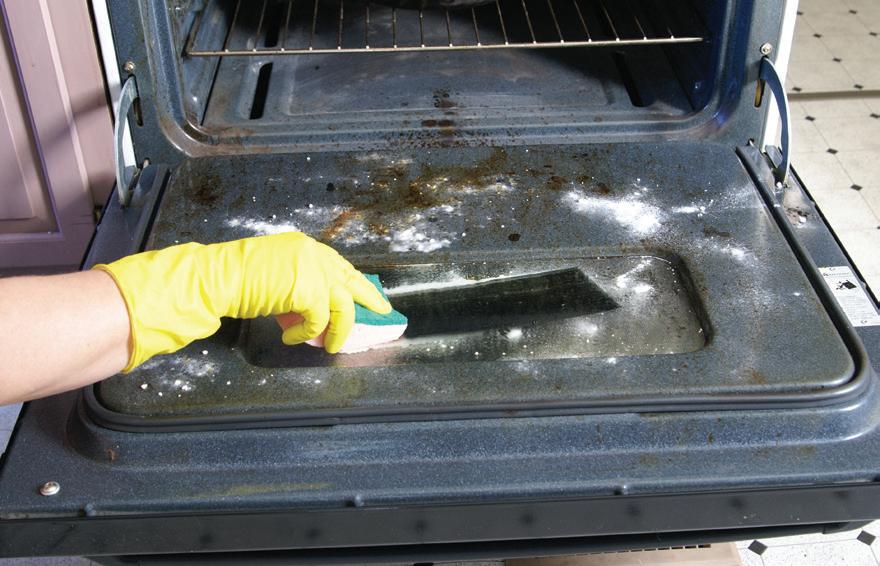 SHEILA CARPENTER ST. CLOUD, MINNESOTA
SHEILA CARPENTER ST. CLOUD, MINNESOTA
Veterinary care can be expensive, especially when you have older pets or more than one. People wanting or needing to cut costs often turn to shopping online or over the counter for medications or flea and tick control. It’s important to use extreme caution with those products. They may harm or kill your pet or do nothing at all. Also, the packaging or name may be familiar but could actually be a counterfeit that may be dangerous for your pet. No matter the advertising claim, always check with your vet before administering anything internally or topically.
 MARILYN GILL VIA EMAIL
MARILYN GILL VIA EMAIL
Most rot that occurs in fence posts occurs in the first 10 to 12 inches of the soil. With this in mind, it’s time to rethink methods of setting fence posts.
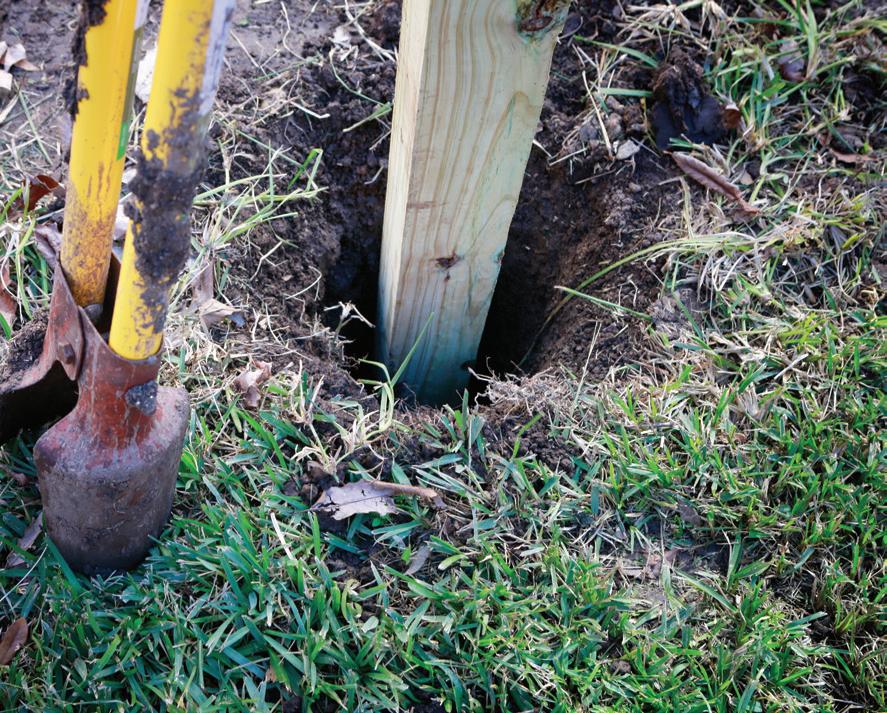
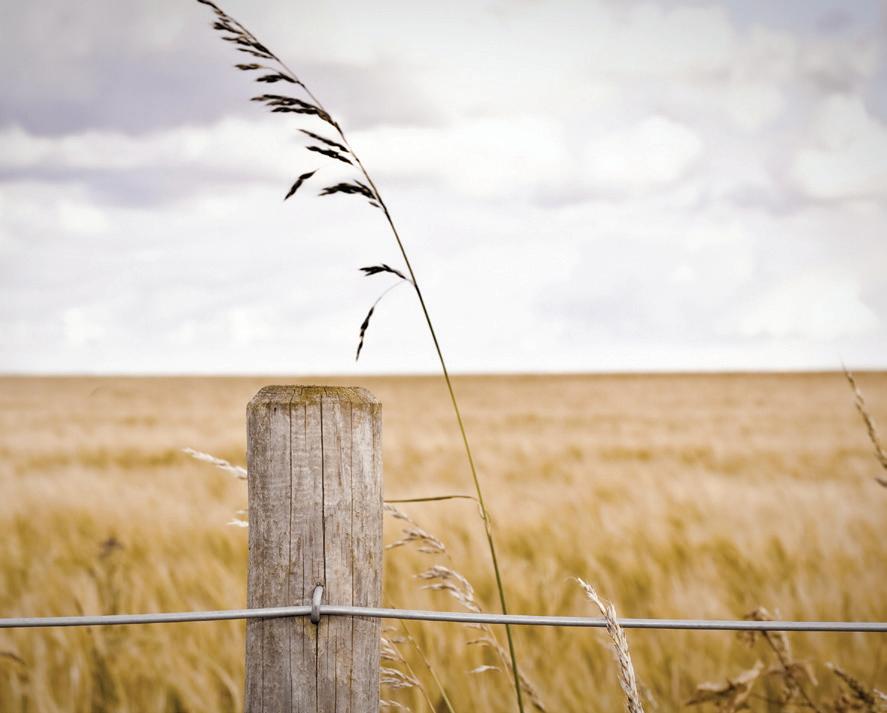
Traditionally, if a post hole isn’t completely filled with concrete, the bottom ½ to 2⁄3 will be, and the remainder will be filled with dirt. In reality, the opposite should happen. The hole should be firmly tamped at the bottom with dirt and rocks, and, after thoroughly wetting the hole, concrete should be put in the last 12 to 15 inches. Concrete should extend above ground level, forming a low tent at the base of the post to ensure water doesn’t stand near the bottom of the post. Properly set in this manner, the fence post will last many years with little or no maintenance.


FLOYD NORSKOG KANAB, UTAH
If you have garden, farm, or home advice you’d like to share, send an email to Letters@Grit.com, or mail a letter to 1503 SW 42nd St., Topeka, KS 66609. We pay $25 for each tip we publish.

FROM RURAL
READER TIPS
AMERICA
Take Caution with Home Vet Remedies
Set a Fence Post Visit www.Grit.com and search “reader letters” to see what other members of the GRIT community have been up to lately. C LOCKWISE FROM TOP RIGHT A DOBE S TOCK / TRGOWANLOCK ; A DOBE S TOCK /G ALINA S T A DOBE S TOCK /KE M AGOON A DOBE S TOCK /K ATHY B URNS www.Grit.com 3 Through the Grapevine
Simple Oven-Cleaning Solution
Properly
GIVING FERAL KITTENS A SECOND CHANCE


With help, one woman rescues 14 feral kittens and prepares them for adoption.
By Cathie West
■The country property my husband and I purchased in northeast Washington came with a 1935 farmhouse, several rustic barns, and a pack of feral cats. Most of these critters were just passing through, but five decided to take up residence in an old cow barn. We didn’t mind the arrival of these felines, because within a short time, the destructive rodents near our barns, fields, and garden plots were history. A neighbor from a nearby farm, however, warned us that feral kittens would be the next arrival one abundant batch after another.
Estimates for the number of feral cats in the United States vary drastically, but the Humane Society suggests there are 30 to 40 million. Unspayed cats can produce 2 to 3 litters a year. In agricultural areas, the offspring can be found in barns, henhouses, haylofts, tool sheds, and livestock shelters just about anywhere a pregnant feline feels safe delivering her brood.
Accordingly, we implemented a trap-neuter-return (TNR) program. TNR is a long-term program designed to humanely reduce the feral cat population through sterilization. Feral cats are humanely trapped, sterilized, vaccinated, and then released back into their community. Sterilized feral cats are identified by an ear tip or ear notch. In our case, catching these fearful felines took a bit of work, since our feral cats were difficult to trap. Fortunately, our vet remained on-call to spay the females and neuter the males. Meanwhile, the cats we believed to be females proved us right by delivering
Gazette March/April 2023 4 A dobe S tock /R eflexpixel
14 kittens between the two of them. We found their tiny babies in a hay bin when the kittens were about 2 weeks old: Their ears had unfolded, and their eyes which were blue at first were beginning to open.
The Hard Life of a Feral Cat
Feral cats are cats that weren’t around people during their early life (usually before 9 weeks, a critical period for socialization). As a result, they’re afraid of humans and often run away when approached. Feral cats can’t be touched, picked up, or held by people. For many of these cats, life is bleak. While the average cat can live 10 years or more, the feral cat’s life span is just 2 to 3 years.
This drastic drop in life span can be attributed to the many hardships feral cats endure. They have meager shelters during extreme weather conditions; can suffer from flea infestations, disease, and infections; and often face mistreatment from unkind humans. Predators, including dogs, coyotes, wolves, and raptors, pose further danger.
Lending a Helping Hand
Deciding what to do with the 14 kittens was easy. Animal shelters are overpopulated and understaffed. Euthanasia wasn’t an option. So, it was up to us to socialize these fragile kittens and get them ready for adoption. Otherwise, they’d face the harsh realities of feral life. Socializing the kittens required moving them into our home, where we could overcome their fear of people by providing ample positive interactions. Figuring out when to move the kittens from the barn, however, was difficult, since one of the two mother cats was dedicated to nursing the huge brood. We knew her milk was vital for getting the kittens off to a good start. Several events led us to move the kittens after they were 3 weeks old. First, they weren’t getting enough milk from just one mother cat and appeared weak. Second, some of the kittens’ eyes had crusted over and were only partially opened these nearly blind babies needed a vet exam. Finally, the two mother cats had begun hiding the kittens. We understood their
protective instinct, but concealing the kittens jeopardized their survival. After two days of intensive searching, we found all 14 of the critters in the barn’s attic loft, behind shelving units, under storage cabinets, and even outside in tall grass next to the barn. We collected the kittens in small batches in a cat carrier, and then transported them to our house.
A New Home
We set up a kitten abode in a safe, secluded area of our basement in advance. Our setup included a large fleece-filled

Equipment and Supplies
Nourishment
• Dry kitten kibble
• Soft canned kitten food
• Fresh, clean water
Food Station
• Sturdy water bowls
• Sturdy food bowls
• A plastic tray to hold the bowls
Litter Box Area
• Large, shallow plastic tub to hold litter
• Litter that clumps and has a pleasing odor
• Litter scoop for picking up solid deposits
• Receptacle with lid for deposits
Sleeping Provisions
• Plastic tub large enough to hold all the kittens
• Fleece blankets in cold months
• Large, soft towels in warm months
• A solid electric heating pad for the floor (small to medium sized)
Kitten-Sized Toys
• Balls
• Squeaky toys
• Action toys that move
• Climbing structures (such as cardboard boxes)
Housekeeping Supplies
• Dustpan and brush for sweeping up spilled litter

• Cleaning cloths for accidents
• Water for cleanups (no chemicals)
Gazette www.Grit.com 5
c A thie W e S t
Kittens can be spayed or neutered once they’re 8 weeks old. Many places offer low-cost sterilizations.
Helpful Resources
the kitten’s eaten, give it time to digest the food and then place it into the litter box. The kitten will dig a hole, make a wet or solid deposit, and then cover it up. Truly amazing! However, expect a few accidents in dark corners, on bedding, and under furnishings. In a short time, however, kittens will prefer to use a litter box.
Socialization Schedule
old — not easy, since they were in constant motion. But we were patient and willing to take 10 photos of a kitten to get one good one — meaning the photo wasn’t blurry!
sleeping tub and, for extra warmth, a hard-panel heating pad on the oor nearby. Other accoutrements included a feeding station, a couple of litter boxes, and lots of toys. During their rst week with us, the kittens mostly snuggled under their blanket for warmth and security. They slept most of the time, but gradually they could be coaxed out to meet us and explore. Even then, they’d run and hide if unsettled by a noise or an attempt to pick them up. Once they began to trust us, however, they were eager for human talk and touch.
Health and Nutrition
Nourishment was a major concern. We provided soft cat food twice a day and had dry kitten kibble and fresh, clean water always available. The kittens had voracious appetites! The only health concerns were with the kittens with partially opened eyes. Our vet prescribed antibiotic eyedrops and an oral equivalent administered twice daily. After a week of treatments, their vision setback was corrected.
Litter Box Training
How do you train a kitten to use a litter box? Kittens younger than 20 days old may need help from their mother or a human caretaker to eliminate bodily waste. If the kitten is 20 days old or more, however, litter box training is pretty simple. After



By the time the kittens were 6 weeks old, they were interacting with us con dently, playing exuberantly with each other, and investigating the toys. Our socialization goal required us to handle, hug, and hold each kitten twice a day. Repeated exposure was necessary to overcome their natural shyness and their instinct to hide. Scheduling these kitten encounters into a busy farm day was tricky, but since my husband and I took turns, it was doable. Besides, listening to a kitten purr when you hold it over your heart is a treat.
Ready for Adoption
Ideally, kittens would spend 10 to 12 weeks with their mother before being put up for adoption. Since we didn’t have a mother cat to nurse the kittens or teach them feline skills, we took steps to adopt them out at 10 weeks. We began snapping photos when the kittens were 9 weeks

The photos were sent to family, friends, and neighbors who, in turn, shared them with others. We also posted them to a community classi ed website. The response was immediate and enthusiastic, but how would the kittens handle this attention? Thankfully, the kittens were real troopers. When meeting with potential adopters, they remained calm and open to interacting with unfamiliar people.
We released kittens to reliable adults — usually with children in tow — and provided each adoptive family with an equipment and supply list. We also requested the kittens see a vet to be vaccinated and neutered. Within a week, each of the 14 kittens had found a supportive home. Watching adoptive families hug their kittens was especially sweet and immeasurably rewarding.
Cathie West is a retired educator who has written professionally for publishers of educational books and magazines. She lives with her husband on a picturesque farm in northeast Washington, where they raise poultry and grow alfalfa, hay, vegetables, fruit, and nuts.
Gazette March/April 2023 6
The Humane Society’s Outdoor Cat FAQ www.HumaneSociety.org/Resources/OutdoorCats-FAQ Alley Cat Allies’ Guide to Determining the Age of a Kitten www.AlleyCat.org/Resources/KittenProgression
Alley Cat Allies’ Guide to Trap-Neuter-Return www.AlleyCat.org/Our-Work/Trap-Neuter-Return
C ATHIE W EST (2)
Don’t list a kitten as free. Instead, charge a nominal re-homing fee to weed out people who intend cats harm.
Progressive Casualty Ins. Co. & af liates. Coverage features subject to policy terms, and may not be available in all states or for all vehicles. Additional charge and deductible apply. Prices vary based on how you buy.










































































See #21 on page 60



COMMUNITY MATTERS


In response to “To the Community” (Our View, July/August 2022), my wife and I live on a small farm. We’re on 10 acres; our garden is 15 by 30 feet, and we have two horses and a miniature horse. We attend a small church about 30 minutes from our home in Newnan, Georgia. Our church does an outreach program called “Serve.” Every first Saturday, members and nonmembers go into the community and do a wide variety of projects — from building accessibility ramps to feeding the elderly and everything in










between. We don’t have to do it, we get to do it; this is our motto. There’s no better feeling than giving back. My wife and I are well into our 60s and have great health. I feel it’s because we’re blessed by blessing others. Thanks for all the unbelievable stories you share with us every issue. Give back and experience the blessings.

C LOCKWISE FROM TOP : A DOBE S TOCK /B ELLA B P HOTOGRAPHY ; S HUTTERSTOCK / ADDKM S HUTTERSTOCK /R AWPIXEL COM
GRIT
EMAIL March/April 2023 8
READER VIA
Crawfish for Dinner
Two of our grandsons took a liking to craw sh so much that they sat patiently, catching a bucketful for dinner.
 LISA BASINGER ELK, WASHINGTON
LISA BASINGER ELK, WASHINGTON
Trimming Chewed-Up Trees
Beavers took my pear trees down to 8 inches (and one of them down to nothing). The other two have started looking like 21⁄2-foot bushes. How should I trim them?
LELAND W. GRIFFIN JR. VIA FACEBOOK
Hi, Leland,
You can retrain the other two to a short trunk by pruning to the three best-shaped stems coming up. As long as your hard-freeze date is at least 30 days out and you’re no longer in the 90s, you can prune back to those three now. If not, wait until the trees have gone dormant. Check to make sure that your growth isn’t coming from the rootstock, because the pear might not be what you’d prefer. Another item to note: It might take up to another three years before the fruiting spurs develop.
WILLIAM HABBLETT HORTICULTURIST AND PLANT DIAGNOSTICIAN
GRIT Delivery Memories
It’s great to reconnect with Grit after about 70 years. I had a Grit delivery route in Roxton, Texas, around 1951. They cost 5 cents each. I had about 30 customers. I think they were delivered to me weekly. I really did enjoy the rst copy I received. Two rich ladies (sisters-in-law) alternated buying all the papers. I just had to deliver them to the customers, most of whom were elderly. They looked forward to getting news from the outside world.
JAMES TABOR LUBBOCK, TEXAS
Reconnecting with GRIT
I started reading Grit when it was in a newspaper when I was a child. That was about 70 years ago. Young kids sold Grit, which was very popular in Missouri, where I lived. I found this again as a magazine several years ago and was delighted. It’s one of the best informative magazines available for families in general. We live in a town now, instead of on the farm, but we couldn’t give up our Grit magazine. Keep up the good work.
GRIT READER CHULUOTA, FLORIDA
Looking For RECIPES
I’m a writer working on a dessert cookbook looking for different recipes for pies using all kinds of berries. Also, I’m looking for culinary-interested pen pals who have a passion for writing about food.
Kevin Harmon
17019 County Farm Road Rushville, IL 62681
PEN PALS
I’m looking for pen pals who still collect stamps. I have lots of new and canceled stamps I’d like to trade.



Una Kuhn
507 Wilbur St. Admire, KS 66830

CLOTHING AND CRAFT SUPPLIES

I’m looking to pay cash plus postage for scrubs tops with pockets, large and extralarge, all prints; T-shirts with skulls, monsters, or sayings on them, large and extra-large; old greeting cards for crafts; red-print quilt fabrics; and old, thick felt, like we had 50 years ago. I’ll answer all. I’m 76 and have rescue dogs. I watch DVDs, read, and sew.
Susie Smith
2981 W. 700 S. Morocco, IN 47963
Share Your Thoughts
We welcome letters from our readers. If you’d like to comment on an article, share your opinions, or submit a “Looking For,” send us an email (with photos, if available) to Letters@Grit.com, or send a letter to: GRIT Mail Call, 1503 SW 42nd St., Topeka, KS 66609. Electronic submissions are more likely to receive a timely response. Readers assume all risk associated with publishing a mailing address, requesting correspondence, and responding to correspondence requests in GRIT magazine.
Mail Call F ROM TOP : L ISA B ASINGER A DOBE S TOCK / ROXXYPHOTOS
www.Grit.com 9
Response to ‘Use It Up, Wear It Out’



I’ve recently been blessed by a friend with a couple of your publications. I have to admit, they’re a delightful read.
One reason I’m writing (aside from my joy of writing letters) is your wonderful editor’s piece, “Use it Up, Wear It Out” (Our View, May/June 2022).








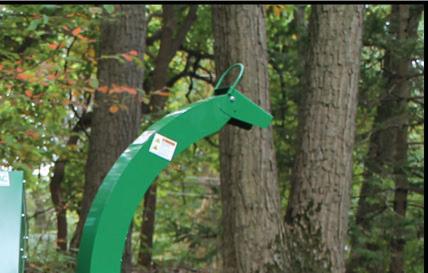


The piece struck me, since my mother is a quilter and, as Caitlin does, never throws out fabrics.

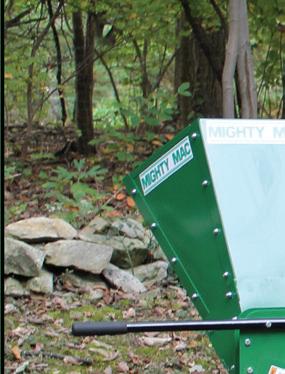
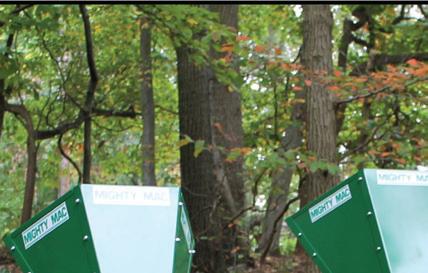
My mother was nally able, after many years, to purchase a long arm for her quilt-making. I’ll include a picture of one she made. She also uses her pieces of material to make ornaments, something


you may consider with a smaller collection of fabric.
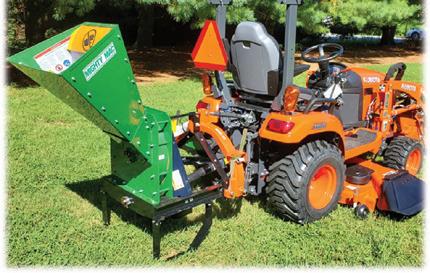


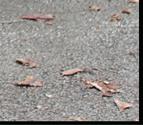
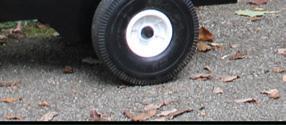
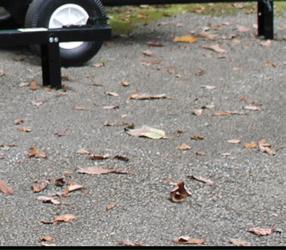
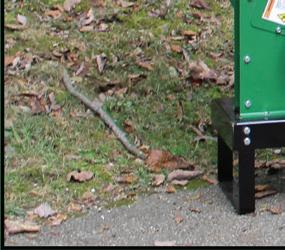
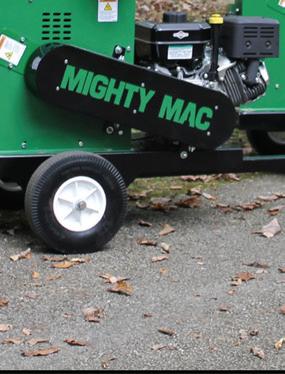
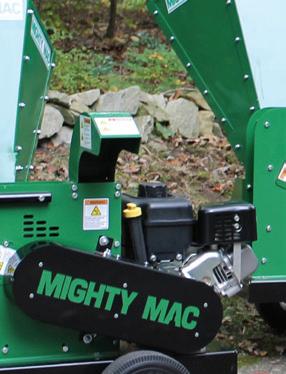

When I return home in a few months, my mother will teach me how to use her many machines. I’ll aid her and eventually take over her craft with the quilts.

Mail Call
See #15 on page 60 J ASON (2) WC375 3 3/4” Chipping Capacity WC475/WC475E 4 3/4” Chipping Capacity WC575E 5 3/4” Chipping Capacity www.MacKissic.com 1-(800)-348-1117 info@MacKissic.com Proudly Made Three Point Hitch Also Available Specialty lawn & garden equipment to help the DIYer easily maintain their properties and lifestyle 12PT Features a wide opening hopper that can process bushels of material fast and efficiently. in the USA Wood Chippers and Shredder-Chippers March/April 2023 10
JASON DEER LODGE, MONTANA
We have some exciting new and returning guests for this year’s season of the “Mother Earth News and Friends” podcast! This podcast is produced by our sister publication Mother Earth News. Explore more episodes at www.MotherEarthNews.com/ Podcast or wherever you listen to podcasts.
EXPLORE GRIT.COM
Communications: Where to Listen & How to Reach Out




 By Kyle Ferlemann
By Kyle Ferlemann
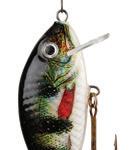
The ability to receive information and communicate with family and the outside world when cellphones and internet are out will be important to you during a disaster. There are several options for emergency communications that are inexpensive and easy to use. Shortwave lets you listen to emergency broadcasts, talk locally, and even communicate around the world. It’s relatively inexpensive and easy to get the equipment you need to stay informed during an emergency.
One of the best things you can do to help yourself in a disaster situation is to learn how to collect as much information as possible. Well before you need to call for help, you’ll want reliable information on the situation. As far as disasters are concerned, or even temporary power outages caused by nasty weather, shortwave radio communication is your friend.
Learn more about weather radios, citizens band radio (CBs), and ham radio at www.Grit.com/Emergency-Communications.
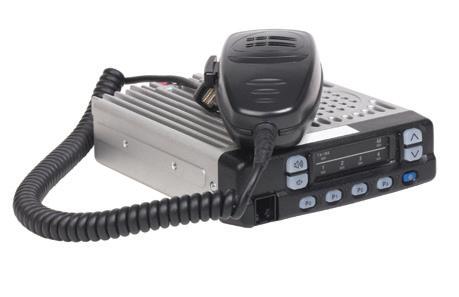
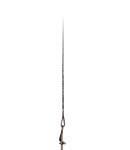
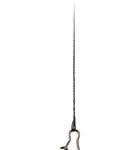
Featured Quote
“And so it was that we were treated to an intimate look at the ritual of a home-building, egg-laying, patiently setting, demure little bird that blinked her dark-brown eyes at us as we peeked at her from mere inches away.”
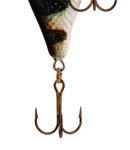


— Polly Rogers Brown, from “A Wren Nest in Dad’s Bib Overalls,” at www.Grit.com/Wren-Nest-Story




Our Readers
65% want to learn more about animal and livestock protection
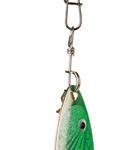








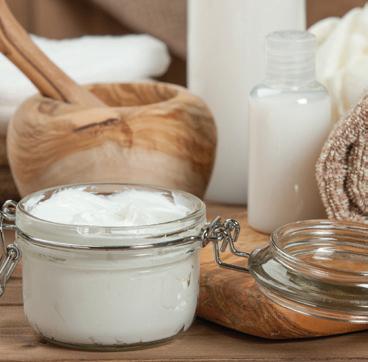


RECIPE CORNER Shaved Asparagus Salad Recipe
As one of the most delectable harbingers of spring, asparagus spears will soon be poking up along fence lines and in gardens and gracing supper tables once again. And it’s about time, right? Before we know it, farmers markets will be full of those tenderly succulent delicacies we’ve been craving for far too long, and asparagus that favorite little spear will be among those leading the pack. Here’s a simple asparagus recipe to help you take advantage of the bounty. But don’t be deceived by its simplicity; less is truly more whenever asparagus is the star.
When most people think about their favorite asparagus dishes, a raw preparation doesn’t generally come to mind. Although a classically trained chef, I could even count myself among those numbers that is, until I started farming a few years back and had the opportunity to taste asparagus as it was meant to be eaten , right out of the ground! Once the woody part of the stem is removed, the tips are delicately sweet with just a hint of nuttiness the perfect base for a light spring salad.
Sarah Sinning,

at www.Grit.com/Asparagus-Recipe
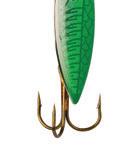
Social Circle SEASONAL PROJECTS Find these articles on Grit.com! Elbow Grease: A Homemade Lotion for Dry Skin Repair Your Doors and Windows 32% ferment their own food or drinks 52% hunt or fish @GritMagazine @Grit1882 Sign up for our newsletter at www.Grit.com JOIN THE CONVERSATION! FOLLOW US ON:
Catching Up With Our
TUNE IN TO OUR PODCAST
Ep. 170: Dr. Temple Grandin on Living More Sustainably in the New Year
C LOCKWISE FROM TOP LEFT C OURTESY OF R OSALIE W INARD A DOBE S TOCK / RANDIMAL A DOBE S TOCK /G RESEI (2); A DOBE S TOCK / SUNNY BUNNY A DOBE S TOCK /I RIANA S HIYAN ; A DOBE S TOCK /K ORTA ; A DOBE S TOCK / FOTOMASTER
www.Grit.com 11
What’s Growing Around You?









Share your visual perspective with the GRIT community. Post your photos at www.Facebook.com/GritMagazine, or tag us on Instagram (@Grit1882). We chose several of the images you see here from those platforms, and you can find more photos on our website. Share your best shots, and we just might select one of your photos for a future issue of the magazine.
Since it’s been too cold for outdoor plants, Lorie nurtures houseplants instead.
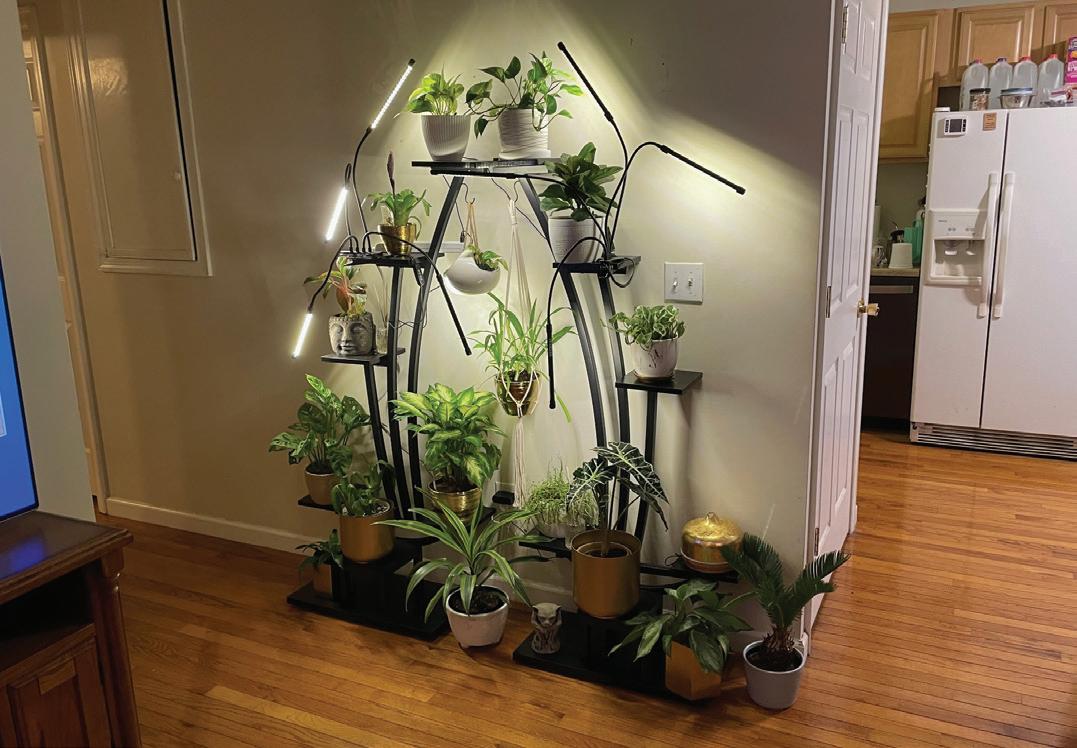

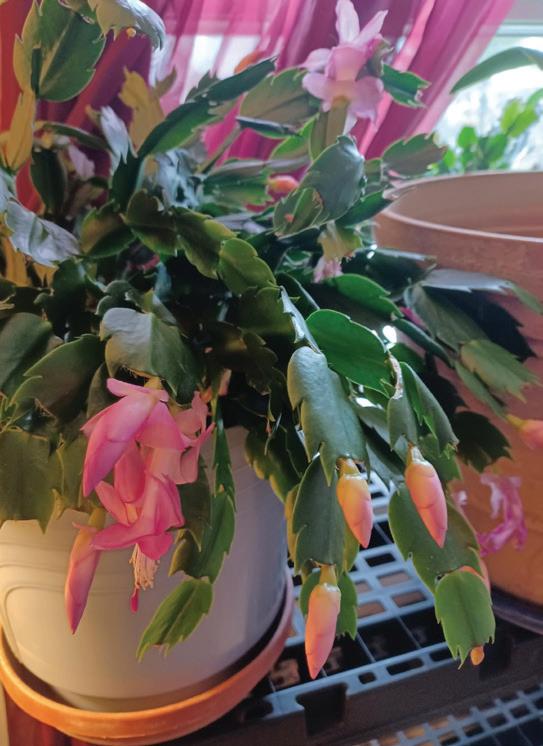

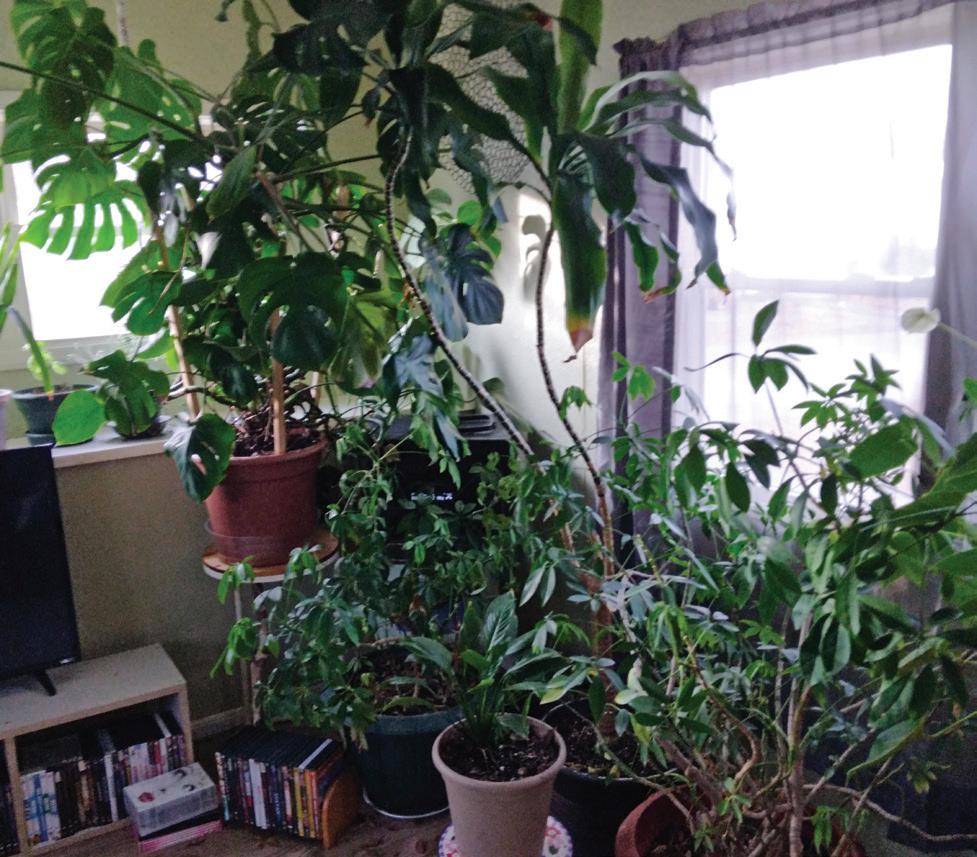





 Both Vi (below) and Deborah (above) have enjoyed cultivating their houseplants.
Both Vi (below) and Deborah (above) have enjoyed cultivating their houseplants.
C LOCKWISE FROM TOP RIGHT : T AMRA L OCKARD (2); L ORIE B RUER (2); V E RNST (2); D EBORAH C URCI (2) March/April 2023 12
Inside, Tamra’s Anthurium flourishes (left), and outside, her nandina bush shows off bright-red berries (right).
COOKING WITH GOOSE EGGS
 By
By
■What do you do with an egg that’s two or three times the size of a chicken egg, with an almost 1-to-1 ratio of yolk-to-white and a thick, hard-to-crack shell? You’ve got yourself a goose egg, and while they aren’t commonly seen on menus, they’re the key ingredient in some delicious recipes.
Unlike chickens and ducks, geese are seasonal layers that produce only 50 to 100 eggs a year, depending on the breed of goose. These eggs are laid in springtime, approximately February through May, and require some skill to collect, as geese are notoriously protective of their nests. Once safely in your kitchen, a goose egg is an intimidating thing. It can weigh up to 200 grams, compared with a chicken egg’s 50 to 70 grams. When cracked open, the yolk is massive and deeply orange, and the white is thicker and harder to whisk than those of other eggs.
Everything is bigger in a goose egg. These eggs have more protein, calories, and vitamins than their chicken-laid
equivalents. They also have a stronger flavor; the size and deep-orange color of their yolks means they’ll make a colorful batter, and the denseness of their whites means using them in a batter will create a thicker, denser mix.
While it may seem like having 50 to 100 eggs in springtime isn’t much if you have geese, you’ll be surprised how quickly goose eggs can overwhelm you. So, what do you make with these immense delicacies? The following recipes are a few favorites to create with goose eggs.
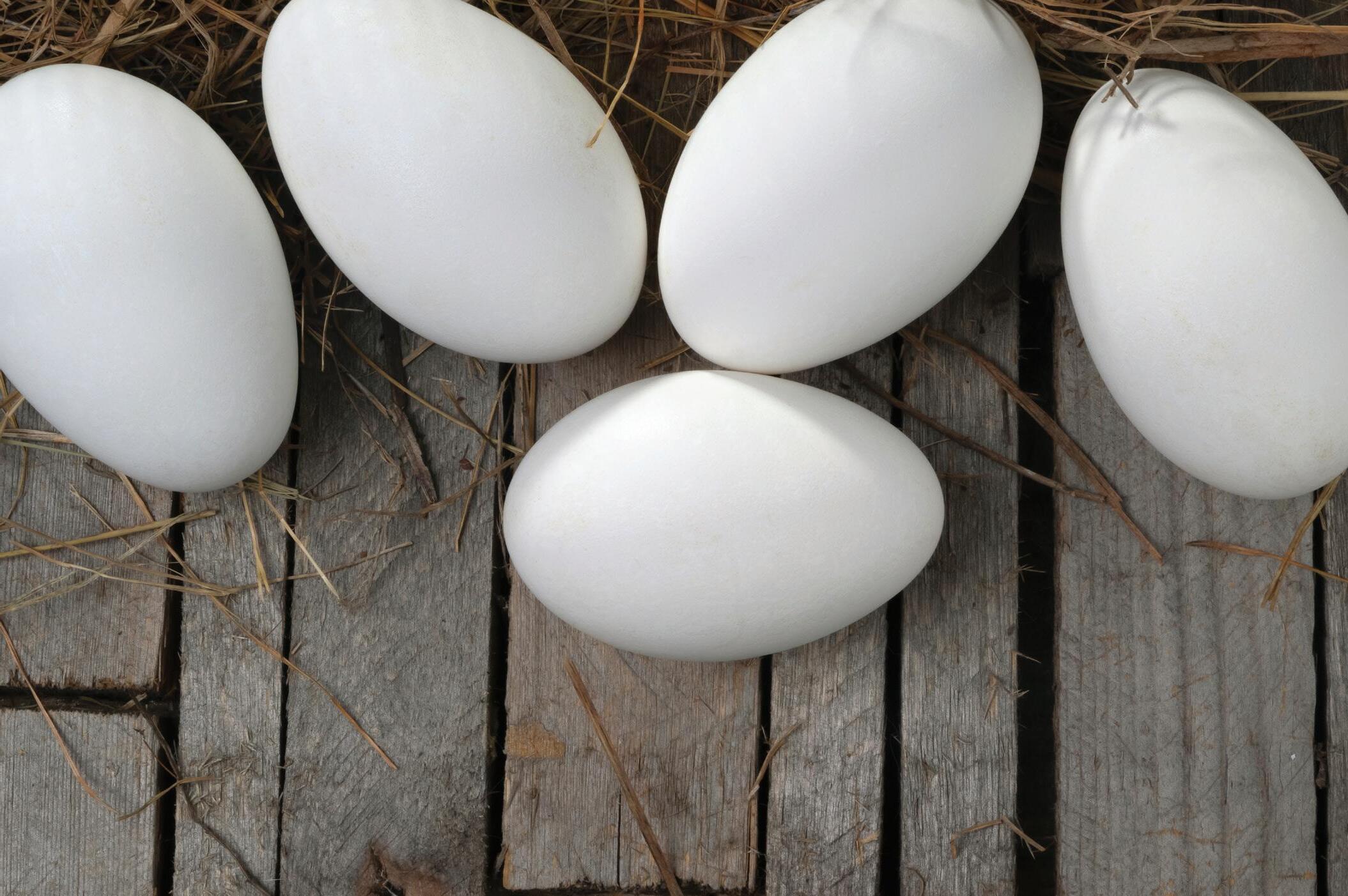
In addition to these recipes, goose eggs can be fried up just like a traditional breakfast egg! They can be hardboiled as well, taking 10 to 13 minutes compared with a chicken egg’s 5 minutes. Include them in any recipe that calls for eggs just account for their size.
When cooking with goose eggs, you’ll find that recipes can be richer and tastier. Plus, it’s always fun to explain these eggs and show off their huge shells to guests before delighting them with a custard or
homemade pasta. Don’t let a good goose egg go to waste!
SINGLE GOOSE EGG OMELET
One goose egg is the perfect size for making a single-serving omelet. You can mix in any tasty additions you’d like. Yield: 1 serving.
2 tablespoons butter, divided ½ onion, chopped ½ cup mushrooms, chopped
1 goose egg
2 ounces shredded cheddar cheese
Salt and pepper, to taste
1. In a cast-iron skillet on mediumhigh heat, melt 1 tablespoon butter. Sauté onion and mushrooms until browned, and then remove from heat.
2. Using a clean skillet, heat 1 tablespoon butter. As butter melts, crack goose egg into a small bowl and whisk until well-mixed.
Comfort Foods www.Grit.com 13
These eggs will quickly become the star ingredient in your favorite dishes, from custards to pastas.
A dobe S tock o k SA n A
Kirsten Lie-Nielsen
3. Pour egg into the skillet, and cook until edges are set. Add onion-andmushroom mixture and cheese to half the egg. Add salt and pepper, and cook for another 1 to 2 minutes.
4. Use a spatula to fold and serve the omelet. Enjoy with a side salad.

GOOSE EGG CUSTARD
Possibly the tastiest goose egg recipe, this custard is melt-in-your-mouth delicious. Yield: 1 custard.
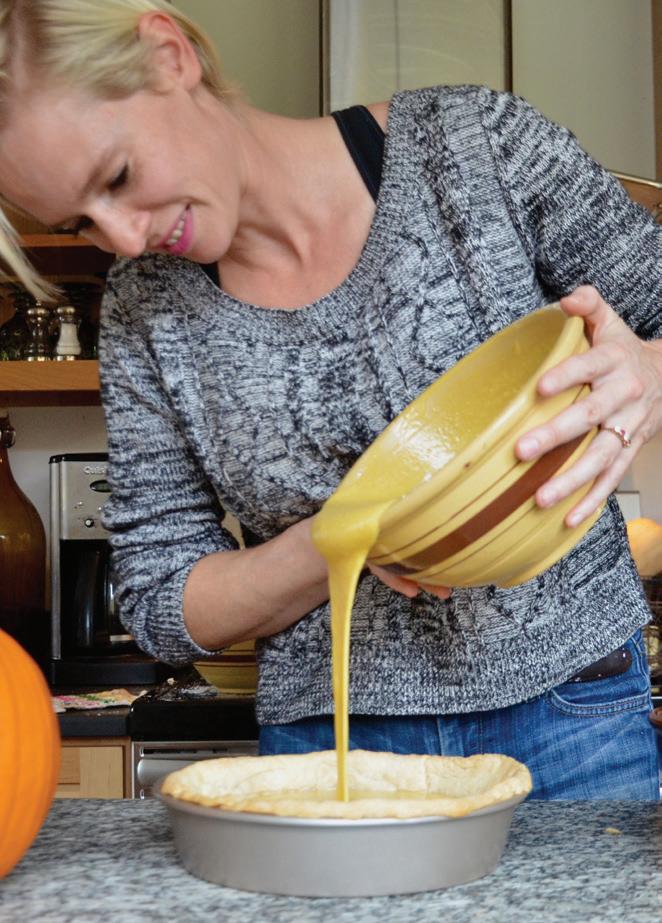

4 cups whole milk
2 goose eggs
1/2 cup maple syrup
Pinch of salt
1 tablespoon vanilla extract
1. Preheat the oven to 325 F. Place a large baking sheet in the oven with about 1 inch water in the tray to warm with the oven.
2. Heat milk in a saucepan, stirring regularly, until it begins to simmer.


3. Mix together goose eggs, maple syrup, salt, and vanilla in a large bowl. Very slowly, pour egg mixture into hot milk, stirring constantly.
4. Pour mixture into an 8-inch pie pan or prepared ramekins. Place custard carefully onto baking sheet in the water. Bake for about 40 minutes, or until the custard sets and is jiggly.
GOOSE EGG PASTA
Goose eggs are particularly prized by pasta-makers, because their colorful yolks make for a bright-yellow pasta. Here’s a simple at-home pasta recipe using a single goose egg.
2 cups all-purpose flour
1/2 teaspoon salt
1 goose egg
3 tablespoons cold water
¼ cup olive oil
1. Whisk flour and salt together in a large bowl. In a separate bowl, beat egg. Add water and olive oil to egg and mix together.
2. Pour egg mixture into flour mixture. Combine until a stiff dough forms.
3. Pour dough onto a floured surface and knead for 10 minutes. Cover dough and let rest for 20 minutes.
4. Turn dough out onto a floured surface and use a rolling pin to roll it out, letting it rest periodically, until the pasta is very thin. Let it rest again, preferably over a pasta dryer, for 45 minutes.
5. Finally, slice pasta into thin slices (to your preference). Drop pasta into boiling, salted water, cook for 3 to 4 minutes, and serve.
Kirsten Lie-Nielsen is an author and farmer in Liberty, Maine, where she and her husband are restoring a 200-year-old farm and raise Nigerian Dwarf goats and Babydoll sheep. She’s the author of two books on homesteading, The Modern Homesteader’s Guide to Keeping Geese and So You Want to Be a Modern Homesteader , and she shares farming knowledge via her website and social media, as well as offering occasional classes. Find her at www.HostileValleyLiving.com.
What About the Shells?
The other unique feature of a goose egg is how thick its shell is. You’ll notice when you try to crack open a goose egg that it takes much more effort than opening a standard chicken egg, or even a duck egg. A closer inspection will also reveal a more open pore structure on the shell. These features make goose eggs desirable for those who practice the art of egg carving. Goose eggshells hold up extremely well when carved, and their larger size means more intricate designs can feature on them. Carved eggs can be an Easter tradition or make beautiful decorations on a Christmas tree. Additionally, because of their porous shells, goose eggs hold dye better than chicken or duck eggs and are sought after for the Ukrainian Easter tradition of pysanky eggs that are decorated in exquisite detail using a hot-wax technique.
Comfort Foods March/April 2023 14 K irsten L ien ie sen (3)
Single Goose Egg Omelet
Goose Egg Custard
Simple. Fast.




















Take












Yardbird has revolutionized this painstaking and messy process. With the Yardbird Chicken Plucker, you can fully defeather two birds in 15 seconds or less!





























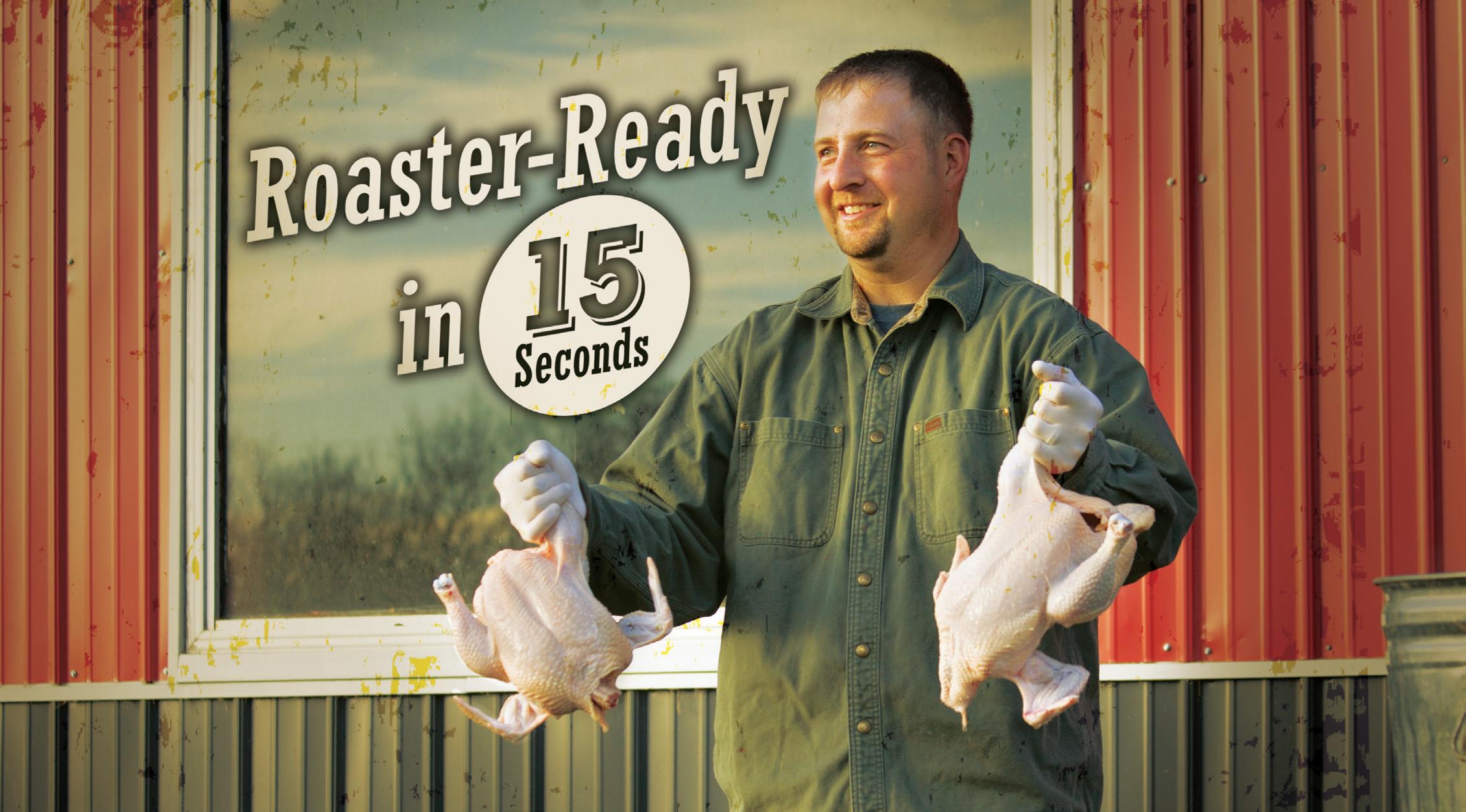
Visit www.yardbirdpluckers.com | 1730 Industrial Avenue | Cumberland, WI 54829 | 800-345-6007 Scalding Gloves • 100% Waterproof • Heavy Duty Neoprene Coating • Extra Long Cu s Protect Forearm Adjustable Restraining Cones • Heavy Duty Composite Material • Adjust Size to Fit Your Birds • Fits Birds 2-10 Pounds Butchering Apron • 100% Waterproof • Long sleeves with elastic cu s • Knee length or longer on adults Lung Removal Tool • Stainless Steel Angled Head • Textured Plastic Handle • Ergonomic Design More from Yardbird...
the
of
can
hassle out
backyard chicken processing. Plucking a chicken by hand
take as long as 30 minutes.
Chicken Plucker Yardbird-Ad-7500x1000-122922e-lt.indd 1 12/29/22 2:09 PM See #3 on page 60
GROWING BEANS

Learn
By Chris Colby
With food prices


climbing higher, maintaining a vegetable garden gives you fresh produce and keeps food costs down. If you’re looking to raise enough produce to take a bite out of your food budget, the common bean (Phaseolus vulgaris) is an excellent choice. Along with zucchini (and similar vegetables), indeterminate tomatoes, and greens, beans are among the highestyielding garden vegetables in terms of food yield per area cultivated.
Beans are nutritious. They’re 40% starch by dry weight and have both insoluble and soluble ber. The protein content of beans is 25% to 30% by dry weight, which is high compared with most vegetables. They’re also excellent sources of iron, magnesium, zinc, potassium, and folic acid. When paired with rice, beans are nutritionally complete — they supply all the required amino acids for good health. Excessive bean consumption can lead to atulence, but people who eat
beans often usually don’t have problems. Your body adapts to a bean-rich diet. There are around 400 cultivars of common beans. Chickpeas, lentils, peas, and peanuts are also legumes, as are less bean-like plants, such as mesquite, alfalfa, and clover. In addition, two other species in the genus Phaseolus — P. lunatus (lima beans) and P. coccineus (runner beans) — are commonly available to gardeners. The related genus Vigna gives us the adzuki, cowpea, and mung bean. Soybeans (Glycine max) are catching on as a garden crop. Coffee beans, vanilla beans, castor beans, and cocoa beans bear only a visual similarity to true beans and aren’t legumes.
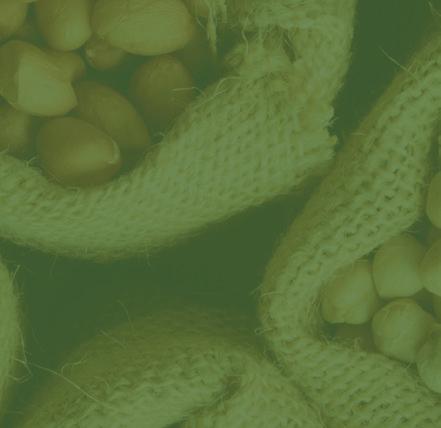




Common beans have two growth habits: pole beans and bush beans. Pole beans require a trellis or similar structure to support vines that climb vertically and spread horizontally. Bush beans have an upright growth habit and don’t need support; they don’t grow nearly as tall as pole beans and thus yield less. However, many excellent bush bean cultivars are available.
Beans are eaten at various stages. You eat the seed pod with snap beans (string or green beans), which are thicker than other bean types, with seeds just starting to develop when harvested and eaten. You can, however, let the seeds mature and harvest them for replanting next year. In some older cultivars of green beans, a tough layer of tissue — the “string” — develops along the length of the pod where it’s joined. Newer cultivars (stringless) have been bred so the string isn’t as tough. Snap beans are often green, but yellow (wax beans) and purple snap beans are also common.
Shelled beans are harvested when the seeds are mature and have yet to dry out. Dry beans are left in the garden until the seeds dry out. Then gardeners discard the shells and eat the seeds. Shelled beans are eaten fresh, while dry beans can be stored for years if kept in a cool, dry place. Popular shelled and dry beans include pinto, black, kidney, great northern, navy, cannellini, and ‘Anasazi’
A DOBE S TOCK / PIYASET
the basics of one of the easiest garden veggies to raise.
March/April 2023 16
Sow Hoe
beans. Most of these offer multiple cultivars to choose from, in pole or bush habit (or, for some, both).

Where to Plant Beans


Beans do best in full sun but will grow adequately with as little as six hours a day. In the northern hemisphere, pole beans cast a shadow to the north, so plant them on the northern edge of your garden or somewhere they won’t shade other plants that thrive in the sun. Commercial bean trellises are available, or you can construct your own. The simplest type is literally a pole with 3 to 5 lines of heavy twine extending from the top to near the base, like a maypole. Your trellis must be sturdy enough to withstand the wind when the plants have climbed it.
Beans do best in well-drained, fertile soil. As with other legumes, beans form nodules on their roots called “rhizobia” that harbor nitrogen-fixing bacteria. Dinitrogen gas (N2) is the most abundant gas in our atmosphere but isn’t usable by plants. Nitrogen-fixing bacteria combine atmospheric nitrogen (N2) with six hydrogen ions (H+) and form two molecules of ammonia (NH3). The nitrogen in ammonia is usable by plants. The relationship between the bacteria and the legume is symbiotic the plant trades sugars and other nutrients to the bacteria, which supplies the plant with a usable form of nitrogen.


There’s a popular myth that legumes “leak nitrogen” into the soil and planting legumes increases soil fertility. Unfortunately, this isn’t true. The bacteria produce enough nitrogen for themselves and nearly enough for legume crops, but don’t waste energy producing excess nitrogen that dissolves into the soil. Nitrogen from






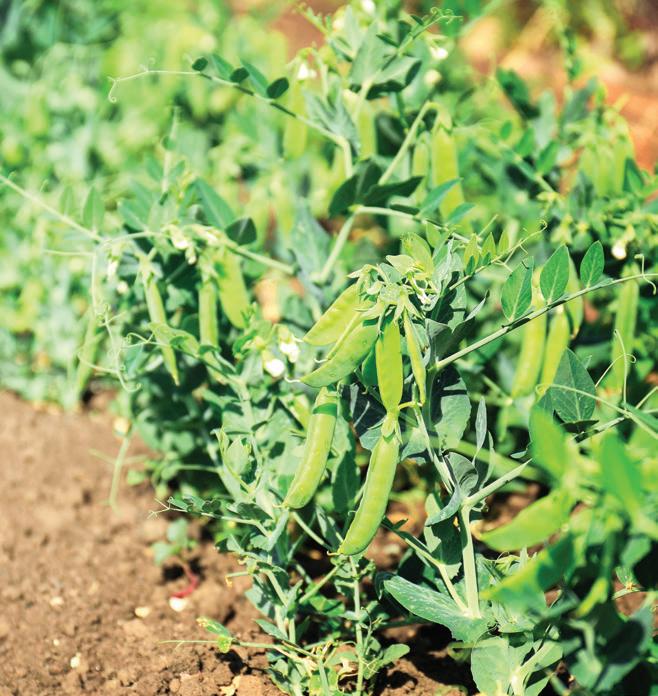
these bacteria ends up in the plant. If you compost or shred your bean plants and stir them into your garden soil, you can reclaim much of this nitrogen. When planting beans, use a “complete” fertilizer whose NPK (nitrogen, phosphorus, and potassium) rating is more P and K than N, whereas you may want more N for other green crops.

Sow Hoe A dobe S tock /A fric A S tudio
116 Years Family Owned & Operated for Enjoy 10% Off With Code 10MEN23 Respected for Quality, Value & Service Seeds • Plants • Bulbs • Supplies • Gifts 1-800-247-5864 New Plants & Seeds 2023 for See #12 on page 60 www.Grit.com 17
Bush beans have an upright habit and don’t need support to grow and flourish.
Plant beans 6 to 8 inches apart in rows 2 to 3 feet apart. Seed packets generally give instructions on spacing for particular cultivars. Plant with slightly tighter spacing in a small area, such as a raised bed. For example, plant the beans in a quincunx pattern — the pattern of dots designating a “5” on a six-sided die. If you plant beans in rows and columns with 9-inch spacing in both directions, plant a bean in the middle of each group of four; every plant will be spaced a little more than 6 inches from its neighboring plants.
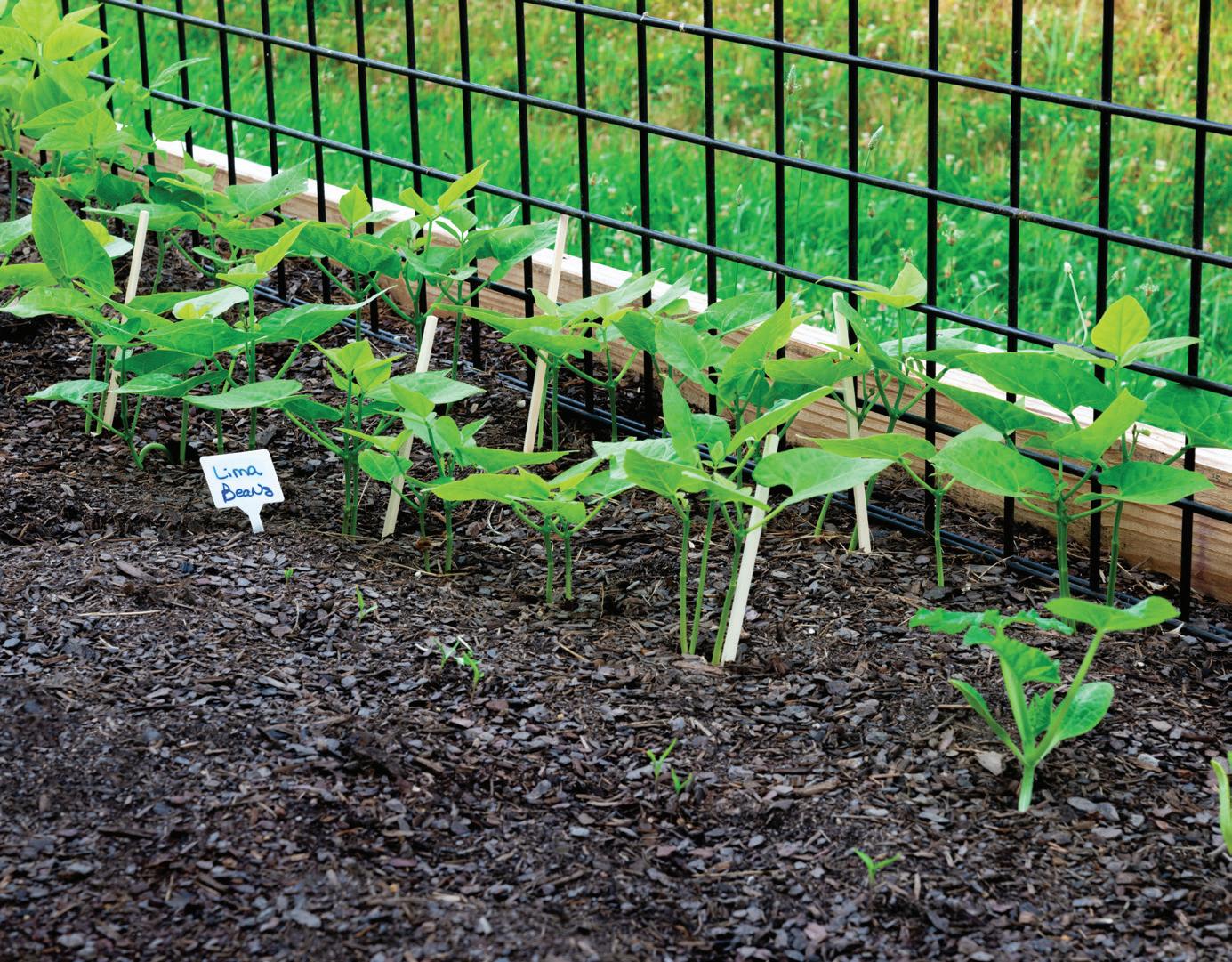
When to Plant Beans
Beans germinate and grow best when soil temperatures are between 70 and 80 degrees Fahrenheit. Waiting for these temperatures in the spring may delay planting. As such, most gardeners wait to plant until the soil temperature is above 60 degrees. Snap beans take around two months to grow, while shelled and dry beans generally take 3 to 4 months.
To speed germination, soak seeds in water for around three hours
immediately before planting. This isn’t required, however. If growing beans for the rst time, you may choose to treat them with an inoculant that coats them with nitrogen- xing bacteria. Those bacteria will already be present if you’ve previously grown beans in your garden. Even if you haven’t grown beans before, the appropriate bacteria are likely present already. However, inoculating the seeds ensures that the rhizobia form quickly and supply nitrogen to the plants early in their development. To treat the seed, place it in a bag with inoculum added. Shake the bag to lightly coat the seed and then plant it.
Caring for Beans
Besides watering and weeding, there’s little to be done while the beans grow. If possible, avoid overhead watering, as it can cause fungal problems on the leaves. If you’d like, add a second dose of fertilizer when the bean pods rst appear around the one-month mark. Interestingly, beans are heliotropic — their leaves track the sun as it arcs across the sky.
Harvesting Beans
Pick snap beans when they’ve reached their full length (often around 6 inches)
but are not yet showing “bumps” from seeds within the pods. The seed packet should give an estimate of how many days it will take the plants to mature. However, this is just an estimate. When you rst think shelled beans are ready, pick one or two pods and open them. If the beans are indeed ready, harvest the rest. If not, wait a few days and try again.
Dry beans are ready to harvest when the pods have turned brown and dried out. If your dry beans are just about ready to harvest, watch the weather. Harvest a bit early if you have rain in your forecast. Wet bean pods will yield sprouted or mildewed beans. Harvest dry beans when the pods aren’t quite dry by pulling the whole plant up and hanging it somewhere to dry.
Conclusion
Whether growing pole or bush beans, these vegetables are a simple, nutritious addition to both your pantry and garden. Knowing the basics for growing legumes will set the foundation for successful harvests for many years to come.
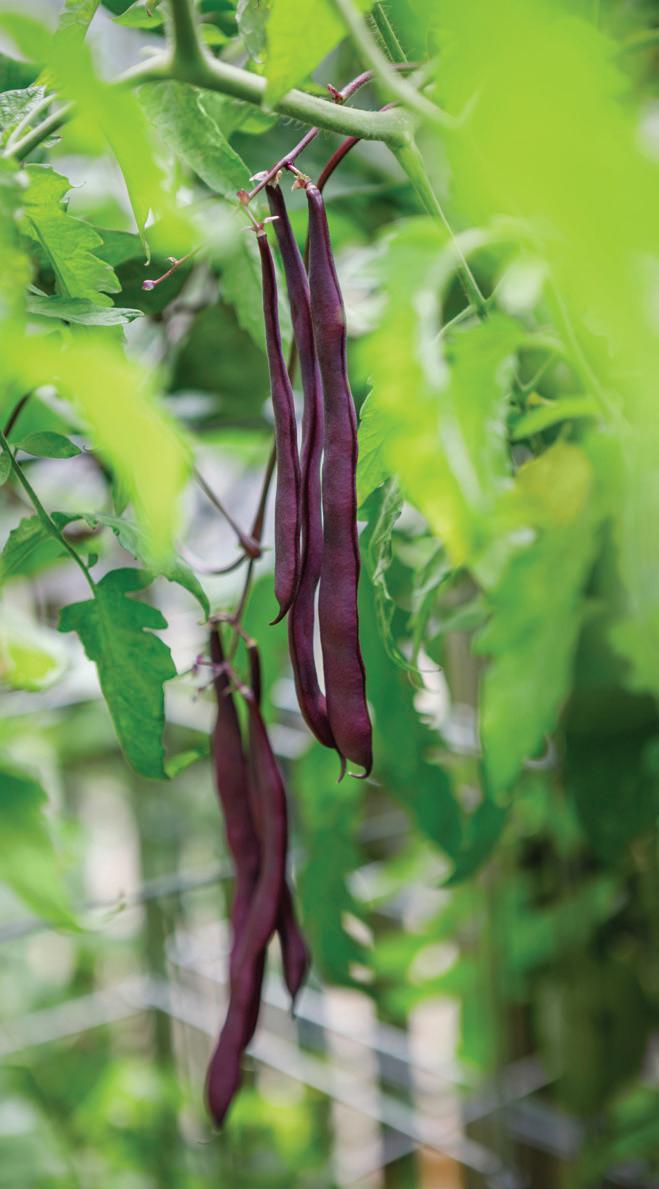
Chris Colby is an avid gardener who lives in Bastrop, Texas, with his wife and cats.


F ROM TOP : A DOBE S TOCK / C AROLYN F RANKS ; A DOBE S TOCK / EUROBANKS
Sow Hoe
Trellising can be done in a variety of ways, including fencing, a pole, ropes, and more.
March/April 2023 18
Purple hull beans are delicious and easy to grow.


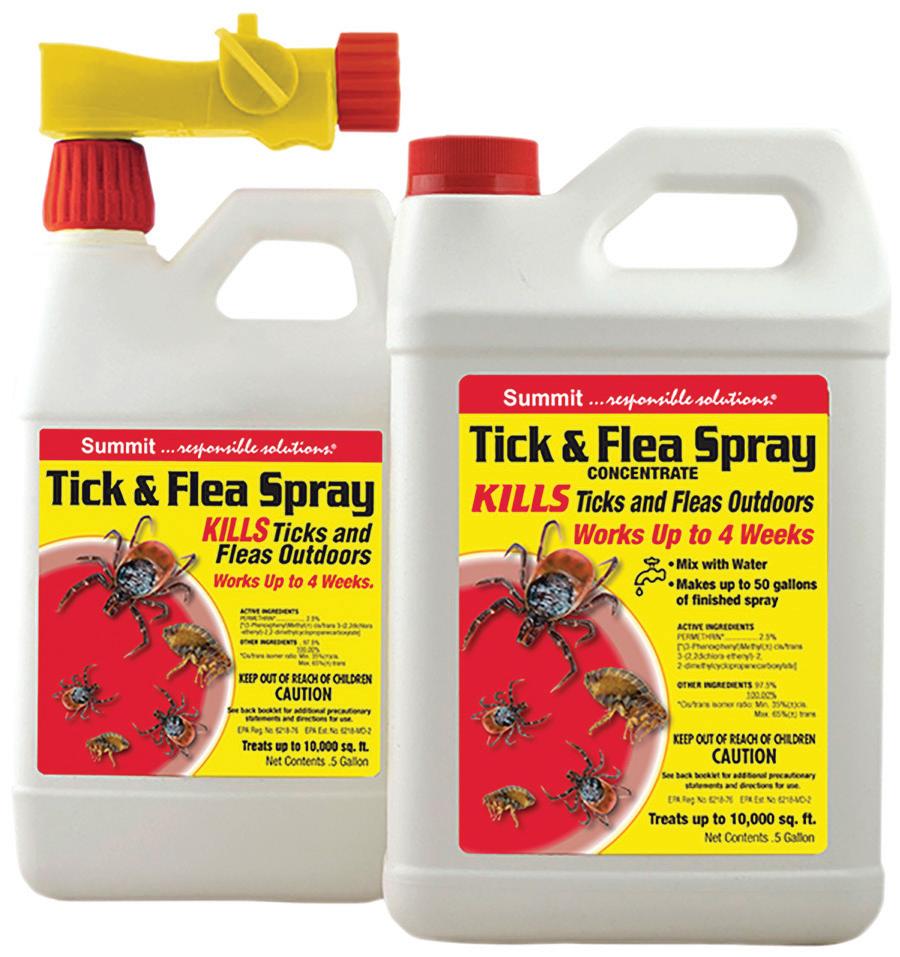

#25 on page 60
See
PRACTICAL POLLINATOR PLOTS


Begin a year-round garden of bountiful and beautiful native plants.

Planting
a pollinator plot bene ts all kinds of wildlife, from bees and butter ies to birds and bears. These plots provide pollen and nectar for pollinators, which leads to more hard- and soft-mast production in gardens, orchards, and farms.
Andy Rosenberger, a senior private lands biologist for the Virginia Department of Wildlife Resources and the U. S. Department of Agriculture (USDA), says planting for pollinators is crucial. “Because many species of native insects are experiencing population declines, it’s quite necessary to plant native wild owers for food production,” he says. In many cases, current methods of land management have stopped these plants from coming up on their own.
“If we don’t help our pollinators,” he says, “we’re going to lose some of these species and have less production from our farms and gardens as well. And not helping our pollinators also results in non-native plants and animals getting the upper hand over our native ora and fauna that evolved here.”
Preparing the Plot
Bob Boeren, a retired state forester who now operates Boeren’s Consulting Forestry, consults on how to sustainably manage land and build wildlife habitat, including how to start a pollinator-friendly piece of land.

“Generally, homeowners and landowners will want to select a place that receives full sun most of the day, is welldrained, and is far enough away from traf c so that pollinators won’t be endangered before and after they visit,” he says. He recommends that you then take a soil test and remove fescue and other grasses. After you’ve removed the grass, Boeren says to “rake away the debris and then rake through the plot to work up the soil. Use the information gained from the soil test to see what needs to be added. For example, soil tests sometimes show that lime has to be added. After the soil is amended, it’s time to plant.”
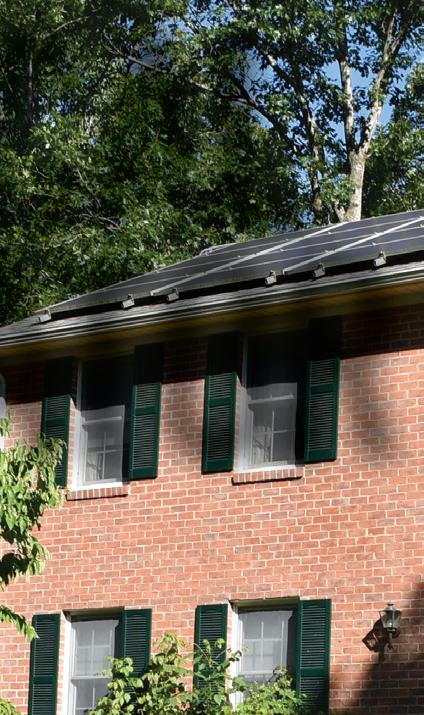
Selecting Native Plants
The property owner’s individual situation will determine which seeds
to plant and which native ora should be selected. The soil will also contain native seeds. For instance, in the plot my wife, Elaine, and I created, asters and broomsedge naturally appeared. Shrubs and small trees may even enter into the game plan.
Property owners can even tailor their plans to help certain fauna. Many pollinators only use one plant species or a few species of plants. “For example,” Boeren explains, “if you want to attract and help out zebra swallowtails, you could plant pawpaws, a very important understory tree in the East. Another small tree, black cherry, is known to attract the eastern tiger swallowtail. A really great draw for butter ies is the purple cone ower. And as many people know, milkweed is a crucial plant for monarch butter ies.”
Boeren says paying attention to which plants are native is also important. “Another approach is to plant seed mixes that will produce owers native to your area. Also, avoid spraying chemicals anywhere near your plot once it starts to bloom. Neonicotinoids, for example, can
 Story and photos by Bruce Ingram
Story and photos by Bruce Ingram
March/April 2023 20
Pollinator Friendly Gardening


Gardening for Bees, Butterflies, and Other Pollinators

Pollinator Friendly Gardening identifies the most visible and beloved pollinators, as well as some unlikely candidates, and explains the intriguing synergy between these pollinators and plants. Plant selection, hardscape choices, habitatbuilding (both natural and manmade), and the growing practices that give pollinators their best chance in the garden are all covered in detail. Plant lists organized by category, helpful tips, and expert spotlights make this a fun and easy book to read. This vital information makes it a unique sourcebook to share the ways that anyone can make a yard a friendlier place for pollinators.
This title is available at Store.Grit.com or by calling 866-803-7096. Mention promo code MGRPANZ5. Item #8562.
be very harmful to moths, hummingbirds, bats, bees, and other creatures.”
Finally, pollinator plants will need periodic maintenance. Every late winter, I remove invasive plants and clear out debris. In early spring, I asked Boeren to come to my plot so he could give his expert opinion on what should be done.
Before he arrived, I mowed the broomsedge (Andropogon virginicus) that grows around the perimeter to revitalize it. I also removed the dead stalks of stickweed (Verbesina occidentalis) and other ower stalks that had bloomed the previous year. With the bed of the plot more visible, Boeren didn’t take long to spot several problems — ones that are likely to appear in readers’ plots as well.
“Two invasive plants, honeysuckle and ground ivy, have moved in, probably popping up when you couldn’t see them when the plot was at its peak last spring and summer,” he said. “There’s even a sprig of autumn olive that’s a few inches tall. A songbird could’ve pooped out a seed of that invasive when it was visiting the plot.”
www.Grit.com 21
SEED SAVERS EXCHANGE Display Gardens | Trails | Visitors Center Visitors Center open March-October Decorah, Iowa · 563.382.6104 seedsavers.org/visit JOIN US FOR OUR 2023 EVENTS Virtual Apple Grafting Workshop* April 14-15 Heirloom Plant Sale May 12-13 Virtual Conference* July 21-22 Virtual Seed School* Starting September 11 For more information and a complete list of events: SeedSavers.org/events *registration required
See #22 on page 60
Boeren killed the patch of honeysuckle and ground ivy that blanketed one corner of the plot. No native plant would be able to grow there until the invasive plants were removed. To avoid disturbing the native plants that had appeared nearby, he pulled up the honeysuckle by its roots and dug up the autumn olive, so as not to harm the native wild strawberry plants already in bloom.
Another benefit of creating a pollinator plot is that native plants may begin to

appear naturally. Two redbuds (Cercis canadensis) and a dogwood (Cornus florida), both in full bloom during Boeren’s visit, showed up after I stopped mowing that part of my front yard. These two understory trees make a fine border to any pollinator plot.
Other small native trees and shrubs that may appear or can be planted include the Allegheny plum (Prunus alleghaniensis), serviceberry (Amelanchier arborea), staghorn sumac (Rhus typhina), flame
azalea (Rhododendron calendulaceum), and numerous species of wild cherries, haws, and viburnums. At another plot on our land, for example, I planted two each of Allegheny plum and serviceberry.
Year-Round Benefits
Over the course of the dozen or so years Elaine and I have had a pollinator plot, we’ve planted a number of different flora: purple coneflowers (Echinacea purpurea), wild bergamot (Monarda fistulosa),
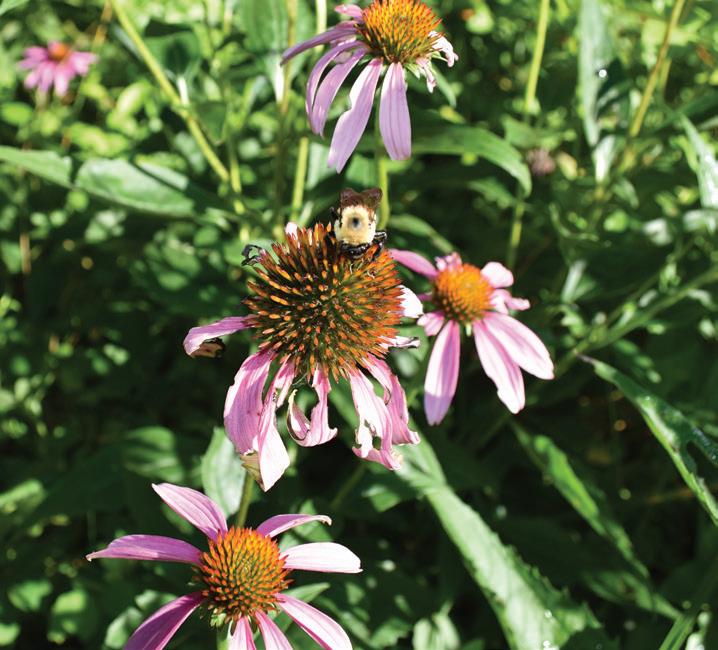
Native Flowers to Plant in Every Region
These suggestions for five pollinator plants and one milkweed for each region of the United States were compiled by Matthew Shepherd, director of outreach and education for the Xerces Society, and from Attracting Native Pollinators and 100 Plants to Feed the Bees
NORTHEASTERN U.S.
Pollinators
• Bicknell’s cranesbill (Geranium bicknellii)
• Wild lupine (Lupinus perennis)
• Wild bergamot (Monarda fistulosa)
• Joe-Pye weed (Eupatorium fistulosum)
• New England aster (Symphyotrichum novae-angliae)
Milkweed
• Butterfly weed (Asclepias tuberosa)
SOUTHEASTERN U.S.
Pollinators
• Spotted geranium (G. maculatum)
• Dense blazing star (Liatris spicata)
• Joe-Pye weed (E. fistulosum)
• Virginia mountain mint (Pycnanthemum virginianum)
• Common sneezeweed (Helenium autumnale)
Milkweed
• Butterfly weed (A. tuberosa)
MIDWESTERN U.S.
Pollinators
• Spotted geranium (G. maculatum)
• Wild lupine (L. perennis)
• Wild bergamot (M. fistulosa)
• Purple coneflower (E. purpurea)
• New England aster (S. novae-angliae)
Milkweed
• Butterfly weed (A. tuberosa)
GREAT PLAINS
Pollinators
• Wild bergamot (M. fistulosa)
• Rough blazing star (L. aspera)
• Narrow-leaved coneflower (E. angustifolia)
• Purple prairie clover (Dalea purpurea)
• Smooth aster (S. laeve)
Milkweed
• Showy milkweed (A. speciosa)
ROCKY MOUNTAINS
Pollinators
• Perennial blanketflower (Gaillardia aristata)
• Rocky Mountain beeplant (Cleome serrulata)
• Purple prairie clover (D. purpurea)
• Smooth aster (S. laeve)
• Rocky Mountain goldenrod (Solidago multiradiata)
Milkweed
• Showy milkweed (A. speciosa)
CALIFORNIA & SOUTHWEST
Pollinators
• California poppy (Eschscholzia californica)
• Palmer’s penstemon (Penstemon palmeri)
• Silvery lupine (L. argenteus)
• Sulphur flower (Eriogonum umbellatum)
• Eaton’s aster (S. eatonii)
Milkweed
• Showy milkweed (A. speciosa)
PACIFIC NORTHWEST
Pollinators
• Large-leaved lupine (L. polyphyllus)
• Perennial blanketflower (G. aristata)
• Maximilian sunflower (Helianthus maximiliani)
• Sulphur flower (E. umbellatum)
• Pacific aster (S. chilense)
Milkweed
• Showy milkweed (A. speciosa)
 From left: Black-eyed susans, coneflowers, and milkweed are some of the many stunning wildflowers that support native pollinators and provide benefits all year long.
From left: Black-eyed susans, coneflowers, and milkweed are some of the many stunning wildflowers that support native pollinators and provide benefits all year long.
March/April 2023 22
wild strawberry (Fragaria vesca), early sunflower (Heliopsis helianthoides), heartleaved aster (Symphyotrichum cordifolium), and black-eyed susan (Rudbeckia hirta), just to name a few. I didn’t realize at first that I needed to have wild flowers in bloom from early spring through late summer and early fall.
For example, Rosenberger says mining bees can appear in late winter or early spring and are critical early season pollinators. Planting early blooming flora, such as evening primrose (Oenothera biennis), Virginia iris (Iris virginica), and butterfly weed (Asclepias tuberosa), can be of great service to mining bees and other early season pollinators
Similarly, late-summer blooms fulfill an important niche. Although a crop is often a success or failure by late summer, local pollinators still need food sources during that time.
“Stickweed, a member of the aster family, is hated by many farmers, because it sometimes forms dense stands,” Rosenberger says. “But it’s a very important late-season bloomer and a favorite of bumblebees. Ragweed causes allergic reactions in some people, and beggar’s lice sticks to our clothes, but both of them provide food for many species of wildlife and are also lateseason bloomers. Pound for pound, the seed from ragweed is extremely nutritious for quail and other game birds and songbirds. So whether a plant is a pest, weed, or a wonderful wildflower or forb is really in the eye of the beholder.”
Plus, he says these benefits are ongoing. “Native sunflowers, ironweed, and various asters are other possible additions to a pollinator plot for late-growing season visitors. And the benefits that your pollinator plot provides won’t end after the last plant has bloomed, either.”
I certainly can attest to that fact. For example, last October, long after the last plant in our pollinator plot had bloomed, I noted goldfinches and various species of sparrows continually visiting to scarf down seedpods and to forage among the leafy debris. Come winter, rabbits found
cover there, and wintering hermit thrushes had security and food there as well. Pollinator plots truly provide year-round benefits to a wide variety of creatures.
Finally, Bob Glennon, a private land biologist for the Virginia Department of Wildlife Resources and the USDA, offers a creative way to provide both food and cover for pollinators: For cover, he suggests mixing in native warmseason grasses, such as little bluestem (Schizachyrium scoparium) and splitbeard bluestem (Andropogon ternarius), with wildflowers, such as red columbine (Aquilegia canadensis), wild bergamot (Monarda fistulosa), and gray goldenrod (Solidago nemoralis), for their blooms.
Rob Kretz, a consultant for Prairie Moon Nursery (www.PrairieMoon.com), listed four species that would work well in a pollinator plot just about anywhere in the U.S.: panicled aster (Symphyotrichum lanceolatum), wild bergamot, sneezeweed (Helenium autumnale), and dogbane (Apocynum cannabinum).
Good Things Take Time
When we first began our pollinator plot in our front yard, I must confess that the response of other folks, including Elaine, was not positive. Visiting friends snidely questioned if my lawnmower needed repair. My sweet wife even questioned whether anything would come from letting part of our yard “go to seed.”
But one summer day during the second or third year of the plot’s existence, Elaine and I strolled by our creation. Bumblebees were visiting the purple coneflowers, butterflies had alighted on some milkweed, honeybees were seemingly everywhere, and the plot’s blooms seemed to glisten in the early morning light. And Elaine says, “You know, it really is beautiful.”
Best Natural Fertilizer On Earth


“Chicken Soup for the Soil® improves your soil by feeding the microbes and supplying all the nutrients most fertilizers neglect.”

Grow higher quality fruits & vegetables with more color, better taste, less bug infestations & disease.

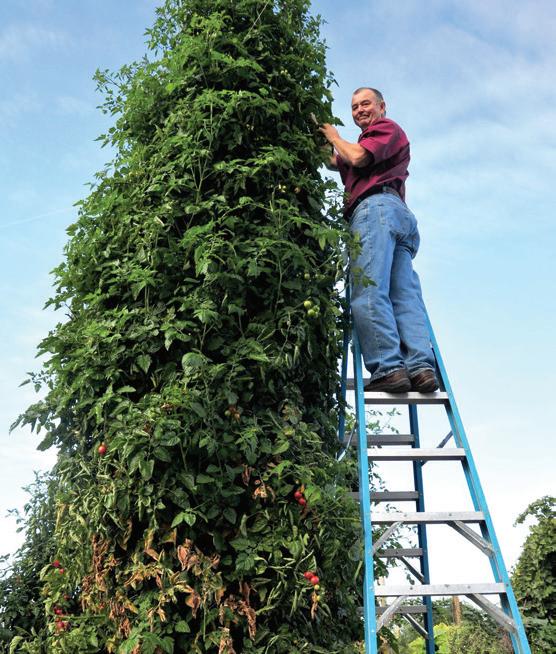
Contains all the elements in the periodic table (sea nutrients, amino acids, humic, fulvic, and other herbal extracts).


All natural, toxin free, & bioavailable.
Non-leaching formula / nutrients accumulate over time.

Perfect for gardeners, growers, and farmers. humic, ranchers and farmers. 64oz Jug 3495


*Makes up to 128 gallons with 1 tablespoon per gallon. Full Money Back Guarantee!
Bruce Ingram is a freelance writer and photographer and the author of 10 books, including Living the Locavore Lifestyle, a book on living off the land. Get in touch with him at BruceIngramOutdoors@Gmail.com.
*Commercial quantities availableWorks On Pastures 888-394-4454
www.DrJimZ.com
See #6 on page 60 www.Grit.com 23
+Free Shipping!!
Plan a Garden as Unique as You Are
Our Garden Planner makes it easy to map out your vegetable beds, and add and move plants around for the perfect layout. You’ll also receive a personalized plan�ng calendar for your loca�on.
Flexible Design

Whether you use tradi�onal row plan�ng, containers, raised beds, or square foot gardening, the Garden Planner adapts to suit your gardening style.



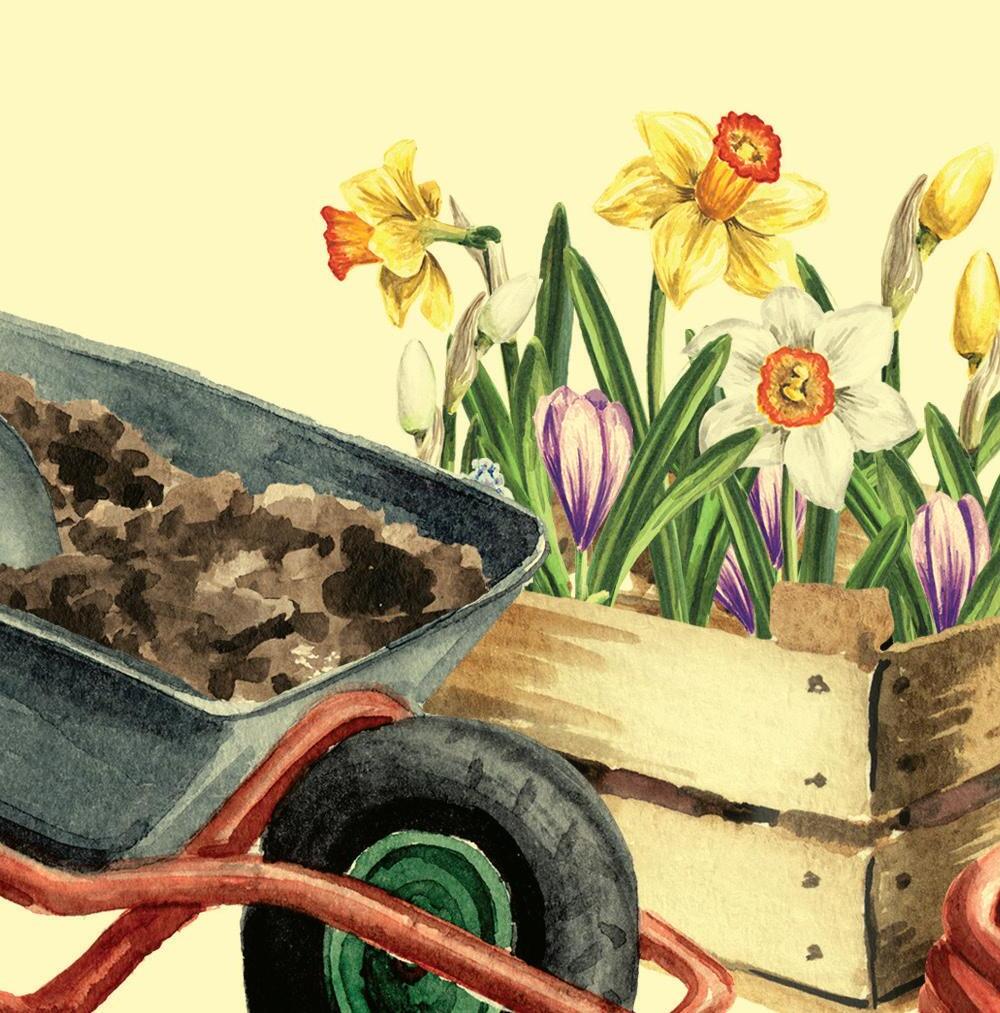
A Journal that Understands Your Garden
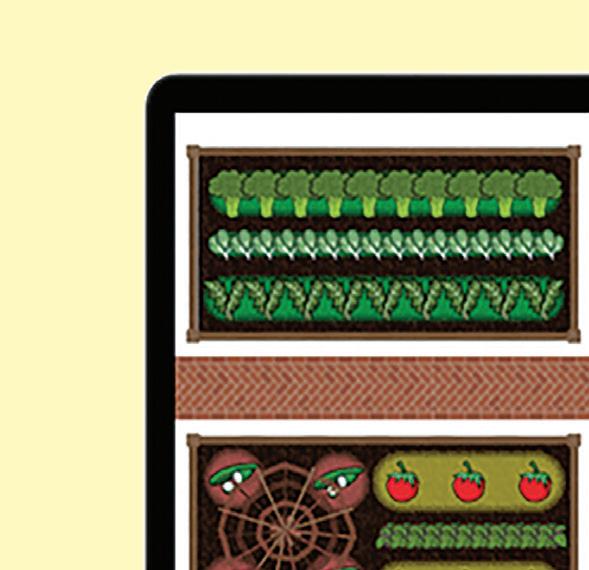


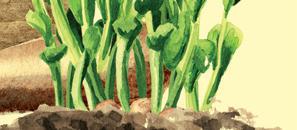








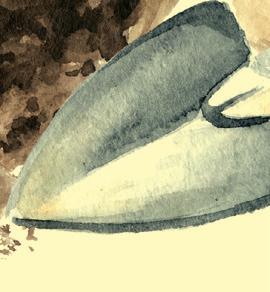




With our unique local weather and pest informa�on, you can stay one step ahead of problems and keep your plants healthy and produc�ve.

Gardening Tips & Personalized Advice
Whether you need advice on the best layout for your garden, what to grow next, or how to protect your plants from disease, you’ll find hundreds of in-depth ar�cles and videos. There’s no be�er place to receive the support you need.


Intelligently Tailored to Your Climate


Print your own personalized plan�ng chart showing how many of each plant you require and when to sow, plant, and harvest them.
Order by visiting gardenplanner.motherearthnews.com

''My neighbors laughed wh en I ordered... now they ALL want a tomato garden like mine!''
Introducing a gardening planter that automatically grows your vegetables for you - simply, naturally and without any work. The Award-Winning GrowBox combines 45 years of USDA research and University field trials into a patented planter that makes sure your plants thrive - every time, year after year.
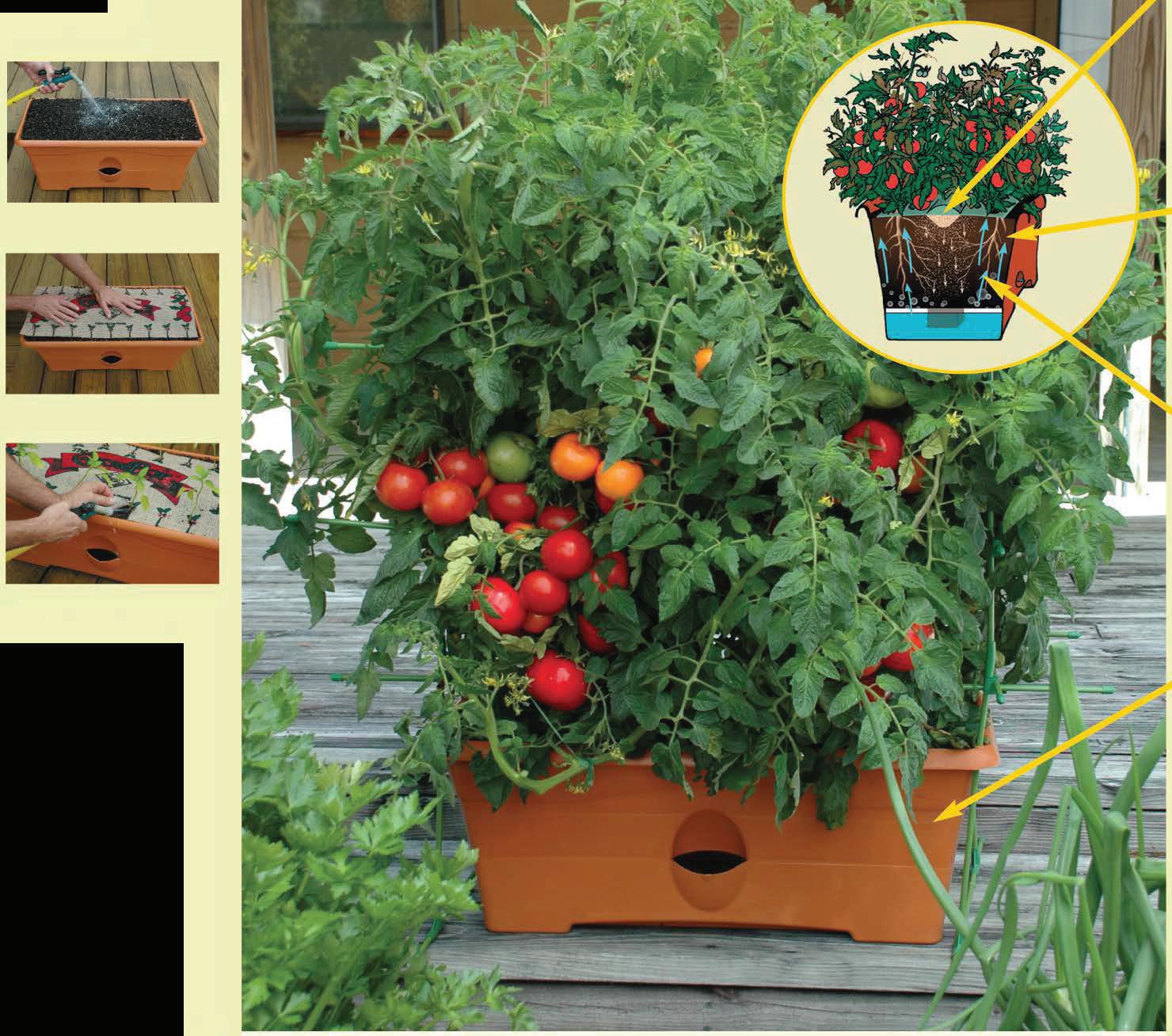
Look How Easily You'll
1 The P.atented Nutrient Grow Tomatoes PatchM cover releases
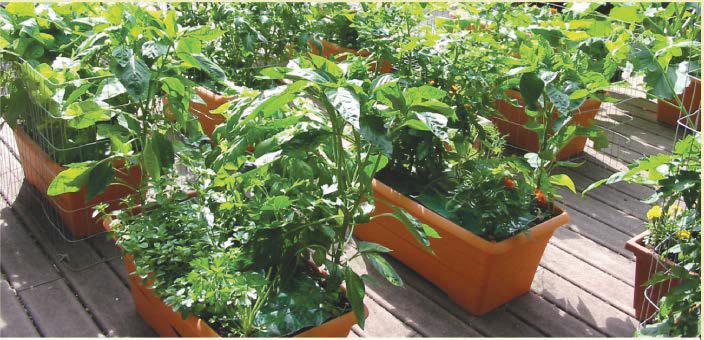
1 Just fill your GrowBox with comm?n potting mJX.
2 Lay the patented Nutrient Patcti" cover on the top and plant by the numbers.
3 Add water to the reservoir and ... Watch 'Em Grow!
Brown Thumb? It's EASY being green! Simple instructions show you when and what to plant. Then The GrowBox automatically adds the right amount of water and fertilizer for you. No guessing, no schedules, nothing to learn. Works perfectly - even for 1st timers.

Perfect for Patios and Decks
Great for busy homemakers, seniors and budget-minded people who want to save money on safe, clean produce. NEW Organic Fertilizer now available.
The EASY way to Garden You'l'e been Waiting For.
Enjoy a constantly producing garden anywhere you have sunlight. Pick FULLSIZE vegetables and salads daily for months - then simply re-plant year after year using the same soil.
premium fertilizer at the right time, properly spaces your plants and keeps the soil warm.
2 Uses simple potting mix for green-house quality results. No weeds or digging. You '11 never grow in the ground again!
3 Water constantly moves upwards to the roots. Stores 4 gallons for easy maintenance and it's impossible to over-water.
4 Just plant it and forget it! The indoor/outdoor GrowBox is portable, neat, easy to use and is re-usable for years and years.
"I own 5 o_f them and they're the greatest ...I am the envy o_f our neighborhood!"
Ruth M. Mother Earth News Magazine subscriber
Grows ALL plants with the same ease
Try Our GrowBoxes RISK-FREE This Spring
Order yours now and grow perfect tomatoes, peppers, 'cukes, salads and more. TAKE AN ENTIRE YEAR TO DECIDE that you love your new garden. If for ANY REASON, you're not completely satisfied, simply return them for a 100% refund - including your initial shipping.fee. You have nothing to lose with this no-risk offer. TRY 3 GROWBOXES'"THTS SEASON and say good- r=, r=, t bye to high produce costs. Your satisfaction is 100% guaranteed.
Toll-free (866) 947-5705 Visit our website for lots more information
www.a gard enpa tch .com

The GrowBox comes complete with planter, fertilizer, cover, simple instructions and a planting guide.
Just add 32 quarts of potting mix and plants or seeds. Measures 28"

��
"Outstanding New Gardening Product �\,,- Awa rd for Ea se and Innovation"
L!J
L!J
•
•t■-
© 2022 The Garden Patch ™ Grow Box™ Key Code: 3CSM2EA2GRT3BA
long , 14" wide and 12" tall.
THE POWER OF HAND TOOLS

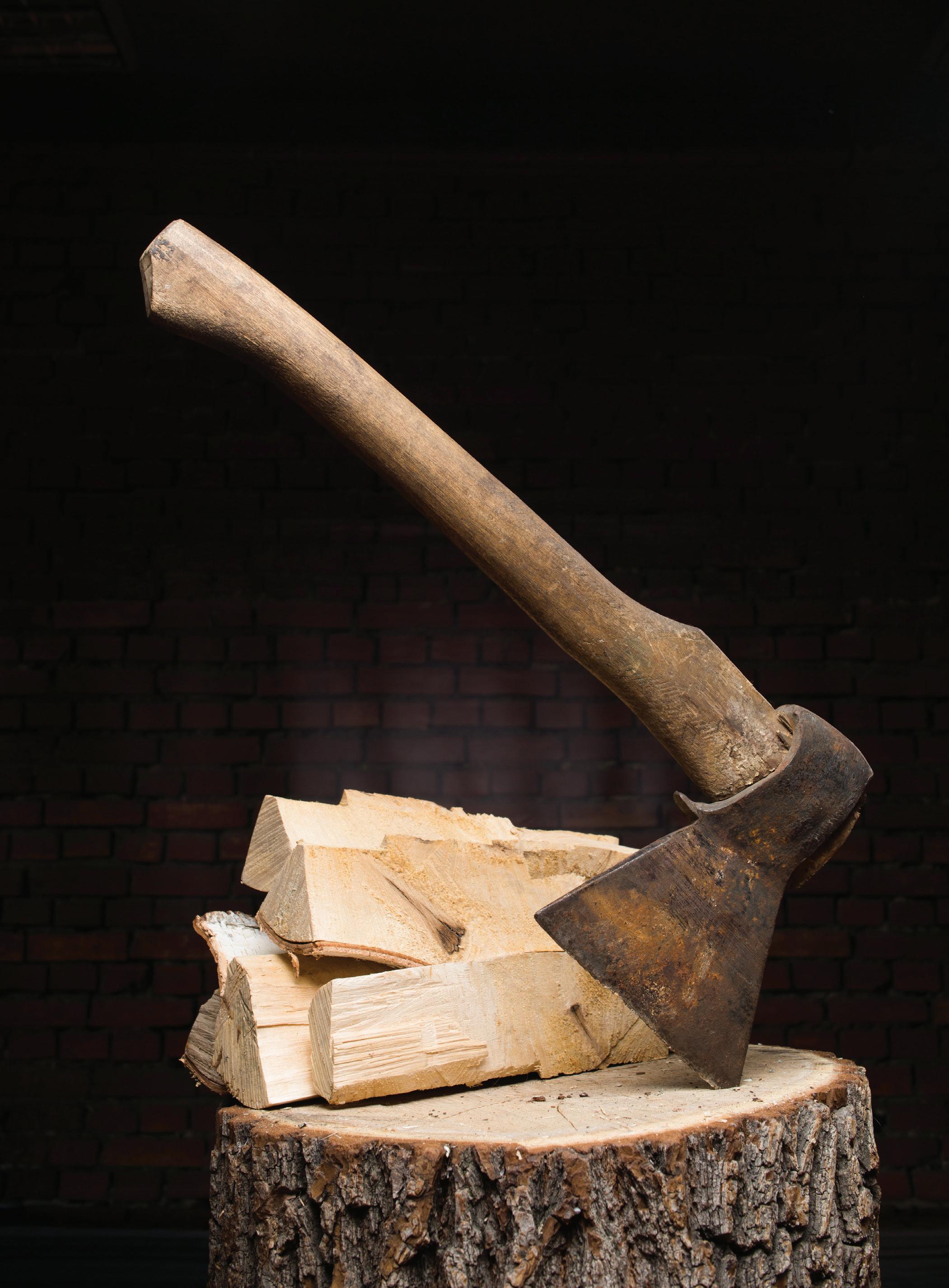
Discover eight tools that pack a punch without draining electricity.
 By Jenny Underwood
By Jenny Underwood
A DOBE S TOCK / KOPITINPHOTO
March/April 2023 26
Althoughpower tools are wonderful for many jobs, hand tools are my favorite to work with. I love their feel, their history, and the peace and quiet of using them. Plus, in my experience, they often do a superior job to power tools!
Many hand tools have been around a long time. Nearly everyone is familiar with hammers, saws, and shovels, but are you also acquainted with the following specialty hand tools? Most are old-school favorites, and are indispensable for anyone who wants to build self-sufficiency skills.
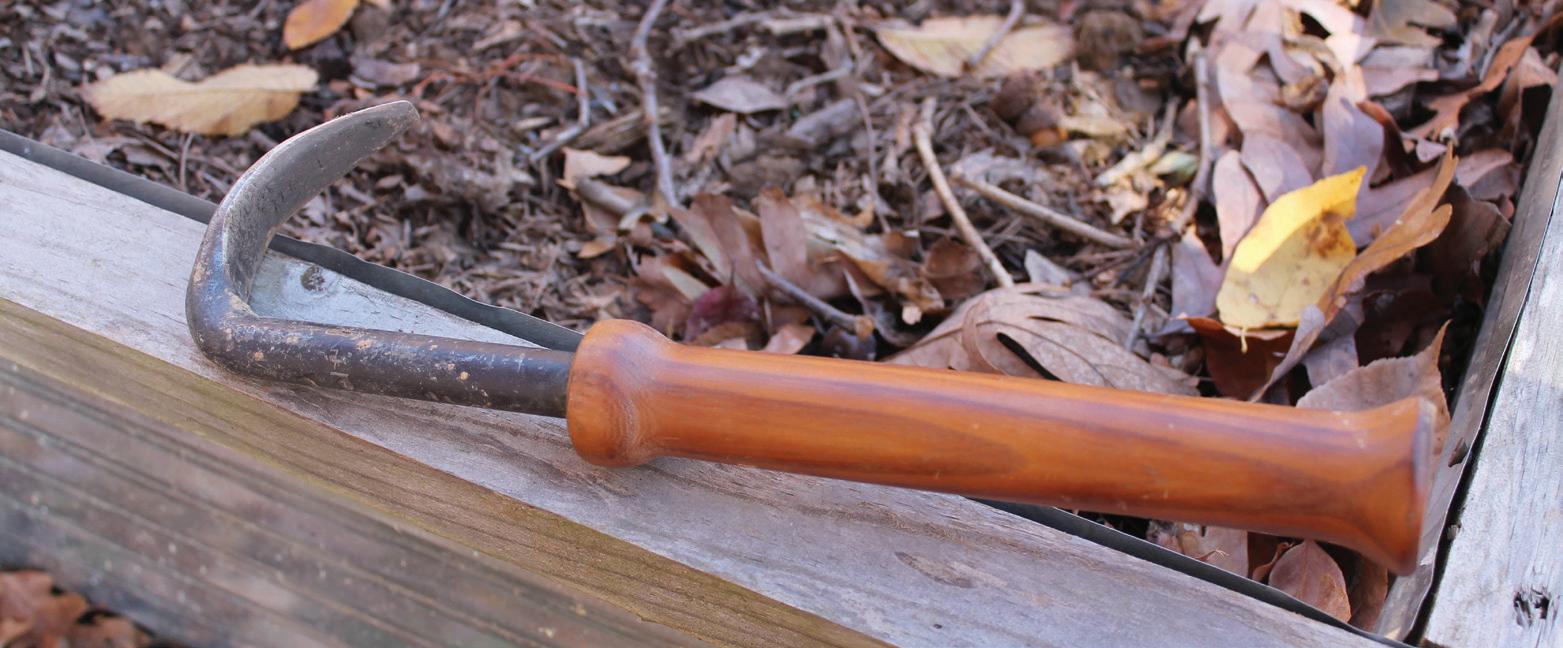
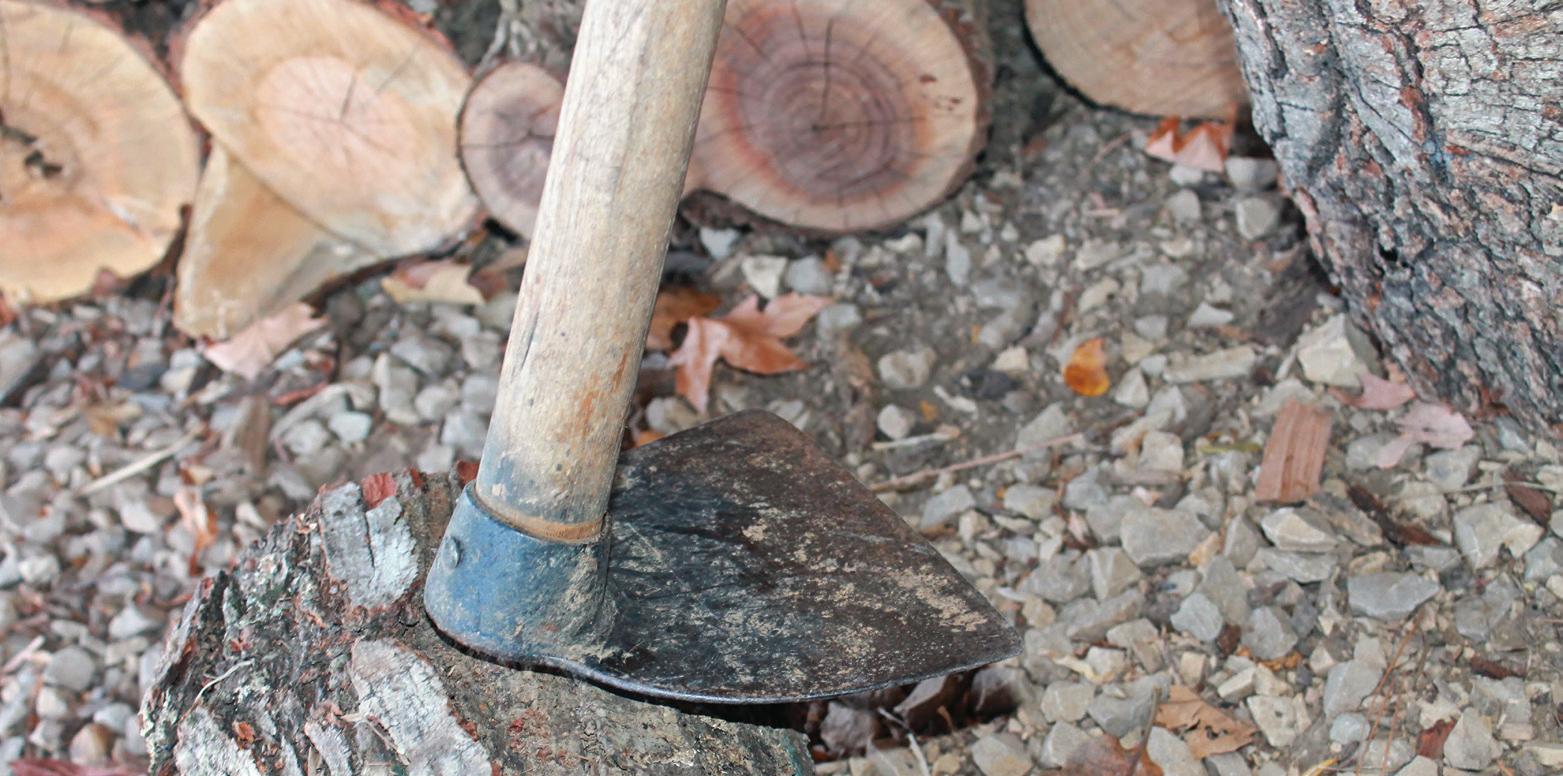
1. Grubbing Hoe
Many different hoes are available on the market, each with a specific purpose. A grubbing hoe (also known as a “grub hoe”) has a much larger, heavier blade than a regular garden hoe. The grubbing hoe I use is about twice the size of a conventional garden hoe, and it does a superior job at chopping weeds, especially in hard or dry soil. This tool has come in handy in my gardens with heavy clay soil.
The grubbing hoe isn’t suited to delicate jobs, so this isn’t the tool for you if you want to work between plants in tight spaces. But it excels when you need to hill potatoes, grub out stubborn weeds between rows, or dig a trench.
2. Hand Weeder
The quality CobraHead weeding tool I wanted was rather expensive, so my husband decided to make one for me as a Christmas surprise. This tool is simply amazing. I use it for weeding, digging planting holes and furrows, and cultivating. The angle of the end also makes it fantastic for digging a trench. You can use it to harvest new potatoes, remove small weeds, or work up an entire bed in minutes. The blade is sharpened to easily gouge out weeds by the roots.
I recommend this type of ergonomic weeding tool for raised beds, as it would be fatiguing to use in conventional gardens (unless you’re individually weeding around each plant). The design allows me to sit on a bucket beside
a raised bed and weed without much bending over.
3. Multitool
A quality multitool is a jack-of-alltrades. Many of these little tools offer multiple knives, screwdrivers, and scissors, plus a saw, file, leather punch, pliers, and even can openers! Everything folds up and fits into about a 1-by-4-inch pouch. A multitool will cover many of your tool needs in one small, easily portable package. As with any tool, make sure you buy the best-quality multitool you can afford, because having an inferior tool break when you need it most is frustrating.
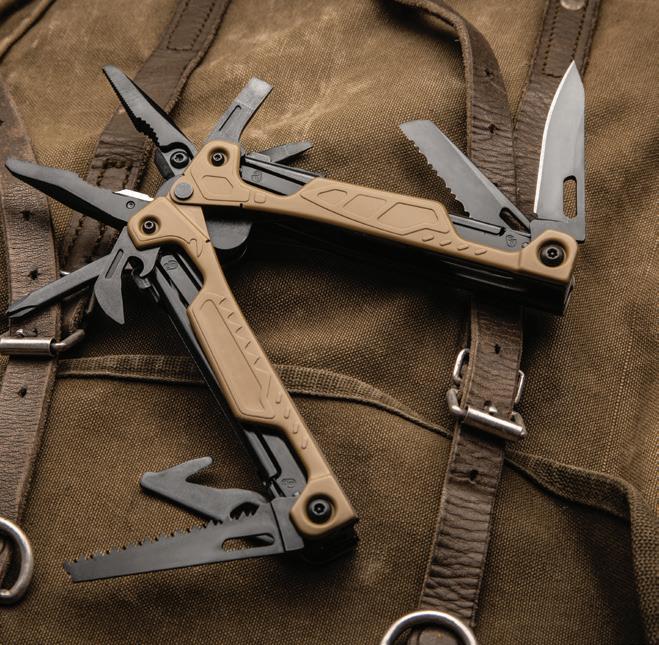
4. Drawknife
Useful for making bows, basket splits, wooden spoons, and much more, drawknives are great for smoothing a narrow wooden surface.

Drawknives come in different widths and thicknesses. Some are rigid, and some are flexible (like the small drawknife I use for spoon-making).
These tools are safer to use when kept razor-sharp and handled with care. Always store them in a secure location, preferably inside a leather case. Quality drawknives are available new, but they can also be found at flea markets and estate sales at reasonable prices.
c lockwi S e from top J enny U nderwood (3); A dobe S tock / S olidm A k S www.Grit.com 27
Clockwise from top: Extra-handy hand tools include a grubbing hoe, a hand weeder, a multitool, and a drawknife.
5. Hatchet
Few tools are more useful or versatile than a hatchet. This superior tool is handy for everything from splitting kindling to building an emergency shelter. I use a hatchet to rough out bows, split all the kindling for the woodstove, clean up shooting lanes for deer season, and fielddress wild game.
You can choose from inexpensive production hatchets to pricier handforged ones. I recommend you get a high-quality tool that can be passed down for generations. Make sure the poll (the blunt face opposite the blade) is hardened if you plan to use it as a hammer, or it’ll mushroom and damage your hatchet.
6. Axe
Double- and single-bit axes are as indispensable as hatchets. I own several of these incredibly helpful hand tools. A single-bit axe has a blade on just one end of the head. It’s useful for splitting wood and chopping brush. Double-bit axes, with blades on both edges of the head, were designed to chop down trees. They’re also good on smaller chopping jobs for which you don’t want to use a heavy chainsaw.
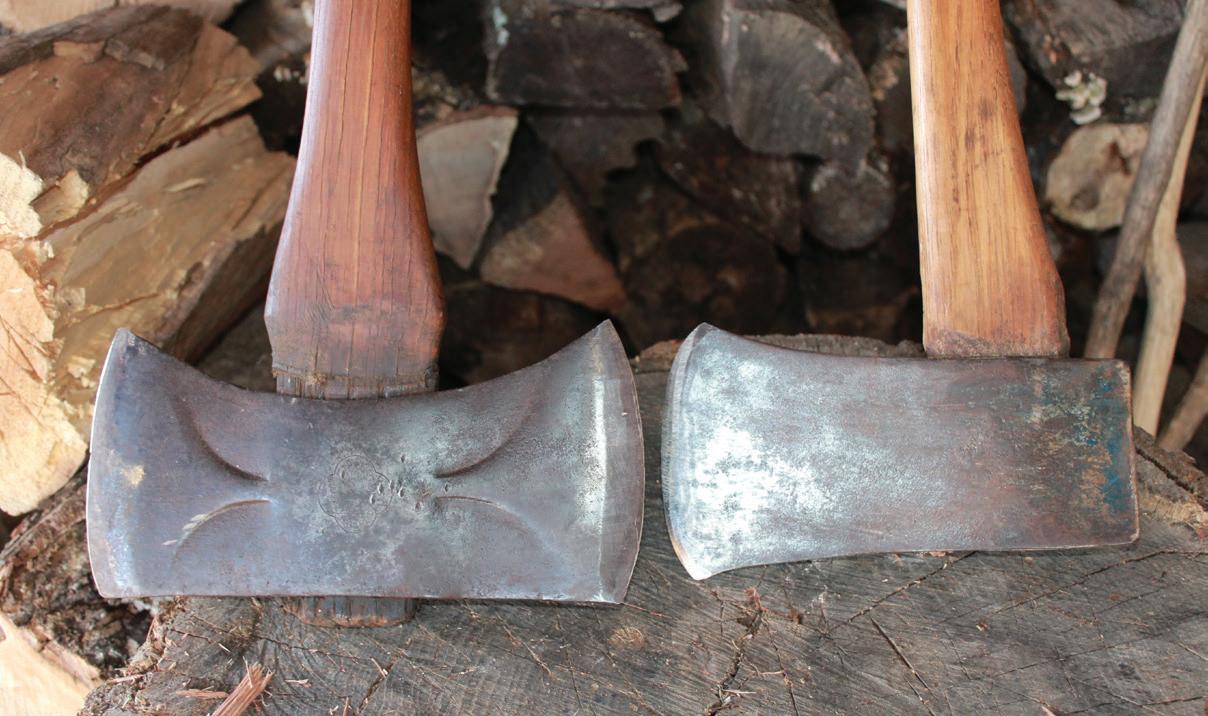
I’ve found high-quality axes and axe heads at flea markets for low prices. Often, these old tools will need a new handle (a process known as “rehanging”), but for less than $30, you’ll end up with a fine tool that’ll last several lifetimes.
7. Froe
A froe (also spelled “frow”) is a specialty tool designed to split wood along the grain. Often used for splitting wooden shingles, a froe can also be used for any project that requires a precision split of wood, such as splitting kindling or cutting blanks for spoon-carving.
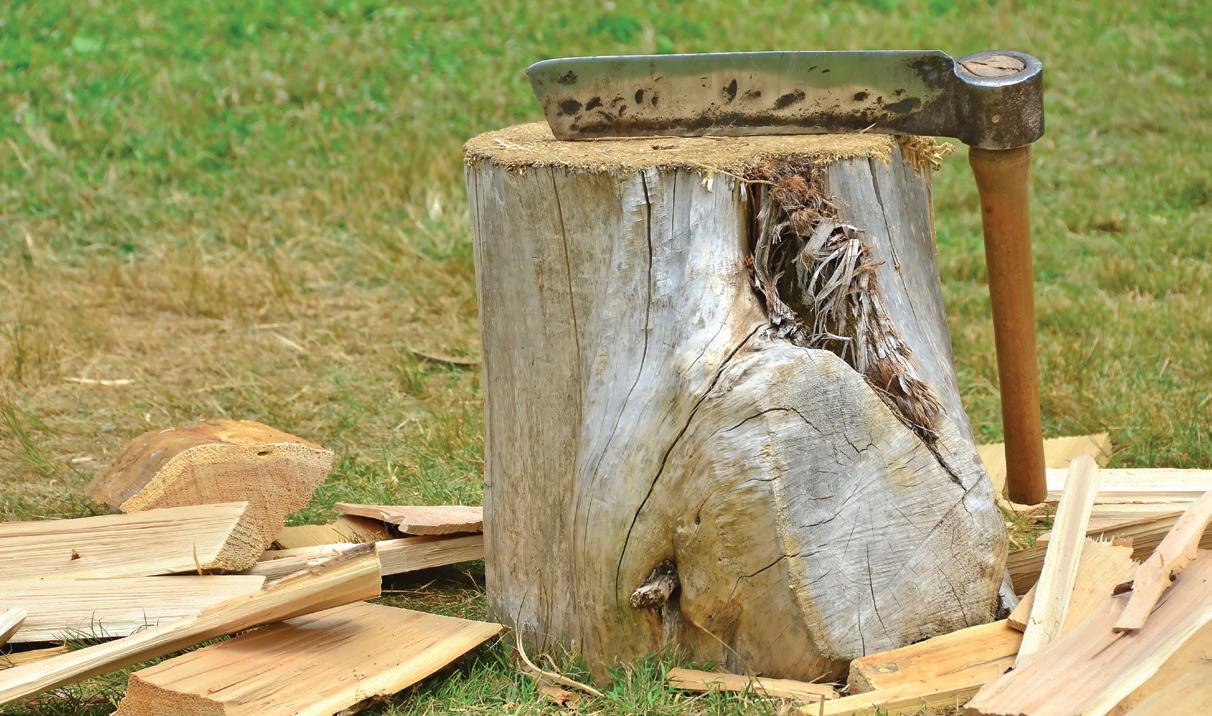
This hand tool is L-shaped, with a metal blade and a wooden handle. To use it, simply place the blade exactly where you want to split the wood and then tap the top of the blade or the handle with a wooden mallet.
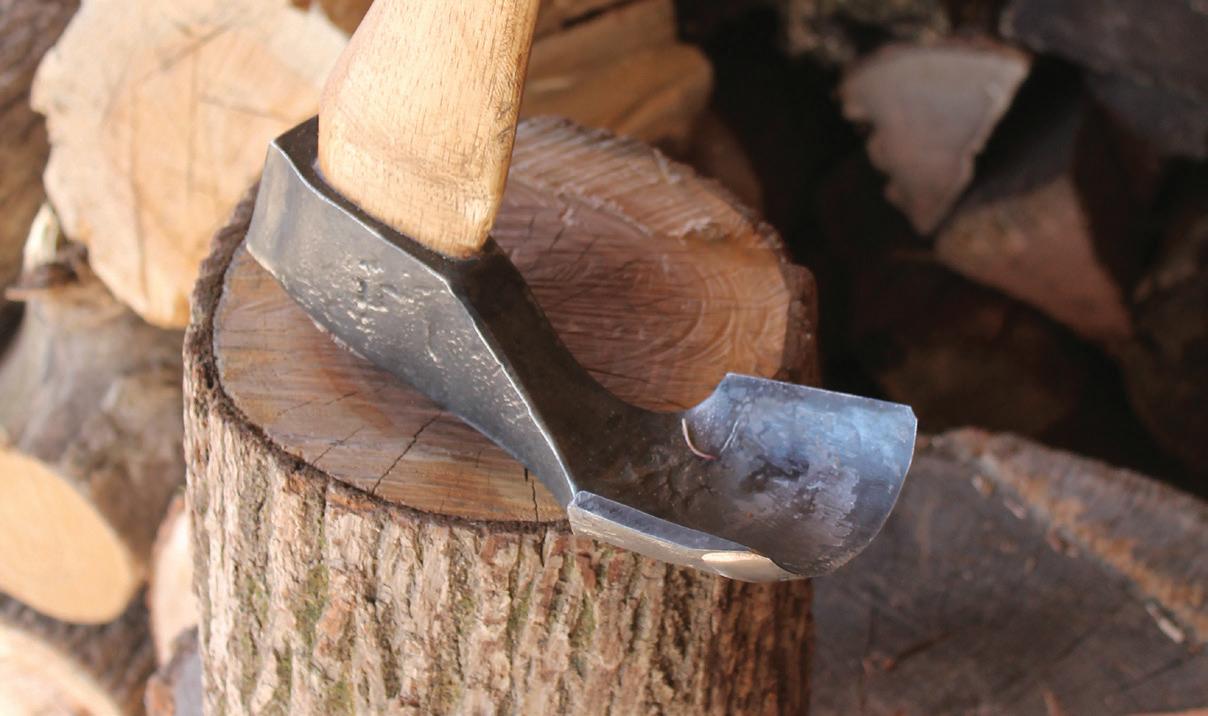
8. Adze
An adze blade is curved and is placed atop a wooden handle; the latter may be either short or long. A few different types of adzes exist, but all are for scooping or smoothing out wood. Depending on its size, an adze might be used for making

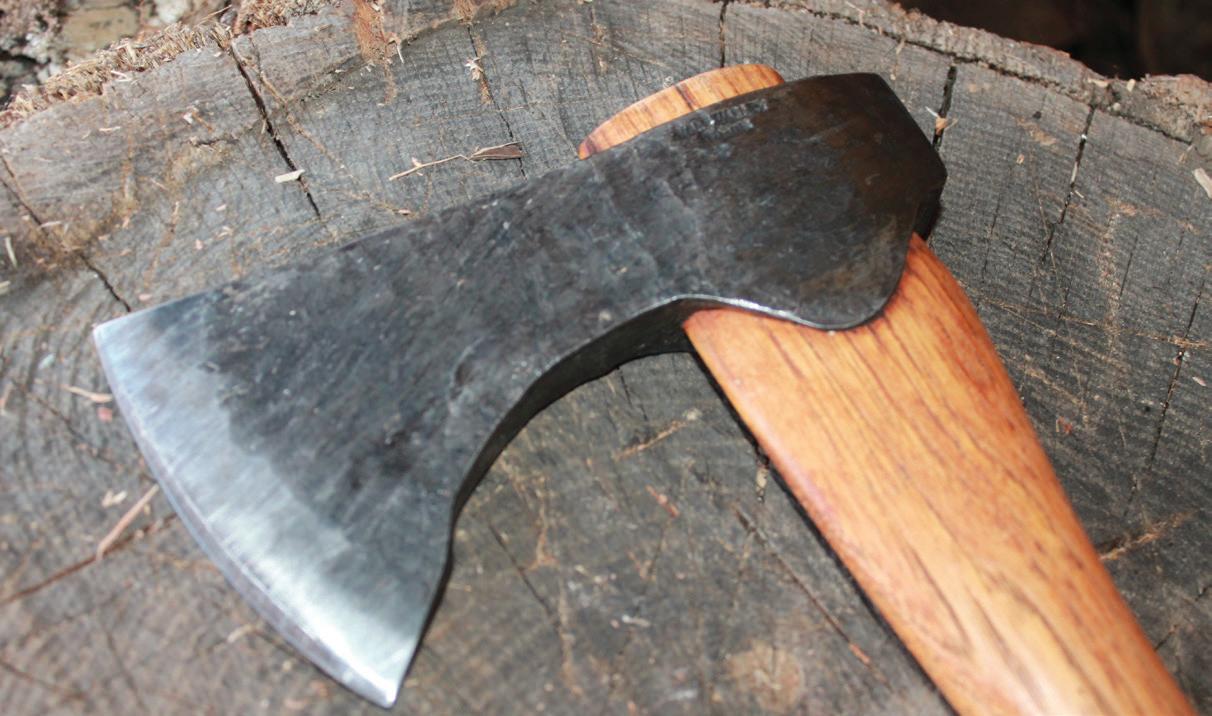
wooden bowls or for building a wooden canoe. The adze is a ubiquitous, heavybladed tool that’s been used for carving and even gardening.
A Little Tool TLC
Always store your tools in a dry location, because moisture is their enemy. Clean your tools after using and dry them carefully. If you’re storing them long-term (for example, over winter), put a thin coating of oil on the blades and handles to help prevent rust and cracking.
Sharpen hand tools as needed. A file is sufficient to sharpen a hoe, but for a hatchet or axe, you’ll need a ceramic rod, a sharpening stone, and a leather strop. Hand-sharpening is recommended over using an electric grinding stone, because the electric stone often takes off too much metal, while hand-sharpening does a finer job.
C lo C kwise from top left J enny U nderwood (3); A dobe s to C k / r U dyb A by
Jenny Underwood is a home-schooling mom who lives on a fifth-generation property in the Missouri Ozarks. Follow her at www.InconvenientFamily.com.
March/April 2023 28
Clockwise from top left: A selection of cutting tools for building self-sufficiency, including a hatchet, single- and double-bit axes, an adze, and a froe.










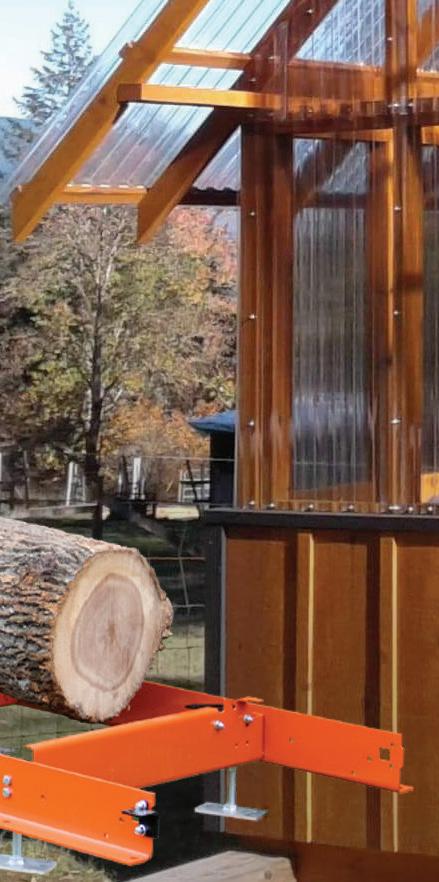

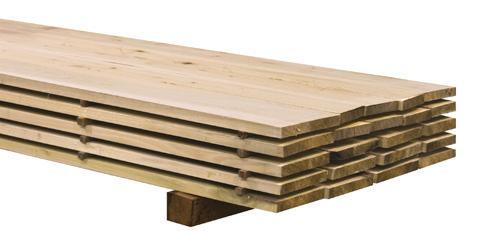

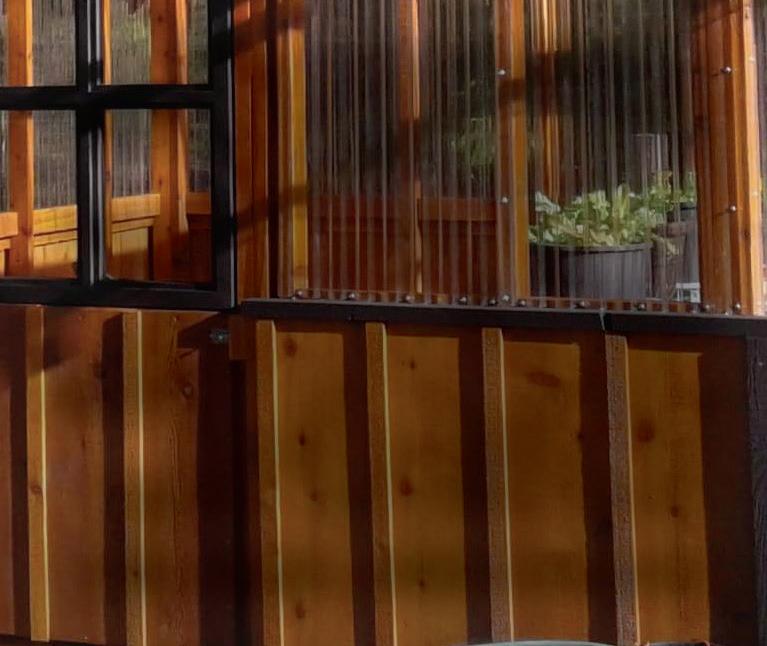



Live the wood life sustainably and get the most out of your natural resources by sawing your own logs into lumber with a Wood-Mizer portable sawmill. Sawing is an easy and fun way to save on the rising cost of lumber. With 15 models, we have the perfect sawmill built just for you. YOUR OWN LOGS INTO LUMBER! ” 15 SAWMILL MODELS starting with the LX25 at $4,095* © 2023 Wood-Mizer LLC *Price subject to change without notice. Live the Wood Life® is a registered trademark. 855.312.3550 Financing Available! woodmizer.com SINCE 1982 SAW YOUR OWN LOGS INTO LUMBER! 15 SAWMILL MODELS starting with the LX25 at $4,395* EQUIPMENT FOR SUSTAINABLE LIVING Live the wood life sustainably and get the most out of your natural resources by sawing your own logs into lumber with a Wood-Mizer portable sawmill. Sawing is an easy and fun way to save on the rising cost of lumber. With 15 models, we have the perfect sawmill built just for you. I have always wanted to build a greenhouse to extend my growing season. All western red cedar trees were harvested on my property and cut on my Wood-Mizer sawmill. It was very satisfying to build something from lumber I had milled myself. – Stan Kujala, British Columbia See #27 on page 60
DIY SpiralGarden
A garden spiralis a type of space-saving structure that can stretch a 5-foot-diameter bed to 20 to 30 linear feet. The spiral featured in this article was built by Kristen Noble, a vegetable product manager with Harris Seeds in Rochester, New York. It took only 45 minutes to construct, yet it’s a beautiful, long-lasting feature in the display garden and a practical place to trial herb seeds. You can also integrate irrigation or water catchments, such as a pond at the base of the spiral.
A typical spiral can be made from a variety of materials, such as wood, gabions, or straw bales. In this spiral, stone retainingwall blocks absorb and hold heat, which allows climate control and energy harvesting, making it an ideal structure for a mix of herbs with many different climate needs.

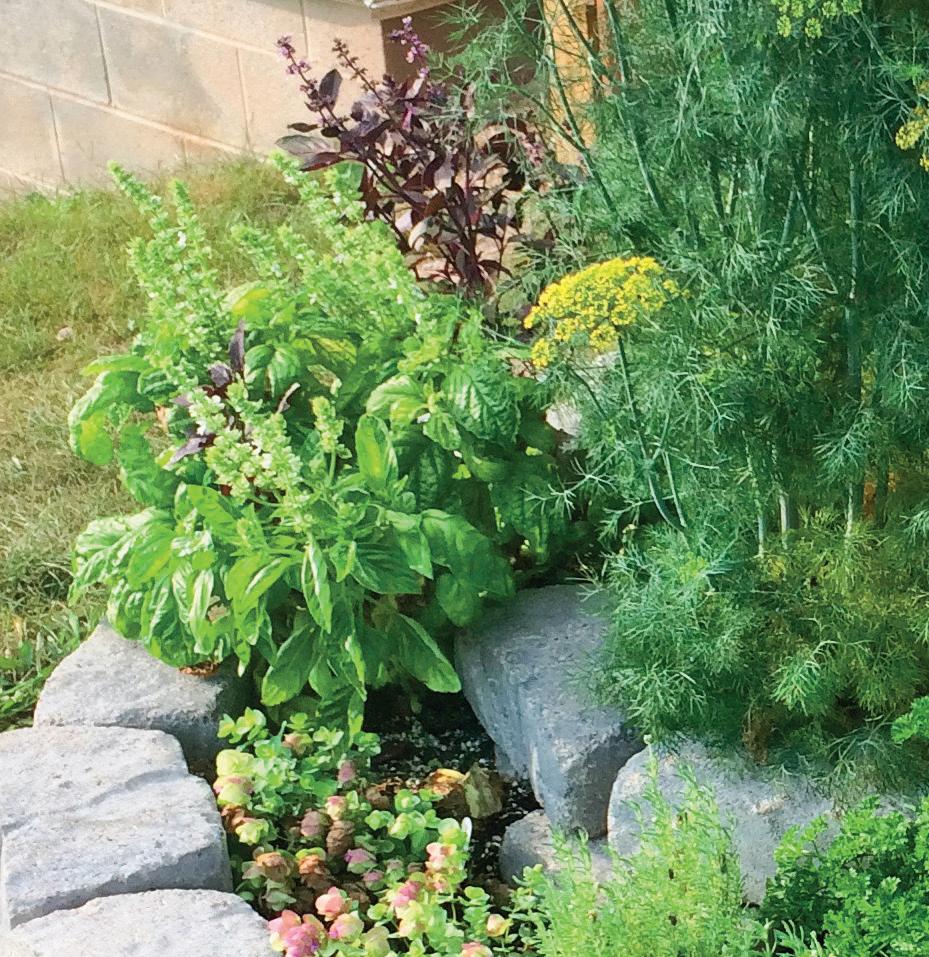
In cool climates, use materials that hold heat to increase the temperature of the soil. In warm climates, choose materials that don’t hold heat, such as wood and straw, to prevent the soil from getting too warm.




The south-facing side of the spiral will get full sun, while the north side will be shaded and cooler. The east side will get more gentle morning sun, but water will evaporate more quickly. The west side will get the harsher afternoon sun and heat but retain moisture in the morning. The top layers of the spiral will be drier, and the bottom will be wetter.
When the sun warms the stones, the entire bed will have warmer soil than what’s in the ground.
Build the Spiral
TOOLS AND MATERIALS
• Large level, or long 2x4 with smaller level attached

• String
• Stone retaining-wall blocks




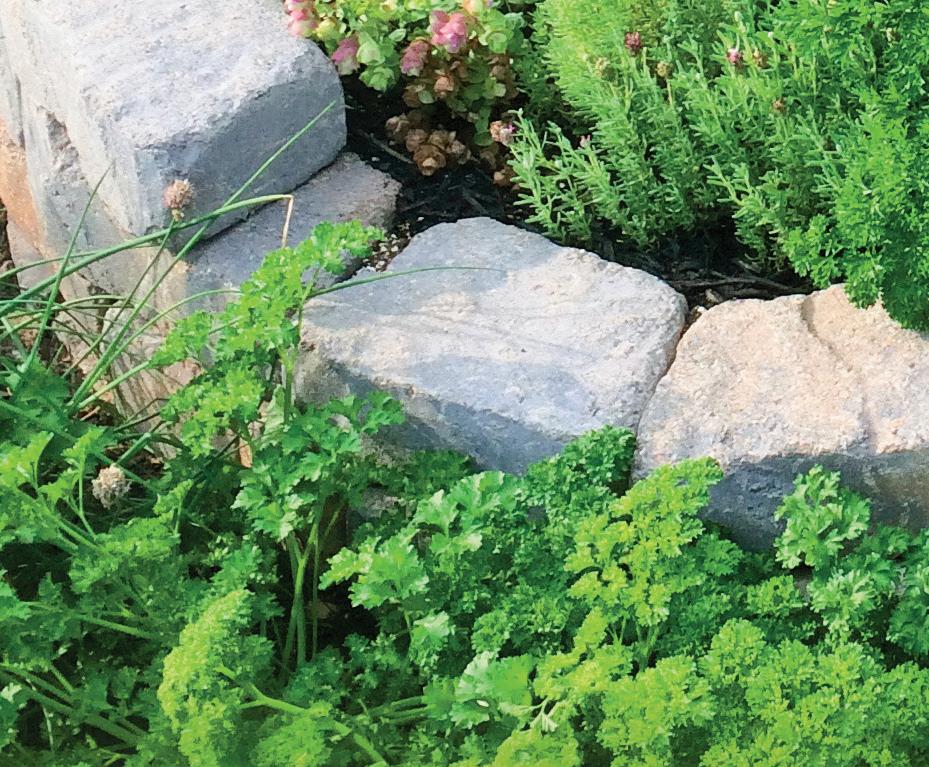
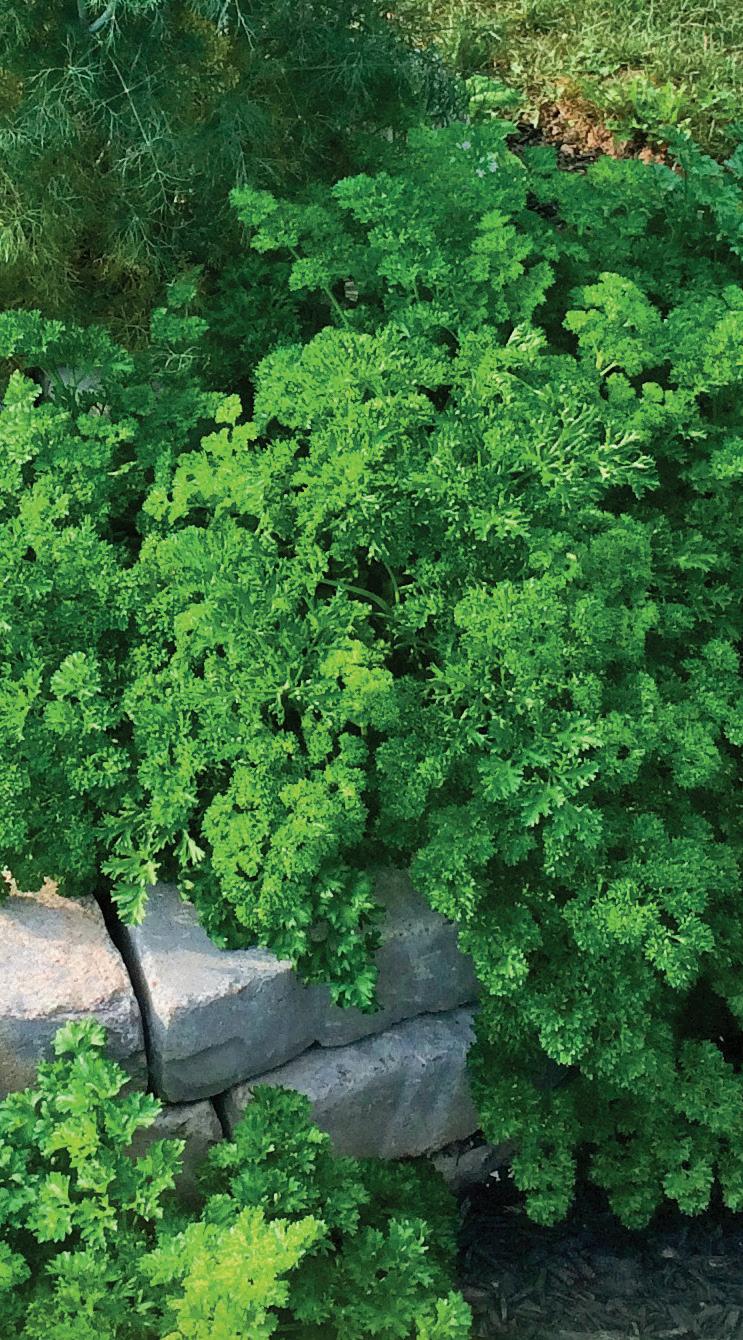
• Garden hoe

• Soil
DIRECTIONS
1. Level the soil where you plan to construct the spiral bed. If the area is grassy or weedy, remove the vegetation or cover it with a layer of damp cardboard. Choose a space at least 5 to 6 feet wide in all directions.


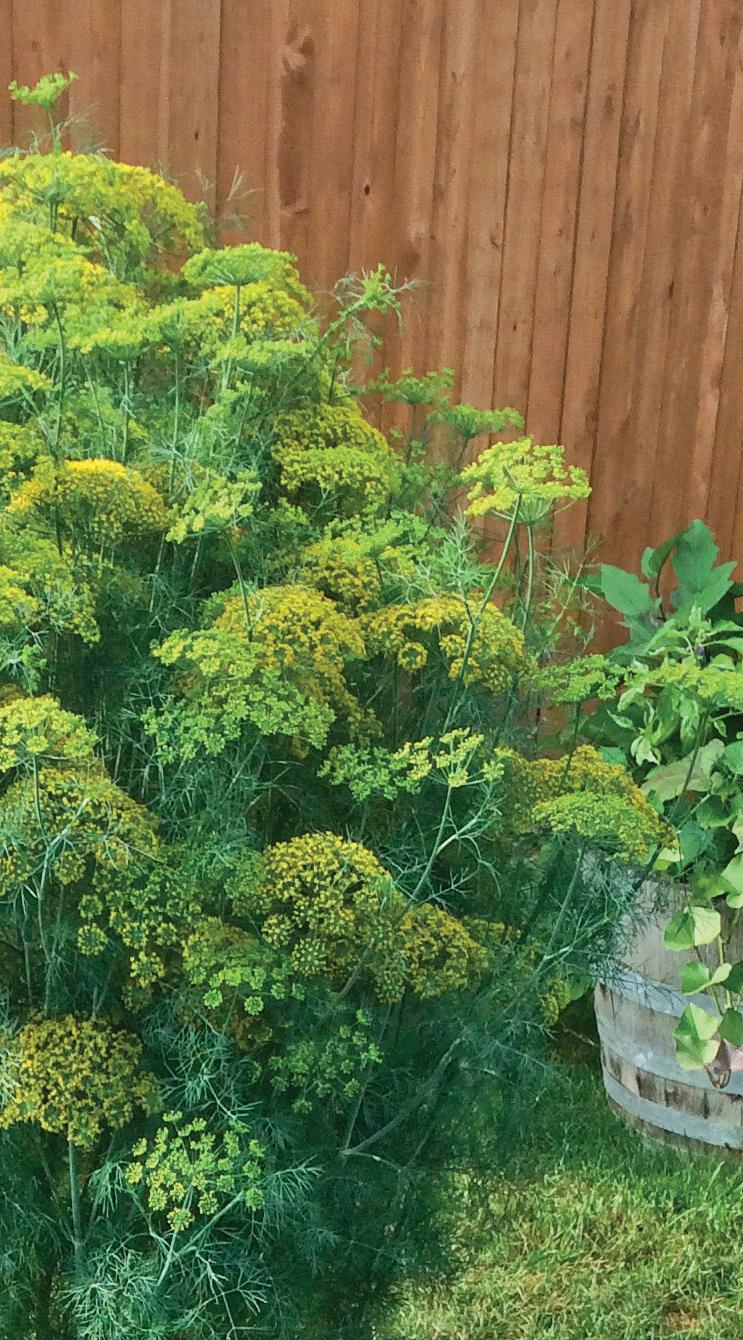
2. Use string to draw the shape of the spiral. Be sure to consider the size of the stones and allow enough space to plant between the walls of the spiral. Place the opening of the spiral toward the north side of the garden area, where it’ll receive less sun. Another option is to add a small pond at the opening of the spiral to grow watercress, water chestnuts, or other pond plants.
By Stephanie Rose
3. When placing the first layer of stones, use a hoe to lower the soil level where the stones will sit so they rest a few inches below the soil. This will help keep the foundation stones in place. While doing this, be sure to keep your soil level. Place the first layer of stones around the path of the spiral.
Boost your planting square footage and your garden’s visual appeal by building a spiraling structure in which herbs and flowers can flourish.
H ARRIS S EEDS March/April 2023 30
4. Add layers of stone to increase the height to four stones high at the top, or center, of the spiral. For improved stability, place the top layers of stones over the joint of the two stones below.

5. Start the second layer by overlapping the first stone at the outer edge. Start the third layer by overlapping the fifth and sixth stones of the second layer. Start the fourth layer by overlapping the fourth and fifth stones of the third layer.
6. Add soil to the spiral during construction to help hold the stones in place.

7. Once you’ve built the fourth layer, fill the bed and any gaps between the stones with soil. Water the bed to help the soil settle into the space.

8. Add drip irrigation around the spiral to allow for easier watering.
This excerpt is from The Regenerative Garden: 80 Practical Projects for Creating a Self-Sustaining Garden Ecosystem by Stephanie Rose (The Quarto Group).

The Regenerative Garden

80 Practical Projects for Creating a Self-Sustaining Garden Ecosystem
The Regenerative Garden by Stephanie Rose offers tips and tricks for achieving lush, productive, and resilient flower and vegetable patches without a ton of work or expensive inputs. Discover 80 projects that will put you and your garden in sync with nature, leading to reduced maintenance, wiser use of resources, and a garden that practically cares for itself. This is a must-have book for your gardening library.
This title is available at Store.Grit.com or by calling 866-803-7096. Mention promo code MGRPANZ5. Item #11719.
What to Plant and Where to Plant It


Reverse



EAST, BOTTOM Violets, pansies, cilantro, chervil
SOUTH, BOTTOM Feverfew, basil

WEST, BOTTOM Strawberries
NORTH, BOTTOM Lettuce, salad greens
EAST, TOP Calendula, chamomile, sorrel
SOUTH, TOP Echinacea, dill, rosemary, lavender, oregano, thyme
WEST, TOP Sage, yarrow, fennel, salad burnet
NORTH, TOP Parsley, chives


www.Grit.com 31
100% Employee Owned Non-GMO Safe Seed Pledge 100% Satisfaction Guarantee Selected for You With one of the most rigorous trialing programs in the industry, we ensure only the best seeds, tools, and supplies are offered to you. We want you to have a great growing experience. Johnnyseeds.com | 877-564-6697
these cardinal directions if you live in the Southern Hemisphere.
F ROM TOP : H ARRIS S EEDS ; S TEPHANIE R OSE See #11 on page 60
When the Lights Go Out WeatherRelated Power Outages



Knowledge and preparedness is key to anticipating the spectrum of damage that hurricanes, winter storms, and more can bring to the grid.



 By Ed Brotak
By Ed Brotak
March/April 2023 32
Power outages
can be more than just inconveniences. If they last long enough, they can become real threats to our well-being and even health. Power outages can affect just a single home or can be widespread, affecting millions of people. The most common causes of power outages are weather events, which can occur at any time of day or year. It’s important to understand these events and how to prepare and stay safe when the weather takes a turn.
Let’s start with some basic de nitions.

• Electrical grid, or power grid: Consists of generation facilities; transmission and distribution equipment, such as transformers, substations, and power lines to deliver the energy; and consumers who use the power.



• Power outage: An unexpected, complete loss of electrical power for a period of time (sometimes minutes, sometimes days or weeks) that results from failures in the power infrastructure.




• Blackout: A power outage that affects many people.



• Brownout: A reduction in voltage of the electrical system, resulting in a dimming of lights and other malfunctions of electrical devices.



• Rolling brownouts and rolling blackouts: Brownouts and blackouts that are planned by electricity providers to reduce demand, affecting a sequence of areas at different times.


Many types of weather events can cause outages, so your preparation and response may vary, depending on the weather that’s common where you live.
Storms
Thunderstorms
Thunderstorms are a common cause of power outages, and they’re most frequent in warmer months, although southern states can have them even in winter. Lightning can strike utility poles, transformers, or other electrical equipment, causing a power disruption. Electrical power surges associated with these storms are also possible. Typically, power outages due to lightning strikes would only affect small areas. However, lightning strikes

to a substation and power lines followed by some equipment failures and human errors led to the famed New York City blackout on July 13 and 14, 1977. Most of the city went dark that night. More commonly during storms, trees either drop branches or just topple over onto power lines. This could be because of a lightning strike or because of strong winds often associated with thunderstorms. In the most extreme (and fortunately rare) cases, a thunderstorm-produced tornado will certainly cause power outages.
One thunderstorm can cause power problems locally, but complexes of thunderstorms can bring widespread power outages. One particularly damaging thunderstorm complex is called a “derecho.” It can last for hours and cover hundreds of miles. On Aug. 10, 2020, a powerful derecho with estimated peak winds of 120 mph plowed through the Midwest. Central Iowa and northern Illinois were especially hard-hit. At one point, around 1.4 million people were without power, and power outages continued for several days. Another derecho with peak wind speeds again estimated at 120 mph moved through parts of Ontario and Quebec, Canada, on May 21, 2022. At its peak, more than 1 million people were without power, some for over a week. Repair costs shot into the tens of millions of dollars.
Winter Storms
Winter storms are typically associated with strong winds and copious amounts of precipitation, and they’re especially damaging if they consist of heavy, wet snow or ice-producing freezing rain. Power lines can come down on their own or, more likely again, when tree branches or whole trees fall on the lines. Power outages are often widespread, affecting many people. Such storms are associated with cold weather and are often followed by extremely cold weather with life-threatening temperatures.

In the middle of February 2021, a series of winter storms and an associated Arctic outbreak that brought temperatures of 40 degrees Fahrenheit below normal affected an area from Nebraska down to Texas. Damage from snow and freezing rain and
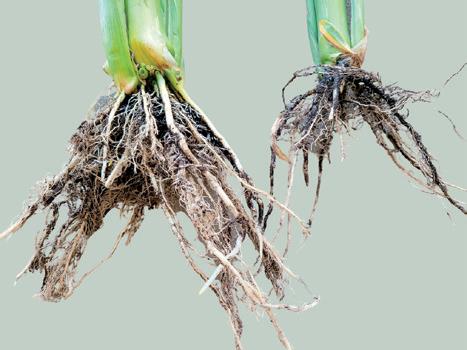

www.Grit.com 33
KozGro Treated Untreated B O O S T W O R M P O P U L A T I O N I M P R O V E G E R M I N A T I O N I N C R E A S E N U T R I E N T U P T A K E I M P R O V E S O I L F E R T I L I T Y B O O S T S T A L K & L E A F Q U A L I T Y B R E A K D O W N R E S I D U E w w w . K o z G r o O r g a n i c s . c o m P L A N T & S O I L B U I L D E R GardenGro Lawn & Landscape House Plant Elixir Agricultural Field Blend P AGE 32, CLOCKWISE FROM TOP : A DOBE S TOCK /3 ASY 60 LF A DOBE S TOCK / PASPHOTOGRAPHY ; A DOBE S TOCK /S ATOSHI K INA A DOBE S TOCK /D AN R OSS See #13 on page 60
a surge in power demand because of the cold resulted in a major power outage, with Texas being especially battered. At its peak, almost 10 million people were without power. In Texas alone, 246 people died, many from lack of power in bitterly cold conditions.
Hurricanes
Typically occurring in late summer and fall, hurricanes and even lesser tropical cyclones can bring an onslaught of damaging weather conditions. Powerful winds, coastal flooding with high storm surges, and inland flooding because of torrential rains can wreak havoc on power grids. These storms can stretch hundreds of miles across and take out power over large areas.
On Sept. 26, 2022, Hurricane Ian hit western Cuba as a Category 3 storm with 125 mph winds, causing the entire country’s power grid to collapse. Two days later, the storm hit Florida as a Category 4 storm with 150 mph winds, a record-breaking storm surge, and torrential rains. At its peak, more than 2.5 million people were without power. In Cape Coral, northwest of Fort Myers, officials said 98% of the city’s power structure was wiped out.
About a week before that, Hurricane Fiona hit Puerto Rico. At one point, all power on the island was cut off, leaving more than 3 million people without electricity. A week later, some people were still without power. Fiona was only a Category 1 hurricane, with winds under 100 mph, but massive rainfall (as much as 30 inches) produced major flooding, which did the damage. Five years prior, Category
4 Maria had hit the island and destroyed the island’s power grid with winds well above 100 mph. Full restoration was yet to be achieved even before Fiona hit.
In September 2017, powerful Hurricane Irma hit Florida before moving into Georgia and South Carolina. The strong winds over a large, heavily populated area resulted in a massive power outage. At one point, 6.7 million Floridians 64% of all electric customers in the state were without power. Some were without power for over a week. In addition, 1.3 million customers in Georgia and a half-million in neighboring states lost power. About 60,000 power workers from the United States and Canada were involved in power restoration there.
Floods, Slides, and Fires
Floods can impact electrical generation facilities, substations, and underground lines. On the local scale, flooded roads can keep crews from getting to downed lines. Flooding can occur because of the previously described storms or because of river flooding from excessive rainfall or snowmelt.
In mountainous terrain, even more power-threatening situations exist. Mudslides and rock slides, often because of heavy rains, can come thundering downslope, destroying power grid components (and everything else). In winter, extensive snowpacks resting on precariously tilted surfaces can release a downhill onslaught an avalanche. Power outages after avalanches are fairly common in such locations.
In my article on wildfires (“Raging Rings of Fire,” January/February 2019),
I described how weather conditions are a crucial factor in wildfire ignition and spread. Certainly, if a wildfire damages power-transmission equipment or a powergeneration facility, it can cause outages. Many wildfires are driven by strong winds, which can directly bring down power lines or cause tree branches or whole trees to fall on the lines. Even worse, downed power lines are also a frequent cause of wildfires when winds are strong so much so that in the western U.S., electricity providers may shut off power when strong winds are occurring to lessen the risk of wildfire ignition. These are called Public Safety Power Shutoffs. The public is warned, but these deliberate power outages can last for as long as dangerous weather conditions continue.
Overwhelmed Grids
Extremes in temperature can also cause power issues. Uncomfortably high temperatures don’t directly cause power problems; however, people will typically use more air conditioning than normal. Even without a damaging winter storm, sometimes unusually cold weather can cause problems. This is especially possible where electric heaters are widely used. Electrical consumption can increase to near or beyond maximum capacity, leading to deliberate brownouts or blackouts or outright blackouts.
Power outages can also be caused by elements beyond our planet. If we include the category of space weather, then we must include geomagnetic storms. Coronal mass ejections (CMEs) from the sun can interact with our atmosphere to induce
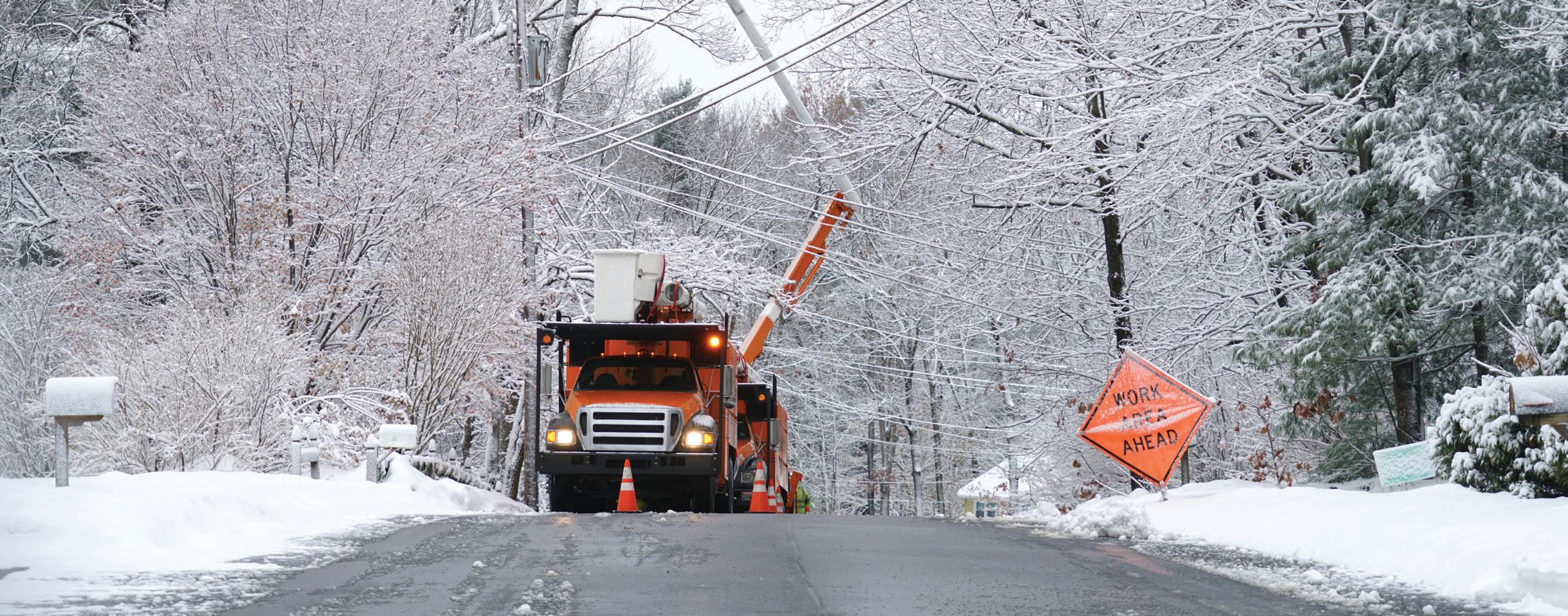 Winter storms can cause a great deal of damage, including downed power lines and widespread power outages.
Winter storms can cause a great deal of damage, including downed power lines and widespread power outages.
A dobe S tock / nd 700 March/April 2023 34
geomagnetic storms. These can and have resulted in power outages, primarily in the higher latitudes. According to the National Oceanic and Atmospheric Administration (NOAA), the strongest of these storms can cause widespread voltage control problems, protective system problems, and grid systems that experience complete collapse or blackouts, and these effects could extend as far equatorward as 40 degrees latitude.
The Quebec blackout on March 13, 1989, is considered to be a quintessential example of what can happen when a powerful geomagnetic storm occurs. Astronomers noted a massive CME on March 10. On March 12, a powerful geomagnetic storm developed in the Earth’s atmosphere. Electrical currents generated by the storm entered the Quebec power grid, shutting it down in the early morning of March 13. A 12-hour blackout followed that affected millions of Canadians. Although effects were felt below the border, U.S. grids managed to handle the situation, with no power outages occurring.

Power Outage Preparedness
How should you prepare for a possible power outage? If you have a generator, know how to use it. For getting the latest information when the power goes out, have a portable radio or a NOAA Weather Radio. For light, have ashlights or lanterns and plenty of batteries. (Small solar-powered lanterns and emergency candles can help save on the cost and use of batteries.) Keep about a week’s worth of drinking water. Not only may municipal water be cut off, but wells with electric pumps won’t work. Have about a week’s worth of nonperishable food and a manual can opener as well. Extra blankets and a tent placed in the center of a room can also help keep you warm if the power does go out.
To keep track of the weather in the U.S., the National Weather Service (www. Weather.gov) is the of cial source of all severe weather information. For Canada, it’s Environment Canada (www.Weather. GC.ca). Additionally, local authorities will provide more speci c information on current conditions.


If you know a storm is coming, ll up your vehicle with gas, since gas pumps won’t be working, and store an extra can of gas outside. Get cash before the storm, since ATMs won’t be functioning. Fully charge power banks, portable chargers, and all portable devices, especially cellphones.

For major storms, such as hurricanes, you may be asked or required to evacuate. Even if evacuations aren’t of cially required, those with health or accessibility needs will need to decide if leaving is the safest choice. This is especially true if medical devices needing electricity are essential. If you’re leaving, disconnect all appliances and turn off your electricity.
If you stay and the power goes off, disconnect all appliances to prevent powersurge damage. Limit opening refrigerators and freezers to keep food as cold as possible. Even without electricity, food can stay good if the internal refrigerator and freezer temperatures stay below 40 degrees, but temperatures above 40 degrees will only keep food good for a couple of hours at most. If the electricity is still on and you have ooding, never go into your basement or any room where electrical outlets or cords are submerged. Go to a community shelter if things are untenable at home, especially if it’s extremely hot or cold.
If you’re outside during or after a storm, stay away from downed power lines. Never drive over them. Even if the lines are dead, your car can become entangled in them and pull down more lines or even a pole. If the line is live, you could be electrocuted if you leave your car. Stay in your vehicle until utility workers can depower the line.
Stay aware and equipped if the lights go out. Research the weather in your area, prepare some supplies, and develop a safety plan for your household so you can take proper action during a weather event.
Ed Brotak taught college students about weather for more than 30 years and led many of them to pursue careers in meteorology. He lives in Asheville, North Carolina, with his wife (who’s also a meteorologist).
FAST & EASY STUMP REMOVAL
• Efficient PTO powered stump grinder makes stump removal easy.
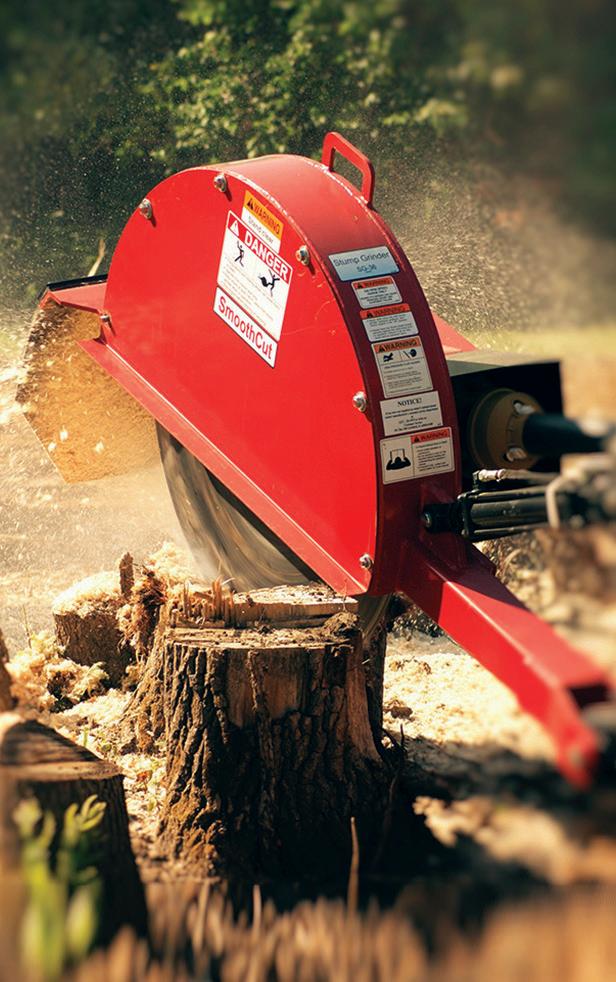
• Easy operation from the seat of the tractor using existing tractor hydraulic controls.
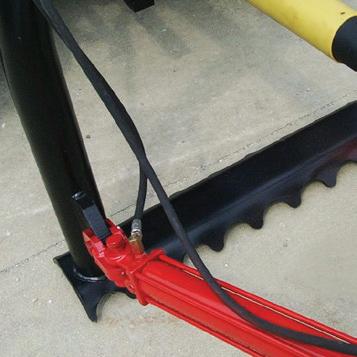
• Cutting wheel design provides a smoother cutting action for higher productivity.




• Models designed for tractors 22 -50 PTO HP and 45- 100 PTO HP.

DESIGNED. ENGINEERED. REMARKABLE VALUE.
Worksaver, Inc. Litchfield, IL Phone: 217.324.5973 WORKSAVER.COM See #28 on page 60 www.Grit.com 35
SmoothCutTM PTO Powered Stump Grinders
BREEDING RATIOS for Chickens and Ducks


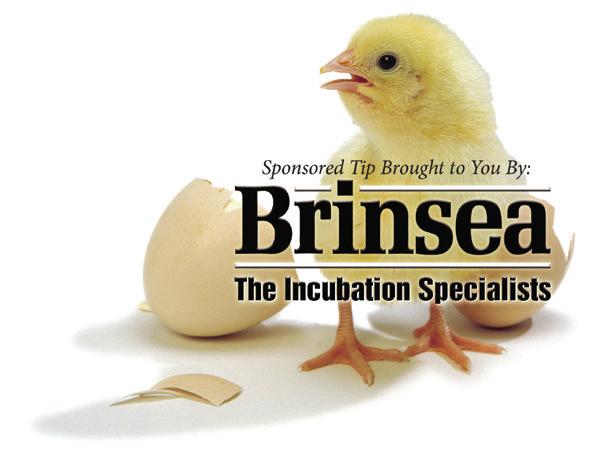









Find out how many males you need in your flock for fertile eggs.
 By Doug Ottinger
By Doug Ottinger
Ensure a Successful Hatch
Several factors pre-incubation can affect the hatchability of your eggs. Eggs laid into soiled nest boxes are at risk for shellborne infections, and cracks and flaws in the shell can increase the eggs’ vulnerability to bacteria. Physical trauma, such as shaking eggs, can cause damage to internal structures, and rolling eggs repeatedly in the same direction can twist the chalazae — the membrane that holds the developing chick suspended in the shell. Handling eggs with care, keeping nest boxes clean, and washing your hands before handling eggs you intend to incubate can go a long way toward ensuring a successful hatch.
March/April
36
2023
Have you ever













wanted to incubate eggs from your chickens or ducks and wondered how many males your flock needed to ensure most eggs were fertile and would hatch? Will one rooster with six hens be enough? Will two roosters and 20 hens work? How many male ducks do you need if you want to hatch some duck eggs? You can find answers in many poultry textbooks and all over the internet, but those answers can vary widely; some breeding ratios may work better than others.
Chickens




Hens produce the most eggs with the best overall quality during their first year of production. Young roosters tend to be more sexually active than older males and have higher fertility levels. For these reasons, most commercial hatcheries don’t keep their breeding birds longer than one laying or breeding season. Raising replacement flocks is a constant process and a very real part of the business.
In small home flocks with only one or two roosters, problems with overall fertility can result from roosters breeding a few favorite hens, a rooster being overeager and not successfully joining his cloaca to the hen’s before semen release, or roosters simply being too docile.


Fertility decreases as roosters get older. If you want to increase fertility in eggs laid by older hens, research has shown that replacing an older rooster with a younger, more virile rooster can help boost dwindling fertility.






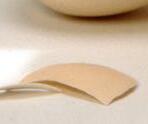








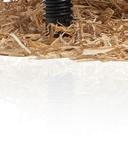
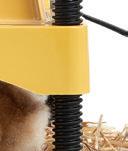



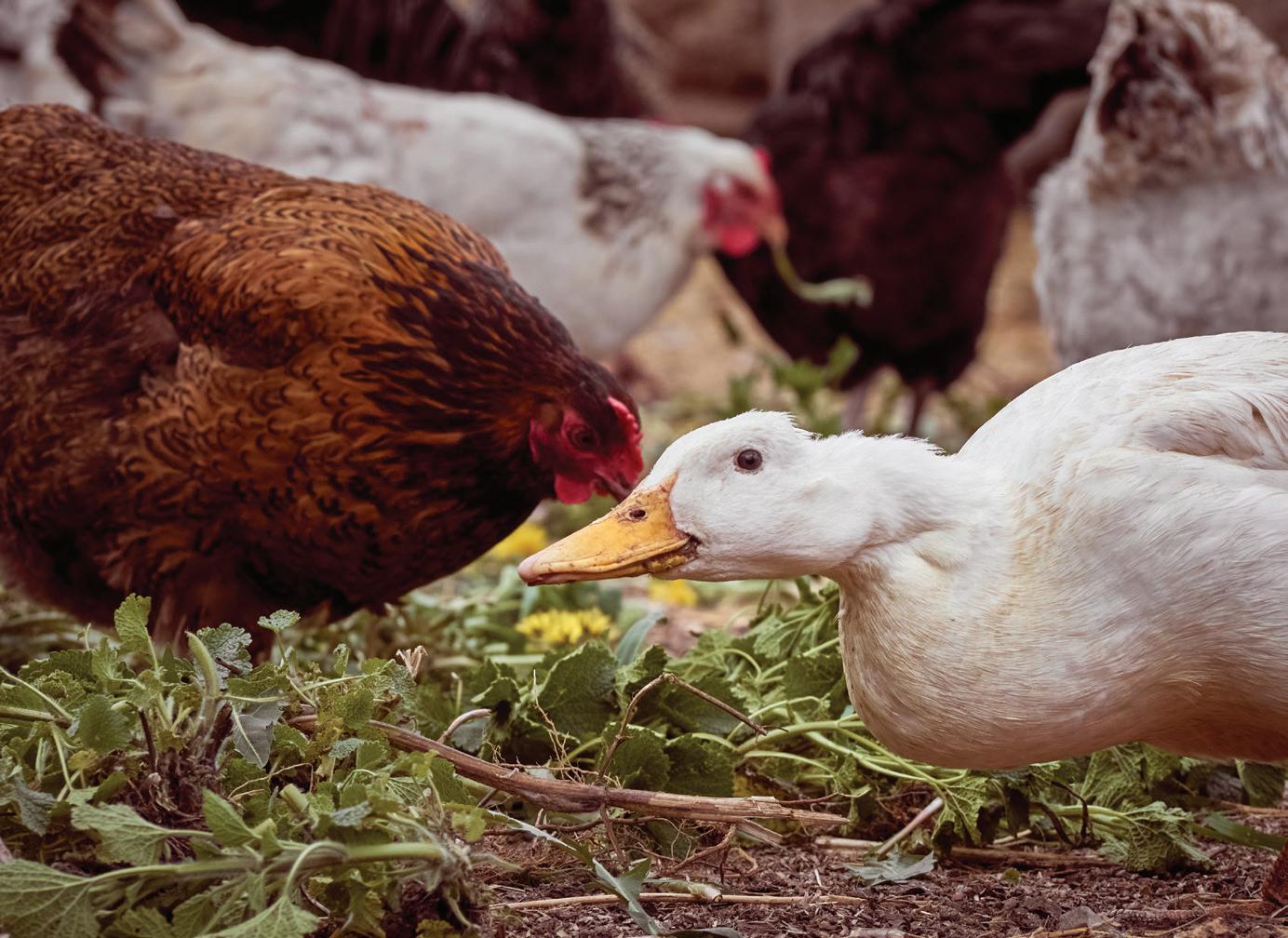
To find out which male-to-female ratios breeders use in the hatchery industry where maximum fertility is necessary to achieve profit I turned to the owners of two chick hatcheries for answers.


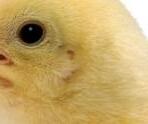

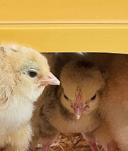
Etta Culver, owner of Schlecht Hatchery in Miles, Iowa, has spent more than 50 years in the hatchery business. Started by her father many years ago, the hatchery has a successful history of producing day-old poultry for multiple generations of customers. I asked Etta what breeding ratios for chicken flocks seem to work best. Etta maintains a 1-to-7 ratio: 1 rooster for every 7 hens in the flock. Schlecht’s breeding flocks each average about 125 hens during the breeding season. Thus, for each 125hen flock, she keeps 17 to 18 roosters as well. Some poultry textbooks teach that breeders can maintain lighter, more active breeds, such as Leghorns and Mediterranean fowl, with ratios as low as 1 rooster to 18 hens. I asked Etta about this advice. Having raised Brown Leghorns for many years, she’s wellaware of these birds’ breeding habits.
Brinsea the world leading incubator manufacturer has a full line of incubators, brooders, egg candlers, starter kits and much more! All with 3 year warranty.

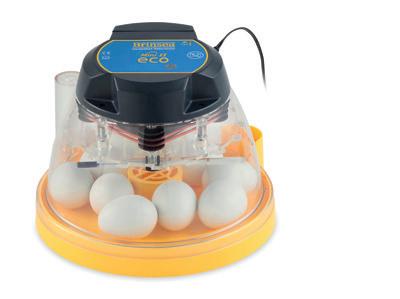
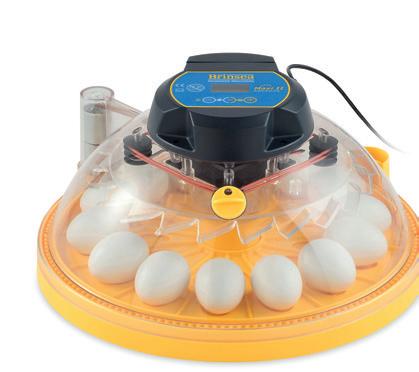
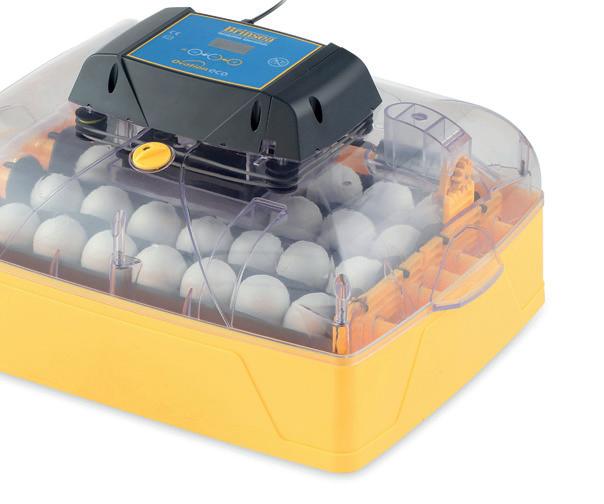
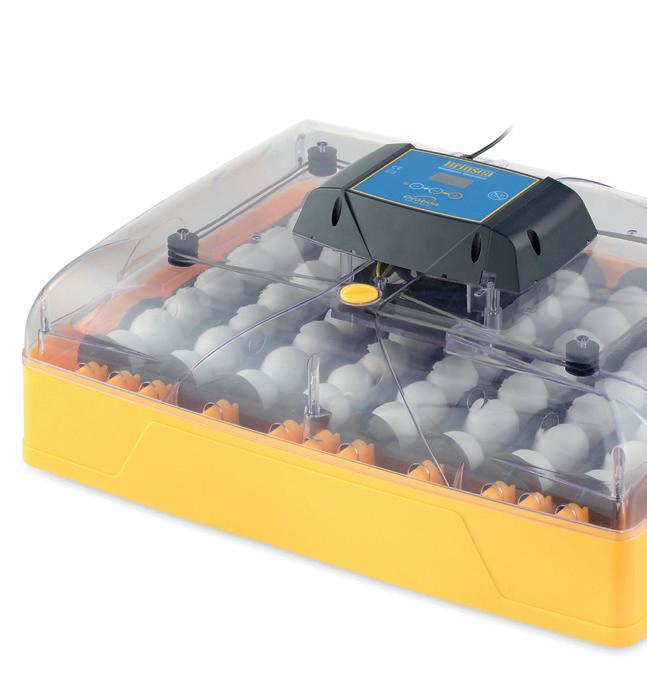



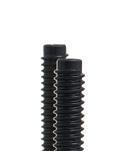

A dobe s tock / k ulb A bk A ; o pposite : A dobe s tock / c herries
Incubation Specialists For more information www.brinsea.com or call 1-888-667-7009
Breeding ratios for ducks and chickens are similar, and knowing what works is beneficial to the health of your flock.
Free Color Catalog Hatching your own chicks is fun,
reliable with Brinsea Ifahencould choose… See #4 on page 60 www.Grit.com 37
easy and
She replied that though these roosters tend to be more aggressive breeders, such scant ratios aren’t realistic. Even with these birds, she still maintained a 1-to-7 balance during the years she raised them.
Christina Sauls, owner of Happy Feet Hatchery in Eustis, Florida, also shared her breeding ratios and what seems to work best. Happy Feet Hatchery maintains smaller flocks, but they individually examine each breeding bird to ensure it meets the American Standard of Perfection guidelines. The hatchery specializes in a selection of larger breeds of fowl.
Christina’s minimum breeding ratio is 1 rooster to 10 hens, but she might go as high as 2 roosters for 10 hens; a 1-to5 ratio. A flock of 20 hens will have a minimum of two and a maximum of four roosters. Going higher isn’t practical, as hens can be damaged from over-breeding. Fertility can also drop if the roosters begin establishing dominance among themselves instead of breeding. Christina raises all the birds in each breeding flock together to keep the roosters from fighting (although some minor fighting is still bound to occur), starting as day-old chicks. She doesn’t add new breeding cockerels or roosters to an established flock. Because of second-year fertility drops, Happy Feet raises new breeders every year.
Christina noted low fertility in the more docile breeds, such as Wheaten Ameraucanas. Being highly docile, the roosters are less-than-aggressive breeders, causing fertility issues in flocks.
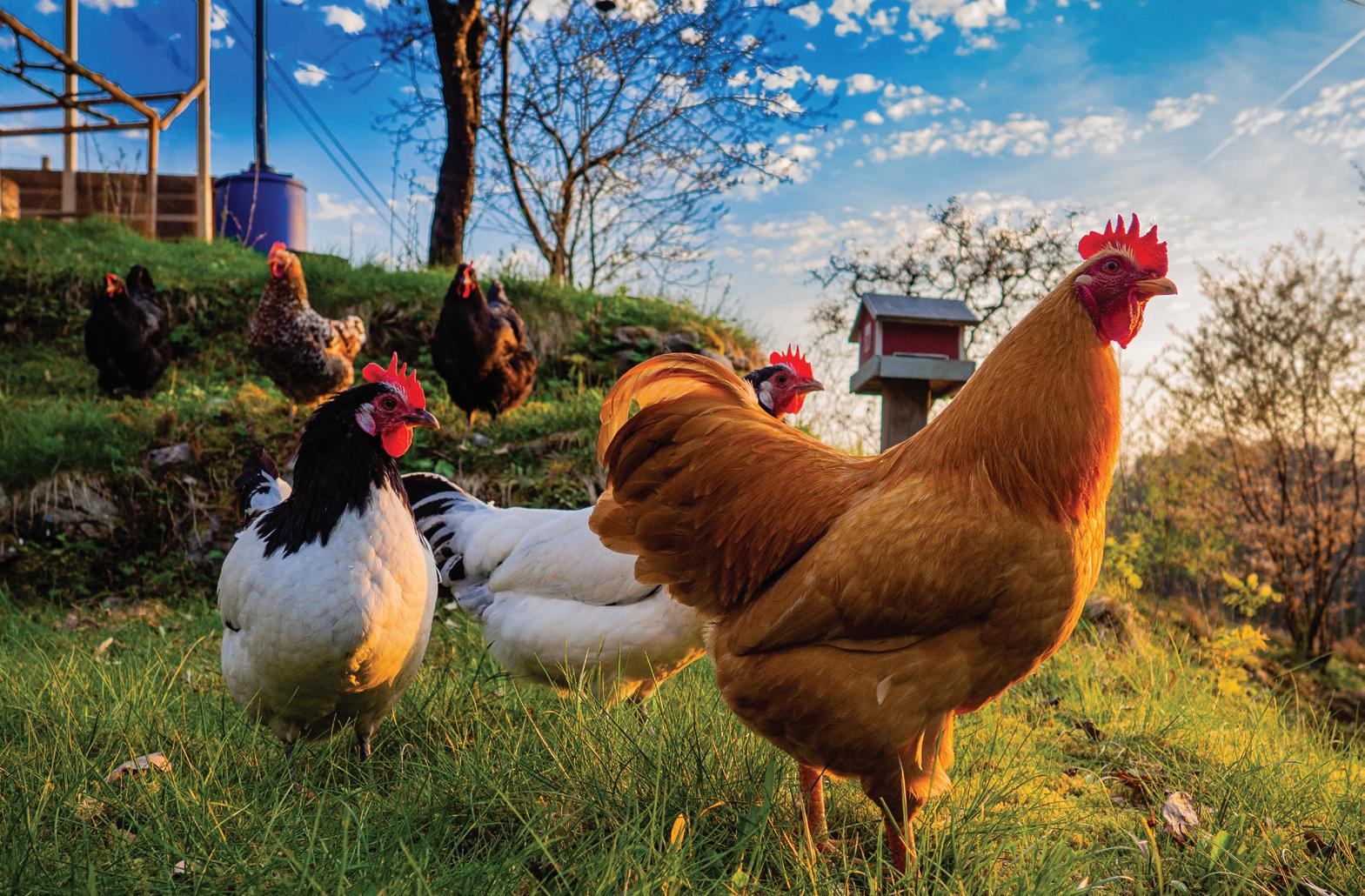
Ducks
John Metzer of Metzer Farms, a prominent waterfowl breeder and hatchery in Monterey County, California, was willing to share information about breeding ratios and other issues in managing a flock of breeding ducks.

According to John, Metzer maintains breeding flocks of one drake (male duck) for every five ducks (hens). This includes most large breeds and Runner ducks. John said Muscovy breeding flocks are also often maintained at a 1-to-5 ratio. The one exception in Metzer’s flocks is the Khaki Campbell breed. These flocks start at a 1-to-6 ratio, because the males of this breed
are such aggressive breeders, they can damage females with too much breeding.
Male ducks have a phallus tucked inside their vent. At the time of mating, it whorls out from a tight corkscrew within the vent and penetrates the female’s vaginal tract. High-resolution imaging of mating has shown the entire act finishes in about one-third of a second. By constant penetration of the females, repeated trampling from mounting during mating, and continuous grabbing and yanking of the feathers on the back of a female’s head, drakes can seriously injure weaker females. During the breeding season, hatcheries watch flocks closely for injury and overbreeding. They take rapid steps to pull males from the flock to lower the ratios if they see evidence of harm.
Metzer raises new breeding flocks every year and hatches ducklings for the replacement flocks in July. After 2
weeks of age, the hatchery supplies them with 17 hours of light per day during the growing period. Depending on the breed, ducks start laying and breeding between December and February. The flocks serve as breeding stock for 42 to 46 weeks until laying and fertility levels slack off. At that time, the new breeding flock is ready, and the process starts over.
Even if you don’t raise poultry commercially, ensuring a reasonable male-to-female breeding ratio and using younger, more virile breeding stock will go a long way toward increasing fertility and hatch rates in your eggs.
Doug Ottinger and his wife raise chickens, ducks, and geese on their small hobby farm. His educational background is in agriculture, with an emphasis in poultry and avian genetics.

from top : A dobe S tock /A ndy m ellow ; A dobe S tock / e len A thewi S e March/April 2023 38
Fertility for chickens and ducks can vary, but a reasonable male-to-female ratio will increase your success.































__________________ More than 3,000 pet and livestock medications conveniently delivered right to your door. Visit us at: www.allivet.com Scan to visit www.allivet.com Limited Time Offer *exclusions apply Save $20* on your first AutoShip with GRIT20AS .com pet See #1 on page 60
Tilling a New Garden Bed
Story and photos by Juliet Blankespoor
Tilling refers to digging up and turning over the soil. I’ve used a double-tilling method many times to create new garden beds out of lawn or eld. If you’re blessed with fertile, loamy soil, you may not need to till. But for compacted soils that are relatively infertile, tilling at the outset of a garden’s formation will yield dramatic results for decades to come. Tilling is an easy way to incorporate large amounts of organic matter into the soil and increase soil porosity.
Fall or early spring is an ideal time for tillage, because grass and other existing plants are less likely to sprout up from roots. If you can prepare your garden in fall, consider planting a fall cover crop — a planting designed to protect the soil from


erosion and build soil fertility — after tilling to suppress weeds. This is the best way to ensure you’ve eradicated the grass, especially if you have a particularly invasive or tenacious grass species. Come springtime, you can till or dig the crop into the soil to build its fertility and structure. Contact your local agricultural extension agent to nd out which fall cover crops are best for your area. Planting a bean-family cover crop will help build nitrogen levels and contribute organic matter to the soil. You can rent tillers from local equipmentrental facilities, borrow a neighbor’s, or hire a local farmer or landscaper to come out and till for you. If you have a small garden and tilling isn’t practical, use a pointed shovel to break up the soil and incorporate amendments.
Double-Tilling to Create a New Garden Bed
Step 1: Prepare for your garden’s creation by testing your soil’s pH and nutrient levels and deciding which amendments you’d like to add. In general, I like to add as much organic matter as possible to new garden beds, along with a smattering of organic fertilizer. In the past, when I’ve added only organic matter without fertilizer, plants have been stunted during the garden’s rst year. It takes time to build soil fertility, and fertilizer can help nurture plants in a new garden bed until the soil matures.
In general, sandy soil bene ts from the incorporation of leaf mulch, pine bark nes, and aged manure and compost. Clay is also a useful addition and helps
Prepare your plot for a new year of growing with this simple yet effective technique.
March/April 2023 40
with water and mineral retention. Many of these amendments are available by the truckload from mulch yards, farms, and nursery supply outfits and can be delivered to your site. If you aren’t familiar with the wonders of pine bark fines, prepare to become a convert! They’re a by-product of the pulp and logging industries, consisting of the ground-up bark of pine trees. Also sold as “soil conditioner,” this extraordinary brown fluff assists with drainage and water retention, has a near-neutral pH,
The Healing Garden
Cultivating and Handcrafting Herbal Remedies
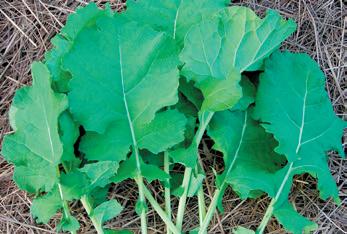

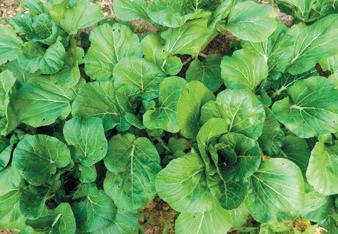


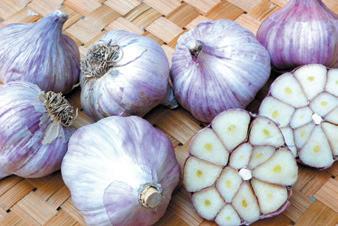
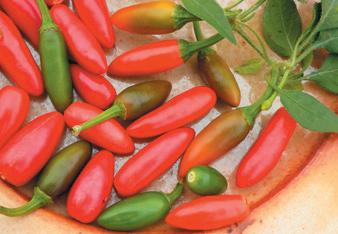
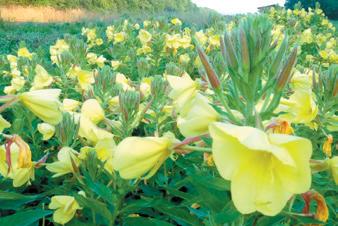
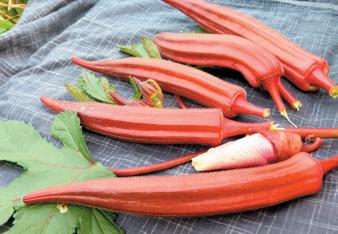
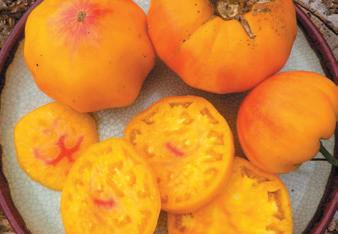

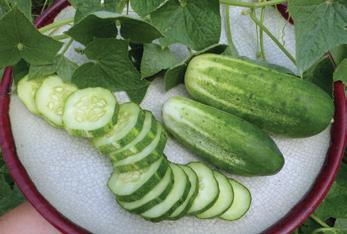

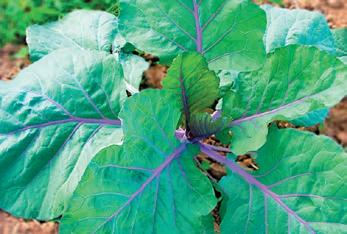
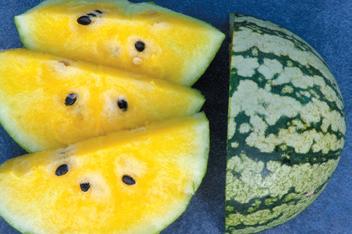

The Healing Garden is the ultimate reference for anyone looking to bring the beauty and therapeutic properties of plants into their garden, kitchen, and home apothecary. Both informative and accessible, this book gives you expert advice on planning your garden, detailed profiles on must-know plants, step-by-step tutorials for preparing botanical medicine, 70 different recipes, and more. Packed with sumptuous photography, this book will appeal to home gardeners who want to branch out to culinary and medicinal herbs, home cooks who are interested in natural wellness, and novice and skillful herbalists.

This title is available at Store.Grit.com or by calling 866-803-7096. Mention promo code MGRPANZ5. Item #11738.



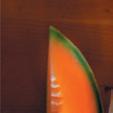
and slowly degrades into the lushest of organic matter over time.
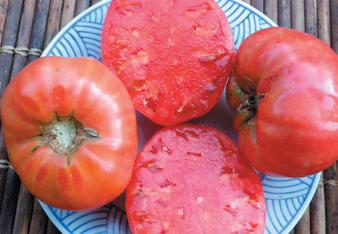
Compacted or clay soils benefit from materials that assist with drainage, such as coarse sand or pine bark fines, in addition to aged manure and compost. You’ll often hear that you should never add sand to clay soils because it can create a nearconcrete hardness, but in my experience, if you add enough organic matter with the sand, it shouldn’t be a problem. Coarse sand is especially helpful if you want to grow plants that thrive in well-drained
soils, such as Mediterranean herbs. Let the results of your soil test dictate which organic fertilizers and amendments to use.
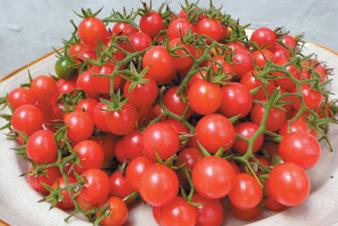

Step 2: Till your garden area with a walk-behind rotary tiller (a rototiller, for example) or a tractor. If you’re working with a shovel, you can similarly turn over soil and break it up into smaller pieces. If you have large clumps of soil or plants left behind, break them up with a hoe or shovel. Using a hard rake, gather any sod and compost it. Let the ground sit for 2 to 3 weeks.
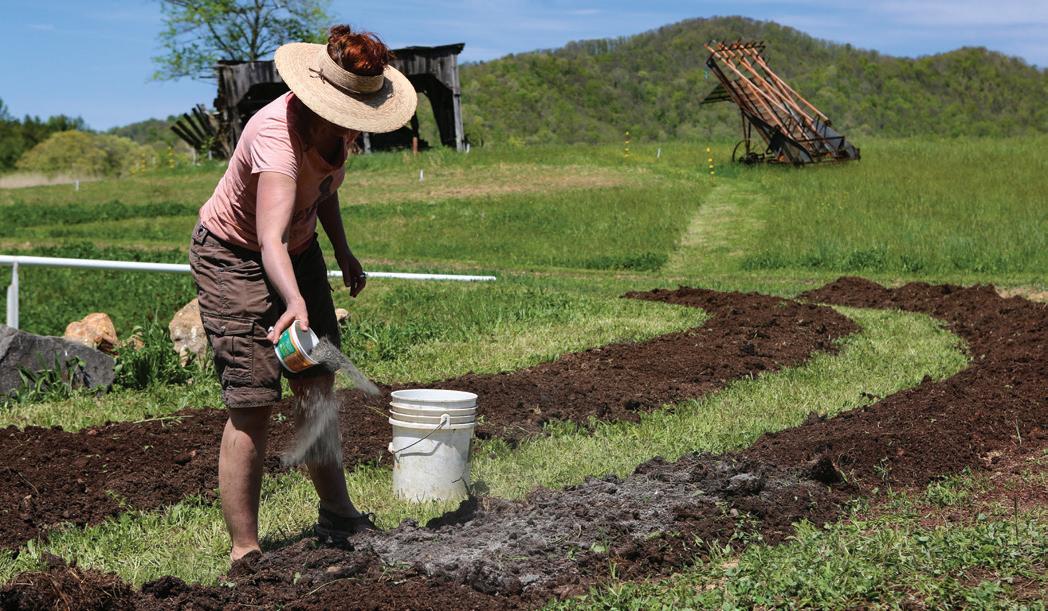
Southern Exposure Seed Exchange

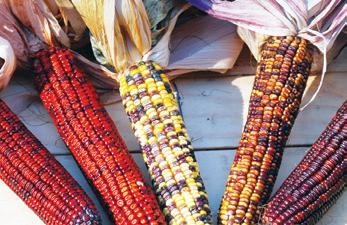
Saving the Past for the Future
You’ll nd us on our farm in the rolling hills of Louisa County, Virginia. You’ll nd our network of small farm seed growers throughout the U.S. Free Catalog & Garden Guide:

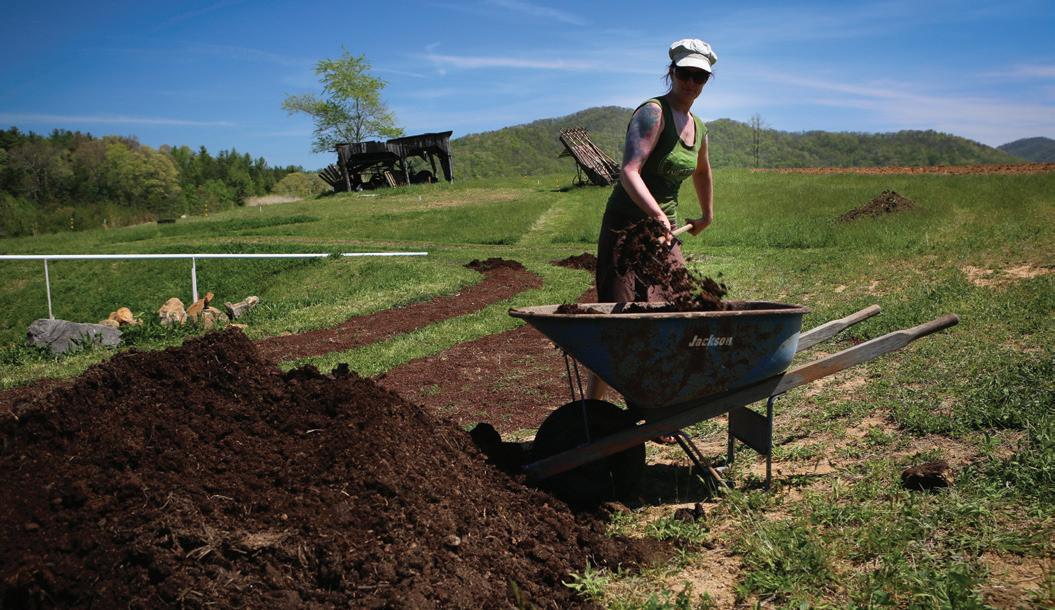 Double-tilling your garden bed will allow you to add soil amendments while eliminating any dormant weed seeds. Wear safety goggles if applying powders or lightweight fertilizers.
Double-tilling your garden bed will allow you to add soil amendments while eliminating any dormant weed seeds. Wear safety goggles if applying powders or lightweight fertilizers.
www.SouthernExposure.com
See #24 on page 60 www.Grit.com 41
Step 3: Add the organic matter and amendments you chose in the first step, and till a second time to mix them in and further break up the soil. Wearing safety goggles, spread powders or lightweight fertilizers on a relatively still day. After the initial tilling, the exposed roots and unearthed seeds will have sent out a flush of greenery. This second tilling will knock back the emerging weeds and grass. If your soil is still relatively compacted, run the tiller through a third time.
Step 4: After the equipment has run through the beds a few times, you’ll want to come in with hand tools to finish the job. Use a hard rake to gather any remaining sod and compost it. Rotary tilling breaks up a shallow layer of the soil, leaving the deeper layers untouched. Use a shovel or a hoe to break up any large clumps and lightly loosen the lower layers of soil, or double-dig the garden beds by removing the upper 8 inches of topsoil and placing it aside. Then, break up the subsoil layer, loosening the soil to about 8 inches deep. Replace the topsoil and break that up too.
Step 5: Prepare and flatten the beds to 3 to 4 feet wide. Flattening and shaping garden beds is best achieved with a flat, hard metal rake (often called a “bow rake”). Stake out the ground using strings as guides to help keep the beds straight and of equal width if you’re going for uniform beds.
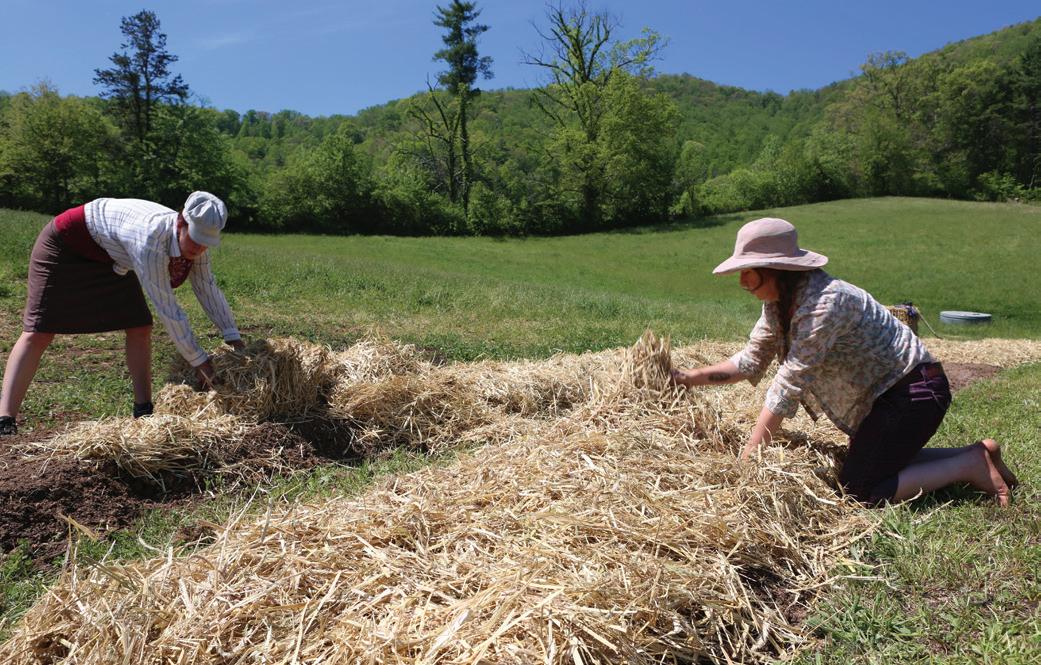
Step 6: Mulch the prepared beds if you’re planting seedlings right away. If you’re planting seeds or a cover crop, there’s no need to mulch. Mulching soon after disturbing the soil will keep sprouting weeds to a minimum. If you originally had tenacious grass in the garden area, mulching will keep any remaining roots from emerging. After mulching, you can plant your seedlings right into the mulch. Behold the pictures of my most recent garden, created with this very method.
Ongoing Maintenance
After this initial tilling and garden bed creation, you may not need to till in subsequent years, especially if you generously add mulch, frequently plant cover crops, and side-dress (add amendments and soil conditioners
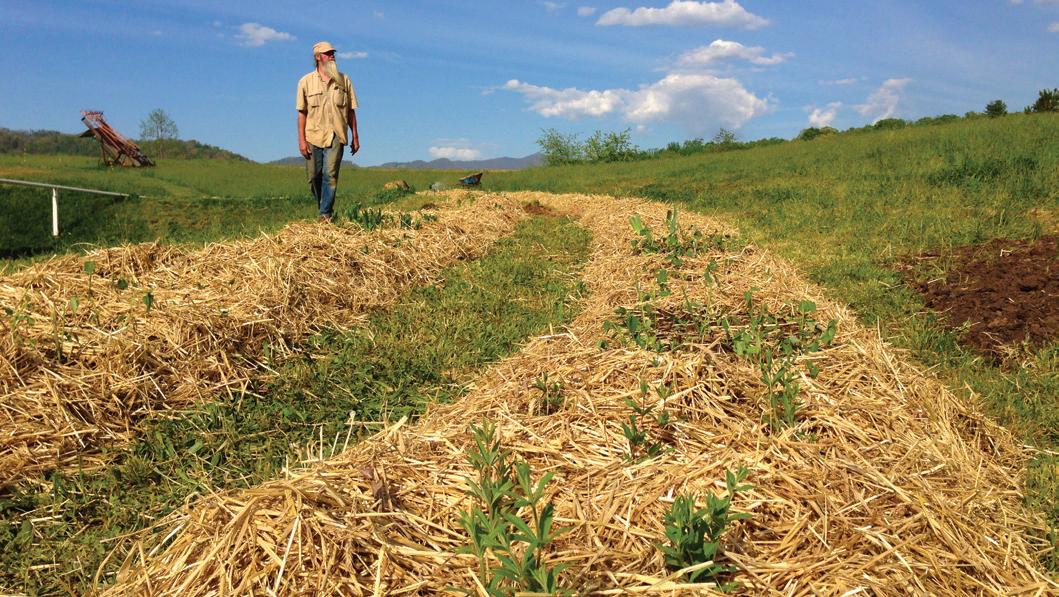


around the bases of established plants) with compost and manure. The primary advantage to not tilling is that you’ll maintain the integrity of the soil strata, with their finely tuned communities of beneficial soil microbes and earthworms. Tilling compromises the structure of soil and disrupts soil microbe communities. That said, the pros of initial tilling in garden creation outweigh the cons.
From The Healing Garden by Juliet Blankespoor. Reprinted with permission of Harvest, an imprint of HarperCollins Publishers. The book comes with an online portal of free gardening charts, 10 video tutorials, and regional herb gardening profiles. For booksellers and book bonuses, visit HealingGardenGateway.com.
Juliet Blankespoor is the founder of the Chestnut School of Herbal Medicine. She has a degree in botany and over 25 years of experience teaching and writing about herbal medicine, botany, plant propagation, and organic herb cultivation.
 Left: After tilling, break up any large clumps in the topsoil and subsoil. Right: Mulching the garden bed can keep weed seeds at bay and prevent grass roots from appearing.
Left: After tilling, break up any large clumps in the topsoil and subsoil. Right: Mulching the garden bed can keep weed seeds at bay and prevent grass roots from appearing.
March/April 2023 42
Once you’ve finished tilling your garden bed, continue to improve the health of the soil by adding mulch, cover crops, and soil amendments and conditioners.





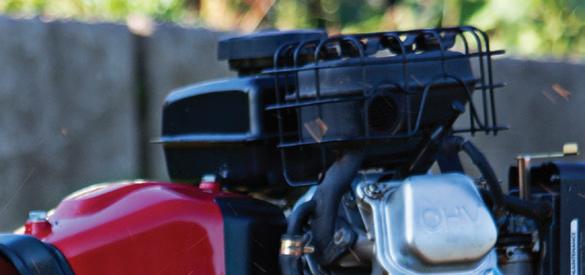


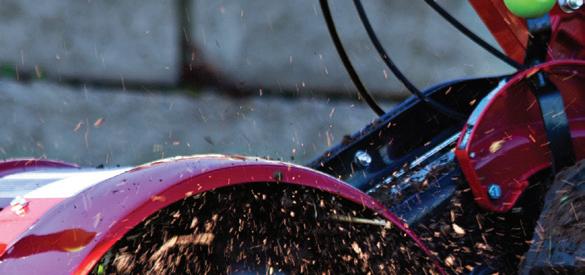
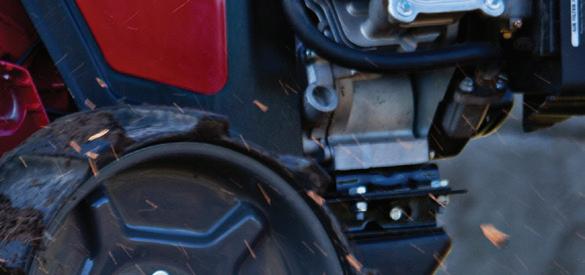
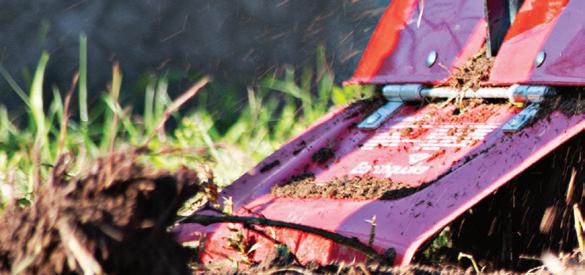
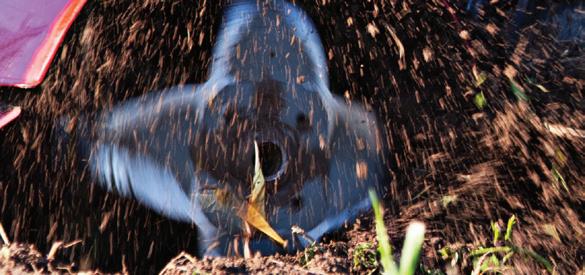











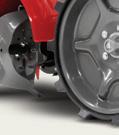




















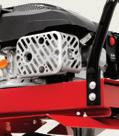








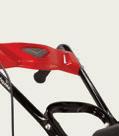








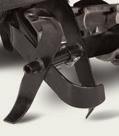

See #3 on page 60
SOLID STONEWORK Building Thrifty Fence Posts
In the Rocky Mountain region, rocks proliferate at an incredible rate. They don’t even require water or fertilizer. Every spring, the Earth gives birth to more. What can we do with this bumper crop of well-rounded, glacially altered lumps of ground-up ancient mountain range? Fences. Or, more accurately, fence posts.
Building fences from eld stones is an old agricultural practice. As we started fencing our small acreage in the Bitterroot Valley, Montana, I thought about those old-timers and the durability of their stone fences. However, since we don’t have 300 years, 100 employees, or the patience of our forebears, we decided to forgo the complete stone fence and con ne the stonework to posts in strategic locations: the weakest spots in fence construction, corners, gates, and terrain transitions.
Sturdy Stone Fence Posts
TOOLS AND MATERIALS
• Nails
• Barbed fence staples
• Backhoe
• Carpenter’s level
• Sledgehammer
• 6½-foot wooden posts
• Small sticks
• Field stone
• 5-foot-wide, 2-by-3-inch rectangular galvanized welded-wire fencing
DIRECTIONS
Here’s our method for building a stone fence post without using cement.
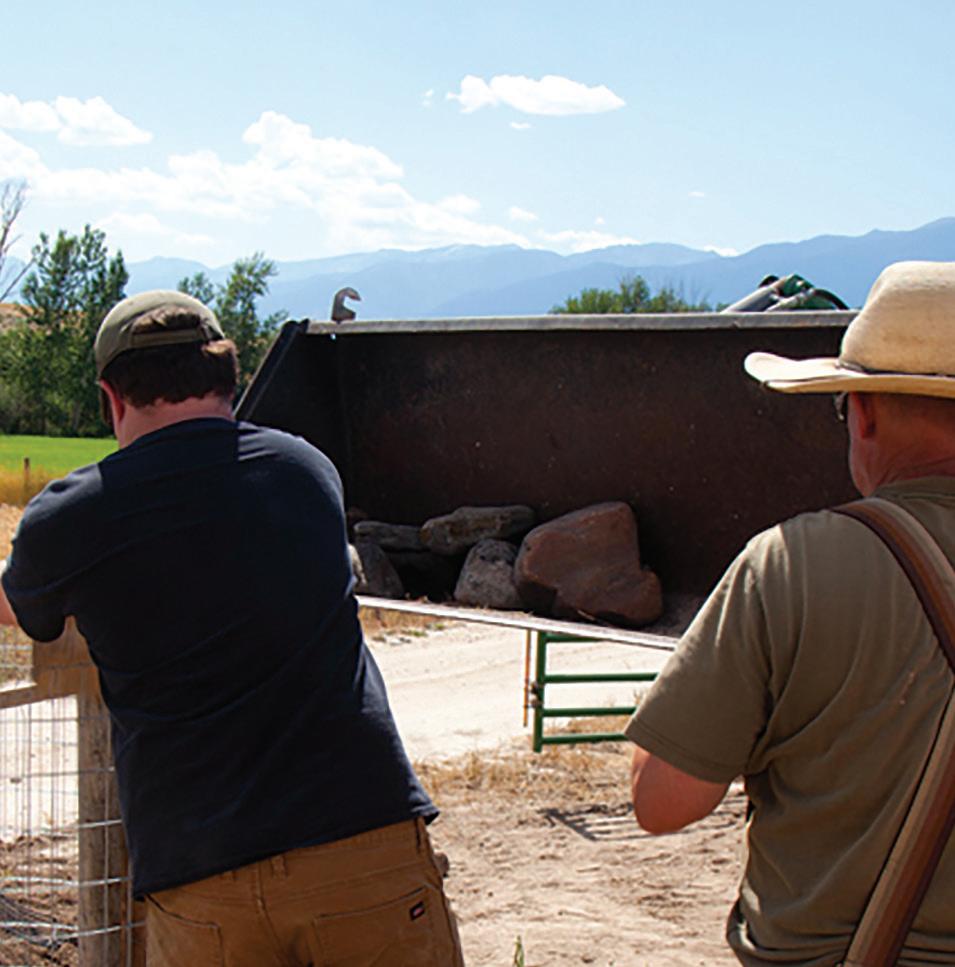
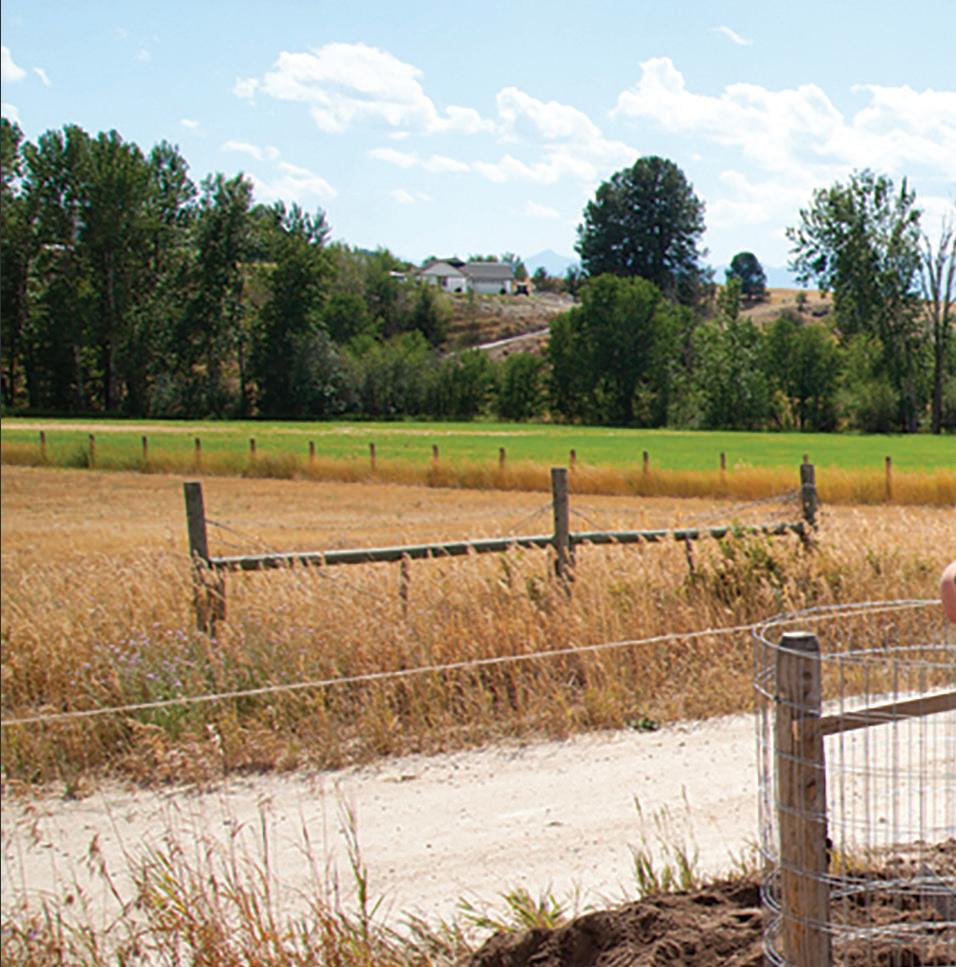
1. Use a small backhoe to dig out the base 2 feet deep and 20 to 24 inches wide.
2. Place two 6½-foot wooden posts 180 degrees apart for an inline bracing post, or 90 degrees apart for corner posts. Align the posts with the direction of the fence, so wire can be attached later. For corners where a gate is nearby or where you want extra strength, arrange three wooden posts in a triangle, with two of the posts in line with their respective fences.
3. Nail small sticks between the wooden posts to hold them in place at the
correct distance apart. Then, place the posts into the hole at the site.
4. With the backhoe, remove most of the rock from the excavated material. Then, have one person hold the posts relatively plumb and check the posts periodically with a 4-foot-long carpenter’s level. Have the other person place rocks around the base of the posts until the posts are somewhat stable.

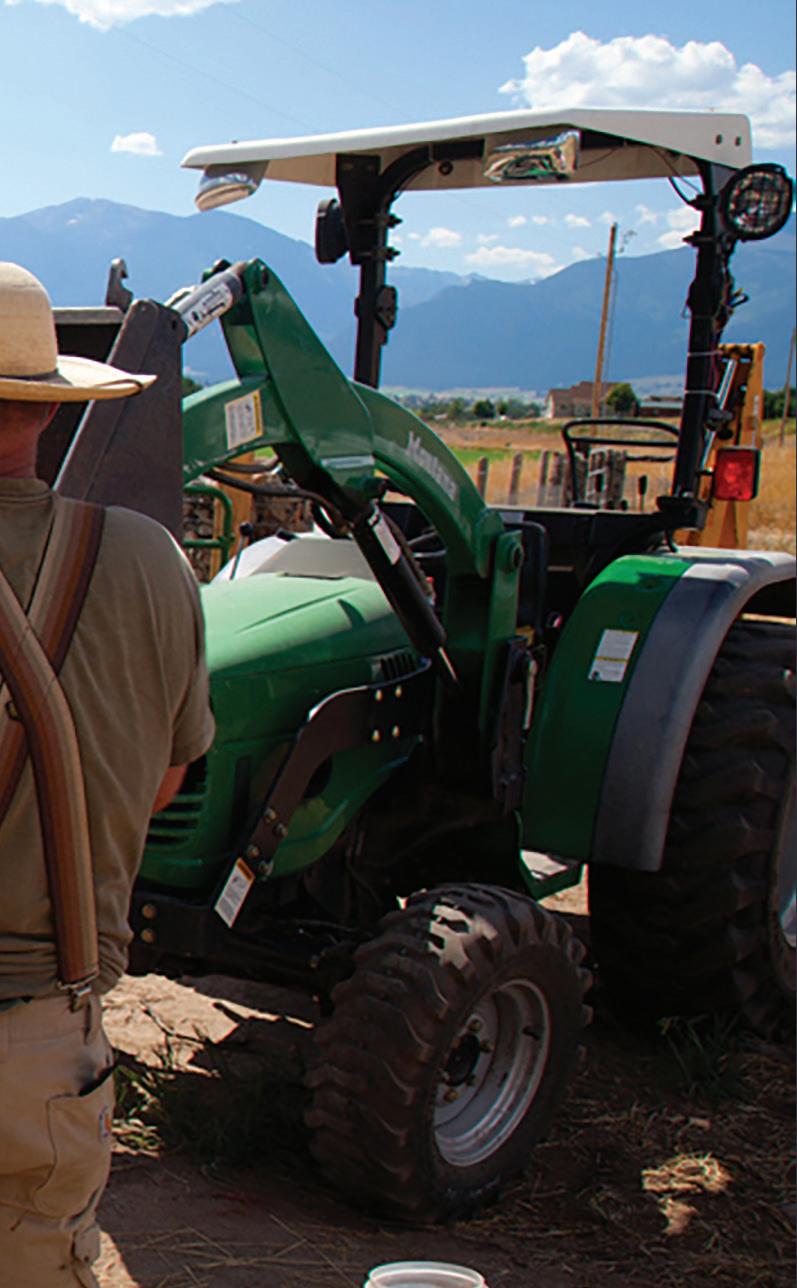
5. Partially fill the hole with a mixture of dirt and rocks.

6. Add water to moisten the mixture, and then compact it with a sledgehammer to tamp it down tight. Repeat this process to bring the mixture up to a level about 6 inches below grade (or 5 feet down from the tops of the posts). Level the dirt to ensure the rock cage sits plumb in the hole; otherwise, the finished rock post may lean.

7. Use 5-foot-wide, 2-inch-by-3-inch rectangular galvanized welded-wire fencing to make the outside “cage” for the rocks. Form the cages by rolling out the wire and cutting enough to make two complete wraps of wire (for

Turn your extra field stones into homegrown posts, all without using cement.
March/April 2023 44
Story and photos by Ward and Kammy Thurman
Step 8
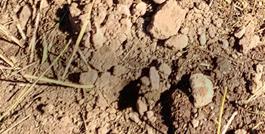
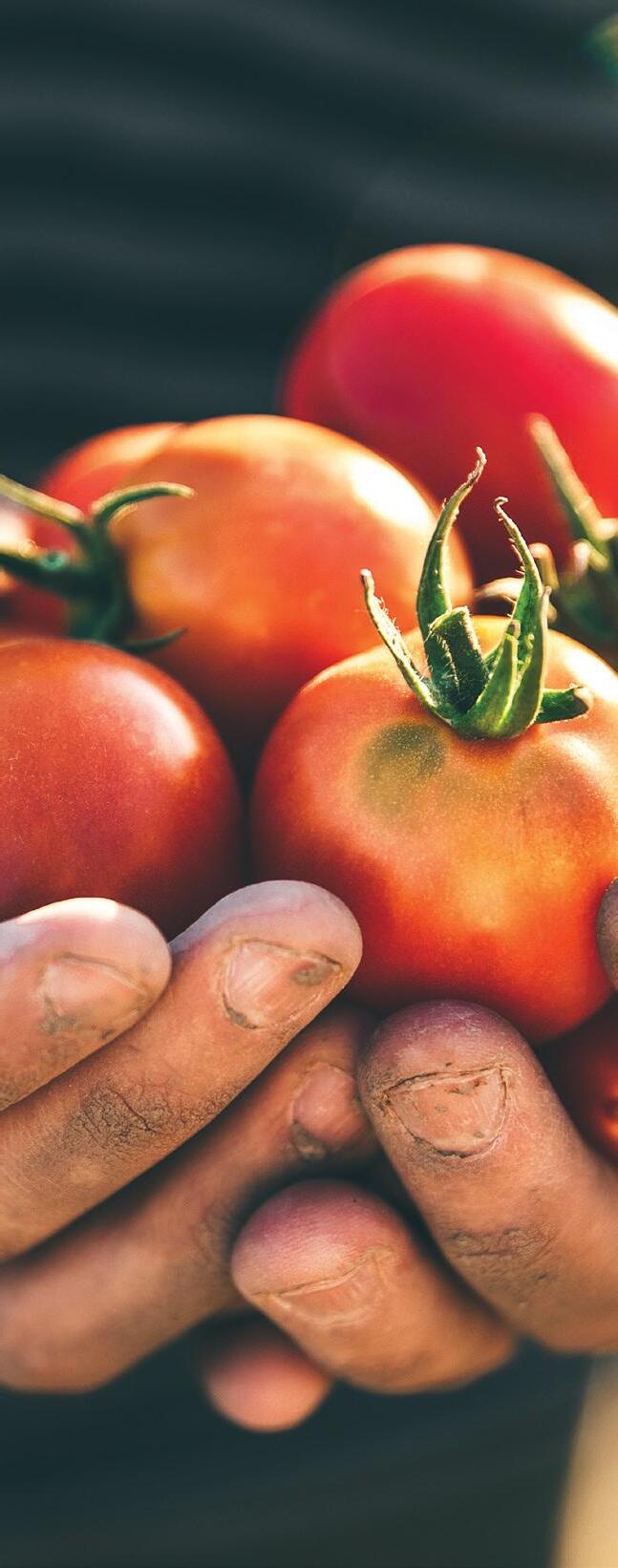
Fences, Gates, and Bridges, and How to Make Them
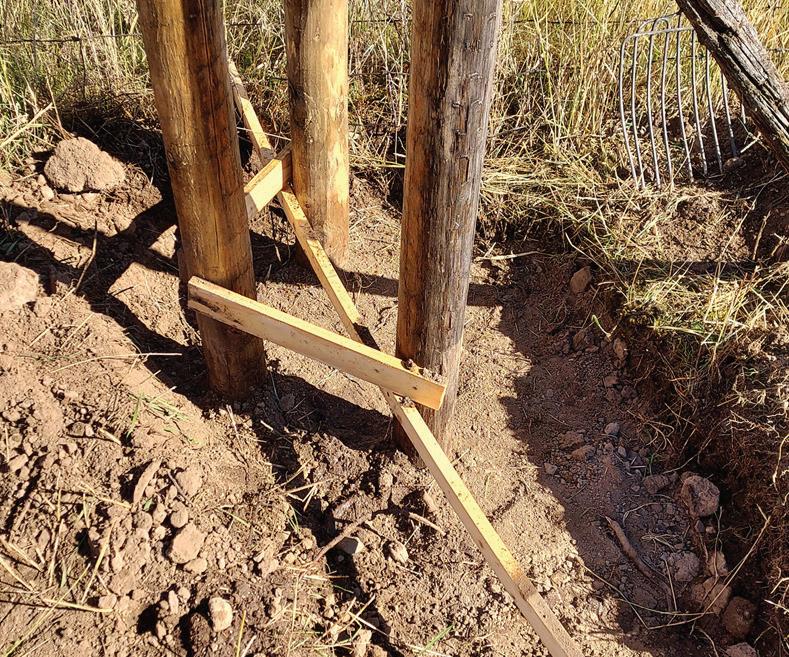
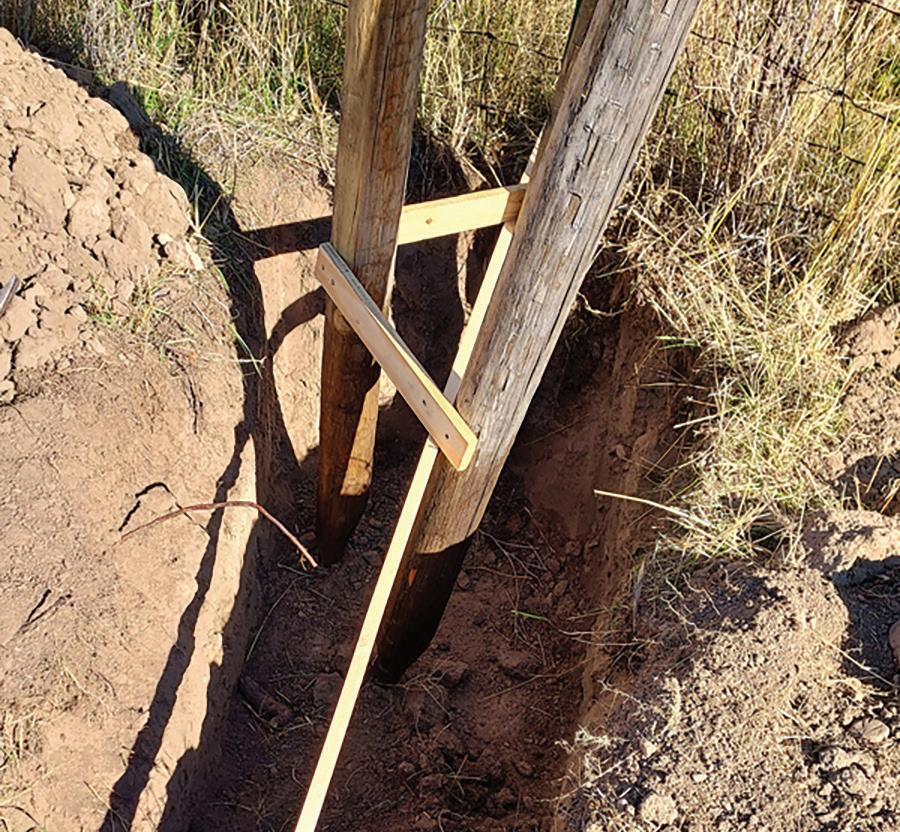
First published in 1887, Fences, Gates, and Bridges, and How to Make Them by George A. Martin is an instructional guide to the best ways to build a variety of fences, gates, hedges, bridges, and culverts. The section on fences boasts a wealth of information on building various types of fences, including rail, composite, garden, board, and picket. It also explores how to construct an effective barbedwire fence, examines how to use a stone wall to reinforce a wooden fence, and highlights the pros of building portable fences. Fences, Gates, and Bridges is a classic manual for anyone who wants to build their own structures for their farm, large property, or quaint backyard.
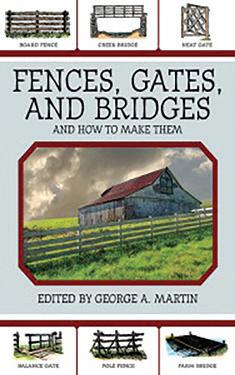
This title is available at Store.Grit.com or by calling 866-803-7096. Mention promo code MGRPANZ5. Item #8717.


















































Step 10
a double cage). For the regular corners and inline posts, make the rolls 18 to 24 inches in diameter. After the roll is formed, tie the ends together with wire.
8. Slip the wire cage over the wooden posts, setting it below grade (trimming off the wooden sticks or removing them as you go) so the top of the wire is nearly flush with the tops of the posts. Setting it below grade will make for a sturdier base.
9. After placing the cage, check the wooden posts for plumb and adjust the cage to make sure it’s very close to plumb as well. Using a sledgehammer as a bucking bar against the back of each post for extra support, staple the cage to the posts with barbed fence staples. This will keep the cage stable as you add rocks.
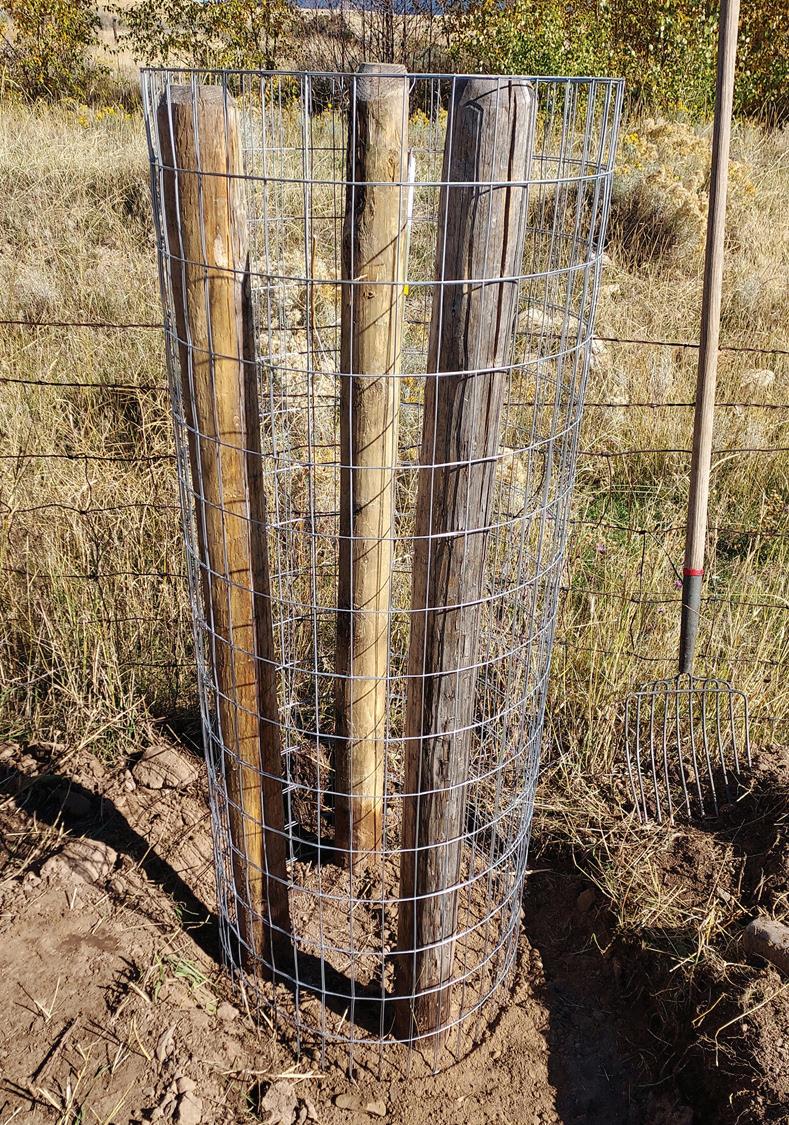
10. Once the cage and posts are secure, the fun starts — picking up the rocks and placing them in the cage. Put the bigger rocks in the center, and then fill in the outer gaps with smaller
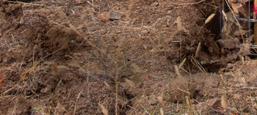
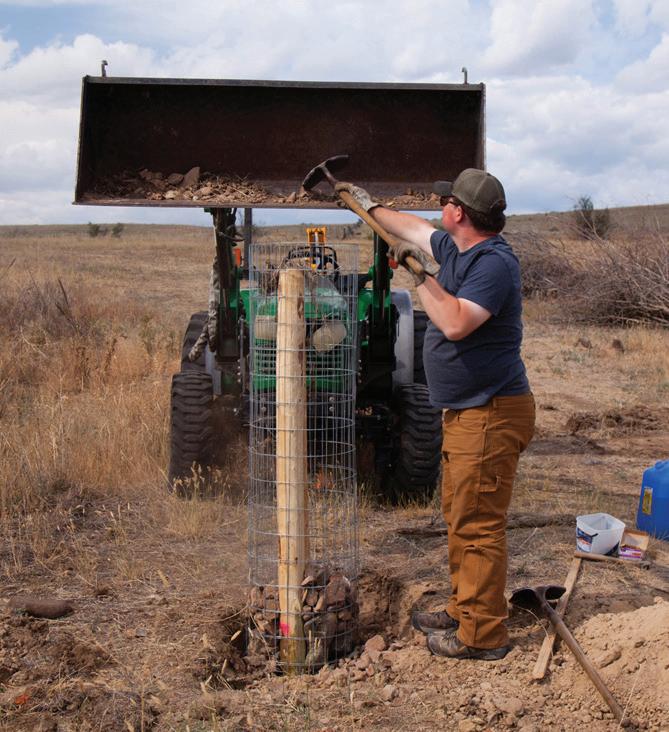
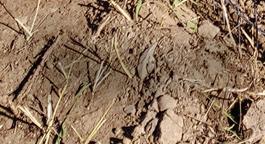


www.Grit.com 45
Lehman’s has the tools you need to plant your garden, plate your meals and preserve the harvest in your pantry Shop anytime at LEHMANS.COM Kidron, OH • 800-438-5346 From Plant to Plate to Pantry
Step 3
Step 5
See #14 on page 60
Step 10
stones so the exterior of the post has a pleasant, somewhat solid-looking, and smooth-ish surface. Don’t use rocks more than about 10 inches in size, because if they bounce around when they’re dropped in, they can bend the cage outward or knock the wooden posts out of plumb. A bit of extra time here will produce a better-looking finished product.
11. After filling the cage, finish backfilling around the base with material left from the excavation and compact it for extra strength. This process isn’t easy, but the effort it takes is about equivalent to a trip to the gym. It takes a minimum of two people, with three being better. Currently, it takes the three of us about 2½ to 3 hours to complete a post. That’s why we’re only putting them at corners, gate openings, and transitions. I don’t have enough life left in me to fence 11 acres every 16 feet!
Dependable Gate Posts
TOOLS AND MATERIALS
• Nails
• 5⁄8-by-10-inch lag screws
• Gate hinge pins
• Backhoe

• Sledgehammer
• 7-inch-diameter, 8-foot-tall gate post
• Sticks
• 6½-foot wooden posts (2)

• Rocks

• 5-foot-wide, 2-by-3-inch rectangular galvanized welded-wire fencing

DIRECTIONS
Instead of using one of those fancy gates that we see around our area, with two huge posts and a large top cross piece to keep the vertical posts from leaning in under the weight of the gates, we wanted to stay with the rock post look. So, we decided to use an enlarged version of the rock post with a larger wooden post attached to the outside. Building a stone gate post follows much of the same process as that for the regular stone posts. The primary difference is that
a 7-inch-diameter, 8-foot-tall gate post is used here.
1. Dig the hole in the same manner as for a fence post, except wider. Arrange the sticks around the gate post so the sticks form a tripod to support the post vertically. Temporarily screw the sticks in. Place the gate post in the hole.
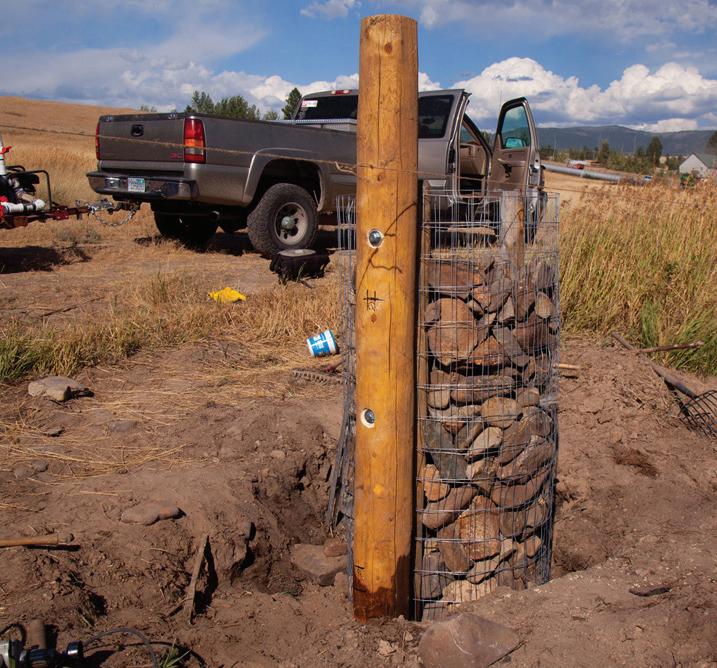
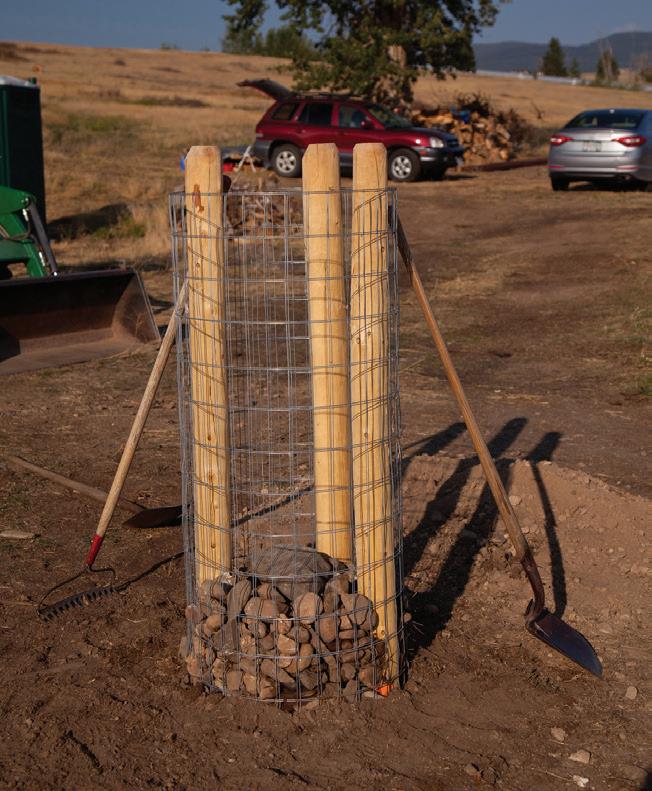
2. Nail the two 6½-foot wooden posts together with sticks and place them in the hole. Place rocks around the base of all the posts to hold them. Then, backfill the hole and compact the material used to backfill it, as described on Page 45.
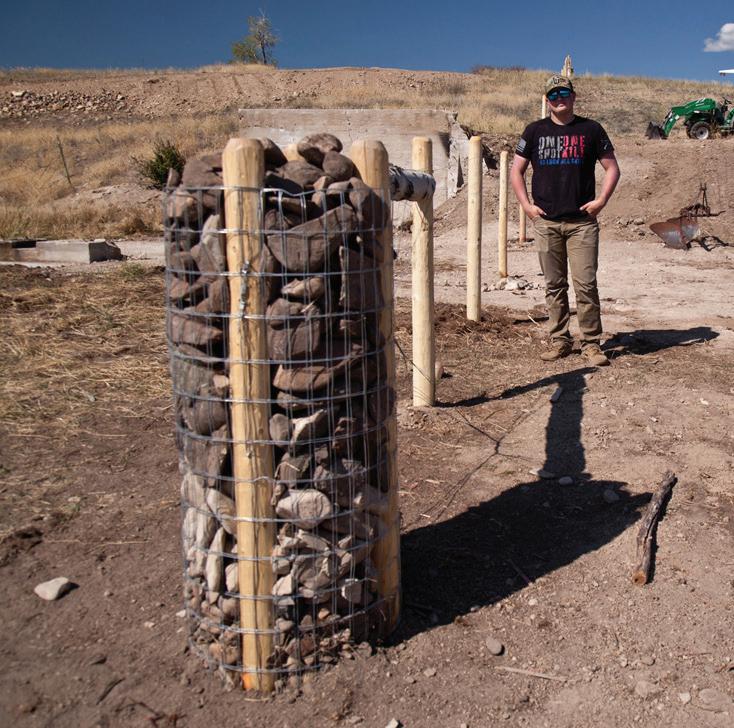
3. Make larger wire cages (about 29 to 30 inches in diameter) and place them over the two 6½-foot posts, leaving the large gate post outside the cage.
4. Fill the cage with rocks. I estimate the larger cages contain 2,000 to 2,500 pounds of rock. Once they’re set, it’d take a bulldozer to knock ’em over!

5. Use three 5⁄8-by-10-inch lag screws to attach the larger gate post to the wooden gate post inside the cage. Essentially, the gate post will be held in place by a 2,000-to-2,500-pound rock anchor.

6. Attach the gate hinge pins into the gate posts with screws, and align the gate so it’s level.
Creating such rock posts is somewhat time-consuming and laborious. However, it’s a great way to use materials at hand while simultaneously building something that’s sturdy, useful, and long-lasting. Eventually, the lower portion of the wooden posts will rot away. By that time, I anticipate that the rock post will have settled, though not by much, and will be extremely stable, holding the upper part of the wooden posts in place for many, many years.
Ward and Kammy Thurman make their home in the Bitterroot Valley of Montana. You can follow their adventures on YouTube @ sapphiremountainfarm7073.
March/April 2023 46
Step 11 Gate Step 5 Gate Step 6
• Bust sod and churn through the most compacted ground















• Prepare seedbeds or till garden waste back into your soil


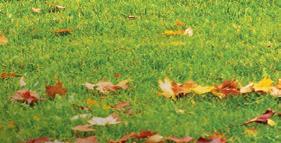







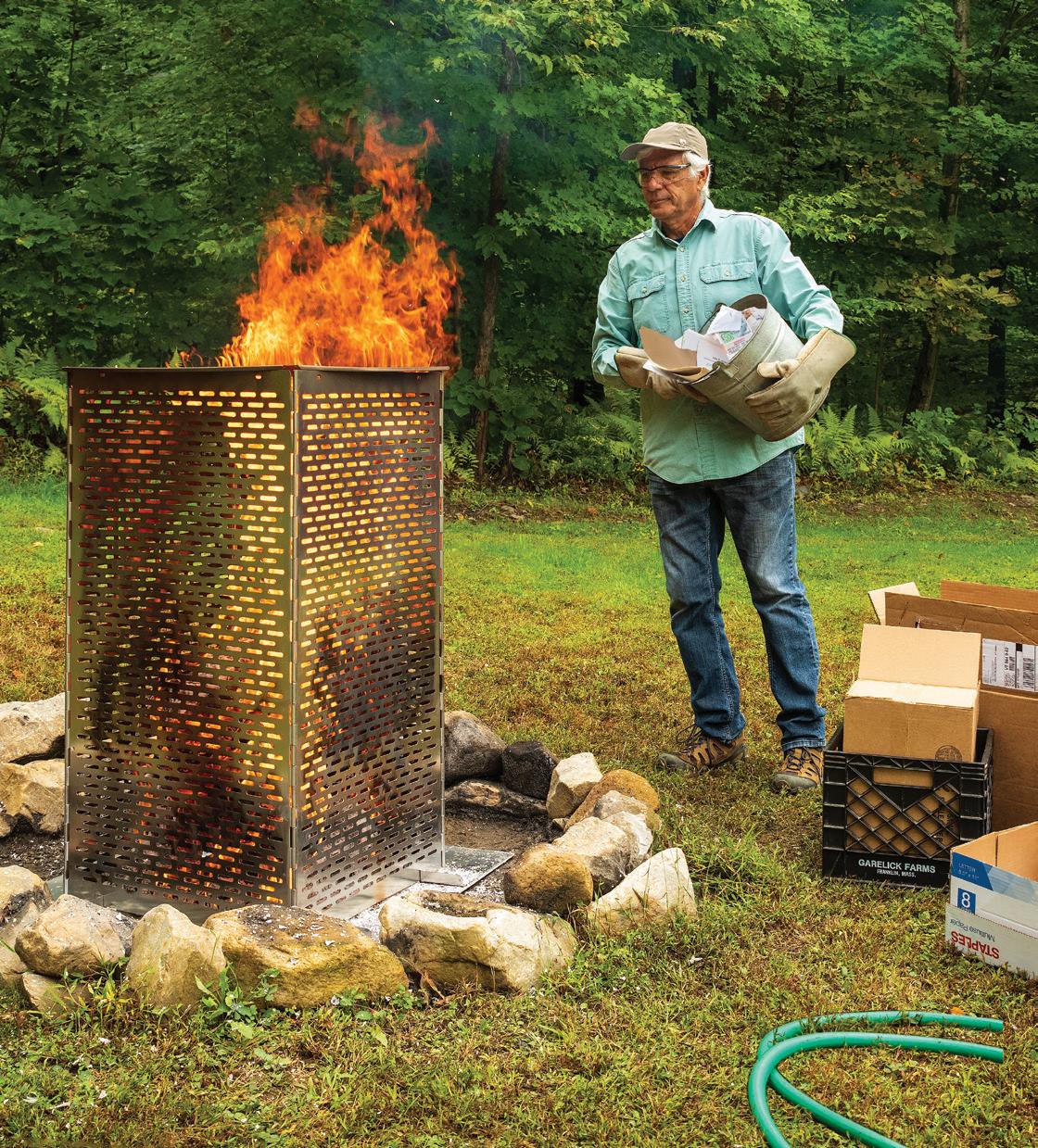
• Full line includes walk-behinds, tow-behinds, and cultivators


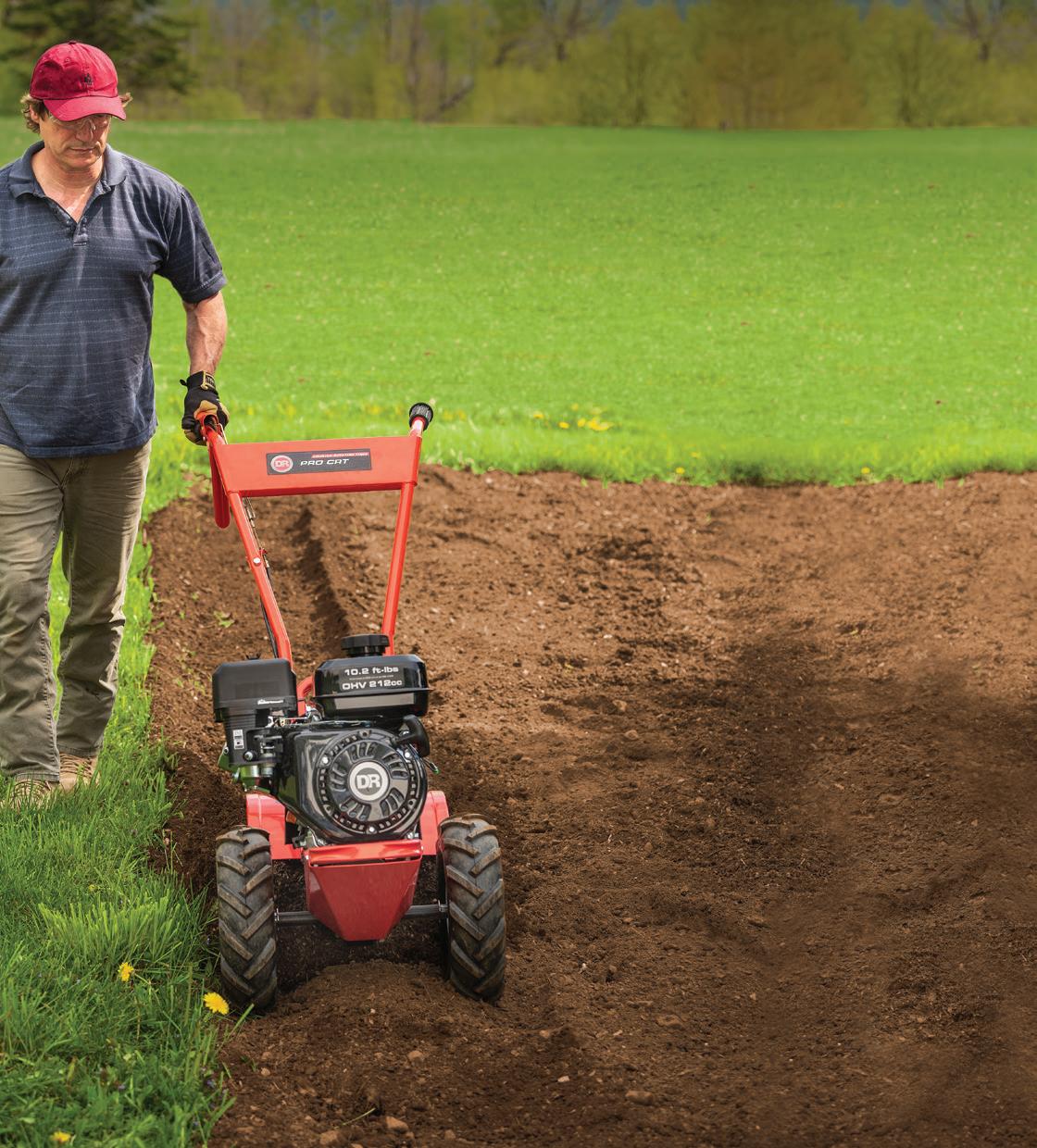



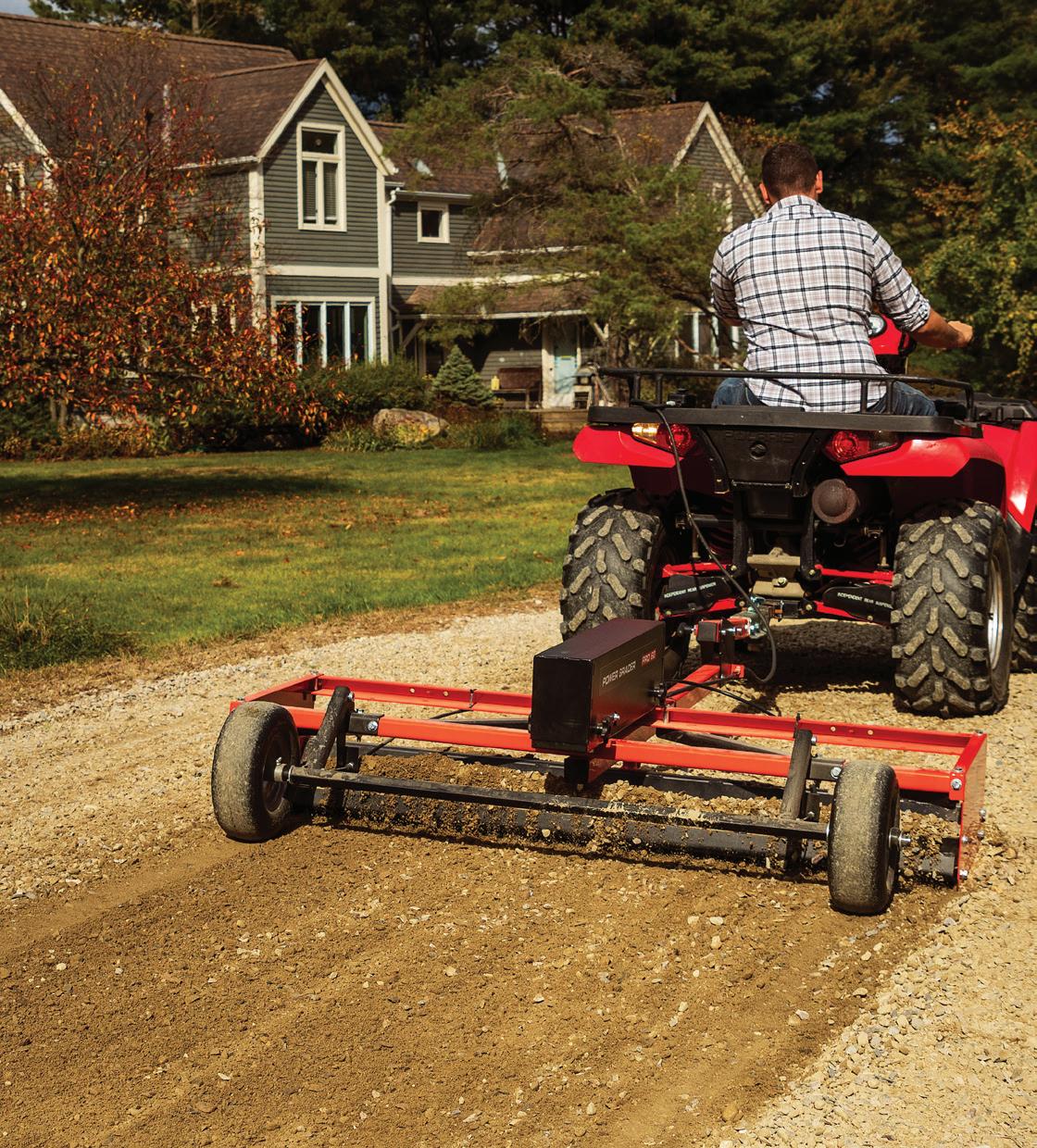
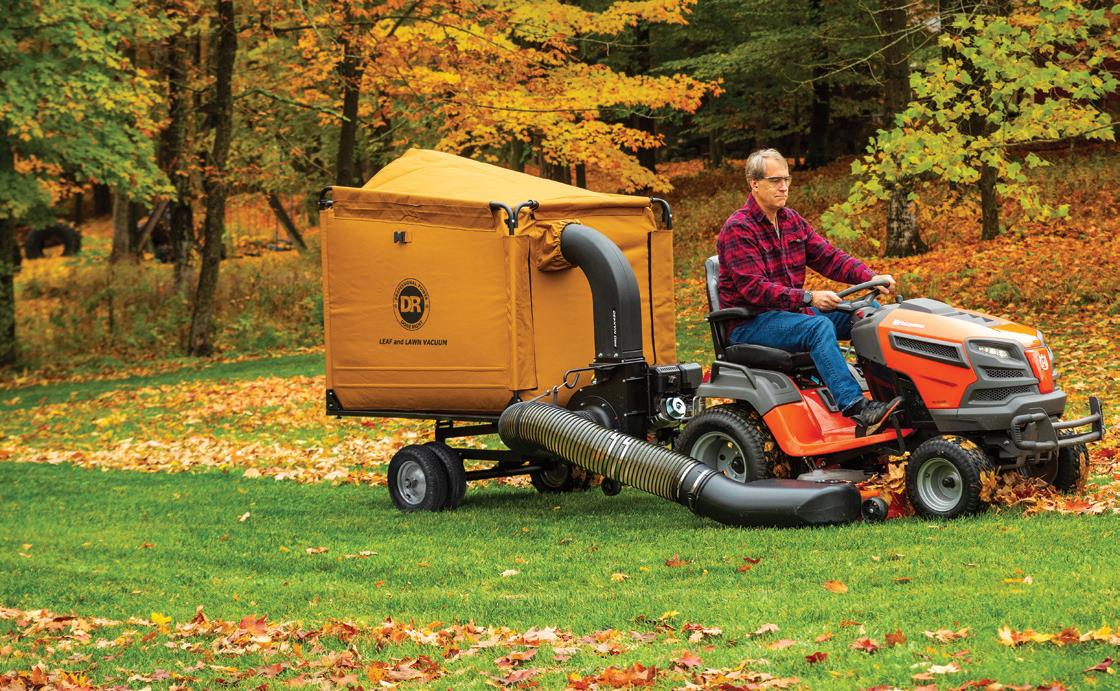

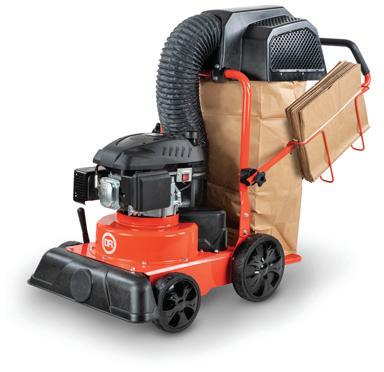







BURN SAFELY with the DR ® BurnCage™ DRburncage.com • Stainless steel design • Light, durable, portable, folds at for storage • Perforated construction maximizes air ow • Traps embers and burns more thoroughly DRpowergrader.com SOME LIMITATIONS APPLY FREE SHIPPING SALE! Request your FREE PRODUCT CATALOG Online or Toll-Free at 888-208-5805 GoDRpower.com DR POWER EQUIPMENT Do it Right with DR® DRrototiller.com Great Gardens Start with DR ® Rototillers! Make Your Driveway Like NEW with a DR ® Power Grader! DRleafvac.com Tow-Behind • #1 in vacuum power and capacity • NEW PRO MAX model holds up to 450 gallons • All models newly redesigned with up to 20% more capacity Walk-Behind • NEW PILOT XT models ll paper leaf bags for curbside pickup • Collects & mulches up to 50 lbs of leaves • Includes onboard caddy for extra bags The LEADER in Leaf Vacs! DR® Leaf & Lawn Vac • Fill in potholes & smooth out washboard • Loosen & redistribute existing material • Tow with your ATV, UTV, or tractor NEW DESIGN
Mobile Poultry Feeder
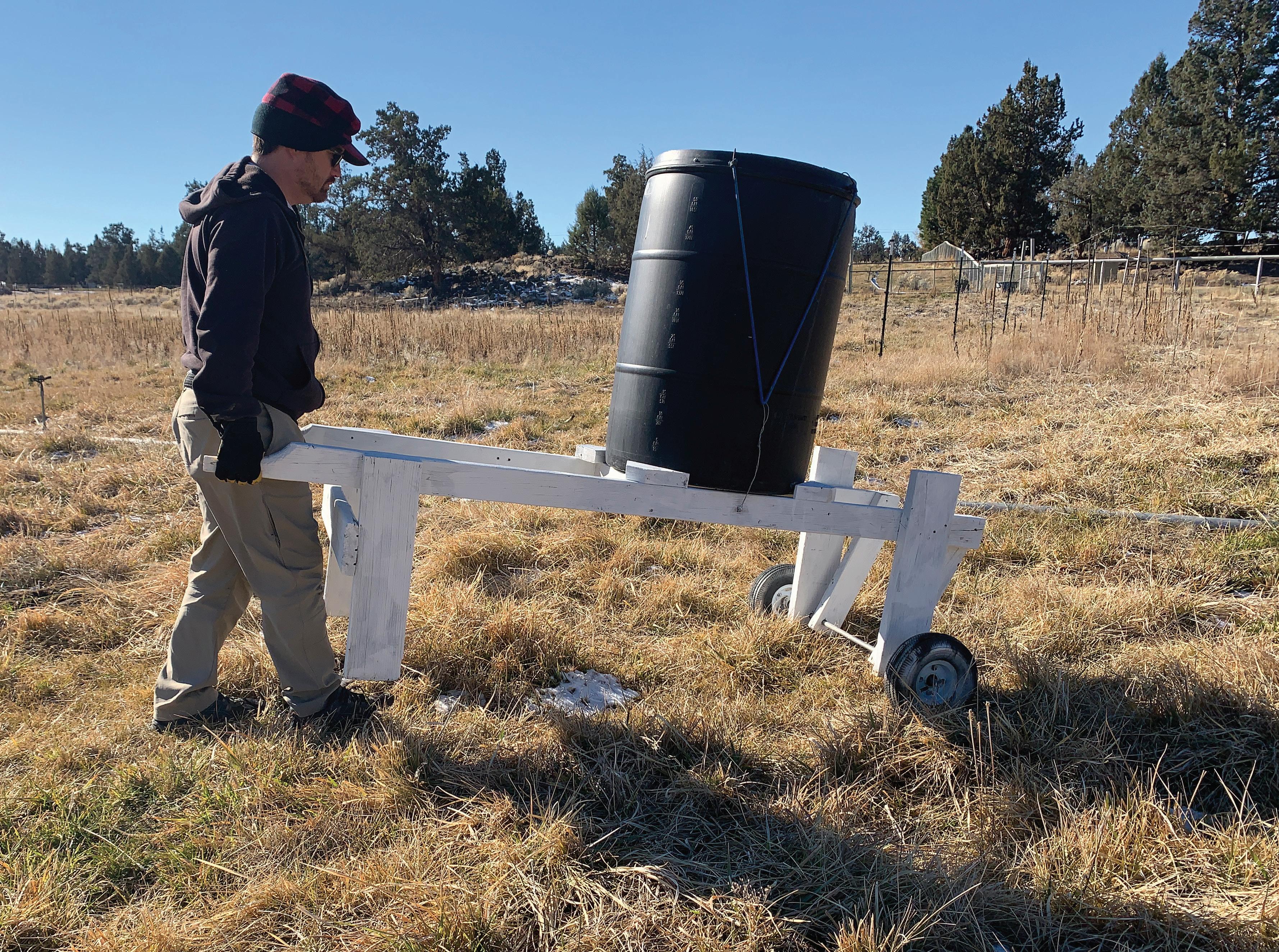
The first time I saw a chicken watering nipple, it felt like a Christmas miracle. For months, I’d been cleaning feed, feathers, and droppings out of water dishes, and then suddenly all that work went away. I remember thinking, “Why isn’t there something similar in the form of a chicken feeder?”
Flock feeders haven’t changed much in 100 years. Maybe it’s because they’re tried-and-true and inexpensive to manufacture. But plastic feeders tend to break. Birds like to perch on a metal feeder’s top rim and do their business over the edge, into the feed. Neither of these feeder types will keep feed dry outdoors, which is where chickens like to eat. Some good rodent-free options are on the market, but they don’t curb the birds from launching feed everywhere, like a truck
spreading salt on an icy road. For some reason, the feed they’ve scattered is never good enough to go back and eat.
I was thinking about designing my own feeder when I stumbled upon a popular DIY plan on the web. Similar to the way watering nipples work, this design depends on chickens doing what they like to do best pecking and scratching. Rather than ignoring the birds’ instincts, it relies on them to do what’s natural. The feed is positioned in a barrel overhead and will fall to the ground, where poultry like to eat. Birds peck overhead at the feeder until bless their short attention spans some food falls down, and they forget about pecking until they’ve scratched at what’s on the ground.
This design has many great features. First, because the feeder hole is on the bottom of the barrel holding the food,
For easy and efficient meal delivery, this DIY cart is at the top of the pecking order.
March/April 2023 48
Story and photos by Josh Lau
it’s protected from the weather. Second, it wastes less feed, because the latter is released only upon interest, and then the interest shifts quickly to the ground. Third, because the opening is upside-down and high off the ground, it’s particularly dif cult for rodents to access.

Build a Better Feeder

At the center of this project is a plastic 55-gallon drum for holding the feed. Why so big? Because I want to be a lazy chicken wrangler, meaning I prefer to check feed levels only infrequently — and I certainly don’t want to re ll often. Having a huge, full barrel also provides ballast for the inevitable wind gusts, which would play ninepins with a smaller bucket. To build this design, you can also use a trash can, a lidded metal drum (often harder to nd than a plastic drum), or even a 5-gallon bucket. Be sure to use a clean, dry barrel or bucket that’s never been used to store toxic substances.
By a miracle of coincidence or of ingenious design, the top of most plastic 55-gallon drums narrows just before aring into a big lip. If you cut off the top where it’s skinniest, you can ip the lid upside-down so the ared lip will form an overlapping seal on the now-open barrel top, which is where you’ll eventually be pouring in the feed. Cut off the lid with a handsaw or reciprocating saw, and then tighten the existing bung and caulk it closed, because rainwater will accumulate on the lid, and you don’t want it to leak into the barrel and spoil the feed
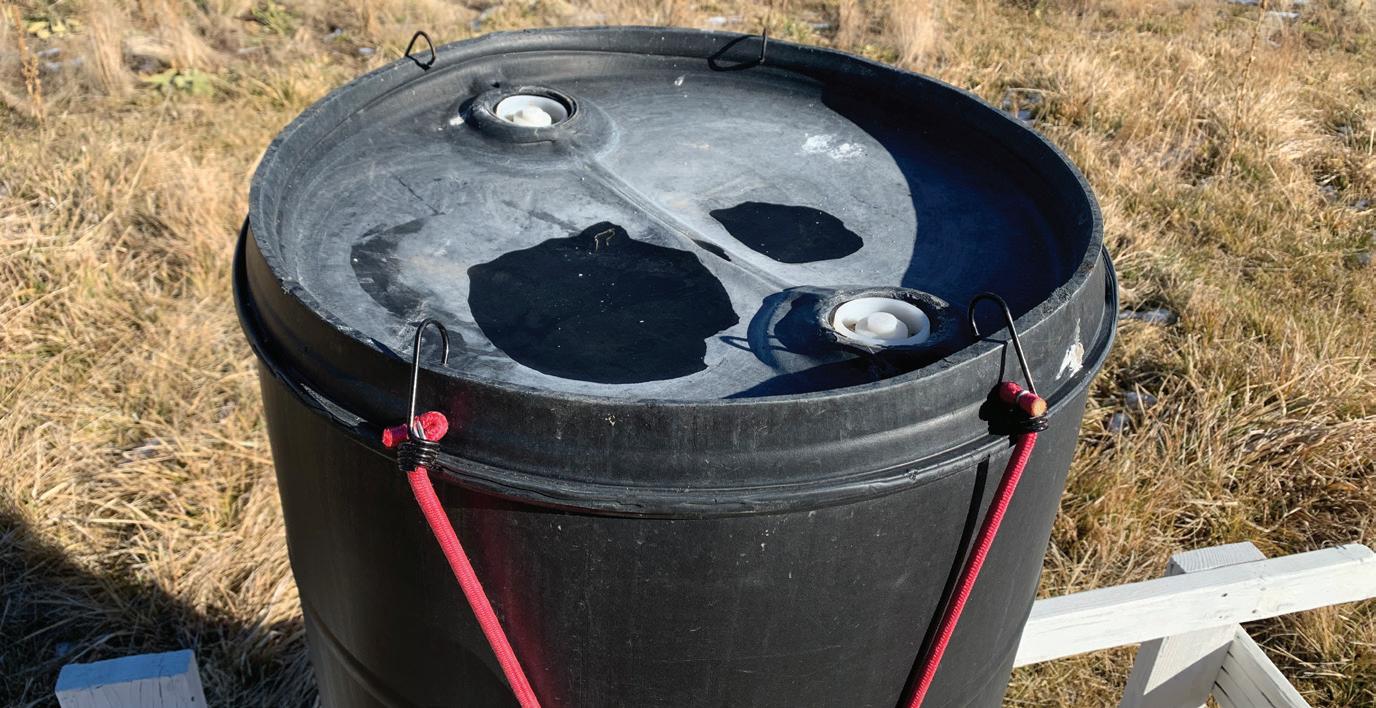

To create the feeder hole, drill a small hole in the center of the bottom of the barrel. If you have a big ock, drill several holes. The food will issue from these holes when the chickens peck. You’ll need to install a device to prevent feed from pouring freely through the hole (or holes) except when the birds want it. As with a chicken-watering nipple, the device should wobble inside the hole. The easiest thing for you to do will be
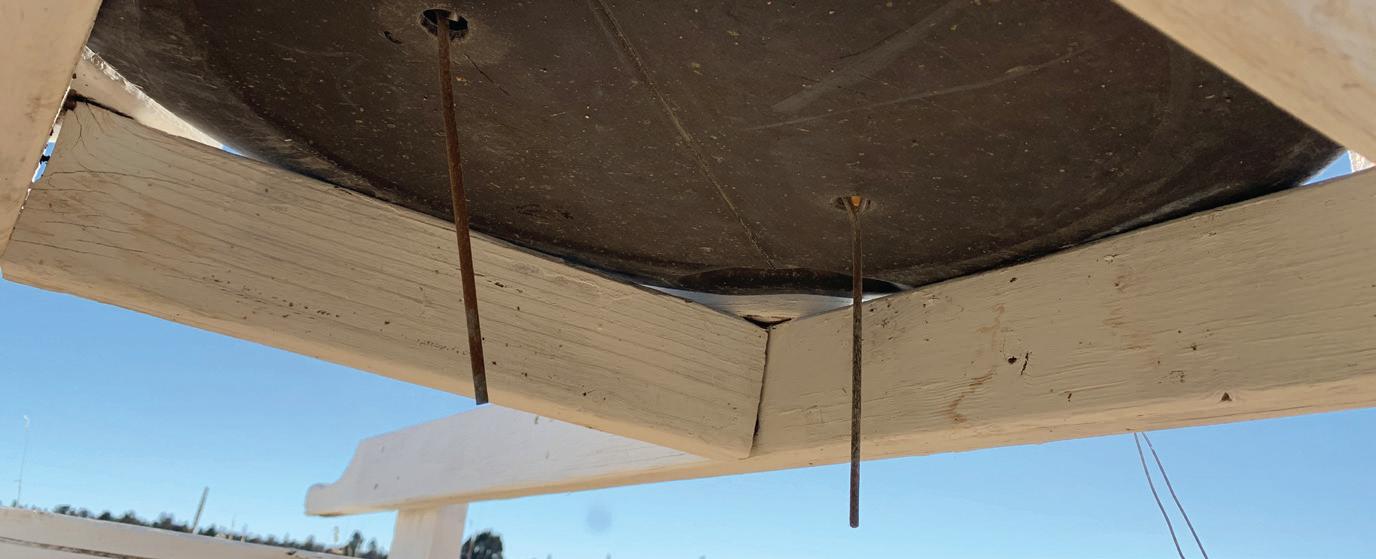
www.Grit.com 49
New coop lights!
See #18 on page 60
From top: Bungee cords hold the lid in place; feeder holes on the barrel’s bottom are fitted with wobbling tent stakes.
to insert an eye bolt, threads-down, into this hole. In operation, the birds will peck at the threaded bottom, causing the loop to stir the feed and drop it to the ground below.
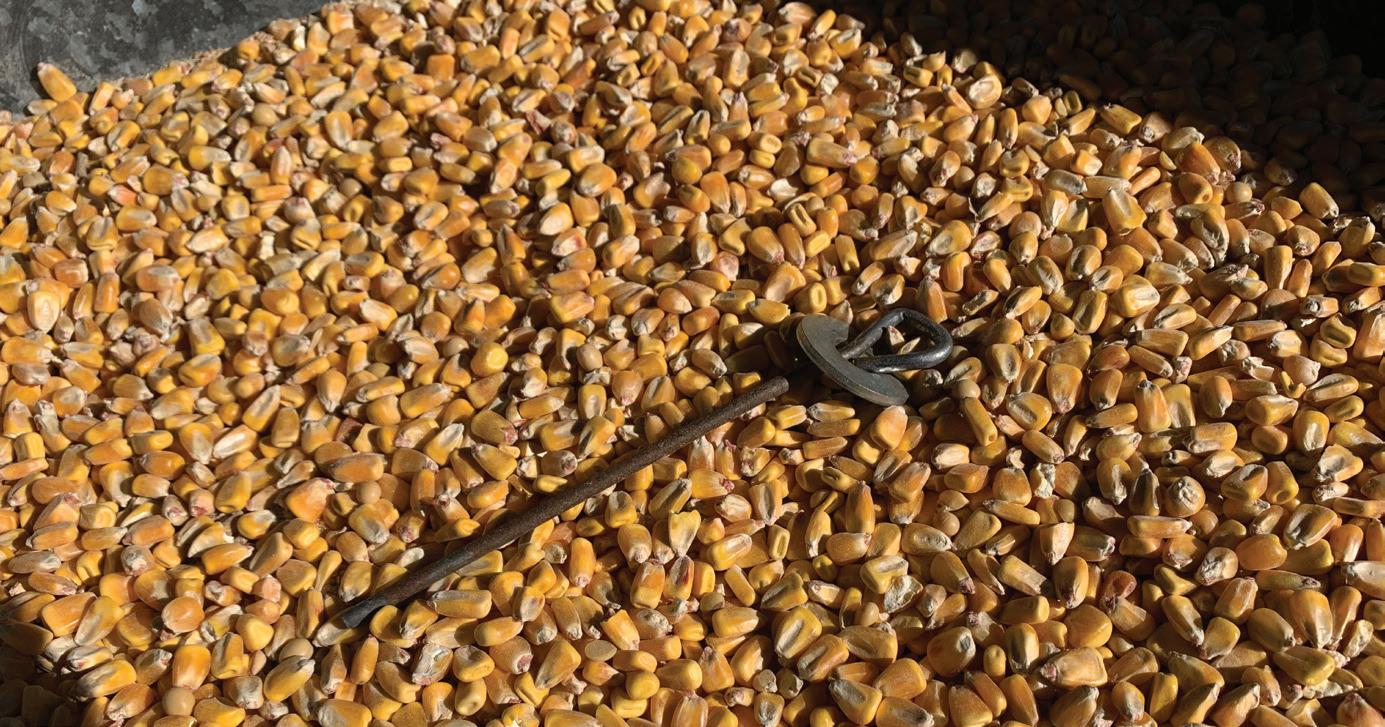
Although eye bolts are easy to get and install, their threads provide a grip for ambitious little critters to jump onto. Instead, you can bend 7-gauge wire into a similar loop-and-shaft shape to make your wobbling feeder bolts. Or, if you have a spare tent stake, bend the head into a loop.
The size of the feeder hole will depend on what you’re feeding drill larger holes for coarser food and how much food you want to fall out at a time. If you’re using a plastic barrel and you’ve got a heavy predator population, you may want to glue or caulk a large fender washer over each hole to prevent it from being enlarged by gnawing. I like to keep a few fender washers around for when I’m varying the feed, because I’ll end up with a lot of food on the ground if I’m feeding cracked corn through a hole that was drilled for pellets. To govern the flow of fine feed, I simply select a washer with a smaller hole and put it over the top of the existing feeder hole. The eye bolt keeps it in place.
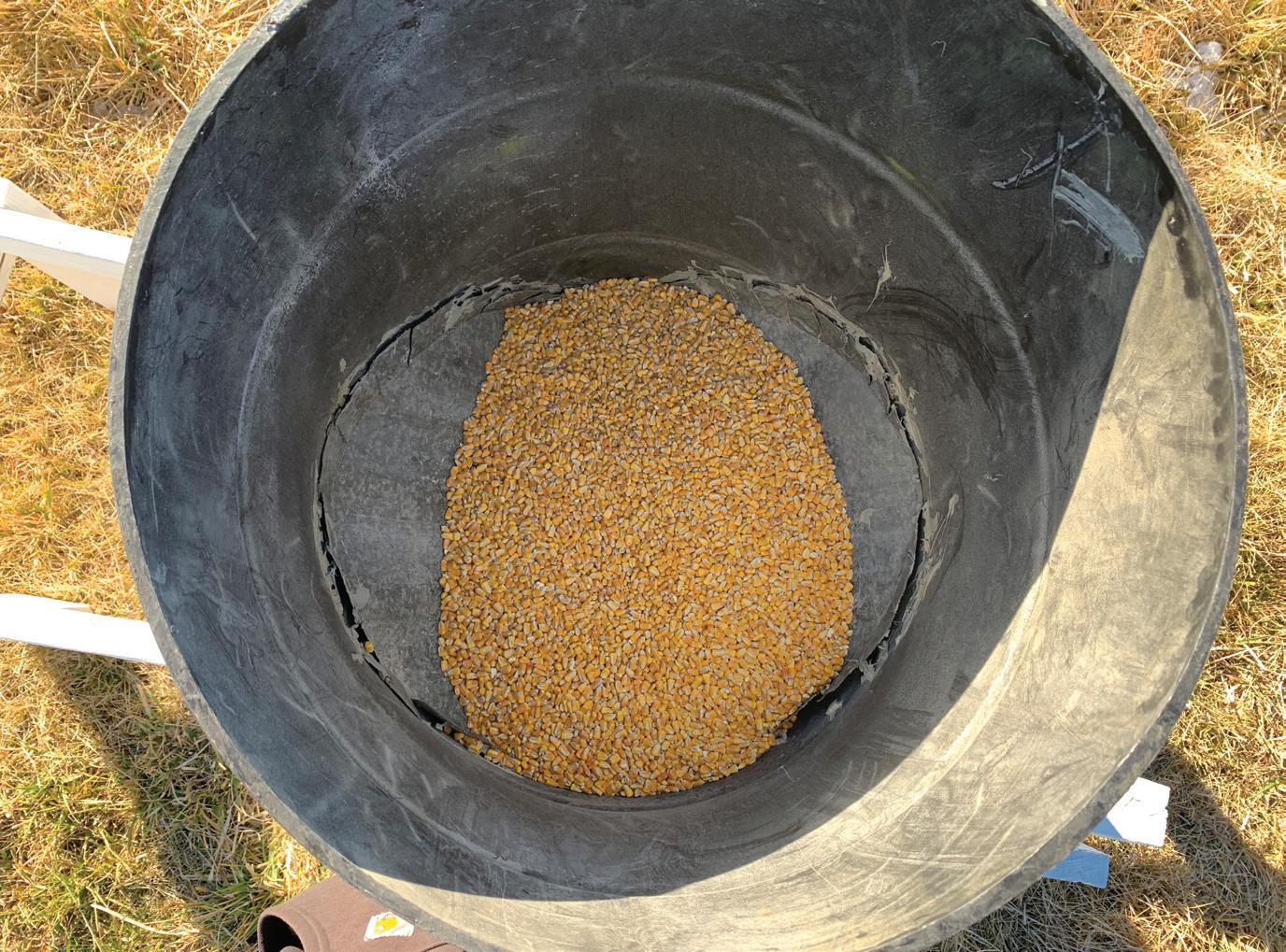
If some of your birds are reluctant to start pecking, pick them up and gently nuzzle the feeder bolt with their head, and they’ll learn quickly.
I fashioned a large funnel for the bottom of the barrel interior so the food would slide to the feeder hole when it got low. If I was building the feeder again, I’d instead fill the bottom with oyster shells or dirt as ballast and as an indicator that it’s time to refill. Depending on the type of feed (and especially with crumbles), you may need to bang on the side of the barrel occasionally to get it to settle to the bottom.
A Frame to Keep It Moving
To keep the feed barrel off the ground, I built a sturdy wooden frame on wheels, which allow it to be moved with relative ease. When you assemble the wheeled cart for your own feed barrel, consider who’ll be moving and filling it, where that person will be wheeling it, and the wind. Old lawn mower wheels will work, but larger

March/April 2023 50
From top: A homemade funnel; a feeder bolt made from a tent stake; triangular legs on the cart’s wheeled end.
pneumatic wheels will be less likely to sink into wet ground and easier to roll.

Take the wheels and their mounting position into account when deciding on the height of the cart. I like to have the bottom of the barrel about 20 inches off the ground. If a smaller person would be moving the cart, I’d place the filled feed barrel closer to the wheels to give the operator more leverage. Too far over the wheels, though, and the barrel will be prone to upending if other animals lean on it, the wind is strong, or the operator hits a bump while rolling. Some flock owners may find it necessary to keep a small stepladder nearby for filling purposes. After the barrel is filled, I secure the lid in place with bungee cords.
In my experience, 6 feet is the right length for the cart, and 2 feet in width should accommodate most barrels. Start by building a 2x4 frame with a pair of crossbeams arranged to make a square where your barrel will stand, and then add retaining blocks in the corners to keep the barrel centered. Add legs about 1 foot away from the handles so you won’t trip on them while you’re moving the cart. Add a broad cross-brace high up on the legs (again, positioned to keep you from kicking it). On
the wheeled end, you may want two legs to form a triangle (as shown in the bottom photo on the opposite page), or one wide leg on each side with another cross-brace for plenty of support.








For an axle, a proliferation of 5⁄8-inch rods are available online for less than $20. Make sure this diameter matches your chosen wheel options. I opted for a 36-inch-long rod to give the cart a wider stance, and this required spacers made of PVC pipe to keep the wheels centered.

With everything assembled and stocked, it’s time for a trial run. Park the mobile feeder directly over a stubborn weed patch and watch your chickens raze it like the Romans sacking Carthage!

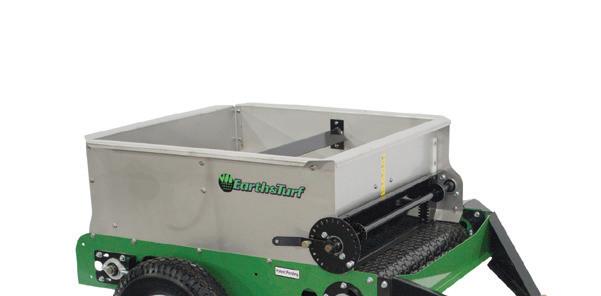

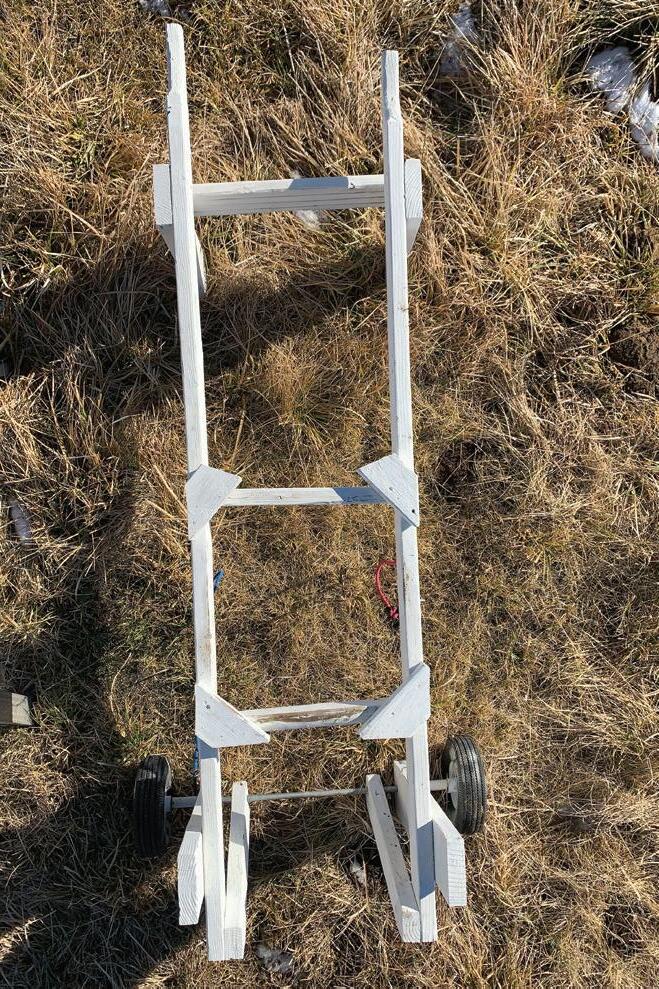
Josh Lau is an engineer, inventor, and Eagle Scout. He raises chickens and steers on a small ranch in central Oregon with his patient wife and awesome kids.

See #8 on page 60
Overhead view of the barrel cart, with crossbeams.
www.Grit.com 51
Position cross-braces high to keep from kicking them.
DICKERING
The High Art of Going Low



Build
By Cary Rideout
Photos by Lorain Ebbett-Rideout
If you homesteadout past the pavement, chances are you’ve got a few “horse trades” under your buckle. Country folks are legendary for being hard bargainers who work for every cent in the nal price. There’s a real art to “dickering.” If you’re new to rural dealings, bargaining is a skill worth cultivating.
The Definition of Dickering
“Dickering,” if you get all technical, is working a price to the place you feel comfortable paying. It’s not so much about the price as the journey to that mutually acceptable number. Unlike fancy penciled gures on slips silently pushed across boardroom tables, out here in the timothy, we look you in the eyes when talking money. Watching good bargaining, as a tractor jockey once told me, is like watching a really slow wrestling match. The buyer has a price, and the seller has a price. No one hurries, and both parties circle the subject, noting the other’s words and considering compromise carefully.
When dickering, “slow” is the watchword. High speed is for internet connectivity, not dickering.























Bidding with Professionals
Casual country bargainers are sometimes overwhelmed by crowded farm auctions, but the lure of unexpected treasure keeps them showing up. If you’ve never stood before the hammer, the following suggestions will ensure an enjoyable day. Get on-site early to peruse the inventory. Make notes on items that interest you and write down the correct auction number along with the opening bid amount. Once the auction is underway, don’t bid too soon, always bid in short increments, and stay steady, ignoring the excitement around you. Long pauses in bidding are OK; they give the initially enthusiastic an opportunity to count coins. Don’t leave too soon or get frustrated waiting for a sale item; fortune rewards the patient. Dress in appropriate seasonal footwear, bring a lunch, and remember to have fun.
Auctioneers and their assistants are as busy as bees in the blossoms and have little time to waste, with a full array of items to move quickly. Any unusual motion can lead to an unintended bid on your part. Don’t wink or clear your throat, and never nod your head! It sounds funny until a roaming bid watcher is standing over you holding their card high and pointing at your surprised face. It happens more than you think! Actually, most auctioneers understand, but who wants to be the person who holds up the day’s business?
camaraderie while standing your ground to get the best bargain in a country negotiation.
March/April 2023 52
Toe-digging and rocking on the heels are part of the sale. Some people will stand square and look off as the discussion swirls, while others never blink. Country people enjoy the careful sparring it takes to get the baler out of the driveway.
Buying anything is a complex process, and often, a sale goes off the rails because of misunderstandings, poor explanations, or vague questions. If it’s worth buying, it’s worth being serious, so leave the jokes for later. Being sassy or, worse, offensive in any way is a poor attitude. You have the chance to get this person working with you, not wishing you’d leave. Good, honest bargaining leaves both parties, if not happy, at least somewhat satisfied.
Dickering 101
When setting up a meet, I simply ask for a time and a place with clear directions no “past the red barn” guidance. I also avoid all off-site negotiations. The telephone is no place to dicker, nor is email, since you’ll need to gauge the reaction to your offers and the other party’s counteroffers.
Don’t be too critical; instead, be constructive to work the price to your satisfaction. A careful bargainer will get involved physically to review the item in question. A thorough handson examination can reveal issues or reinforce the item’s worth. Avoid being
too aggressive or loud. Try to get a feel for the seller’s mood: Are they in a foul state or feeling generous? Some country folks, myself included, are quiet around strangers. However, given the chance to get a moderately successful horse trade underway, we get mighty chatty.

When dealing, it’s best to involve only the buyer and seller. With extra people standing around, things can get off-book quickly. Extra opinions can irritate both parties and make the dickering difficult. At most, bring a mechanic or other service person to check on the item’s mechanical condition. If you find you need to have another set of eyes after your first visit, arrange for a later visit, and be clear that you wish to bring a professional.
Look for indications of the sale’s seriousness. A table saw buried deep in an old poultry coop or a cultivator in the neighbor’s shed miles away doesn’t indicate a serious sale, but a set of tractor chains laid out by the shed point to an eager seller.


After the initial price is established, some buyers immediately lowball, but I prefer to gently guide the talk with questions to get the seller working with me. Make it clear you want to buy; don’t waste daylight yapping. We all price high expecting to deal; that’s how it works. Bargain for a while to gauge the seller’s seriousness on the price they’ve pitched,
Learn the secrets of growing abundant plants and vegetables. Explore the fascinating natural world around us. Delve into a “hands-on” subject like beekeeping or mushrooms.


folkschool.org/grit
1-800-FOLK-SCH
and always be looking at the item with positive interest. If you’ve worked with similar equipment, mention that to prove you know the score. Make it clear you’re there to buy but not throw money away. Talk about your intended use, indicate how it’ll improve production, or even discuss how you’ll modify the tool. Be positive if you want a positive conclusion.
www.Grit.com 53
Gardening & Homesteading
BRASSTOWN, NORTH CAROLINA
Clear signage and accessibility of the item in question will indicate a serious sale, versus the unlabeled sale of equipment buried in a barn.
See #10 on page 60
Any purchase these days benefits from a clear receipt. It needn’t be a formal lawyer document; a few lines will do. Some folks may balk at the request, but try to stay within the law’s parameters; a receipt is pretty much required to legally license an item. A simple receipt should list the item, the names of the buyer and the seller, the date, and the amount exchanged.
Decent Dealing
If you’re at loggerheads and your preferred prices are increasingly further apart, at what point does dickering become pointless? This does happen, and it might spell the end of the potential deal. Some hard-headed sellers won’t budge, seeming to relish the confrontation. Better to thank them politely, leave, and let it go. Strongarm tactics have no place in country
bargaining, and a reputation of being honest and respectable is worth preserving at the cost of lost purchases.
Good negotiations are about learning the other person’s notion of value. Say the price is one grand; OK, now we both have a starting point. Don’t throw out a dollar amount; instead, gently get the seller talking about the condition, age, or model to find common ground. Old-timers often introduce themselves, outline their interest, and then spend considerable time identifying connections. Maybe both parties have worked on a nearby ranch and know the same folks. Establishing common connections may make the bargaining go more smoothly you wouldn’t get all belligerent with a friend. You’d treat them as an equal, because you now know them, at least sort of.
Modern buyers or sellers are all about speed, with an almost annoyed tone, rushing to close the deal and quickly move on. This is a shame, as few pleasures were so enjoyed by past generations of homesteaders as dickering. Granted, many times, someone lost and someone won, but there was always another day to deal up better.
Now, who wants to buy a good used tractor?
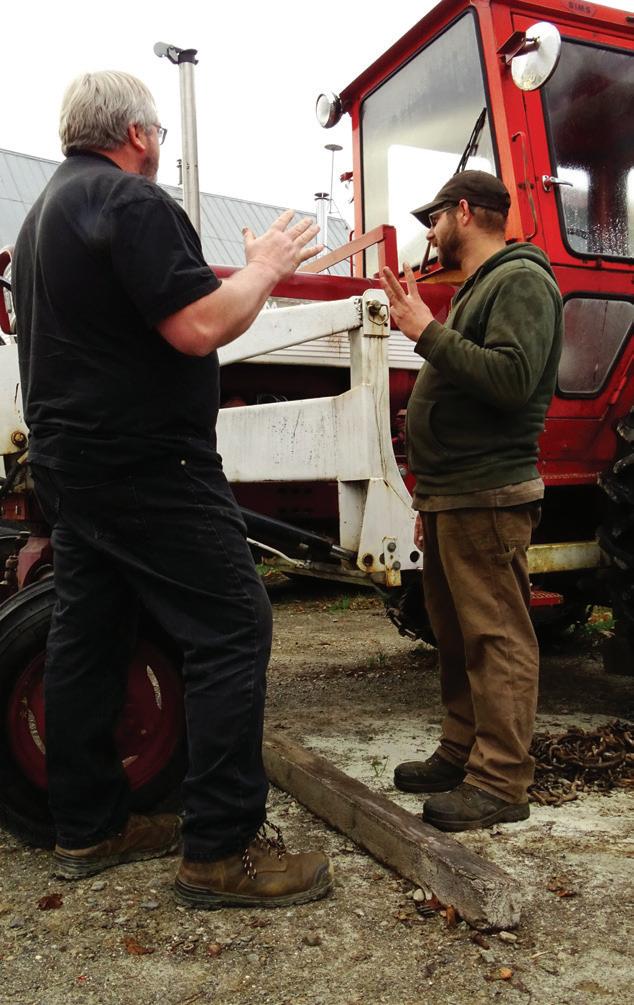
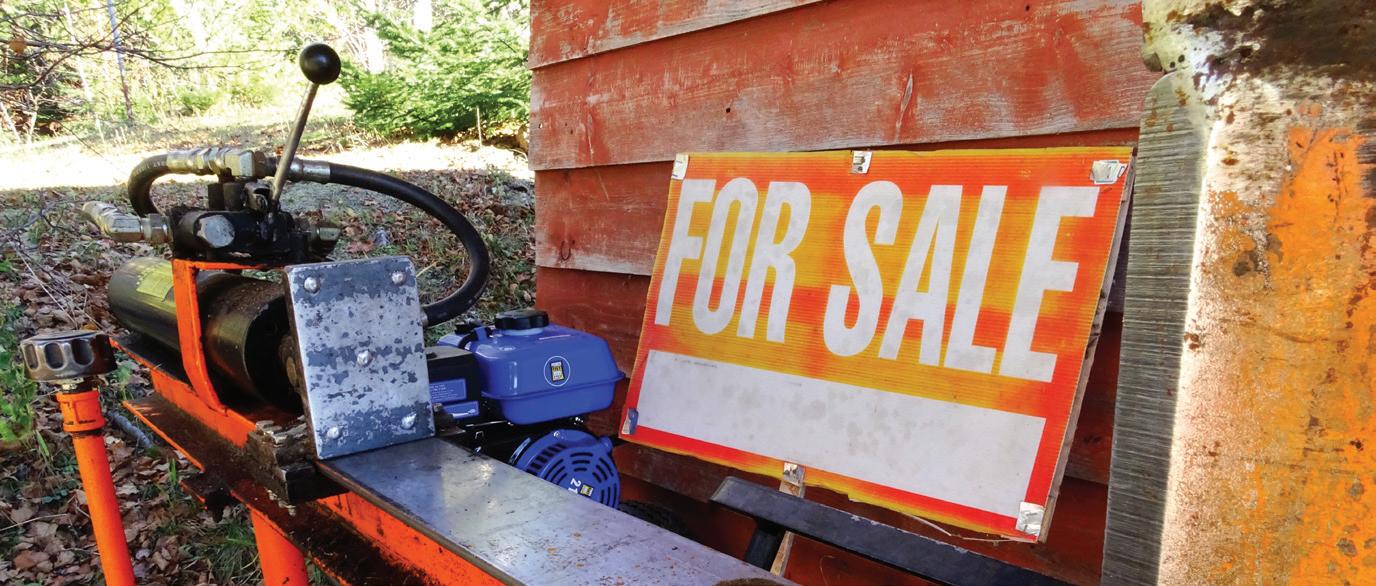
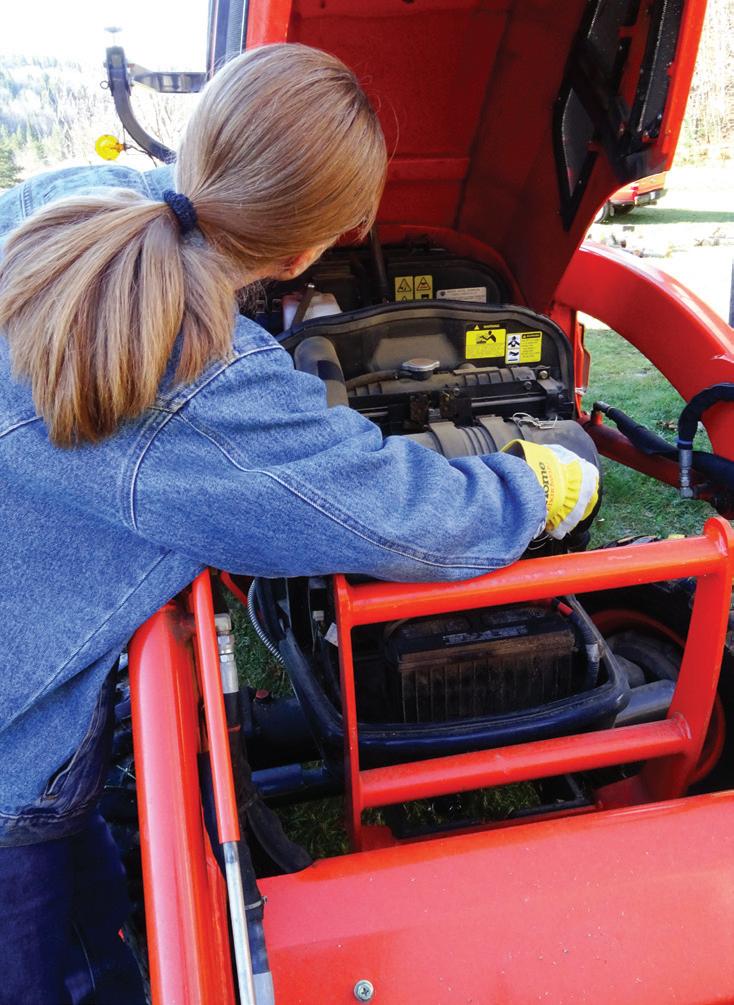

When not on a tractor or chasing potato bugs, Cary Rideout can be found writing about the rural world he loves. The awardwinning Canadian writer is the fourth generation to work the fields and woods of his “hundred and half.” His work is a celebration of the beauty and strength of the country world he shares with his artist wife, Lorain.
Food Swap
Specialty Recipes for Bartering, Sharing, and Giving
Part cookbook, part how-to guide, Food Swap features more than 80 recipes for artisanal items that’ll be coveted at food swaps and adored as gifts, including everything from salted caramel sauce and Meyer lemon curd to green tomato salsa, lavender shortbread, cultured butter, apricot jalapeño jelly, and rum vanilla extract. You’ll also find creative ways to irresistibly package your items, plus perforated gift tags ready for personalization. Author Emily Paster, co-founder of the Chicago Food Swap (one of the biggest in the world), offers guidance on setting up a food swap in your own community, as well as inspiring stories from people who are part of this growing movement.
This title is available at Store.Grit.com or by calling 866-803-7096. Mention promo code MGRPANZ5. Item #7983.
 Conduct a hands-on examination of the item you intend to buy before entering a dickering discussion.
Bring a good attitude into bargaining, and indicate you’re there to buy but not throw money away.
Conduct a hands-on examination of the item you intend to buy before entering a dickering discussion.
Bring a good attitude into bargaining, and indicate you’re there to buy but not throw money away.
March/April 2023 54











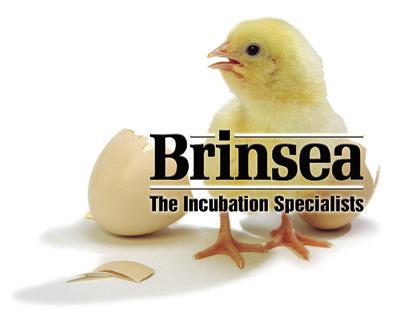
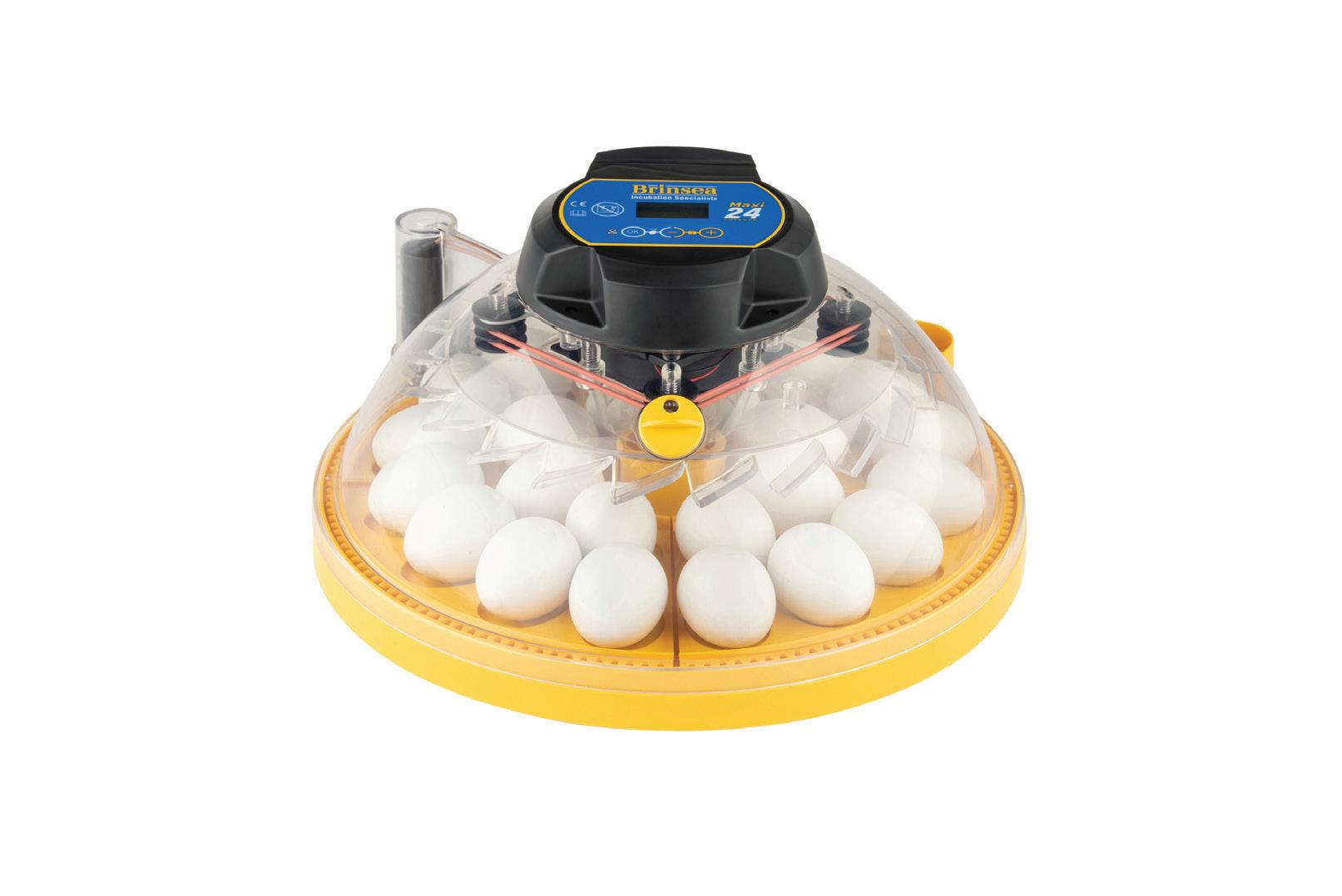




























































No purchase necessary. A purchase will not increase your chances of winning. Open to legal residents of the continental United States (excluding Hawaii). www.motherearthnews.com/sweepstakes/brinsea-spring-2023 I Sponsor: Mother Earth News, 1503 SW 42nd St., Topeka, KS 66609. www.MotherEarthNews.com/Sweepstakes/sweepstakes/brinsea-spring-2023 Enter the Brinsea and MOTHER EARTH NEWS Giveaway! Enter for your chance to Convenience and flexibility make the Maxi 24 Advance the ideal incubator for any breeder. Automatic turning, countdown to hatch day and comprehensive alarms provide reassurance of hatching success. Enter for your chance to win! Valued at $350. Moreonline!details Enter for a chance to be 1 of 4 winners SWP_ME99 Brinsea_half.indd 1 1/23/23 2:18 PM 855.386.7826 chestnuthilloutdoors@gmail.com Planting soft and hard mast orchards is a great way to significantly increase available wildlife nutrition for an extended period of time. As the industry’s leading nursery, Chestnut Hill Outdoors is the exclusive producer of the Dunstan Chestnut and the trusted provider to help you reach your land stewardship goals. BUILD A BETTER HABITAT Enrich Your Land for Generations. CHESTNUTHILLOUTDOORS.COM FIND MY STORE See #5 on page 60
Types of Oats
All oats start as groats, the whole, unbroken kernels of the oat. Before being processed into different varieties, the groats are roasted at a low temperature.
Quick-rolled oats, also referred to as “instant oats,” go through the most processing they’re partially cooked with steam, and then flattened until thin and as a result, they cook quite quickly. They have a mild flavor and retain less texture than other forms of oats. Similar to rolled oats, they’re steamed longer and rolled thinner.
Rolled oats, also called “old-fashioned oats,” are oat groats that’ve been run through a roller, giving them their signature flat shape. Before being flattened, they’re steamed to create softness and pliability. Rolled oats cook much faster than unrolled oats and absorb more liquid. They’re commonly used in muesli, cookies, muffins, and other baked goods.
Scottish oats are whole groats that’ve been ground (preferably stone-ground) into a meal rather than being cut with a blade. Their texture is similar to that of steel-cut oats but finer, and their consistency makes for a creamy and nutty porridge.
A Healthy Dose of OATS
Oats aren’t just for breakfast! Use this versatile food in sweet and savory recipes that are delicious any time of day.
By Ronda Carman
Photos by Matthew Mead
Whatcould
be better than a warm bowl of oatmeal on a cool, crisp morning? Yet, while oatmeal serves as a healthy and hearty morning meal, oats aren’t just for breakfast. You can incorporate this versatile, beneficial grain into everything from fritters to savory sun-dried-tomato muffins.
Like all grains, oats are made of kernels with three parts: the bran layer, filled with fiber and vitamins; the germ, rich in healthy oils; and the starchy endosperm, containing more protein per serving than most whole-grain cereals. Oats are also rich in potassium, low in sodium, and contain several vitamins, including thiamin, riboflavin, niacin, vitamins B6 and E, and folate.

Steel-cut oats, also known as “Irish oats,” are groats that’ve been cut into small pieces with a sharp metal blade. They take the longest time to cook and have a chewy texture, because the pieces retain their shape after cooking. In addition to porridge, steel-cut oats can be used to bind meatloaf or add texture to stuffing.
PESTO AND ROASTED POTATO OATMEAL BOWLS
I love this nourishing and savory bowl of oatmeal, studded with roasted garlic and topped with crispy potatoes and bright basil pesto. Serve it for breakfast, lunch, or dinner. If you’d like, top each portion with an egg cooked sunny-side up. Yield: 4 servings as a main course.
11⁄2 pounds small new potatoes, cut into 1⁄2-inch wedges
1 tablespoon plus 11⁄2 teaspoons sea salt
8 cloves garlic, unpeeled
2 tablespoons extra-virgin olive oil
March/April 2023 56
2 cups rolled oats
1 cup shredded Gruyère
1⁄4 cup basil pesto, preferably Seggiano Fleur de sel, to taste
Freshly ground black pepper, to taste
1. Preheat the oven to 425 F. Line a baking sheet with parchment paper and set aside.
2. Place potatoes in a large stockpot and add enough cold water to cover by 1 inch. Add 1 tablespoon sea salt, and bring the water to a boil over medium heat. Boil for 4 minutes, then drain potatoes. In a medium bowl, toss potato wedges and garlic cloves in oil with remaining 11⁄2 teaspoons sea salt.

3. Spread potatoes and garlic in a single layer on the prepared baking sheet. Roast in the preheated oven for
10 minutes, then remove garlic cloves. Once garlic is cool enough to handle, peel the cloves (just squeeze them and they should pop out of the skin) and set aside. Meanwhile, toss potatoes and roast until golden-brown, about 10 additional minutes.
4. While potatoes are in the oven, bring 4 cups water to a boil in a large saucepan over high heat. Once water is boiling, stir in oats and lower the heat to medium-high. Cook for 5 minutes, stirring occasionally. Once oats are cooked, fold in cheese. Stir until cheese is melted and oats are creamy. Divide oatmeal among 4 bowls. Top each portion with potatoes, 1 tablespoon pesto, and 2 cloves roasted garlic. Season with fleur de sel and pepper.
OATCAKES
One of the things I miss about living in Scotland is picking up oatcakes from the grocery store. Luckily, they’re easy to make at home. Steel-cut oatmeal and whole-wheat flour create savory crackers that are crisp and nutty. I like to eat them with cheese or smoked fish pâté. They’re great with butter and jam too. Yield: six 3-inch cakes.
2⁄3 cup steel-cut oats
1⁄4 cup whole-wheat flour
1⁄2 teaspoon kosher salt
1⁄4 teaspoon baking soda
1 tablespoon unsalted butter, cold Unbleached all-purpose flour, for work surface
1. Preheat the oven to 350 F. Line a baking sheet with parchment paper and set aside.
2. In a large bowl, mix together oats, flour, salt, and baking soda. Cut in butter until evenly distributed. Add 3 tablespoons cold water and mix with a fork until moist.
3. On a lightly floured surface, pat dough into a ball and flatten slightly. Roll out dough to a 1⁄4-inch thickness. Cut into
Fun Fact
Each fall, oatmeal fans from around the world gather in the small village of Carrbridge, Scotland. They trek to the Highlands with a lofty yet humble objective to be named the World Porridge Making Champion and take home the Golden Spurtle trophy. The rules are strict. Each bowl of porridge is made with nothing more than oats, water, and salt. Competitors often bring their own water and select their salt with equal care.
No electricity is supplied, and contestants rely on their own cooking devices. The implements are spartan, too, consisting of just a pot and a spurtle. This wooden Scottish kitchen tool, dating from the 15th century, is used to stir porridge. The rod-like shape allows porridge to be stirred without forming lumps. Spoons are deemed to have a dragging effect.
www.Grit.com 57
Pesto and Roasted Potato Oatmeal Bowls
rounds with a 3-inch cookie cutter. Reroll scraps and cut more rounds.
4. Place rounds 1⁄4 inch apart on the baking sheet. Bake in the oven until slightly firm and lightly golden, 15 to 20 minutes. Transfer oatcakes to a rack and allow to cool before serving.
NORDIC ROOT VEGETABLE SOUP

Oats aren’t just for baking or breakfast. They’re a great addition to brothy soups. This recipe is my take on the root vegetable
soups I’ve enjoyed in Denmark and Iceland. Both countries have a long culinary history of using winter roots to create robust meals. The oats are a nod to my mother’s barley vegetable soup nothing fancy, just simple and delicious. Yield: 4 to 6 servings.
1 cup rolled oats
2 tablespoons extra-virgin olive oil
3 large shallots, thinly sliced
2 leeks, white and tender green parts, thinly sliced
4 cloves garlic, minced
8 cups chicken or vegetable stock, plus more if needed
8 sprigs thyme
3 bay leaves
1 pound turnips or rutabagas, cut into 1⁄2-inch pieces

1⁄2 pound parsnips, peeled and cut into 1⁄2-inch pieces
1⁄2 pound carrots, peeled and cut into 1⁄2-inch pieces
11⁄2 teaspoons kosher salt, plus more to taste
1⁄2 teaspoon freshly ground black pepper, plus more to taste
1⁄2 teaspoon freshly grated nutmeg
Flat-leaf parsley, for garnish
1. Heat a large skillet over mediumhigh. Add oats. Stirring often, toast oats until fragrant, about 5 minutes. Remove oats from heat and set aside.
2. Heat oil in a large stockpot over medium-high heat. Add shallots and leeks. Sauté until tender, about 5 minutes. Add garlic and sauté 1 additional minute.
3. Add stock, 2 cups water, thyme, and bay leaves, and bring to a boil. Add turnips, parsnips, carrots, 1 1⁄ 2 teaspoons salt, and 1⁄ 2 teaspoon pepper. Simmer over medium-low heat until vegetables are tender, about 40 minutes. Increase heat to medium-high and bring to a gentle boil, then add toasted oats. Stir to combine, lower heat to medium, and cover. Simmer until soup is thick, 8 to 10 minutes.
4. Stir in nutmeg and allow soup to simmer, uncovered, 1 minute. If soup becomes too thick, add a splash of stock or water. Adjust salt and pepper, and garnish with fresh parsley. Serve in large soup bowls.
This excerpt is from The Art of Pantry
Cooking: Meals for Family and Friends by Ronda Carman (Rizzoli New York).
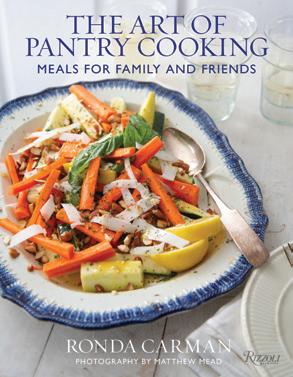
March/April 2023 58
Nordic Root Vegetable Soup





















































Field Tested. Field Trusted. Nutrition that’s ready to answer the call, VICTOR’s field-tested formulas o er high quality protein sources with the nutritional benefits your loyal companion needs to run strong season a er season. Every bag of VICTOR, including our exclusive Realtree® line, features our VPRO® Blend - designed to support joint health, immune system function, strengthen paw pads, and more. Find the right formula for your partner at victorpetfood.com
*If you have recently requested information using our reader service reply card and have not received a response, please reach out to the advertiser directly at the above link.

March/April 2023 60
IFC = Inside Front Cover IBC = Inside Back Cover OBC = Outside Back Cover
AD # ACCOUNT NAME PAGE URL PHONE NUMBER 1 Allivet 39, 65 www.allivet.com 877-500-9944 2 ALLOGIC, Inc/Adstore.com 65 www.adorstore.com 832-444-0192 3 Ardisam 15, 43 www.yardbirdpluckers.com 800-345-6007 4 Brinsea Products Inc. 37, 63, 64 https://www.brinsea.com/catalog.aspx 888-667-7009 5 Chestnut Hill Nursery 55 chestnuthilloutdoors.com 855-386-7826 6 Dr. Jimz 23 www.DrJimZ.com 888-394-4454 7 Earth & Turf Attachments 64 www.earthandturfattachments.com 877-800-6625 8 Earth & Turf Products 51 www.earthandturf.com 888-693-2638 9 Innovacyn Inc. 71 vetericyn.com 866-318-3116 10 John C. Campbell Folk School 53 www.folkschool.org 800-365-5724 11 Johnny’s Selected Seeds 31 www.johnnyseeds.com/new 877-564-6697 12 Jung Seed 17 www.jungseed.com 800-247-5864 13 KozGro Organics 33 www.kozgroorganics.com 208-718-8771 14 Lehman’s 45 www.lehmans.com/?menews 800-438-5346 15 MacKissic 10 www.mackissic.com 800-348-1117 16 Mole Publishing Co. 65 www.undergroundhousing.com 800-328-8790 17 Neptune Harvest/Ocean Crest Seafood 64 www.neptunesharvest.com 800-259-4769 18 Nopec 49 www.chickendoors.com 512-995-0058 19 Pacific Yurts OBC www.yurts.com 800-944-0240 20 Premier 1 Supplies 63 premier1supplies.com/pages/catalog 800-282-6631 21 Progressive Insurance 7 www.progressive.com 800-PROGRESSIVE 22 Seed Savers Exchange 21 www.seedsavers.org 563-382-5990 23 Skyline Enterprises 63 www.skylineclotheslines.com 330-403-3010 24 Southern Exposure 41 www.southernexposure.com 540-894-9480 25 Summit Responsible Solutions 19 www.SummitResponsibleSolutions.com 800-227-8664 26 Wisconsin Aluminum 63 www.allamerican1930.com 920-682-8627 27 Wood-Mizer Products, Inc. 29 www.woodmizer.com 317-271-1542 28 Worksaver, Inc. 35 www.worksaver.com 217-324-5973 PLEASE VISIT www.grit.com/advertiser-directory to connect with our advertisers for further product information. Free Information From Our Advertisers
Defining Quality for Generations


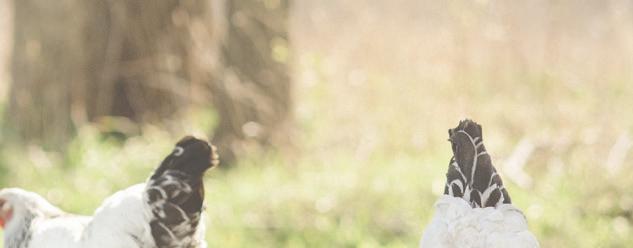












For over a century, Murray McMurray Hatchery has remained a trusted, family-owned business, working tirelessly to ensure our poultry meets the highest standards. Whether you are an experienced enthusiast, or just embarking on the journey, look to McMurray Hatchery for guaranteed quality rare and Heritage breeds, low minimums, and all the supplies you need to raise your flock.
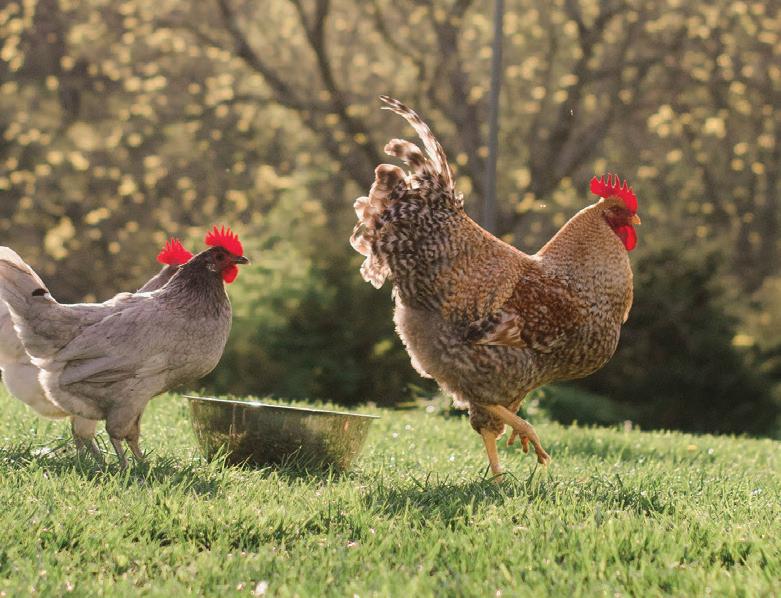

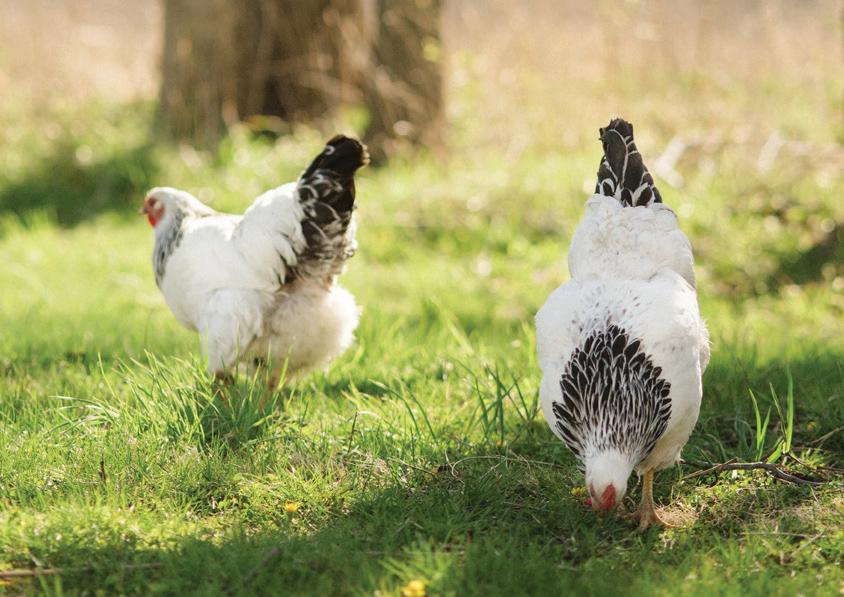

| 800.456.3280




SCAN TO REQUEST A FREE CATALOG
MCMURRAYHATCHERY.COM
2006 - 2022 GRIT ARCHIVE



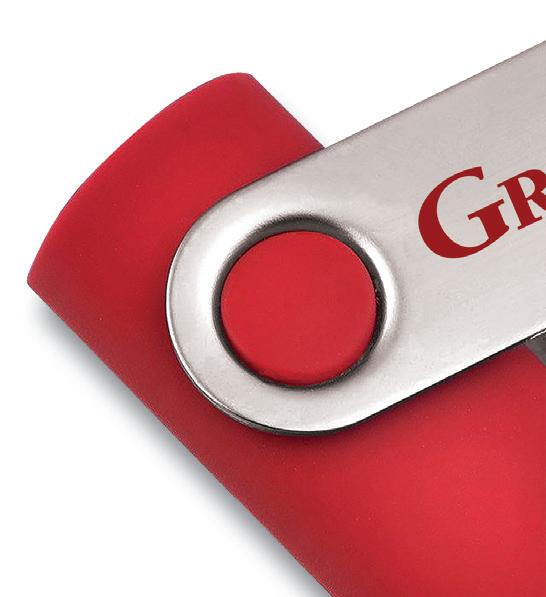




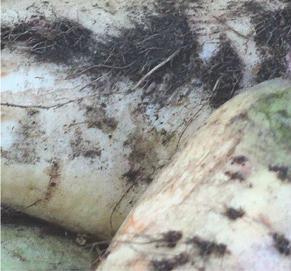






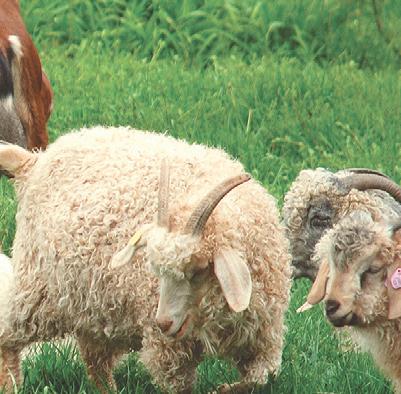


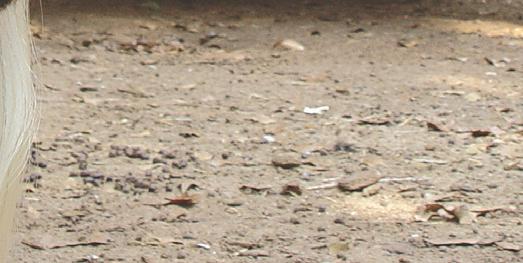











Access more than 11,000 articles: 17 years of tips, recipes and project ideas!






















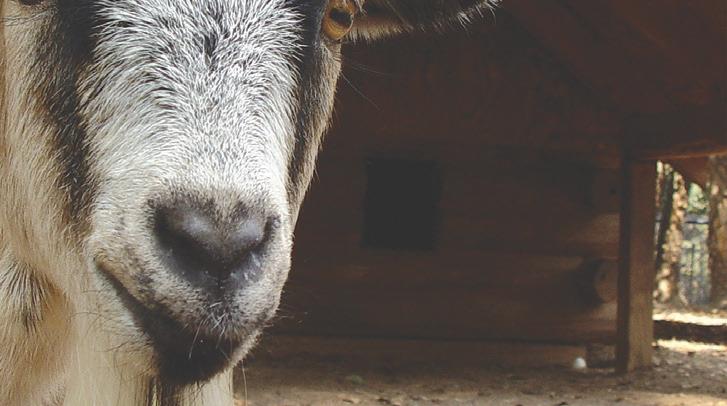





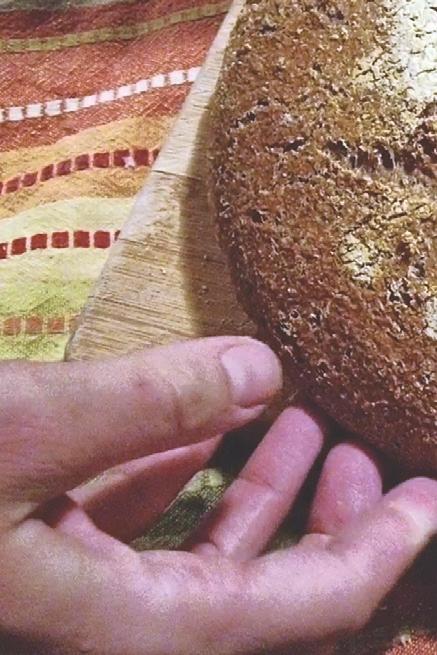
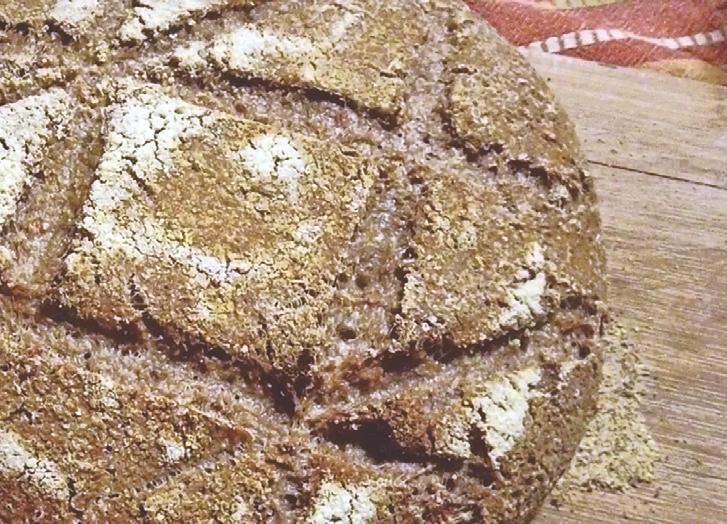

,





We have compiled 17 years of Grit, bringing you all the best information to help you get the most from living out where the pavement ends, or utilize your urban backyard—delivered on a ash drive that plugs into the USB port on your favorite electronic device. Our archives include articles with expert advice on growing the best heirloom tomatoes, which types of chickens are best for your place, choosing and maintaining your machinery, how to select and build the best fences, and so much more—you’ll nd it all here!


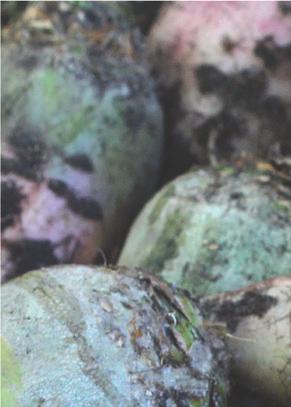
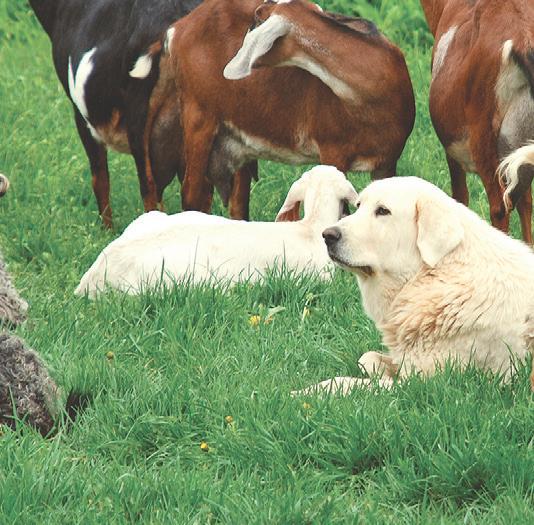

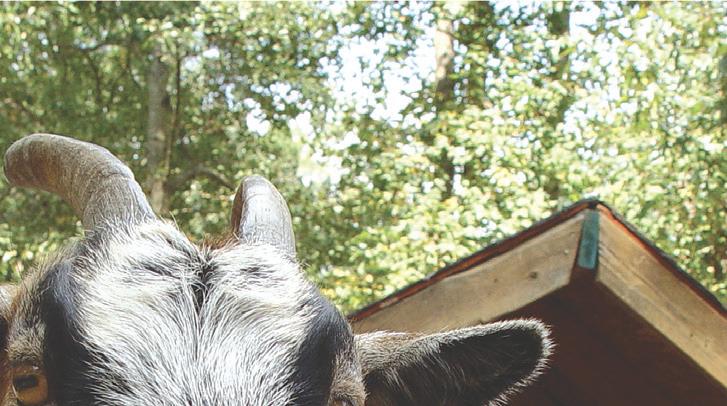




With the ability to search the entire archive or browse by each month and year, the interface contains enhanced search features that allow you to search by date range, exact phrases and word combinations, headline only, popular categories, and more!

$39.95 | ITEM #11852
Does not include shipping and handling.



DELIVERED ON USB DRIVE.

Order today by calling 866-803-7096 or visiting Store.Grit.com
code: MGRPANZ1
Promo



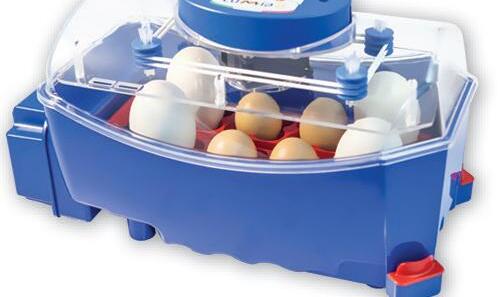

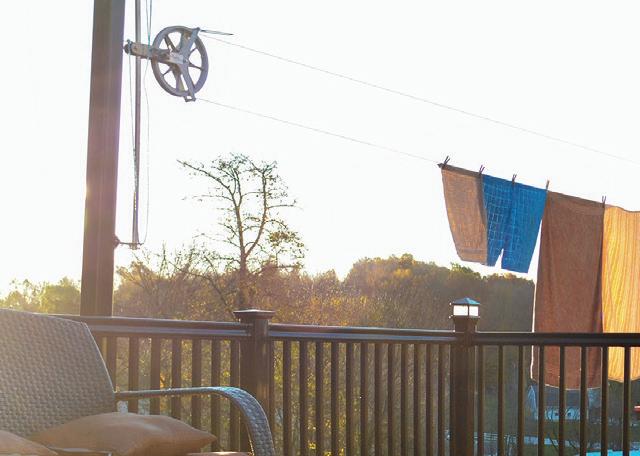





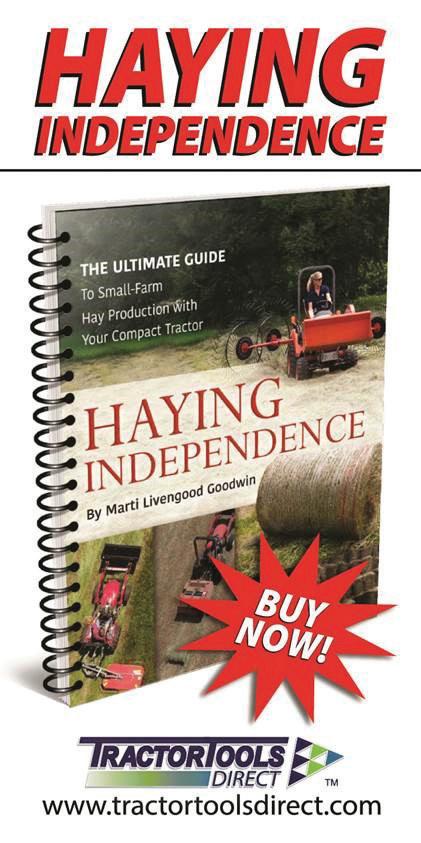

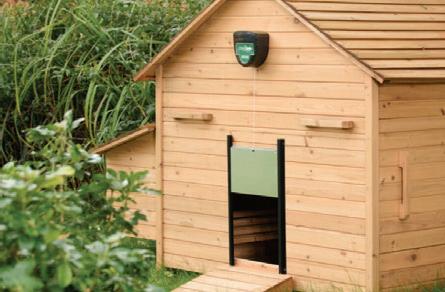
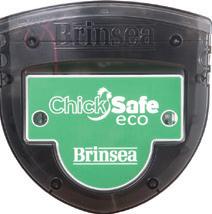



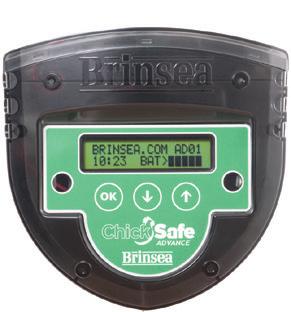


www.Grit.com 63 MARKETPLACE Automatic turning Humidity pump Professional results 4 sizes to suit Ideal for the new user! Premier1Supplies.com 800-282-6631 Borotto IncubatorsEgg ® 330.403.3010 skylinenter@gmail.com 5452 Township Rd. 377 Millersburg, OH 44654 • 8”, 12”, & 16” poly or aluminum pulleys • Powdercoat finish on metal components • Spring lock mechanism to lock pulley • Cable guides to prevent derailing • 4 foot galvanized elevator pole FEATURES INCLUDE: OUR UNIQUE DESIGN MAKES HANGING LAUNDRY A www.skylineclotheslines.com PLANT A WALL SYSTEM No tools needed Simply add soil and plants The first truly modular system for building raised beds or container gardening Great for growing flowers or vegetables 484-824-3180 PlantAWallSystem.com 4 23 20 26












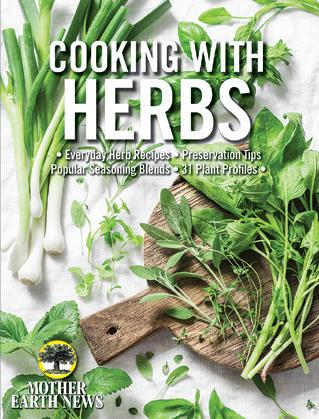










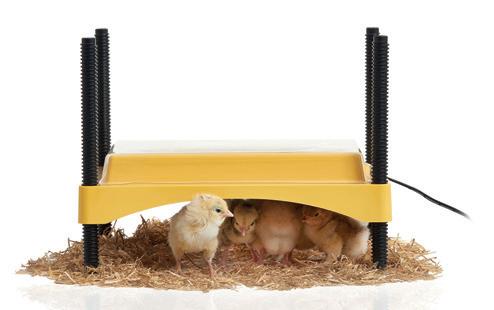
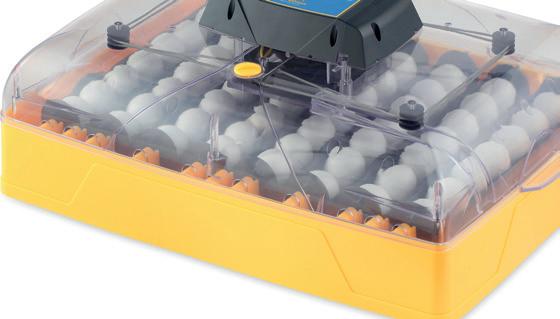
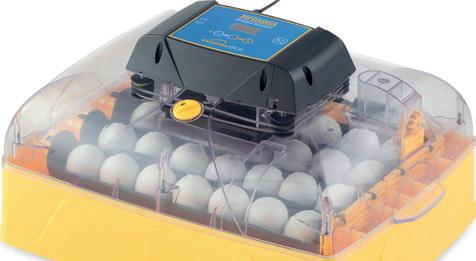






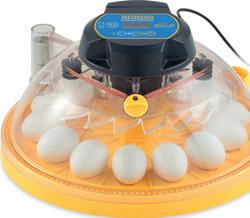




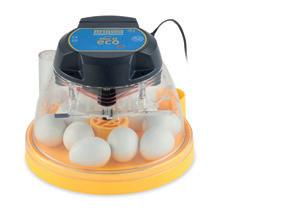

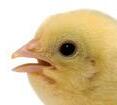
















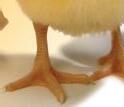














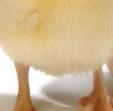








March/April 2023 64 MARKETPLACEMARKETPLACE Item #9476 | $12.99 Find out more at Store.Grit.com or call 866-803-7096 Please mention code MGRPANZ2. GRT_CookingWithHerbs_2.14 x 2.22.indd 1 2/2/2023 3:02:28 PM www.GRIT.com/shopping SHOP A COMMON-SENSE, Community-Based Approach to ANY TYPE OF DISASTER Order today and learn preparedness techniques to keep you and your family safe during natural disasters! $17.99 Item #10307 Find out more at Store.Grit.com or call 866-803-7096. Please mention code MGRPANZ2. Commercially proven. Outperform chemicals. Wholesale/Retail/Farm. FREE CATALOGS. 800-259-4769 www.neptunesharvest.com NEPTUNE’S HARVEST ORGANIC FERTILIZER 800.999.1020 Find lifestyle, farm, country & more properties UnitedCountry.com Free Catalog For more information www.brinsea.com or call 1-888-667-7009 Brinsea the world leading incubator manufacturer has a full line of incubators, brooders, egg candlers, starter kits and much more! Color Incubation Specialists Hatching your own chicks is fun, easy reliableandwith Brinsea Ifahencould choose… 4 7 17
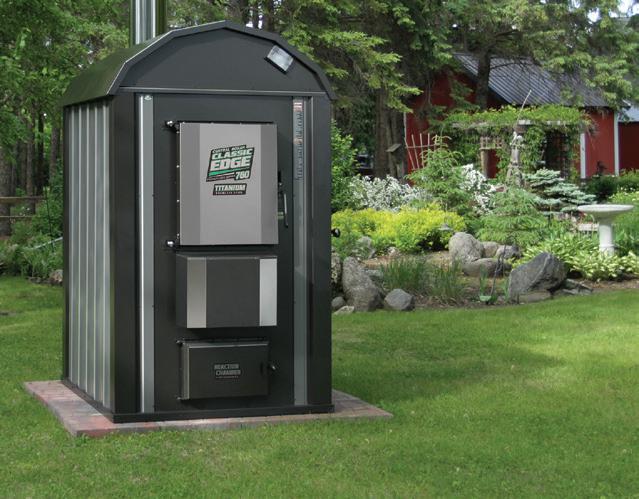


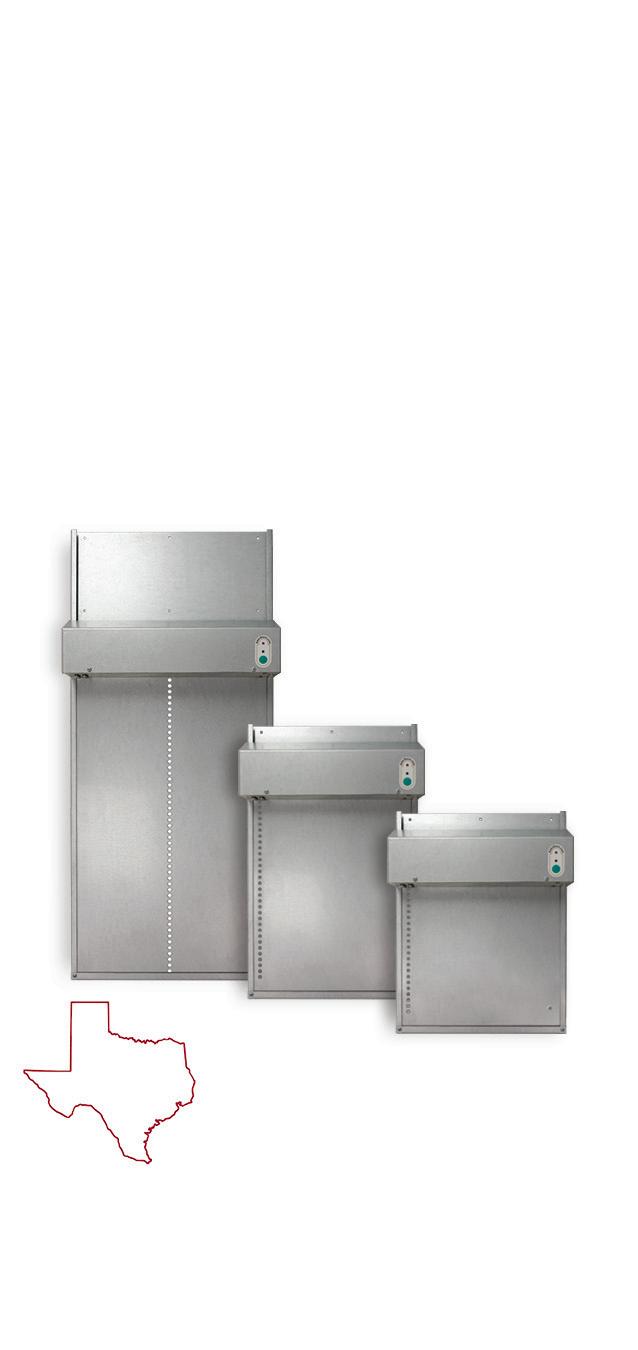





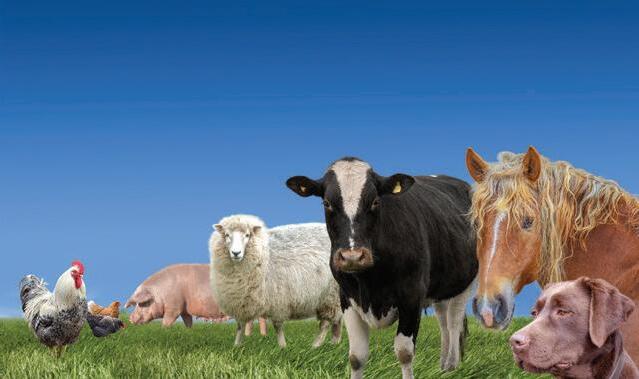











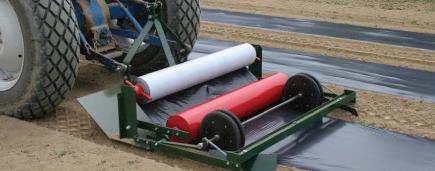



www.Grit.com 65 To learn about limited-time, money-saving offers and for the dealer nearest you, visit CentralBoiler.com or call 800-248-4681 This IS Energy Independence. More convenience, safety and savings than any other method of wood heat. Outdoor Wood Furnace 2000 UP TO TAX CREDIT* $ *On quali ed models and installation. US Internal Revenue Code Sec. 25(C) e ective Jan. 1, 2023, for heating a residence. Consult a tax professional with any questions. ©2023 Central Boiler • ad7875 There is no better way to heat with wood. Turkey Chicken Mini Call or Order Online Made in USA AdorStore.com Automatic Doors for Chickens Guineas, Ducks, Peacocks & Turkeys 832-444-0192 info@adorstore.com www.adorstore.com Rugged Galvanized Steel 1 year warranty Free USA shipping* Free Battery Included Ideal for remote location LED status indicator Mount inside or outside Compatible with wifi Door Locks Shut Built in RedScare *Excluding Turkey Door) I adore my ADOR Order the 3 DVD set for $95.00 plus $7 Shipping and get both The $50 and Up Underground House Book and The Earth-Sheltered Solar Greenhouse Book each for less than 1⁄2 price. Both books ship free. Special orders now available on our website: www.undergroundhousing.com 800-328-8790 SPECIAL #3 build underground houses/shelters/greenhouses dirt cheap! Mechanical Transplanter Company, LLC 1150 Central Avenue * Holland, MI 49423 Phone: 616-396-8738 or Fax: 616-396-3619 MODEL 85 - Mulch Layer * Lays 3’ or 4’ plastic mulch * Optional DRIP attachment available MARKETPLACE 1 16 2
PRACTICAL NO-TILL FARMING
PRACTICAL NO-TILL FARMING
Do less, produce more, and grow soil that feeds crops using chemical-free, organic no-till methods. Andrew Mefferd, veteran farmer, author of The Organic No-Till Farming Revolution, and editor of Growing for Market magazine, brings you the ultimate guide to getting started with no-till farming. Yet there are many ways to do no-till, including mulching with compost, cardboard, straw, silage tarps, and more. Plus plenty of conflicting advice on how to get started.
Do less, produce more, and grow soil that feeds crops using chemical-free, organic no-till methods. Andrew Mefferd, veteran farmer, author of The Organic No-Till Farming Revolution, and editor of Growing for Market magazine, brings you the ultimate guide to getting started with no-till farming. Yet there are many ways to do no-till, including mulching with compost, cardboard, straw, silage tarps, and more. Plus plenty of conflicting advice on how to get started.
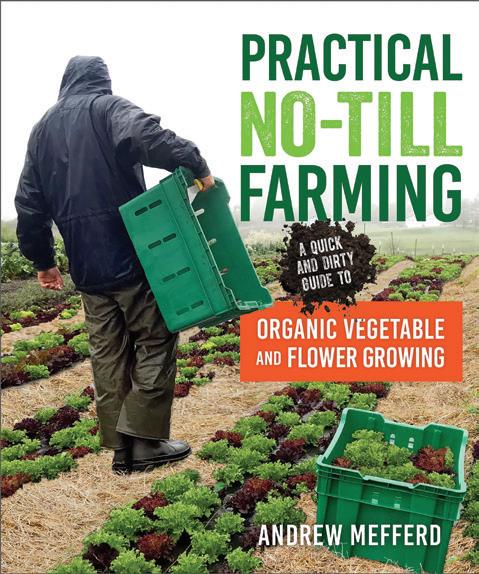
#11868 $34.99 Member: $29.74
#11868 $34.99 Member: $29.74
SOIL BLOCKER SET
SOIL BLOCKER SET














Get everything you need to start making your own soil blocks! This kit includes: the Mini 4 Soil Blocker, the Micro 20 Soil Blocker, and Cubic Inserts for the Mini 4 Soil Blocker. Ladbrooke has created some of the most eco-friendly tools that will provide a high germination rate and easy blooming.
Get everything you need to start making your own soil blocks! This kit includes: the Mini 4 Soil Blocker, the Micro 20 Soil Blocker, and Cubic Inserts for the Mini 4 Soil Blocker. Ladbrooke has created some of the most eco-friendly tools that will provide a high germination rate and easy blooming.
LET’S WILDFLOWER THE WORLD
LET’S WILDFLOWER THE WORLD
This is an exciting introduction to the global seed-swapping and grassroots gardening movement, exploring how we can rewild the world around us with beautiful wildflowers. As seed bombing and seed swapping become even more popular, passionate seed activist Josie Jeffery presents an invaluable handbook to the practices, explaining how we can fill the world around us with beautiful wildflower blooms and why we should care about our plant heritage.
This is an exciting introduction to the global seed-swapping and grassroots gardening movement, exploring how we can rewild the world around us with beautiful wildflowers. As seed bombing and seed swapping become even more popular, passionate seed activist Josie Jeffery presents an invaluable handbook to the practices, explaining how we can fill the world around us with beautiful wildflower blooms and why we should care about our plant heritage.


#11877 $20.00 Member: $17.00
#11877 $20.00 Member: $17.00
HARDY APPLES
WOMANSWORK DIGGER GLOVES
WOMANSWORK DIGGER GLOVES

The best-selling garden glove for everyday tasks. Womanswork exclusive “Digger” gloves are doubly reinforced at the fingertips, so they hold up to lots of digging in the garden and look good even after repeated washings. The palm is lightly padded for extra comfort. A more extended cuff with velcro wrist closure gives the gloves a snug fit and keeps soil from getting inside; terry brow wipe on thumb. The multi-purpose “Digger” gloves offer agility and protection for all your chores. Available in: Teal Blue, Magenta, Purple, and Green in Women’s sizes S, M, L. #11653-11671 $19.95 Member: $17.95
The best-selling garden glove for everyday tasks. Womanswork exclusive “Digger” gloves are doubly reinforced at the fingertips, so they hold up to lots of digging in the garden and look good even after repeated washings. The palm is lightly padded for extra comfort. A more extended cuff with velcro wrist closure gives the gloves a snug fit and keeps soil from getting inside; terry brow wipe on thumb. The multi-purpose “Digger” gloves offer agility and protection for all your chores. Available in: Teal Blue, Magenta, Purple, and Green in Women’s sizes S, M, L. #11653-11671 $19.95 Member: $17.95

Hardy Apples is both a practical guide and a loving tribute to the wonderful abundance and diversity of apple cultivars available to the northern gardener and orchardist. Full of tips, facts, beautiful photographs, and fascinating stories about apples, both popular and obscure, this book is sure to inform and entertain in equal measure.
#10047 $84.95 Member: $79.95
HARDY APPLES
Hardy Apples is both a practical guide and a loving tribute to the wonderful abundance and diversity of apple cultivars available to the northern gardener and orchardist. Full of tips, facts, beautiful photographs, and fascinating stories about apples, both popular and obscure, this book is sure to inform and entertain in equal measure.

#11866 $35.00 Member: $29.75
#11866 $35.00 Member: $29.75
#10047 $84.95 Member: $79.95
blooming. #10047
ORGANIC GARDENING FOR EVERYONE
ORGANIC GARDENING FOR EVERYONE




Loaded with practical advice and stepby-step guidance, Organic Gardening for Everyone takes a very personal and friendly approach to a subject that can be intimidating. It is a first-class primer on organic vegetable gardening, and an inspirational story about how anyone can balance the rigors of gardening with the demands of a modern, family-oriented lifestyle.
Loaded with practical advice and stepby-step guidance, Organic Gardening for Everyone takes a very personal and friendly approach to a subject that can be intimidating. It is a first-class primer on organic vegetable gardening, and an inspirational story about how anyone can balance the rigors of gardening with the demands of a modern, family-oriented lifestyle.

#10832 $24.99 Member: $21.24
#10832 $24.99 Member: $21.24


FORGED TRANSPLANT TROWEL
FORGED TRANSPLANT TROWEL


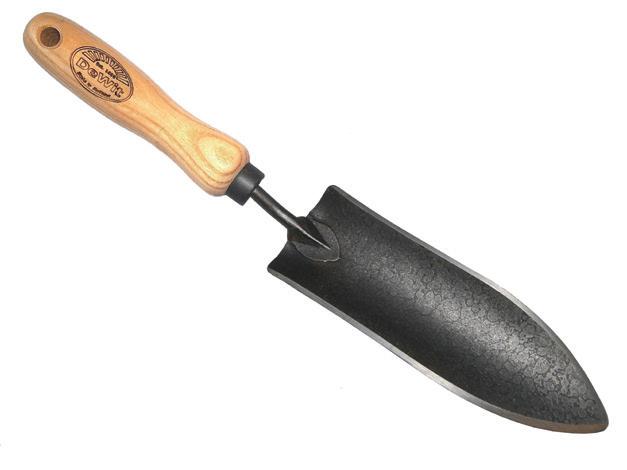


The transplant trowel has a narrow blade compared to a regular trowel and is very sharp from top to bottom. Narrow blade is perfect for working in tight spots and ideal for planting bulbs and other precise tasks.
The transplant trowel has a narrow blade compared to a regular trowel and is very sharp from top to bottom. Narrow blade is perfect for working in tight spots and ideal for planting bulbs and other precise tasks.





Head: 7”L x 2.25”W Total: 13.5”L; 0.5lb
#11290 $31.99 Member: $29.99
Head: 7”L x 2.25”W Total: 13.5”L; 0.5lb #11290 $31.99 Member: $29.99
TO ORDER, CALL TOLL-FREE: 866-803-7096 (OUTSIDE U.S. AND FOR CUSTOMER SERVICE: CALL 785-274-4365)


March/April 2023 66
NEW
NEW
NEW ITEM!
ITEM!
NEW ITEM!
ITEM!
11653 Green S 11654 Green M 11655 Green L 11656 Magenta S 11657 Magenta M 11658 Magenta L 11659 Purple S 11670 Purple M 11671 Purple L 11662 Teal Blue S 11663 Teal Blue M 11664 Team Blue L TO ORDER, CALL TOLL-FREE: 866-803-7096 (OUTSIDE U.S. AND FOR CUSTOMER SERVICE:
CALL 785-274-4365)
NEW ITEM! NEW ITEM! NEW ITEM! NEW ITEM!
11653 Green S 11654 Green M 11655 Green L 11656 Magenta S 11657 Magenta M 11658 Magenta L 11659 Purple S 11670 Purple M 11671 Purple L 11662 Teal Blue S 11663 Teal Blue M 11664 Team Blue L
BEST SELLER!
THE ULTIMATE OUTDOOR COOKBOOK
THE ULTIMATE OUTDOOR COOKBOOK
In The Ultimate Outdoor Cookbook, you will learn how to cook every meal of the day outside, from breakfast to dessert with drinks in between, using live fire, grills, foil packs, cast iron pans, and dutch ovens, planchas, and some with a smoker. Enjoy over 100 delicious and easy-to-prepare recipes for all tastes and diets.
In The Ultimate Outdoor Cookbook, you will learn how to cook every meal of the day outside, from breakfast to dessert with drinks in between, using live fire, grills, foil packs, cast iron pans, and dutch ovens, planchas, and some with a smoker. Enjoy over 100 delicious and easy-to-prepare recipes for all tastes and diets.
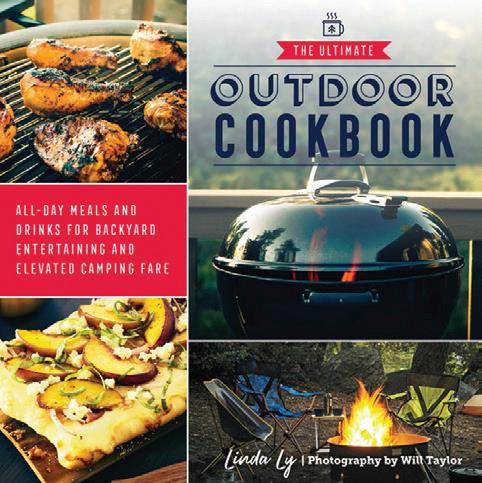
#11450 $19.99 Member: $16.99
#11450 $19.99 Member: $16.99
DIY KOMBUCHA
DIY KOMBUCHA
Since the relatively recent introduction of kombucha onto North American supermarket shelves, this healthy sparkling beverage has exploded in popularity. But can it be brewed at home, with the same tasty, healthy results?
With this straightforward, accessible, and highly visual how-to guide, author Andrea Potter does away with specialist jargon and expensive or hard-to-find equipment, showing how sparkling homebrews from kombucha to water kefir are definitely possible for just about anyone to make, and have fun doing it.
Since the relatively recent introduction of kombucha onto North American supermarket shelves, this healthy sparkling beverage has exploded in popularity. But can it be brewed at home, with the same tasty, healthy results? With this straightforward, accessible, and highly visual how-to guide, author Andrea Potter does away with specialist jargon and expensive or hard-to-find equipment, showing how sparkling homebrews from kombucha to water kefir are definitely possible for just about anyone to make, and have fun doing it. Available as an e-book!

Available as an e-book!
#8946 $24.99 Member: $21.24
#8946 $24.99 Member: $21.24
THE DEHYDRATOR BIBLE
THE DEHYDRATOR BIBLE
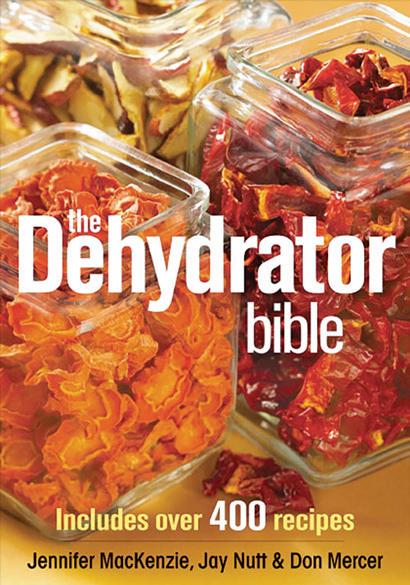
Dehydrating is one of the most effective ways to preserve food for maximum nutrition at a very low cost. Sales of dehydrators are soaring as many cooks reject the suspect ingredients in commercially prepared foods. Dehydrating with the recipes in this book is one way to control all ingredients and please the whole family. Recipes for dried ingredients include herbs and seasonings, fruits, fruit leathers, vegetables, and beef jerky.
Dehydrating is one of the most effective ways to preserve food for maximum nutrition at a very low cost. Sales of dehydrators are soaring as many cooks reject the suspect ingredients in commercially prepared foods. Dehydrating with the recipes in this book is one way to control all ingredients and please the whole family. Recipes for dried ingredients include herbs and seasonings, fruits, fruit leathers, vegetables, and beef jerky.
#6131 $24.95 Member: $21.21
#6131 $24.95 Member: $21.21
CERTIFIED ORGANIC WORM CASTINGS: 3 LB., 10 LB., 15 LB. Certified organic worm castings are nature’s best fertilizer! Earthworms are some of the cleanest, most helpful creatures in the world. They form their waste in tiny, ball-shaped black pellets called castings. Worm humus is the end product of their breakdown of organic matter. This manure is also known as vermicasting. Organic worm castings are perfect for your vegetables, fruits, trees, shrubs, flowers, potted houseplants, and more! These castings act as a repellent to whiteflies, aphids, spider mites, and other pests that feed on plant juices. 3 lb. & 10 lb. sizes come in Mother Earth News bags, and the 15 lb. size comes in a plain box. #9714 3 Lb. Bag; #9715 10 Lb. Bag; #9715 15 Lb. Box $19.99/29.99/39.99 Member: $17.99/27.99/36.99
CERTIFIED ORGANIC WORM CASTINGS: 3 LB., 10 LB., 15 LB. Certified organic worm castings are nature’s best fertilizer! Earthworms are some of the cleanest, most helpful creatures in the world. They form their waste in tiny, ball-shaped black pellets called castings. Worm humus is the end product of their breakdown of organic matter. This manure is also known as vermicasting. Organic worm castings are perfect for your vegetables, fruits, trees, shrubs, flowers, potted houseplants, and more! These castings act as a repellent to whiteflies, aphids, spider mites, and other pests that feed on plant juices. 3 lb. & lb. sizes come in Mother Earth News bags, and the 15 lb. size comes in a plain box. #9714 3 Lb. Bag; #9715 10 Lb. Bag; #9715 15 Lb. Box $19.99/29.99/39.99 Member: $17.99/27.99/36.99


THE BACKYARD HOMESTEAD BOOK OF KITCHEN KNOW-HOW
THE BACKYARD HOMESTEAD BOOK OF KITCHEN KNOW-HOW
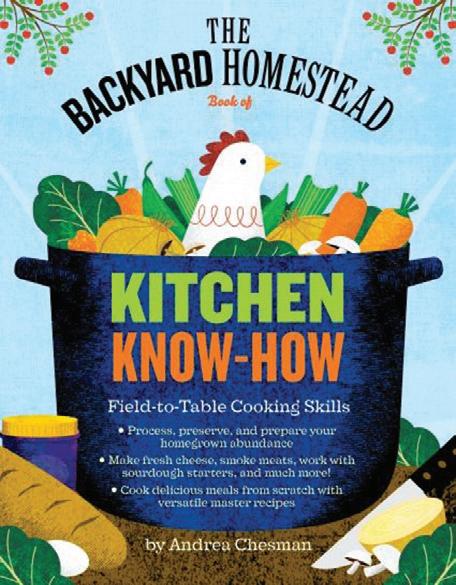
Andrea Chesman shows you how to bridge the gap between field and table, covering everything from curing meats and making sausage to canning fruits and vegetables, milling flour, working with sourdough, baking no-knead breads, making braises and stews that can be adapted to different cuts of meat, rendering lard and tallow, pickling, making butter and cheese, making yogurt, blanching vegetables for the freezer, making jams and jellies, drying produce, and much more.
Andrea Chesman shows you how to bridge the gap between field and table, covering everything from curing meats and making sausage to canning fruits and vegetables, milling flour, working with sourdough, baking no-knead breads, making braises and stews that can be adapted to different cuts of meat, rendering lard and tallow, pickling, making butter and cheese, making yogurt, blanching vegetables for the freezer, making jams and jellies, drying produce, and much more.
#7604 $19.95 Member: $16.96
#7604 $19.95 Member: $16.96
FERMENT
FERMENT

10-TRAY DIGITAL DEHYDRATOR
10-TRAY DIGITAL DEHYDRATOR
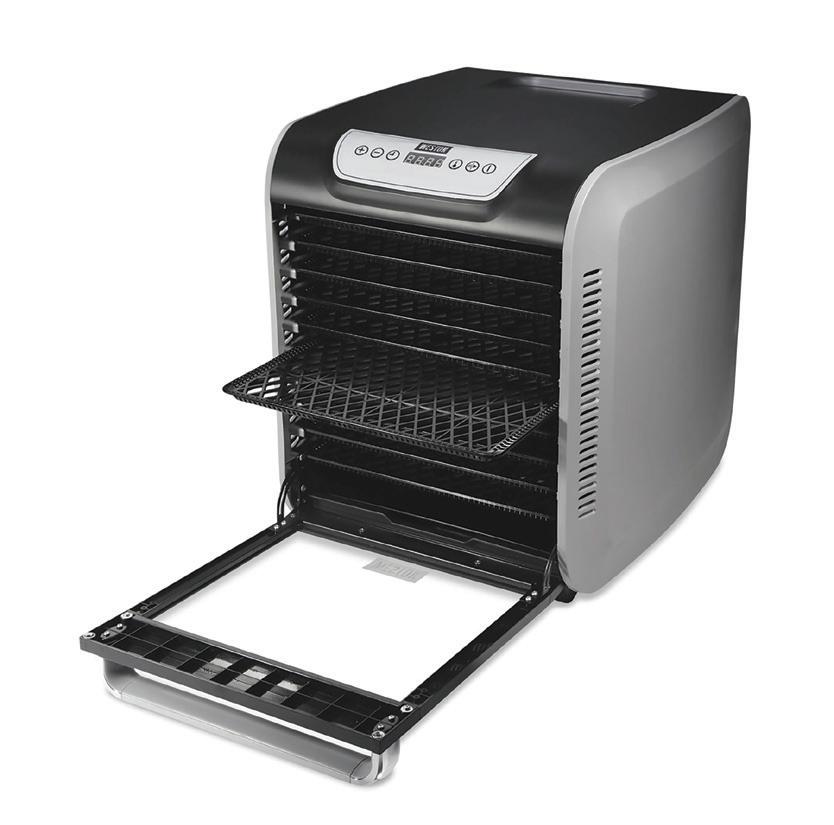

The Weston® 10-Tray Digital Food Dehydrator with Oven-Style Door has up to 10.3 sq. ft. of drying space for making pounds of delicious healthy snacks and preserving more food at once. This innovative food dehydrator is perfect for precision drying with fully adjustable temperatures from 90º to 160º F. You can dry a broad range of foods at the ideal temperature, including herbs, jerky, fruit leather, kale chips, and more, without extra sugar or additives.
The Weston® 10-Tray Digital Food Dehydrator with Oven-Style Door has up to 10.3 sq. ft. of drying space for making pounds of delicious healthy snacks and preserving more food at once. This innovative food dehydrator is perfect for precision drying with fully adjustable temperatures from 90º to 160º F. You can dry a broad range of foods at the ideal temperature, including herbs, jerky, fruit leather, kale chips, and more, without extra sugar or additives.
#11776 $259.99 Member:
#11776 $259.99 Member: $239.99
What does your favorite farmhouse cheese have in common with crusty sourdough bread, a glass of sparkling home-brewed kombucha, or a bowl of pickled beets? The answer is each is a product of fermentation, a process that harnesses good bacteria to preserve ingredients and transform them into uniquely delicious foods and drinks with remarkable health benefits: good for the gut, beautiful skin, increased energy, and more. This inspiring resource contains more than 100 photographs, plus plenty of helpful how-tos and informational charts offering guidance on incorporating fermented ingredients into the diet.
What does your favorite farmhouse cheese have in common with crusty sourdough bread, a glass of sparkling home-brewed kombucha, or a bowl of pickled beets? The answer is each is a product of fermentation, a process that harnesses good bacteria to preserve ingredients and transform them into uniquely delicious foods and drinks with remarkable health benefits: good for the gut, beautiful skin, increased energy, and more. This inspiring resource contains more than 100 photographs, plus plenty of helpful how-tos and informational charts offering guidance on incorporating fermented ingredients into the diet.
#9408 $29.95 Member: $25.46
#9408 $29.95 Member: $25.46
THE FAT KITCHEN
THE FAT KITCHEN

The Fat Kitchen is the comprehensive guide to rendering and using whole animal fats, including lard, tallow, and poultry fat. Cooks will learn the distinctive qualities and best uses of each fat along with methods for curing and storing them. In addition, 100 scrumptious recipes highlight traditional cultural favorites like matzo ball soup, pasta carbonara, pork tamales, roast beef with Yorkshire pudding, Southern-style collards, confit chicken, New England baked beans, and jelly doughnuts.
The Fat Kitchen is the comprehensive guide to rendering and using whole animal fats, including lard, tallow, and poultry fat. Cooks will learn the distinctive qualities and best uses of each fat along with methods for curing and storing them. In addition, 100 scrumptious recipes highlight traditional cultural favorites like matzo ball soup, pasta carbonara, pork tamales, roast beef with Yorkshire pudding, Southern-style collards, confit chicken, New England baked beans, and jelly doughnuts.
#9101 $24.95 Member: $19.96
#9101 $24.95 Member: $19.96
www.Grit.com 67 OR VISIT: Store.Grit.com Mention Promo Code: MGRPANZB SALE ENDS 4/18/23
BEST SELLER! NEW OR VISIT: Store.Grit.com Mention Promo Code: MGRPANZB SALE ENDS 4/18/23
NEW ITEM!
BEST SELLER!
THE NUTRIENT-DENSE KITCHEN
THE NUTRIENT-DENSE KITCHEN

In The Nutrient-Dense Kitchen, Mickey Trescott teaches you everything you need to know about eating like a “nutrivore.” You’ll start with a comprehensive tour of nutrients that are essential for both optimal health and deep healing, with handy charts to help you identify which foods contain them in varying amounts. You’ll also get an overview of autoimmune protocol diet details, some creative ideas for affordably sourcing the highest-quality and most nutrient-dense ingredients, and tips for setting up your kitchen to cook whole foods. The centerpiece of the book is Trescott’s impressive collection of flavorful, approachable recipes that comply with the strictest phase of the autoimmune protocol: no grains, legumes, eggs, dairy, nuts, seeds, or nightshades.
In The Nutrient-Dense Kitchen, Mickey Trescott teaches you everything you need to know about eating like a “nutrivore.” You’ll start with a comprehensive tour of nutrients that are essential for both optimal health and deep healing, with handy charts to help you identify which foods contain them in varying amounts. You’ll also get an overview of autoimmune protocol diet details, some creative ideas for affordably sourcing the highest-quality and most nutrient-dense ingredients, and tips for setting up your kitchen to cook whole foods. The centerpiece of the book is Trescott’s impressive collection of flavorful, approachable recipes that comply with the strictest phase of the autoimmune protocol: no grains, legumes, eggs, dairy, nuts, seeds, or nightshades.
#9581 $39.95 Member: $33.96
#9581 $39.95 Member: $33.96
FOOD 52 MIGHTY SALADS
FOOD 52 MIGHTY SALADS

METALWORKING
METALWORKING
With more than 2,000 black–and–white illustrations and clear, practical instructions given by expert handyman and blacksmith Paul N. Hasluck, Metalworking offers everything you need to know to turn a chunk of metal into a useful and well–crafted product. Included here is information on working sheet metals, gold, and silver; building a dynamo and electric motor; making a vertical steam engine; and more!
With more than 2,000 black–and–white illustrations and clear, practical instructions given by expert handyman and blacksmith Paul N. Hasluck, Metalworking offers everything you need to know to turn a chunk of metal into a useful and well–crafted product. Included here is information on working sheet metals, gold, and silver; building a dynamo and electric motor; making a vertical steam engine; and more!

#5453 $17.95 Member: $15.26
#5453 $17.95 Member: $15.26
BEE HOTEL
BEE HOTEL
In Bee Hotel, you’ll discover what wild bees and others need the most, and how you can provide it by building them a home. From a ‘one-hour hotel’ to a true ‘romantic retreat’, here you’ll find numerous ideas for creating insect dwellings, whether you live in an apartment with a balcony, a townhouse with a terrace, or a suburban or countryside garden. With step-by-step instructions, material checklists, and exact dimensions for the individual parts, you can get started straight away.
In Bee Hotel, you’ll discover what wild bees and others need the most, and how you can provide it by building them a home. From a ‘one-hour hotel’ to a true ‘romantic retreat’, here you’ll find numerous ideas for creating insect dwellings, whether you live in an apartment with a balcony, a townhouse with a terrace, or a suburban or countryside garden. With step-by-step instructions, material checklists, and exact dimensions for the individual parts, you can get started straight away.
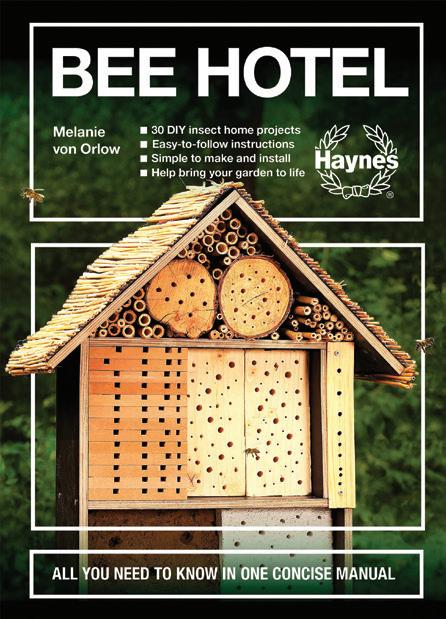
#11819 $16.95 Member: $14.41
#11819 $16.95 Member: $14.41
NEW ITEM!
BEEKEEPING FOR BEGINNERS
BEEKEEPING FOR BEGINNERS
With this absolute beginner’s guide, learn how to set up your backyard hives, select and raise bees, and harvest honey, with the bonus of bringing pollinators to your yard and garden. Renowned beekeeping expert Kim Flottum shares his vast knowledge from years of teaching beekeeping to all levels of enthusiasts for a no-fail approach to bringing a productive bee colony onto your property.
With this absolute beginner’s guide, learn how to set up your backyard hives, select and raise bees, and harvest honey, with the bonus of bringing pollinators to your yard and garden. Renowned beekeeping expert Kim Flottum shares his vast knowledge from years of teaching beekeeping to all levels of enthusiasts for a no-fail approach to bringing a productive bee colony onto your property.
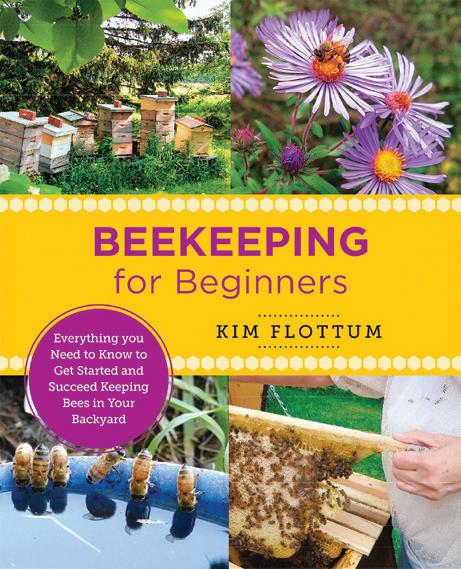
#11793 $14.99 Member: $12.74
#11793 $14.99 Member: $12.74
A collection of 60 recipes for turning ordinary salads into one-dish-worthy meals. Does anybody need a recipe to make a salad? Of course not. But if you want your salad to hold strong in your lunch bag or carry the day as a one-bowl dinner, dressing on lettuce isn’t going to cut it. It’s comforting food made captivating by simply charring one ingredient or marinating another — shaving some or roasting a bunch.
A collection of 60 recipes for turning ordinary salads into one-dish-worthy meals. Does anybody need a recipe to make a salad? Of course not. But if you want your salad to hold strong in your lunch bag or carry the day as a one-bowl dinner, dressing on lettuce isn’t going to cut it. It’s comforting food made captivating by simply charring one ingredient or marinating another — shaving some or roasting a bunch.
#8564 $22.99 Member: $19.54
#8564 $22.99 Member: $19.54
WELDING FOR BEGINNERS
WELDING FOR BEGINNERS

If you are inexperienced and want to start out strong — whether working in a home workshop, school workshop, blacksmith shop, or auto shop — this is the perfect reference. The projects illustrate the basic foundation techniques that every welder needs to know while also helping you tackle problems and fix mistakes as well as shortcuts and level-ups. Photographs and illustrations teach welding, and clear, concise, easy-to-read text takes all the confusion out of the learning processes.
If you are inexperienced and want to start out strong — whether working in a home workshop, school workshop, blacksmith shop, or auto shop — this is the perfect reference. The projects illustrate the basic foundation techniques that every welder needs to know while also helping you tackle problems and fix mistakes as well as shortcuts and level-ups. Photographs and illustrations teach welding, and clear, concise, easy-to-read text takes all the confusion out of the learning processes.
#11797 $16.99 Member: $14.44
#11797 $16.99 Member: $14.44
THE ENCYCLOPEDIA OF COUNTRY LIVING, 50TH ANNIVERSARY EDITION
THE ENCYCLOPEDIA OF COUNTRY LIVING, 50TH ANNIVERSARY EDITION
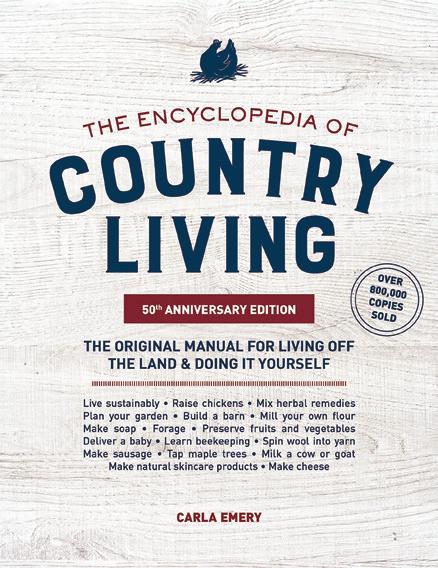
For more than 50 years, this homesteading classic is the essential book of basic skills and country wisdom for living off the land, being prepared, and doing it yourself. From homesteaders to urban farmers, and everyone in between, there is a desire for a simpler way of life: a healthier, greener, more self-sustaining, and holistic approach that allows you to survive and thrive — even in uncertain times.
For more than 50 years, this homesteading classic is the essential book of basic skills and country wisdom for living off the land, being prepared, and doing it yourself. From homesteaders to urban farmers, and everyone in between, there is a desire for a simpler way of life: a healthier, greener, more self-sustaining, and holistic approach that allows you to survive and thrive — even in uncertain times.
#11834 $29.95 Member: $25.46
#11834 $29.95 Member: $25.46
BUILDING YOUR PERMACULTURE PROPERTY
BUILDING YOUR PERMACULTURE PROPERTY
Building Your Permaculture Property is the essential guide for everyone looking to cut through the noise and establish an ecologically regenerative, financially sustainable, enjoyable, and thriving permaculture property anywhere in the world.
Building Your Permaculture Property is the essential guide for everyone looking to cut through the noise and establish an ecologically regenerative, financially sustainable, enjoyable, and thriving permaculture property anywhere in the world.

#10828 $49.99 Member: $42.49
#10828 $49.99 Member: $42.49
TO ORDER, CALL TOLL-FREE: 866-803-7096 (OUTSIDE U.S. AND FOR CUSTOMER SERVICE: CALL 785-274-4365)
TO ORDER, CALL TOLL-FREE: 866-803-7096 (OUTSIDE U.S. AND FOR CUSTOMER SERVICE: CALL 785-274-4365)
March/April 2023 68 BEST SELLER!
NEW ITEM! NEW ITEM! NEW ITEM! NEW ITEM! BEST SELLER!
NEW ITEM! NEW ITEM!
NEW ITEM!
E-CLOTH HIGH-PERFORMANCE DUSTING GLOVE
E-CLOTH HIGH-PERFORMANCE DUSTING GLOVE

Take dusting into your own hands with the E-Cloth High-Performance Dusting Glove. It picks up dust, pollen, pet hair, and more from places handheld dusters can’t reach. Slip it on to clean window blinds, cabinets, furniture legs, picture frames — any surface you can get your fingers on. Extralong microfibers — 1000x finer than cotton — grab and hold dust until you rinse them out.
Take dusting into your own hands with the E-Cloth High-Performance Dusting Glove. It picks up dust, pollen, pet hair, and more from places handheld dusters can’t reach. Slip it on to clean window blinds, cabinets, furniture legs, picture frames — any surface you can get your fingers on. Extralong microfibers — 1000x finer than cotton — grab and hold dust until you rinse them out.
#10665 $14.99 Member: $13.99
#10665 $14.99 Member: $13.99
E-CLOTH DEEP CLEAN MOP & DUST MOP HEAD SET
E-CLOTH DEEP CLEAN MOP & DUST MOP HEAD SET
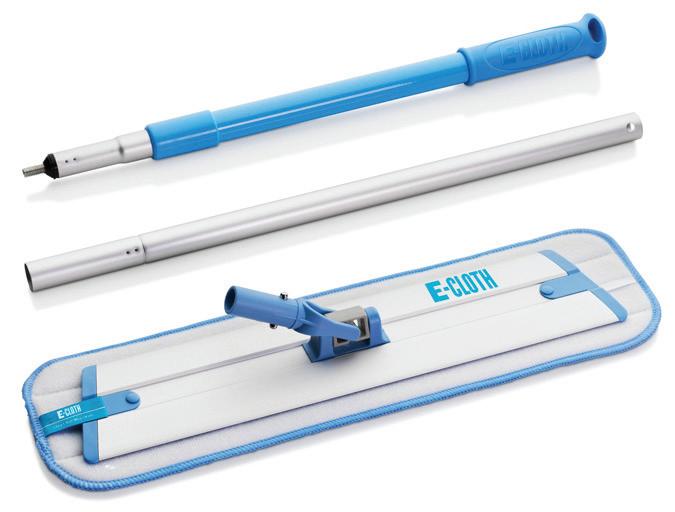
The E-Cloth Dust Mop Head attaches to the Deep Clean Mop to strip grease, grime, dirt, and over 99% of bacteria from all types of hard flooring. Wood, tile, or laminate, this mop cleans and protects your investment — using just water. There’s no need to add additional cleaners — or worry about crawling kiddos and curious pets.
The E-Cloth Dust Mop Head attaches to the Deep Clean Mop to strip grease, grime, dirt, and over 99% of bacteria from all types of hard flooring. Wood, tile, or laminate, this mop cleans and protects your investment — using just water. There’s no need to add additional cleaners — or worry about crawling kiddos and curious pets.
#11703 $53.98 Member: $46.95
#11703 $53.98 Member: $46.95
THE COMPLETE GUIDE TO SLEEP CARE
THE COMPLETE GUIDE TO SLEEP CARE



Scientific studies have shown that getting good sleep improves every area of our lives, giving us more energy, increased cognitive function, and better moods all day long. This book will help you understand the importance of sleep, overcome stressful experiences, conquer negative emotions, develop positive thinking, and cultivate a healthy lifestyle.
Scientific studies have shown that getting good sleep improves every area of our lives, giving us more energy, increased cognitive function, and better moods all day long. This book will help you understand the importance of sleep, overcome stressful experiences, conquer negative emotions, develop positive thinking, and cultivate a healthy lifestyle.
#11815 $16.99 Member: $14.44
#11815 $16.99 Member: $14.44
ECO KIDS SELF-SUFFICIENCY HANDBOOK
ECO KIDS SELF-SUFFICIENCY HANDBOOK



By cleverly combining creativity with ecoawareness, this timely book encourages children aged 7-14 to put down their mobile devices and get involved. From building a wind turbine and a go-kart to creating light, growing vegetables, and making green gifts, Eco Kids Self-Sufficiency Handbook offers a wide range of ways to capture the imagination and positively contribute to the world around us.
By cleverly combining creativity with ecoawareness, this timely book encourages children aged 7-14 to put down their mobile devices and get involved. From building a wind turbine and a go-kart to creating light, growing vegetables, and making green gifts, Eco Kids Self-Sufficiency Handbook offers a wide range of ways to capture the imagination and positively contribute to the world around us.
#11871 $14.99 Member: $12.74
#11871 $14.99 Member: $12.74
201 EVERYDAY USES FOR SALT, LEMONS, VINEGAR AND BAKING SODA


201 EVERYDAY USES FOR SALT, LEMONS, VINEGAR AND BAKING

Save money on home cleaning products with 201 natural cleaning solutions that use four simple, versatile, and inexpensive ingredients: salt, lemon, vinegar, baking soda, and olive oil. This is an essential reference for anyone interested in thrifty, natural, and sustainable living!
Save money on home cleaning products with 201 natural cleaning solutions that use four simple, versatile, and inexpensive ingredients: salt, lemon, vinegar, baking soda, and olive oil. This is an essential reference for anyone interested in thrifty, natural, and sustainable living!
#11840 $19.95 Member: $16.96
#11840 $19.95 Member: $16.96
STARTER COOPS
STARTER COOPS
A full-color introductory guide to providing a flock of chickens with their very own digs, Starter Coops addresses the needs of every chicken owner, analyzing what kind of accommodations will best serve the ladies’ needs. Author and chicken enthusiast Wendy Bedwell-Wilson offers commonsense advice and money-saving tips to get new chicken keepers off to the right start.
A full-color introductory guide to providing a flock of chickens with their very own digs, Starter Coops addresses the needs of every chicken owner, analyzing what kind of accommodations will best serve the ladies’ needs. Author and chicken enthusiast Wendy Bedwell-Wilson offers commonsense advice and money-saving tips to get new chicken keepers off to the right start.
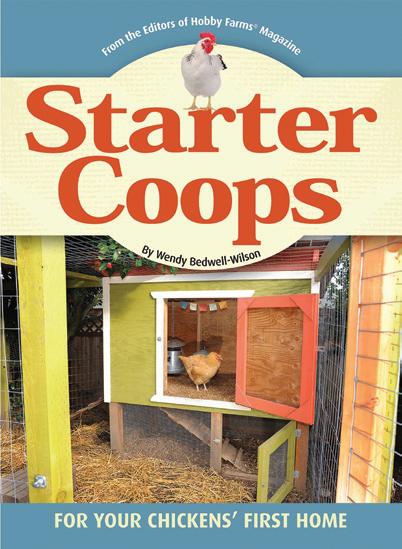
#11858 $14.95 Member: $12.71
#11858 $14.95 Member: $12.71
HOMEMADE FOR SALE
HOMEMADE FOR SALE
Follow your dream to launch a food business from your home and join the booming movement of food entrepreneurs. Fully updated and expanded, Homemade for Sale, Second Edition is the authoritative guide to launching a successful food enterprise from your kitchen. It covers everything you need to get cooking for your customers, providing a clear road map to go from ideas and recipes to owning a food business.
Follow your dream to launch a food business from your home and join the booming movement of food entrepreneurs. Fully updated and expanded, Homemade for Sale, Second Edition is the authoritative guide to launching a successful food enterprise from your kitchen. It covers everything you need to get cooking for your customers, providing a clear road map to go from ideas and recipes to owning a food business.

#11867 $34.99 Member: $29.74
#11867 $34.99 Member: $29.74
THE NEW 5-GALLON BUCKET BOOK
THE NEW 5-GALLON BUCKET BOOK







Five-gallon buckets are ubiquitous and cheap (or even free). They are right up there with some of the man’s best inventions, like the wheel and sliced bread. Sure, they can be useful on their own, holding stuff or transporting stuff from place to place. But that’s no fun. Put them to use around the house, garden, or farm instead! With common tools and the instructions in this book, you’ll find 60+ ideas and projects to make today.
Five-gallon buckets are ubiquitous and cheap (or even free). They are right up there with some of the man’s best inventions, like the wheel and sliced bread. Sure, they can be useful on their own, holding stuff or transporting stuff from place to place. But that’s no fun. Put them to use around the house, garden, or farm instead! With common tools and the instructions in this book, you’ll find 60+ ideas and projects to make today.
#11870 $24.99 Member: $21.24
#11870 $24.99 Member: $21.24
THE COMPLETE GUIDE TO TREEHOUSES
THE COMPLETE GUIDE TO TREEHOUSES
This third edition of BLACK+DECKER The Complete Guide to Treehouses covers every aspect of treehouse building, from choosing a tree and safety considerations to adding interior furniture and even a zip line. Featuring extended building techniques in step-by-step photo-illustrated instruction.
This third edition of BLACK+DECKER The Complete Guide to Treehouses covers every aspect of treehouse building, from choosing a tree and safety considerations to adding interior furniture and even a zip line. Featuring extended building techniques in step-by-step photo-illustrated instruction.


#11818 $27.99 Member: $23.79
#11818 $27.99 Member: $23.79
TINY HOUSE DESIGN & CONSTRUCTION GUIDE
TINY HOUSE DESIGN & CONSTRUCTION GUIDE


Take the first step toward achieving the dream of building and living in your very own tiny house! This guide is your road map for the entire building process. This latest edition contains twice as much content and 38 additional images and illustrations. The framing, electrical, and plumbing sections have all been greatly expanded.
Take the first step toward achieving the dream of building and living in your very own tiny house! This guide is your road map for the entire building process. This latest edition contains twice as much content and 38 additional images and illustrations. The framing, electrical, and plumbing sections have all been greatly expanded.

#11817 $24.95 Member: $21.21
#11817 $24.95 Member: $21.21
www.Grit.com 69 OR VISIT: Store.Grit.com Mention Promo Code: MGRPANZB SALE ENDS 4/18/23
BEST SELLER! NEW ITEM! NEW ITEM! NEW ITEM! NEW ITEM! NEW ITEM! NEW ITEM! NEW ITEM! OR VISIT: Store.Grit.com Mention Promo Code: MGRPANZB SALE ENDS 4/18/23
SODA
BEST SELLER! NEW ITEM! NEW ITEM! NEW ITEM! NEW ITEM! NEW ITEM! NEW ITEM! NEW ITEM!
MAKING DECISIONS ABOUT DisbuddingDespurring&
Knowing when or if you should disbud or despur your animals isn’t always easy.
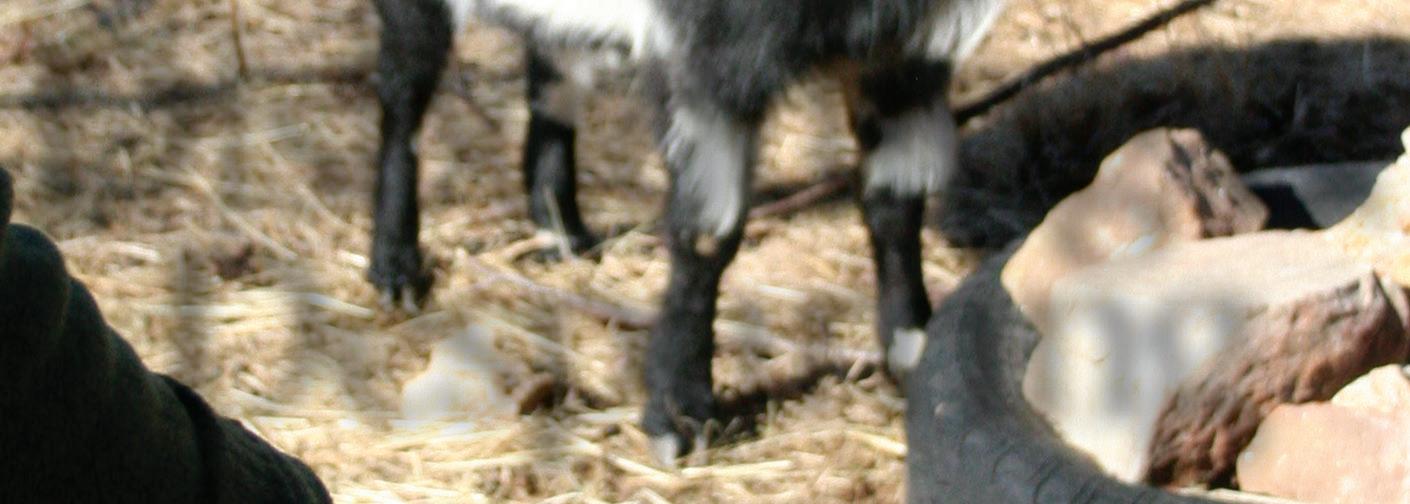
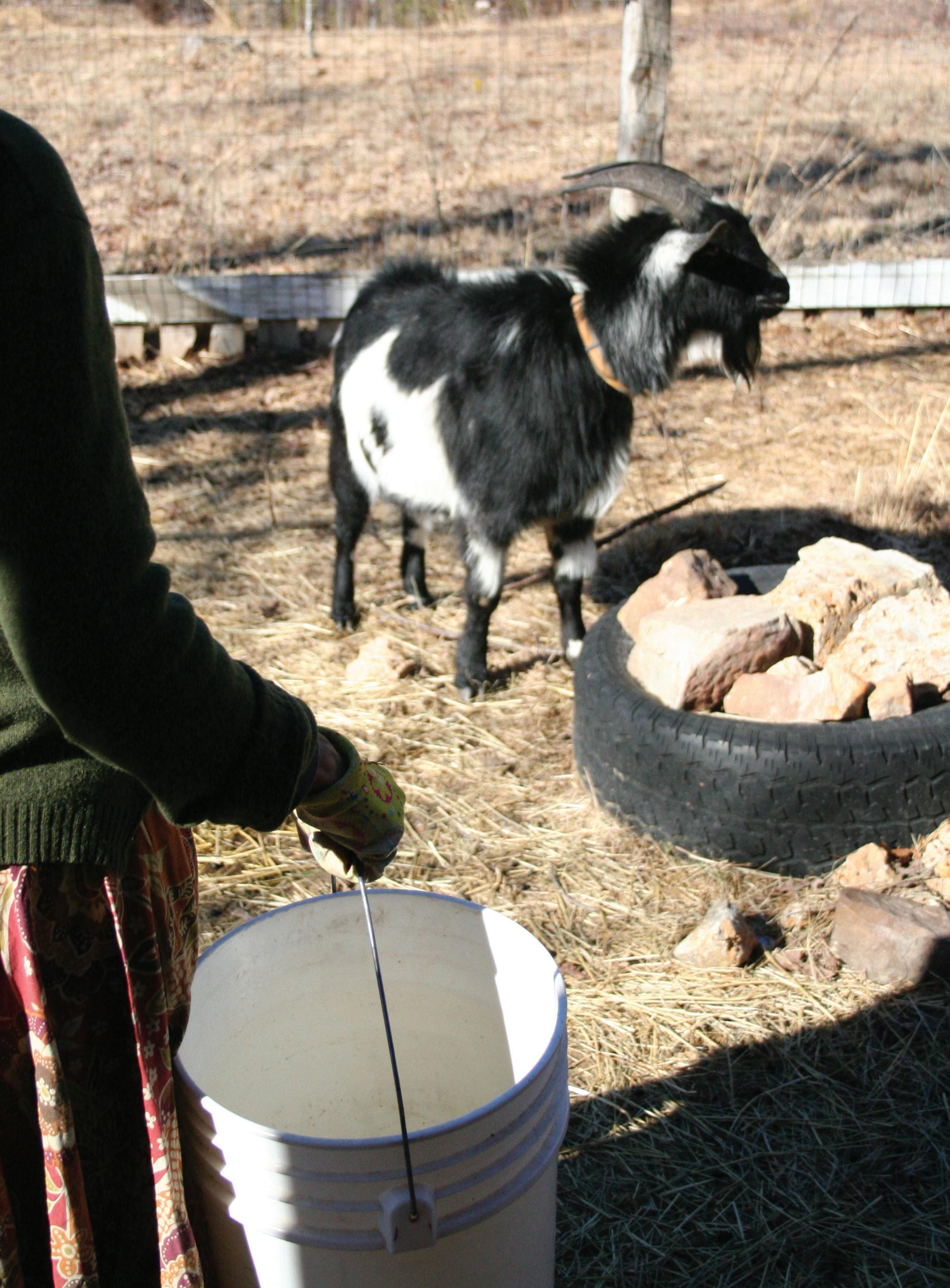
March/April 2023 70
Story and Photos By Wren Everett
Delve
into the literature concerning the care and keeping of livestock, and you’ll soon start reading through chapters on removing parts of them deemed problematic, such as spurs on roosters and horns on goats. When I was new to my back-to-the-land life, preparing for my rst animals, I took these admonitions seriously as the “of cial” path to follow.
But now that I’ve spent years with my own ocks and small herds, I understand there are far more choices than the single course recommended in the conventional literature. Every farm, homestead, and backyard has a different set of beliefs, animals, and infrastructure. The best course of action for the people and animals involved may not be the same from one place to the next.
Now, I confess I’m biased toward leaving my animals intact: I don’t disbud or despur. I do understand, however, that sometimes it’s in the best interest of the humans or animals involved to remove potential threats. My goal with this article, therefore, isn’t to convince you one choice is better than the other, but to present a variety of information in the hopes you’ll nd the practices that t your personal philosophy and animal management.

Disbudding
Disbudding is the process of removing a young goat’s horns before they have fully formed. (This is different from dehorning, which is the rather traumatic removal of an adult goat’s horns.) Disbudding is usually performed when kids are between 1 and 2 weeks of age.
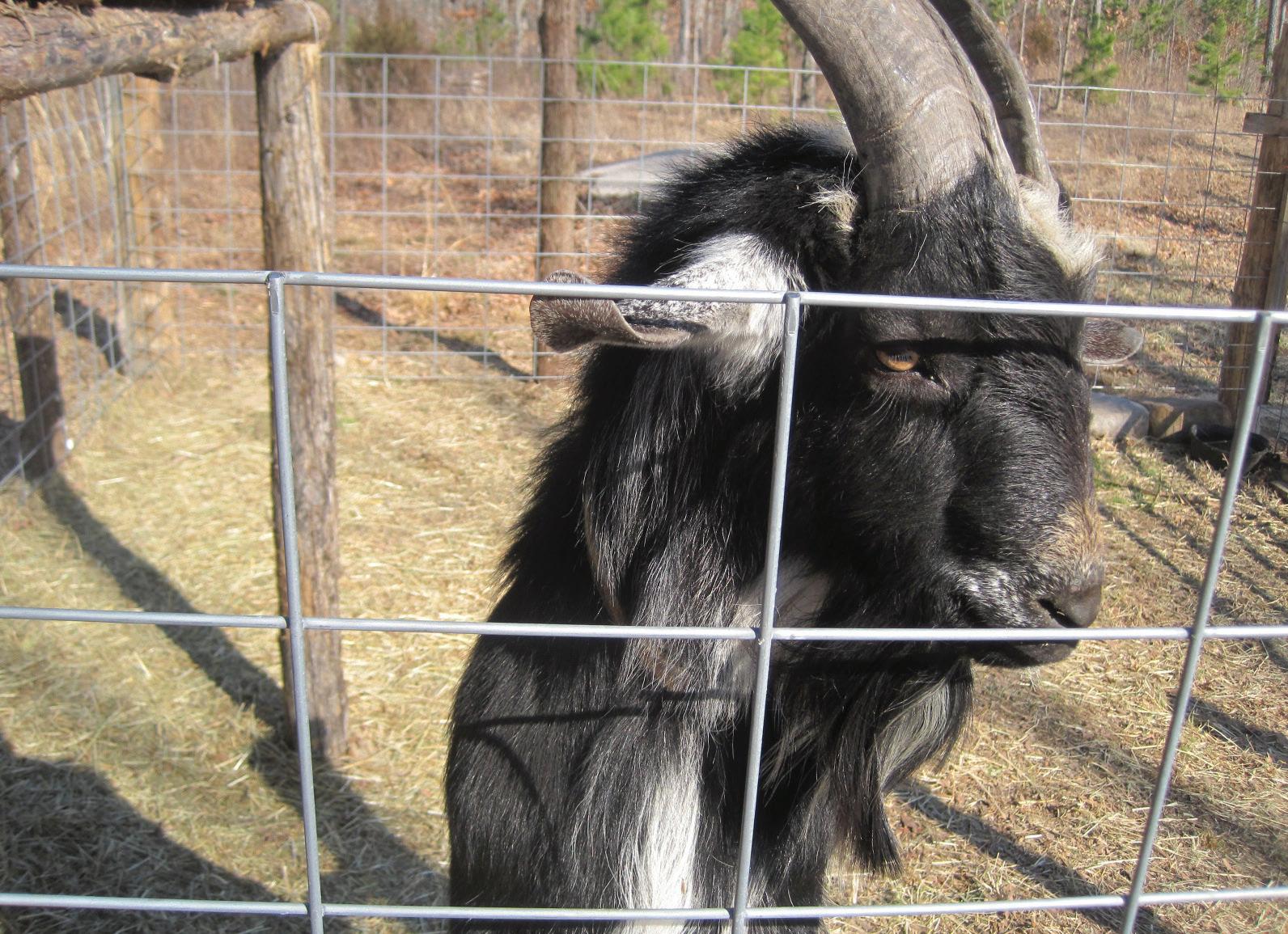
On a typical farm, a disbudding iron is most commonly employed. Though the speci cs are beyond this article, it involves placing the young kid in a restraining box, placing a red-hot disbudding iron around the forming horn buds, and cauterizing the growth cells. When done successfully, the growth cells should die off and the kid’s head will heal, covered by a smooth layer of hair, sans horns.

The advantages of disbudding are many. Hornless goats are deemed less of a threat to their keepers, their environment, and other goats. Though goats will always butt, without their weapons, the butts are a lot less harmful. Hornless goats are also less likely to get their heads stuck in their fencing. (I’d say unlikely, but anyone who has goats knows that the silly things often get themselves in inexplicable situations.)
The downsides of disbudding, however, though not often discussed, are also many. Disbudding isn’t always a successful










You work hard on your homestead and we work just as hard to help you keep the animals in your herd or flock healthy. See our full line of award-winning products at vetericyn.com or your local animal supply store.


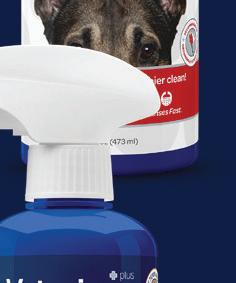
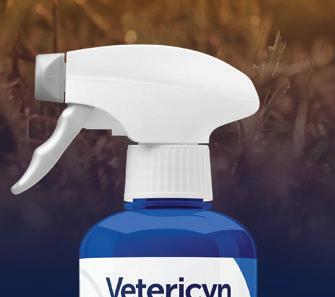

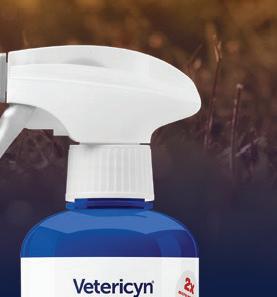



www.Grit.com 71
VETERICYN®
AS
Made in the USA | vetericyn.com
See #9 on page 60
When it comes to removing body parts, make the choice that’s right for you, your animals, and your farm.
WORKS
HARD AS YOU DO.
process. Sometimes, a handful of growth cells survive, resulting in strange, malformed horn-like projections called scurs. While scurs can be loose enough simply to fall off on their own, sometimes they cause problems. They can grow in erratic shapes, often curling down toward the goat’s skull or eye. If left unchecked, they can cause serious damage to the animal. Because of this, they require routine maintenance.
Disbudding also removes an essential part of a goat’s head. Some folks argue that goats are meant to have their horns just as much as their eyes, hooves, and tails. The horns are used to establish social ranking,
defend against predators, scratch hard-toreach places, and provide an important element of a goat’s thermoregulation. Lined with blood vessels, the horns allow goats to cool their blood more effectively on the worst of summer days.
Finally, disbudding takes away a handle that may help you maneuver the animal more safely. Though you shouldn’t pick up any animal by its horns, I must admit, when transporting an ornery buck or scared doe, having an extra “thing” to grab has its benefits in keeping animals in place.
Deciding What to Do with Your Goats’ Horns
First, decide if they’re problematic. If you have established fencing that horned goats are constantly getting caught in but lack the resources to make the fencing more goat-appropriate, perhaps disbudding new arrivals to your herd will prevent an unnecessary death. Or, if you have a lot of visiting children who come to your property perhaps school groups or other children who don’t have experience with farm animals —it may be less of a liability to have hornless goats.
However, if you’re just trying to raise a handful of goats for milk or meat and you have good, tight fences, you may find
disbudding the goats just doesn’t offer many benefits. This may be especially true if you reside in a hotter climate: Horned goats are less susceptible to heat stroke.
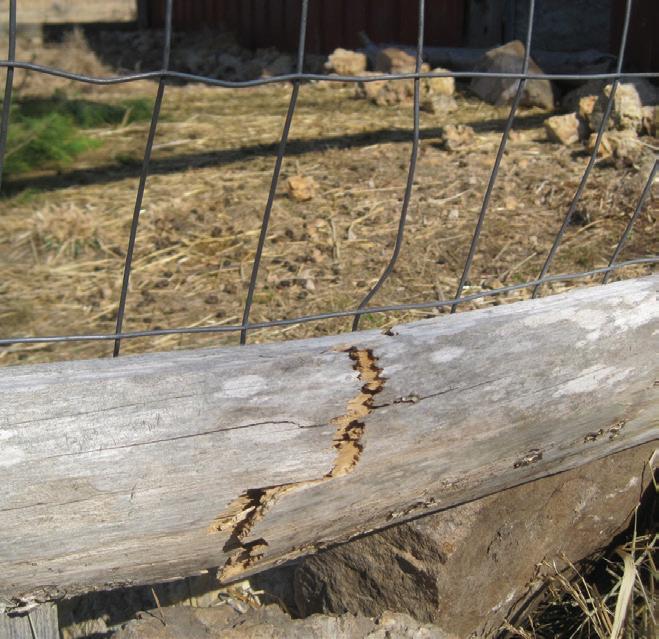
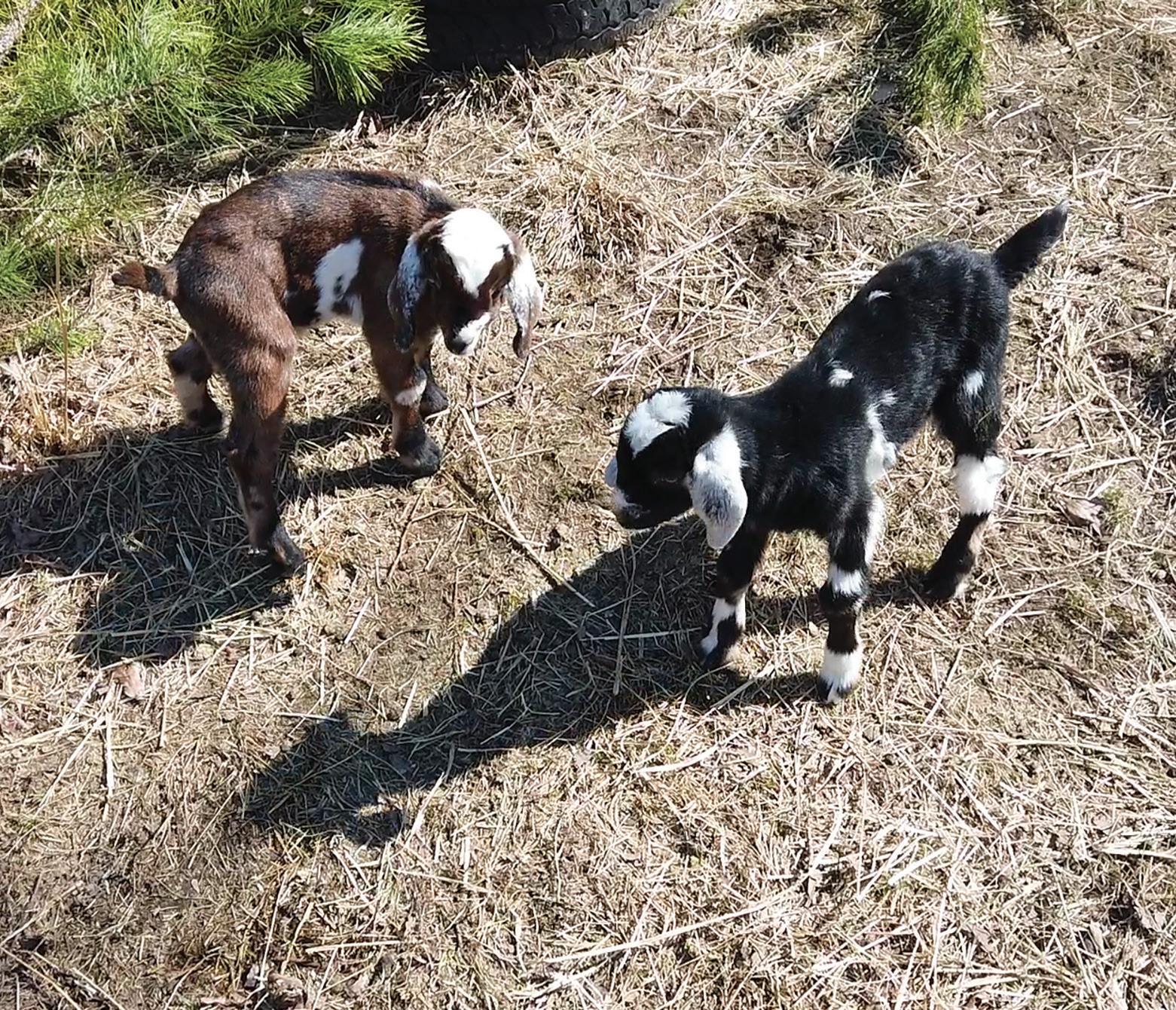
All that said, intact males are very aware they have a hammer for a head, and they will employ it to express their virility, frustration, desire to be with females, or impatience that you’ve brought feed 10 minutes later than usual.
Control horned males by building them a buck-strong enclosure that can put up with their constant “testing,” and by keeping a bucket of water with you whenever you move through their area. Any buck that tries to test you will be sent running when you throw water in his face.
Despurring
Roosters have been endowed with a specific tool for defending their flock and fighting off rivals: the spur. This hardened spike of keratin much like a giant toenail is reminiscent of the killing claw on a velociraptor. It’s perfectly angled on a rooster’s leg to impart a spiked attack on whoever or whatever a rooster kicks.
Though it will regrow like a fingernail, trimming a spur is a common way to control a rooster’s stabby potential. All despurring methods are best employed at night when the rooster is less active and alert. Some folks take a Dremel to it, rasping the spike down to a harmless blunt nubbin. The same can be achieved with a file and a bit more patience. Others will soften the spur with a hot potato, then take a set of pliers and twist the tip off. In all cases, care must be taken to protect the sensitive, blood-rich quick at the heart of the spur nicking it or leaving it exposed will cause pain, bleeding, and the opportunity for infection.
Permanent spur removal is beyond most laypeople. It can be done by a veterinarian, but it’s expensive and traumatic.
Despurring can offer peace of mind to folks with aggressive roosters. While it may seem funny to watch YouTube videos of folks being harassed by roos on the offense, there’s nothing funny about being stabbed in the calf by a mean chicken. People with pets and young children often
Two bucklings at disbudding age, which occurs when goats are between 1 and 2 weeks old.
March/April 2023 72
Bucks will use their heads to break weak fencing.
believe despurring is the best option to keep unsteady toddlers, unwary children, and playful dogs safe from an unexpected rooster rampage.

Sometimes, spurs need to be trimmed for the flock’s health, even if the rooster in question isn’t aggressive. The spur never stops growing. Older roosters may end up with long spurs that curl back toward their shanks and start to poke and burrow into their skin, causing pain and damage. In such a case, a seasonal spur-icure of the leading points will certainly alleviate the issue for the old fellow.
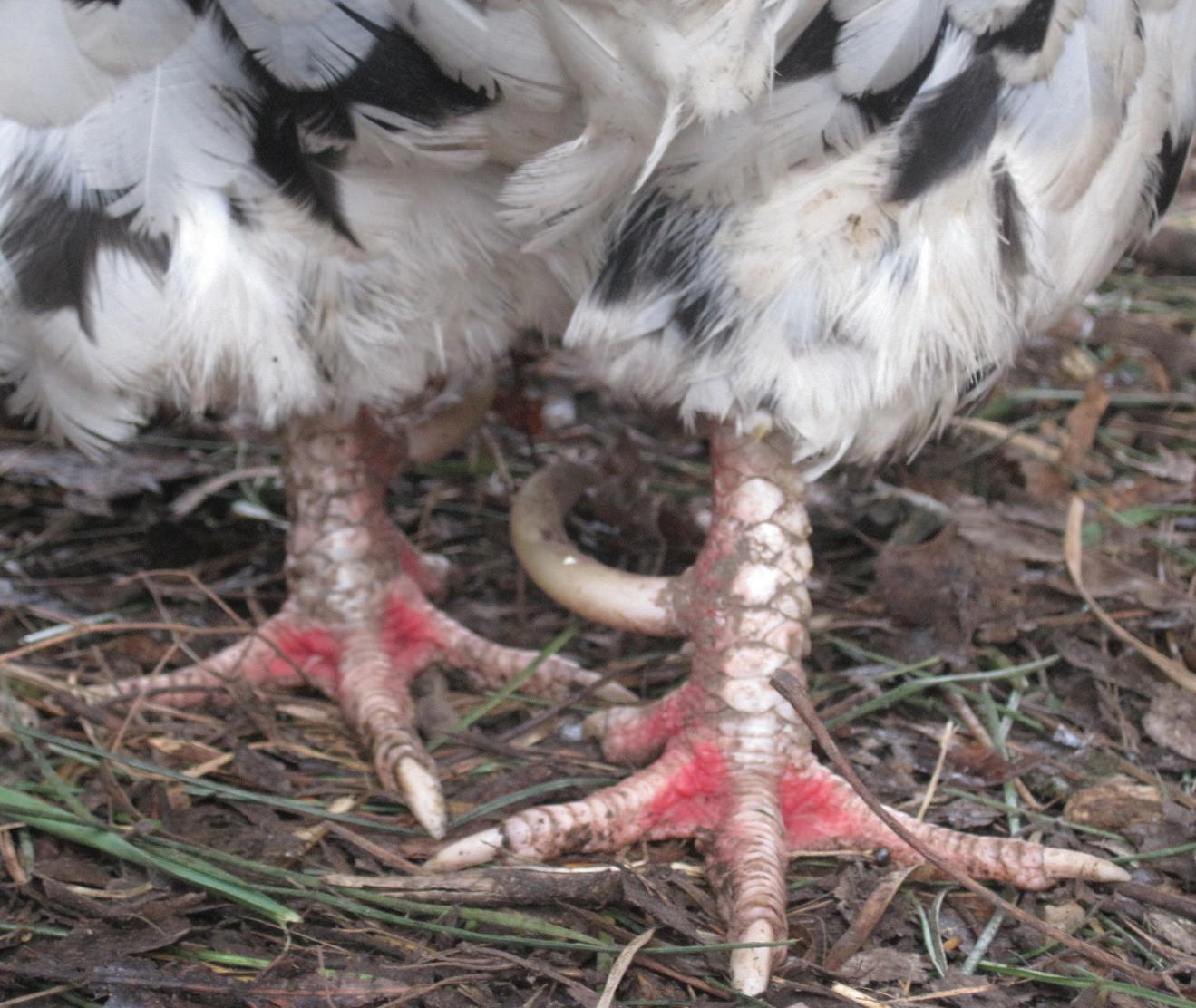
Another instance where a trim might be in order is in the spring when the roosters are crowing and mating with all their testosterone-flooded might. If you have a young, inexperienced male, or if you have too few hens for your rooster, the hens’ backs may be scratched by the rooster’s spurs. Remediate the situation by trimming spurs or outfitting any bare-backed hens with a special mating saddle for protection.
Despurring isn’t a cure-all. If you free-range your fowl, spur-less roosters have lost one of their biggest and best weapons against marauding foxes, raptors, and dogs. A spurred rooster offers all-day surveillance to protect your flock, and letting him keep his assets may help keep your hens safe.
Finally, despurring may keep some roosters around and creating offspring far longer than they should. Aggressive
behavior can be passed down, and a rooster with a nasty streak will likely produce chicks with the same belligerent personality. For backyard flock-keepers merely looking to produce eggs and meat for their family, mean roosters should end up in the stew pot rather than the despurring table.
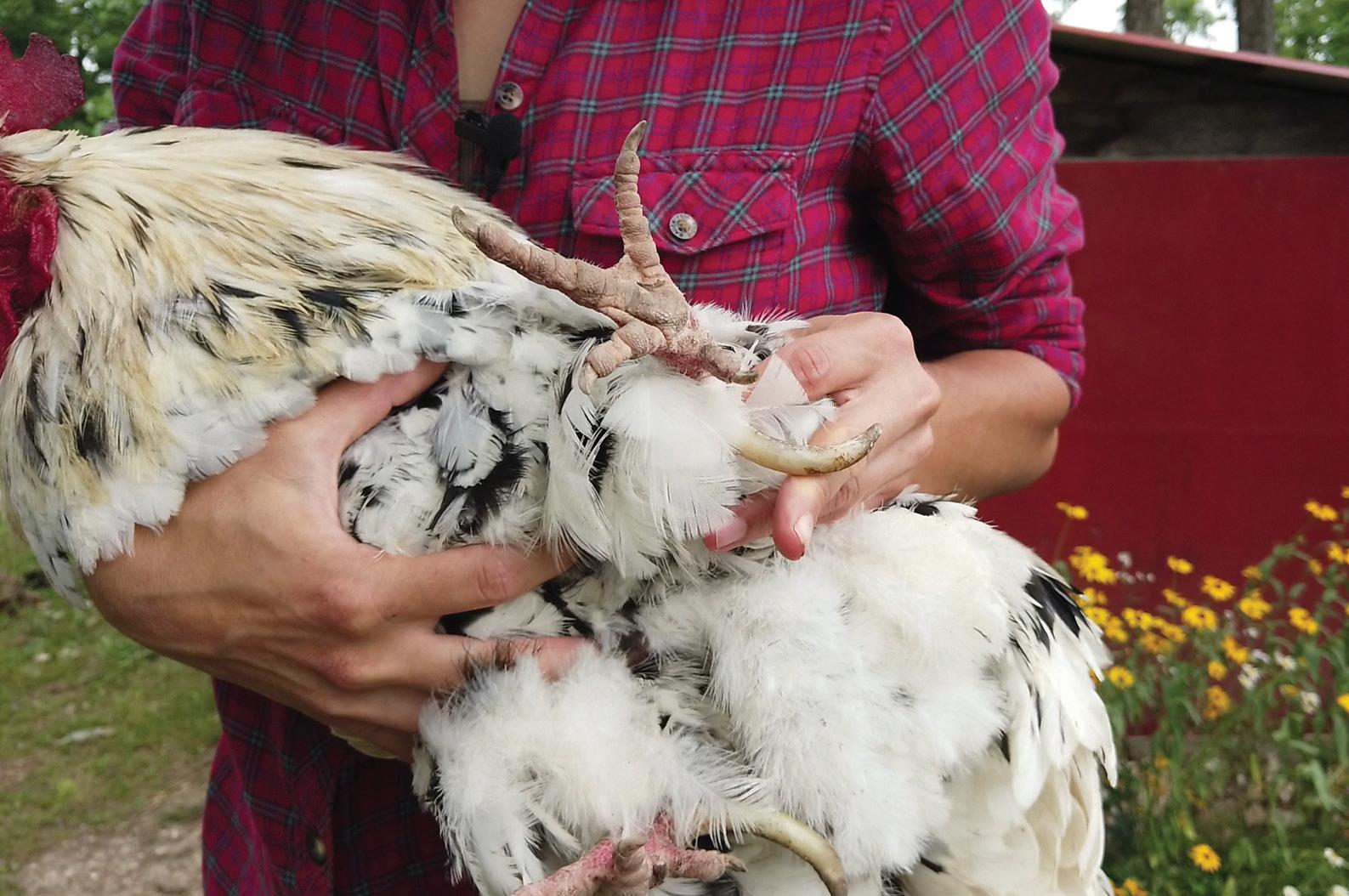
Deciding What to Do with Rooster Spurs
If you have a calm, younger rooster with enough hens to keep him busy (usually a 1-to-7 ratio is optimal), his spurs may not be an issue. In this situation, it’s perfectly fine to leave him alone to crow and strut in point-protruding peace.
In that case, treat your intact rooster with respect. Always remember that spurs emerge when a rooster feels threatened, so create an environment where your rooster doesn’t have to go on the defense. This includes making sure visitors to your coop especially children or friends’ dogs don’t tease the big guy.
It pays to understand rooster body language. A calm roo will pretty much ignore you and focus on his ladies. If he warily inspects you, bumps into you, or, worst of all, fluffs up his hackle feathers, you’ve done something he finds suspicious. Maybe your squeaky boots or your flappy raincoat are to blame. Don’t underestimate a simple-minded bird’s ability to turn something seemingly
innocuous into a scary, bring-out-thespurs threat.
Make the Choice That’s Best for You and Your Animals
When it comes to managing your flocks and herds, the list of decisions that need to be made is huge and often divisive. I hope this article gives you plenty of material to help you make an informed decision that’s the best fit for your land philosophies. If you find removing problematic pointy parts is what serves the animals and people on your land best, then make your decision with confidence and use the ample materials available in conventional literature. But on the flip side, if you’ve always been uncomfortable with the constant admonitions to cut bits off your birds and goats, know you can also leave your animals intact with confidence. It may require you to amend and adjust your habits to accommodate for your animals’ inherent roosterness and goatness, but learning the habits and quirks of your creatures is one of the quiet joys of keeping animals in the first place.
Wren and her husband left the city and its dependency and went back to the land in the Ozarks. Every year, they’re getting closer to their goal of getting entirely offgrid, being as self-sufficient as possible, and living happily as modern peasants.
www.Grit.com 73
Spurs, like fingernails, never stop growing. Knowing when or if you should despur your roo is important for your rooster’s and flock’s health as well as your own peace of mind.



















































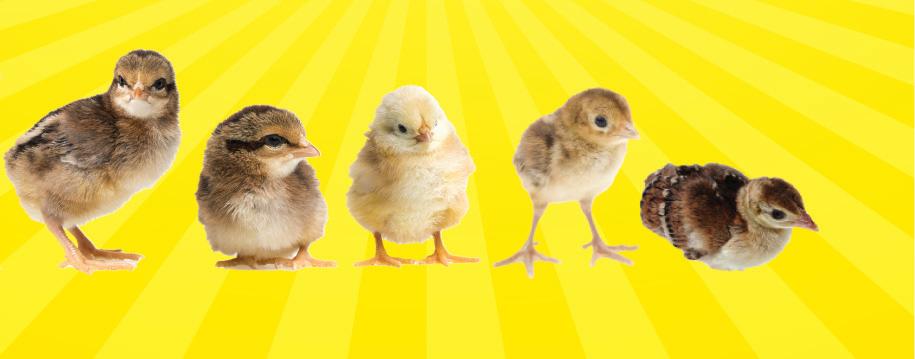











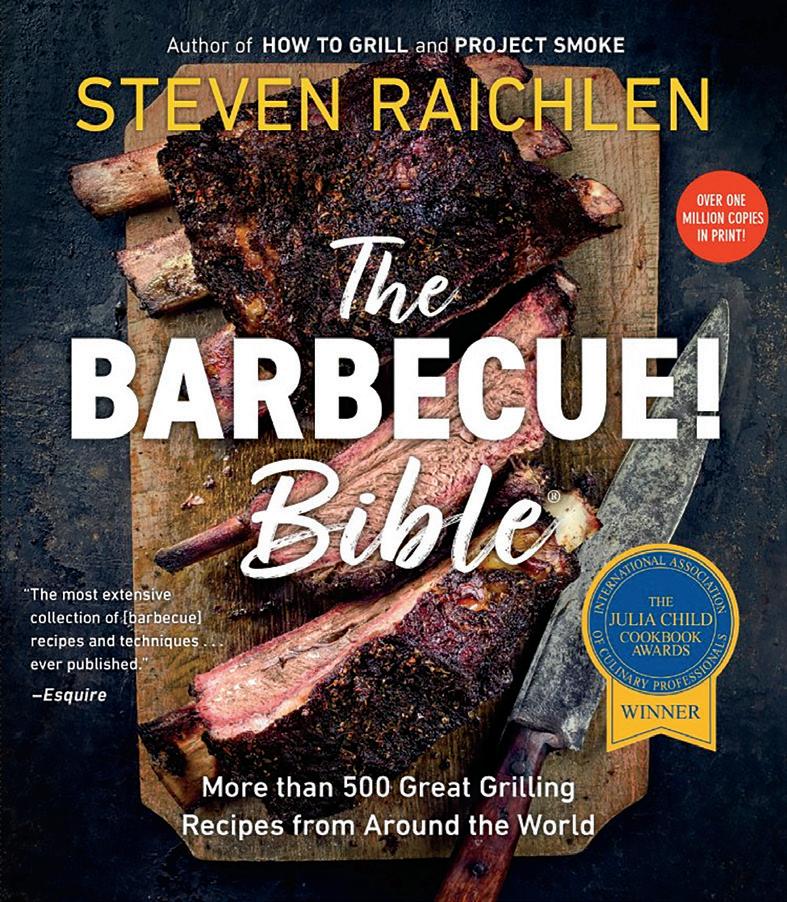
COLORED EGG LAYERS 20 BREED VARIETIES Request a Free CATALOG! BY MAIL, PHONE, EMAIL, OR ONLINE Follow us on Instagram Like us on Facebook Scan to download our app on Android or iOS today • Friendly Service • Four Generations of Experience • WHITE EGG LAYERS • MEAT BIRD • DUCKS • TURKEYS • GUINEAS • P.O. Box 108, Zeeland, MI 49464 (888) 685-0040 Office@Townlinehatchery.com WWW.TOWNLINEHATCHERY.COM OFFER A MOBILE APP FOR YOU TO SHOP BABY CHICKS, GET DEALS, AND STAY CONNECTED WITH OUR COMMUNITY! and get 10% of your next order! ANDROID For IOS THOUSANDS EXCLUSIVE SIX RETAIL CUSTOMER SERVICE STROMBERGSCHICKENS.COM chick days Pre-Order Your Chicks Now! Pickup on location at Mann Lake stores Sign up on our site for alerts on pre-orders and special deals on your next flock! GreatRecipesGrilling 500 k Find out more at Store.Grit.com or call 866-803-7096 Please mention code MGRPANZ2. #11603 $24.95
LIVESTOCK EXCHANGE

ALPACAS
ALPACAS- FIBER, YARN, FINISHED alpaca garments. Pet/breeding stock available. Maureen, Turlock, CA 209-648-2384; www.macedosminiacres.com
CATTLE
MINIATURE TEXAS LONGHORNS For sale in Texas. TLBAA registered Miniature and small framed Texas Longhorns. Great for pet or show. 941-374-1856 www.Mini-TexasLonghorns.com
More Than A Hatchery.
FREE CATALOG. Chicks, Turkeys, Ducklings, Goslings, Guineas, Gamebirds, Bantams, Equipment. Hoffman Hatchery, Box 129L, Gratz, PA 17030; 717-365-3694; www.hoffmanhatchery.com
HARPER’S GAMEFARM, Bobwhite Quail and Ringneck Pheasant, Eggs, Day Old Chicks and Flight Birds. Call 806-435-3495 or 0528 or check out www.harpersgamefarm.com
FARM DOGS
WE SPECIALIZE IN AUSTRALIAN MOUNTAIN DOGS, go to passionflowerfamilydogs.com for contact information and details also find us on Facebook.com/ Passion Flower Family Dogs. MO
GOATS
D&E DAIRY GOATS ALPINES, Saanens. Selling 200 plus head annually, breeding bucks and does available. 319-350-5819. Facebook D & E Dairy Goats.
POULTRY
Free shipping 1-day shipping (to most states) metzerfarms.com
FREE COLOR CATALOG 203 varieties shipped to your local post office, chickens, rare breeds, bantams, ducks, geese, turkeys, guineas, pheasants, quail, supplies and videos. Since “1936” Cackle Hatchery® PO Box 529, Lebanon, MO 65536, 417-532-4581. cacklehatchery.com
JOHNSON’S WATERFOWL 36882 160th Ave. NE Middle River, Minnesota 56737. 218-222-3556. www.johnsonswaterfowl.com
Breeds: Call Ducklings. White, Snowy, Pastel, Grey, Penciled and Black or Blue Bibbed.





TURKEYS, RED PULLETS, Cornish Rocks, Schlecht Hatchery, 9749 500th Ave., Miles, IA 52064 563-682-7865 www.schlechthatchery.com
COUNTYLINEHATCHERY.COM Best assortments available. Chicks, ducklings, goslings, turkeys, guineas, peafowl, and hatching eggs. Coggon, IA. 319-350-9130.
NATIONAL ROMELDALE CVM CONSERVANCY Dedicated to preserving this critically endangered sheep breed. An excellent dualpurpose sheep for any size farm. For more information visit www.nationalcvmconservancy.org.
MARUSHKA FARM’S YOUR SOURCE for CVM/Romeldale breeding sheep, raw fleece, roving, yarn and sheepskins. 570-490-4759; visit www.marushkafarms.com
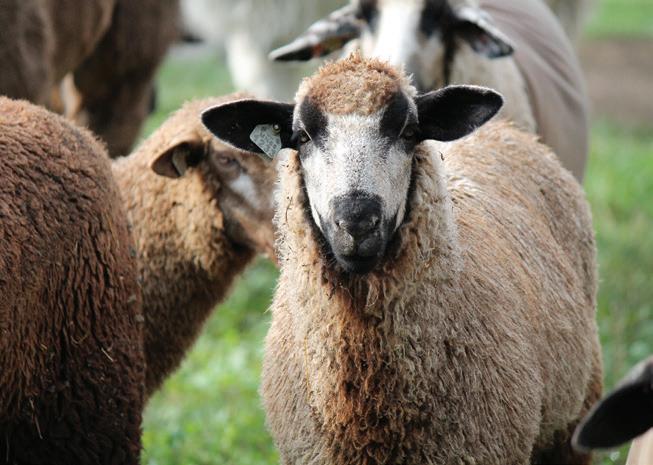
UNITED HORNED HAIR SHEEP ASSOCIATION, INC. Non-profit organization representing and registering Black Hawaiian, Corsican, Desert Sand, Mouflon, Multi-horned Hair, New Mexico Dahl, Painted Desert, American Heavy Horned and Texas Dall Sheep. www.unitedhornedhairsheepassociation.org uhhsa@yahoo.com 937-430-1768.-
Ogden Publications, Inc. annot be held responsible for unsolicited manuscripts, photographs, illustrations or other materials.

717.336.4878

www.freedomrangerhatchery.com sales@freedomrangerhatchery.com

WE SPECIALIZE IN FREEDOM RANGER CHICKS; these TriColored & Red feathered chickens grow to 5-6 lbs in 9-11 weeks. We also offer Novogen Brown egg layers, French Guinea Keets, Silkies, Khaki Campbell Ducklings, and White Muscovy Ducks.
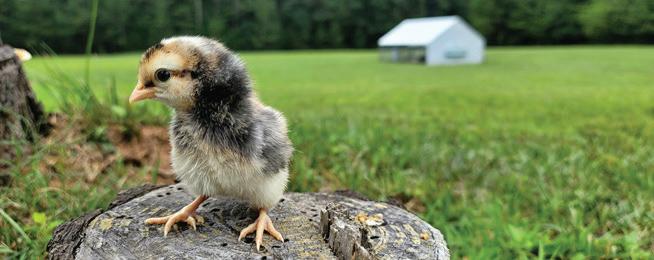
CHICKEN SCRATCH POULTRY: Maline, Crested Cream Leg bar, Ayam Cemani, Chocolate, Jubilee, Lavender, and Black Orpingtons, Black Copper Marans, Blue Copper and Splash Marans, Ameraucana, Rumpless Araucana, Light Sussex, Coronations Sussex, Welsummer, Olive Egger, Blue Laced Red Wyandotte, Silkies and Heritage Rhode Island Reds. Larry & Angie McEwen 14025 County Rd 975E McLeansboro IL, 62859. 618-643-5602 www.chickenscratchpoultry.com
Canada Post International Publications Mail Product
Sales Agreement No.


40601019; Subscriptions: $24.95 for one year in the United States and its provinces; $31.95 per year in Canada and $35.95 per year foreign, prepaid in US funds.
(CANADA GST NBR, 89745 1720 RT0001)
Grit does not recommend, approve or endorse the products and/or services offered by companies advertising in the magazine or on the website.

www.Grit.com 75
POULTRY
SHEEP
OPEN REGISTRY FOR HIGHLAND CATTLE Contact for a free informational packet. www.heartlandhighlandcattleassociation.org www.highlandauction.com heartlandhighlandcattle@gmail.com 417.345.0575 or text 417.733.3201 www.heartlandhighlandcattleassociation.org Order Online or Call Today! stumphousefarms.com 864.940.9871
ALTERNATIVE ENERGY
OUTDOOR WOOD FURNACE
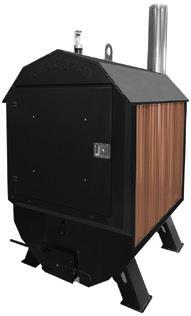
The industry leader in proven clean burn technology
• All Fire no smoke.
• Combustion efficiency 99.5%
• Burns up to 60% less wood
• 7 industry firsts
• Carbon neutral
• Oldest renewable energy.

• Compatible with off-grid use
BOOKS
GARDENING/RELATED PRODUCT
HAND PUMPS
CONTACT
Ultimate Outdoor Furnace LLC
Les Radcliffe
507-254-0622
Polar Furnace Factory Rep Dealer/ Agent opportunities
www.ultimateoutdoorfurnace.com

PUMP WATER UPHILL. No gas or electricity with Ram or Solar Pump. Free Energy-Sun or Gravity. 800-227-8511. www.theramcompany.com
CALL 866-848-5416
TO ADVERTISE IN THE NEXT ISSUE OF GRIT
AWARD-WINNING NOVEL set in rural Ohio in the 1960's. Inspiring for all ages and seasons.
$14.99 at all online bookstores. www.herewiththewinter.com

COINS
www.TreasureChestMint.com
(844) 577-5388
Gold & Silver: Bullion & Coin Lowest retail prices in the USA!

CRAFTS
SEATWEAVING SUPPLIES, chair cane, reed splint, Shaker Tape, fiber & natural rush. Complete line of basketmaking supplies Waxed linen cord. Royalwood Ltd., 517-MEL Woodville Rd., Mansfield, Ohio 44907. 800526-1630. www.RoyalwoodLtd.com
FREE
SOON Church/Government uniting,suppressing RELIGIOUS LIBERTY enforcing NATIONAL SUNDAY LAW. Be informed!
TBSM, Box 374 , Ellijay, GA 30540 tbsmads@yahoo.com
1-888-211-1715.
FREE BIBLE STUDY COURSE Write: Know Your Bible, Box 157, McEwen, TN 37101.
SCYTHESUPPLY.COM
European scythes. Mow where your tractor can’t go. Custommade handles(snaths). 496 Shore Road Perry, Maine 04667 207-853-4750, Free Catalog. www.scythesupply.com, FREE hat with scythe outfit: use code GRT at checkout.
HAND PUMPS: ALL STAINLESS STEEL FOR YOUR WATER. WELL OR CISTERN. 5 MODELS TO CHOOSE FROM. NO ELECTRIC NEEDED. FOR MORE INFORMATION WRITE TO JONAS & MATTIE'S STAINLESS HAND PUMPS, 564 CLYDE MARENGO RD. CLYDE, NY 14433.
HEALTH
100% ORGANIC BLACK SALVE Tablets and Salve HERBAL PLUS PRODUCTS
1-800-996-3203 herbalplusnv@gmail.com
SAVE YOUR SOLES
DIG-RIG Shovel Attachment Makes digging easy Made in USA $17.24 Shipping Included. Order Now 256-718-0676. 4140 Helton Dr., Florence, AL. 35630. www.digrigshovel.com
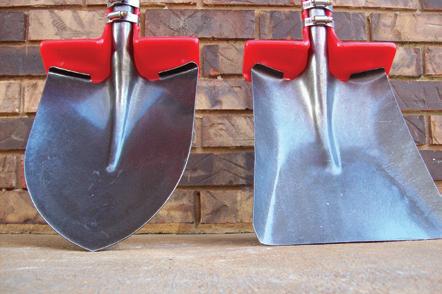
GIFTS MADE IN THE USA
Old Fashion Hand Made CLOTH DOLLS, Sunbonnets, Doll Clothes, American Made in Kansas. Free Catalog. Shipped only by US Postal Service. 913-856-6757

GREENHOUSES
BUILD WITH PVC

HOUSEHOLD PRODUCTS
TRY THIS BEFORE PUMPING your septic system or replacing your drain field! Accelerator by Dr. Pooper Drain Field Cleaner is a revolutionary non-toxic commercialstrength septic treatment that clears organic solids from septic tanks and drain fields. Money-back-guarantee! Order at DoctorPooper.com
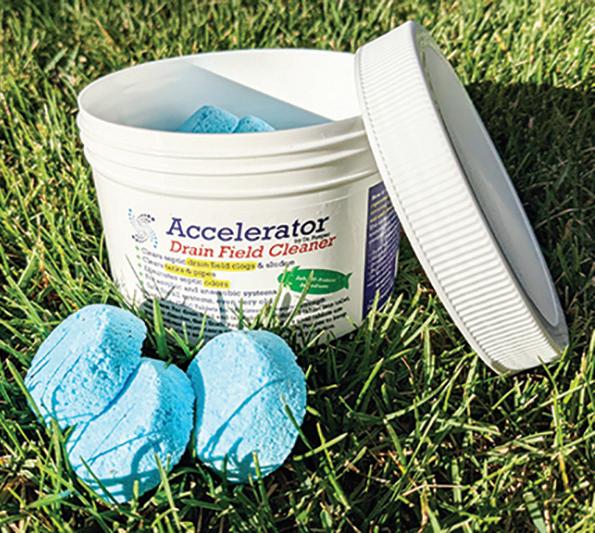
COOKIE CUTTERS Order our catalog now for only $10 (Refundable via credit voucher when your total orders for the 2023 calendar year reach $25.00) Over 700 shapes, designs, & sets covering all holidays & many subjects. Mail check, money order to: Cape Cookie Cutter Company, PO Box 424, Cape Girardeau, MO 63702.
-Specialized Fittings -
-Free Plans -
-Snap Clamps & PVC KitsCirco Innovations, Inc. 877-762-7782
www.circoinnovations.com

March/April 2023 76
CLASSIFIEDS
EMAIL classifieds@GRIT.com or CALL 866-848-5416
POLAR G-Class Best Downdraft PORTAGE and MAIN Best Updraft
CLASSIFIEDS
CLASSIFIEDS
MACHINERY, TOOLS, SUPPLIES
PLANTS, SEEDS, FLOWERS
POULTRY
POULTRY
CROSSCUT SAWS: Saw tools, knives, firewood-cutting, people-powered tools. Catalog $1.00. ($3.00 Canada/ Overseas). Crosscut Saw Company, PO Box 7875, Seneca Falls, NY 13148; 315-568-5755; CrossCutSaw.com

MUSIC
GOSPEL PIANO CDS Hymns, gospel songs from days gone by! All instrumental (no singing). Great for retirees, housewives, quilters, farmers, travelers, everyone! Free brochure. Jacky Campbell, 216 Spokane Rd, Natchez, MS 39120. bennycampbell495@yahoo.com
PERSONALS
CHRISTIAN SINGLES CATALOG. Photos. Penpals. Sample $1. Singles, Box 310-GT , Allardt, TN 38504. 931879-4625. www.nicesingles.com
PLANTS, SEEDS, FLOWERS
TURTLE TREE BIODYNAMIC SEED
INITIATIVE Pioneer of seed transparency offering Organic and Heirloom Openpollinated Vegetable, Herb and Flower seed. Located in Camphill Village since 1998. Free Catalog: turtle@turtletreeseed.org 1 (800) 930-7009. www.turtletreeseed.org
WWW.GRANDPASORCHARD.COM
The best fruit trees and growing tips for the backyard fruit grower. Huge variety selection. Grandpa's Orchard, LLC, Coloma, MI 49038 Phone 877-800-0077.
CALL 866-848-5416
TO ADVERTISE IN THE NEXT ISSUE OF GRIT
PACKETS AND BULK
Vegetables Herbs Flowers Fast Shipping Order online TOLL FREE 844-254-7333. www.burrellseeds.com


HATCHING YOUR OWN CHICKS is fun, easy and affordable with Brinsea Forget Styrofoam incubators and watch your eggs hatch every time. Quality incubators since 1976durable, easy to clean, user friendly digital controls and 3-year warranty. Free color catalog.

www.Brinsea.com
1-888-667-7009.
SOUTHERN EXPOSURE SEED EXCHANGE
Open-pollinated, Heirloom & Organic Seeds & Garlic selected for flavor and local adaptability. Free Catalog 540-894-9480. www.southernexposure.com
POULTRY
MYERS POULTRY FARM - FREE CATALOG. Chicks (9 meat varieties), Ducklings, Goslings, Turkeys, Guineas, more. 966 Ragers Hill Road, South Fork, PA 15956, 814-539-7026. www.myerspoultry.com
FREE COLOR CATALOG 203 varieties shipped to your local post office, chickens, rare breeds, bantams, ducks, geese, turkeys, guineas, pheasants, quail, supplies and videos. Since “1936” Cackle Hatchery® PO Box 529, Lebanon, MO 65536, 417-532-4581.
cacklehatchery.com
GO TO
WWW.CHICKENDOORS.COM for the best automated door on the market or call 512-995-0058
TURKEYS, RED PULLETS, CORNISH ROCKS. SCHLECHT HATCHERY, 9749 500TH AVE., MILES, IA 52064. 563-682-7865
www.schlechthatchery.com
KEEPING YOUR FLOCK SAFE has never been easier or more reliable. With only one moving part, no mechanical switches and no calibration ChickSafe are the ultimate rugged, fuss-free automatic coop door openers with 3 year warranty.

www.Brinsea.com
1-888-667-7009.
CHECK OUT OUR AD IN THE MARKET PLACE!!
LOCAL HENS FIND GOOD STUFF
Grown nearby. Join more than 3,000 other farms and connect directly with consumers by listing your farm. Your FREE farm profile can showcase products with farm photos, your farm story, and google map locations where you sell. Made for ALL farms and food types.
WWW.LOCALHENS.COM
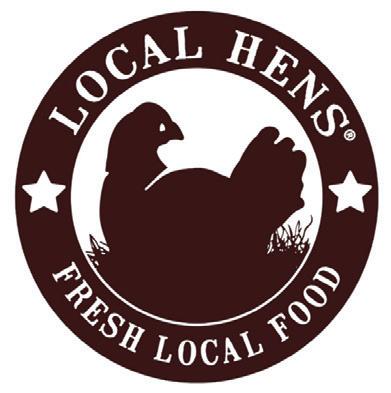
RECIPES
OVER 900 RECIPES by Amish and Mennonite cooks. Gluten free section. $20.00 postpaid. Rufus and Rachel Zook, 440 N Galbraith Road G, Mio, MI 48647.

SHUTTERS
THE EGG CARTON STORE Best Prices, selection, high quality. 40 years of egg packaging and marketing expertise! Egg Cartons, Filler Flats, Stamps, Egg Cases, Nesting Boxes, Supplies, Poultry Care, Custom Cartons and Labels Call for GREAT wholesale/pallet quantity pricing! 866-333-1132. FREE SHIPPING on all cartons and filler flats.
WWW.EGGCARTONSTORE.COM
CLASSIC CHARMING SHUTTERS
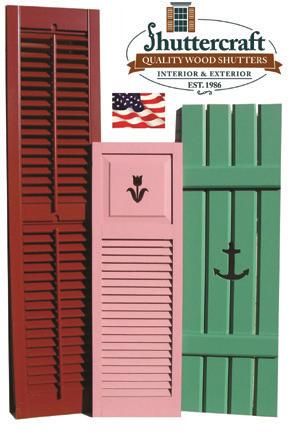
All Types & Sizes, Real Wood Shutters Make All The Difference!
www.shuttercraft.com
Madison, CT - Family Owned Free Brochure (203) 245-2608

www.shuttercraft.com

CLASSIFIEDS www.Grit.com 77
the ultimate gardening tool
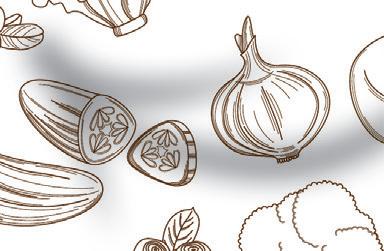

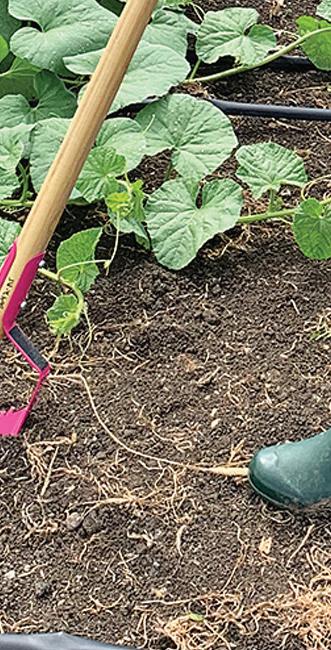

The BGT™ is a patent-pending multipurpose tool that makes weeding, hoeing, digging, and working around yard & garden beds easier and faster. Its triangle-shaped head and open interior minimizes dirt movement. The ergonomically designed and balanced NW-ash handle makes for comfortable hand placement. Each tool is individually numbered and handmade in the USA, and comes with a lifetime warranty.
LIME GREEN

Short Item #8483
Regular Item #8485
Long Item #8487
X-Long Item #8489


$77.00
PINK
Short Item #8484
Regular Item #8486
Long Item #8488






X-Long Item #8490


Order by calling 800-234-3368 or visit Store.Grit.com

PROMO CODE: MGRPANZ2


The Organic Manual uncovers the best-kept secret of gardening, that the organic program is better in every way. Whether it’s growing beautiful landscaping or delicious, healthy food crops, this book explains bed preparation, planting, pest control, and compost making. The organic method is the most efficient, most cost-effective, and most fun of any approach. It also produces the best trees, shrubs, flowers, fruits, and vegetables that you’ll ever grow.
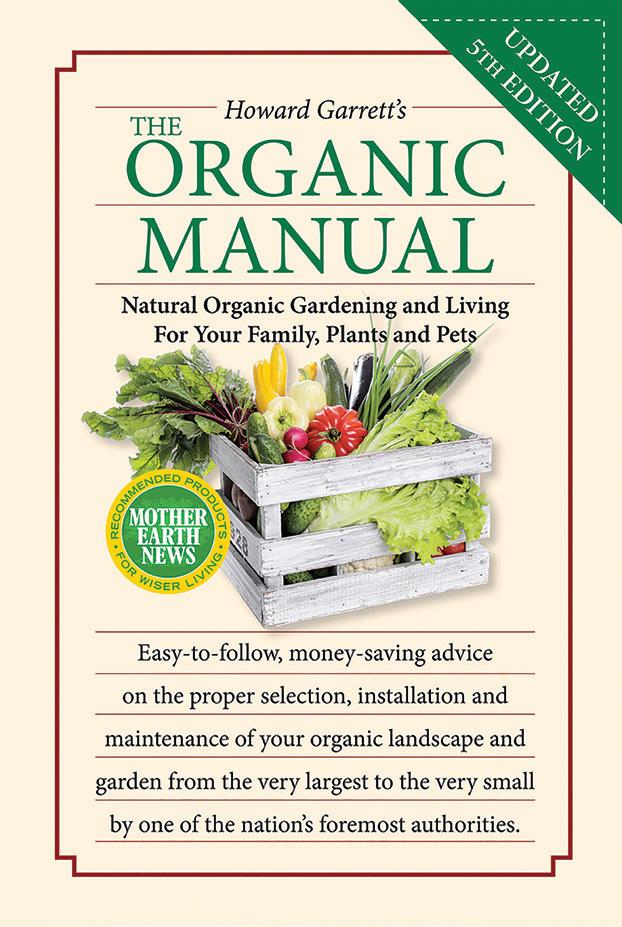

$18.95 Order today for only

CLASSIFIEDS
• High dexterity - ts like a second glove • Light weight with a breathable back. • Griptite soft palms • Washable • $9.90 value! FREE pair of Grip-TiteTM Gardening Gloves with your purchase! GRT_Better Garden Tool-half.indd 1 2/2/2023 12:25:19 PM
THE
by Howard Garrett
Store.Grit.com Item #11726 Promo code: MGRPANZ2
ORGANIC MANUAL
Order by calling 866-803-7096 or visiting
GRT_Organic-Gardening-Manual-half.indd 1 1/24/2023 1:26:23 PM
Better than cannabis, better than CBD
New Joint-Supporting “Miracle Oil”
Capsule Delivers Hip, Knee, and Shoulder Comfort in Just Days
Thousands of Americans are rediscovering normal freedom of movement thanks to a “miracle oil” capsule that’s outperforming hemp in promoting joint comfort.
According to the official figures from the CDC, more than 58 million Americans are living with joint discomfort. This epidemic has led to a search for alternative approaches – as many sufferers seek relief without the harmful side effects of conventional “solutions.”
Anti-aging specialist Dr. Al Sears is leading the way with a new formula he calls “the most significant breakthrough I’ve ever found for easing joint discomfort.”
The capsule is based on a “miracle oil” historically treasured for its joint healthsupporting properties. Marco Polo prized it as he blazed the Silk Road. And to this day, Ayurvedic practitioners rely on it to promote optimal joint health.
Now, with a modern twist backed by science, Dr. Sears is making this natural solution for joint health available to the public.
Your Body’s Hidden “Soothing System”
Joint health research changed forever with the discovery of the endocannabinoid system (ECS) in 1992. Up until that point, research on cannabinoids focused on psychoactive effects. Now, scientists were looking at a new way to fight occasional aches and pains.
Your ECS serves as a central “signaling system” that tells your body how to react to things you do every day. It controls several critical bodily functions such as learning and memory, sleep, healthy immune responses – and your response to discomfort.
A recent study revealed a direct link between the ECS and creaky, sore joints. Researchers at the University of Edinburgh studied the aging of mice with endocannabinoid deficiencies versus “normal” mice.
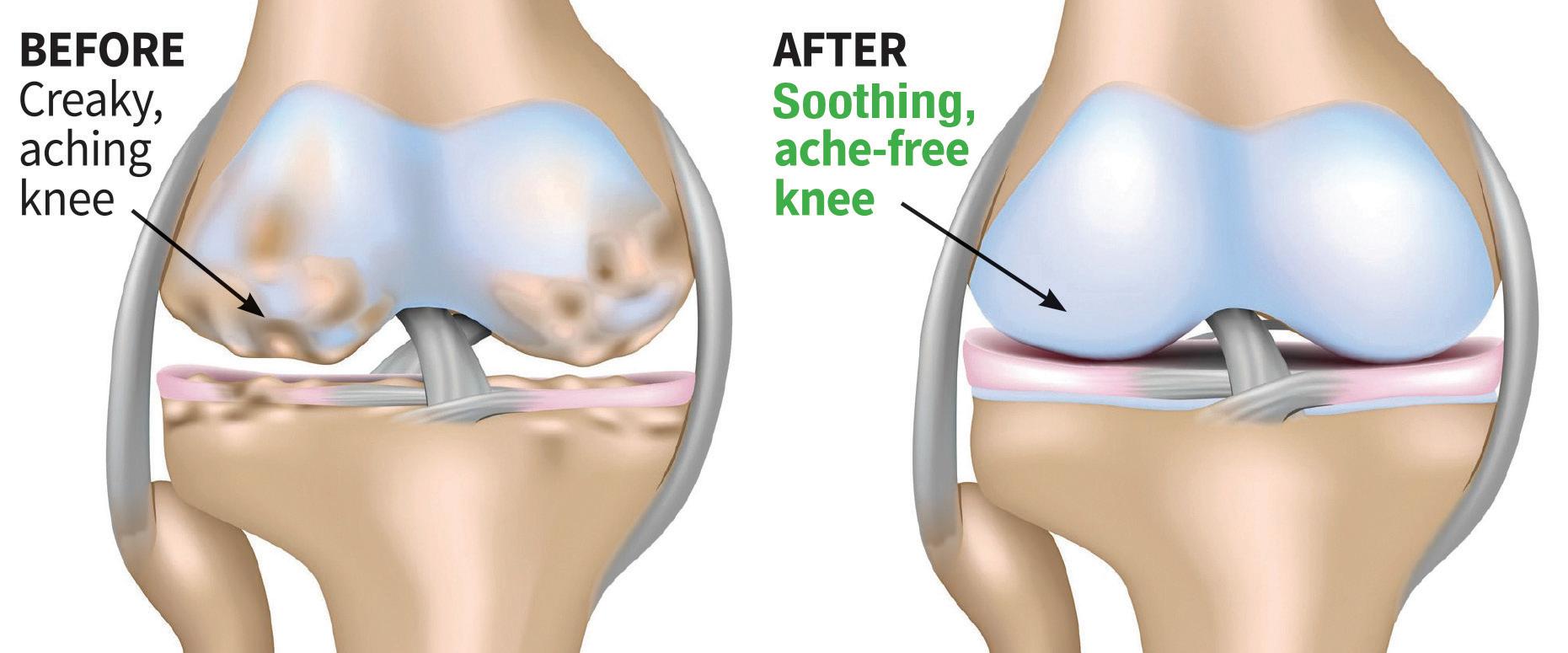
As they aged, the deficient mice had a whopping 60% more joint degeneration than the mice with a healthy ECS.
As the name suggests, the ECS responds to cannabis. At the time it was discovered, scientists assumed that was the best way to support it. But thanks to Dr. Sears’ all-natural solution, you can power up your ECS without marijuana.
“Calling it the ‘endocannabinoid system’ was a misnomer from the very beginning,” Dr. Sears explained. “Modern research reveals that you don’t need cannabis to activate this incredible system. You don’t need to ‘get high’ to get joint relief.”
A scholarly review found that plants and herbs that don’t produce mind-altering effects can support the ECS and help it maintain its healthy functions.
This includes common foodstuffs, such as kava, chocolate, black pepper, and most significantly – the star ingredient to Dr. Sears’ own Mobilify formula - frankincense.
Modern scientists say this natural ingredient meets “cannabinoid tetrad” – the signs used to determine if something supports the ECS. While it doesn’t produce a “high” like cannabis does, it binds to the same receptors to support a healthy response to discomfort.
All the Benefits of CBD –Without Cannabis Indian frankincense, the chief ingredient in Mobilify, has been shown to provide all the benefits of cannabis without any feelings of sluggishness or sleepiness.
And studies show that users don’t have to wait long for the comfort they’re looking for.
In a study published in the International Journal of Medical Sciences, 60 patients with stiff knees took 100 mg of Indian frankincense or a placebo daily for 30 days. Remarkably, Indian frankincense “significantly” supported healthy joint function and relieved discomfort in as little as five days.
Additional research linked regular use to lasting comfort.
In another study, 48 participants were given an extract made from frankincense for 120days. When the results came in, researchers determined the extract strongly supported joint comfort – especially in the knees.
These results were all achieved without marijuana. Research continues to back up the idea that you can support smooth, strong, and healthy joints naturally – without tiredness or sluggishness.
Get Moving Again with Mobilify Mobilify has already helped thousands of Americans stay on their feet and breeze through
their daily activities with ease.
One user even reported getting results the same day it was used.
“Mobilify really helps with soreness, stiffness, and mild temporary discomfort,” Joni D. said. Larry M, another user, compared taking Mobilify to living a completely new life.
“After a week and a half of taking Mobilify, the discomfort, stiffness, and minor aches went away…it’s almost like being reborn,” he said. Dennis H. said it helped him get back to his favorite hobby.
“I can attest to Mobilify easing discomfort to enable me to pursue my golfing days. Definitely one pill that works for me out of the many I have tried,” he said.
How to Get Mobilify
Right now, the only way to get this powerful, unique Mobilify formula that clobbers creaking joints without clobbering you is directly from Dr. Sears. It is not available in stores.
To secure your bottle of this breakthrough natural joint discomfort reliever, buyers should call with Sears Health Hotline at 1-800-3049908. “The Hotline allows us to ship the product directly to customers.”
Dr. Sears believes in this product so much, he offers a 100% money-back guarantee on every order. “Just send me back the bottle and any unused product within 90 days, and I’ll send you your money back,” said Dr. Sears.
The Hotline will be taking orders for the next 48 hours. After that, the phone number may be shut down to allow them to restock. Call 1-800-304-9908 to secure your limited supply of Mobilify. If you are not able to get through due to extremely high call volume, please try again! Call NOW to qualify for a significant discount on this limited time offer. To take advantage of this exclusive offer use Promo Code: MBGRIT1 when you call.
ADVERTISEMENT
THESE STATEMENTS HAVE NOT BEEN EVALUATED BY THE FOOD AND DRUG ADMINISTRATION. THIS PRODUCT IS NOT INTENDED TO DIAGNOSE, TREAT, CURE OR PREVENT ANY DISEASE. RESULTS MAY VARY FROM PERSON TO PERSON. NO INDIVIDUAL RESULT SHOULD BE SEEN AS TYPICAL. 8
The active ingredient in Mobilify soothes aching joints in as little as 5 days
I Know Beans
I know butter beans, And pintos and limas and navies. I know kidneys and cowpeas, And why runners are wavy.
I know bush beans and favas. I know common beans unsung. I know black, white, red, and green beans. I love me some simple, striped mung.
I know jack beans and soybeans, Dressed-up haricots verts — delicious! I know soaked, simple cranberry beans, And back-porch, dried leather britches.

Don’t tell me I don’t know beans. That’s a hill of a bean thought obscenely. I’ve fed on the great northern light beans. I’ve had Italian bread and cannellini.

I know sprouts and shellies, Even garbanzos, black-eyed peas with jowl in the pot. I know adzuki, edamame, ‘Texas Pole,’ and ‘Kentucky Wonder.’ I even know jelly beans. Step back: The mic is gonna drop.

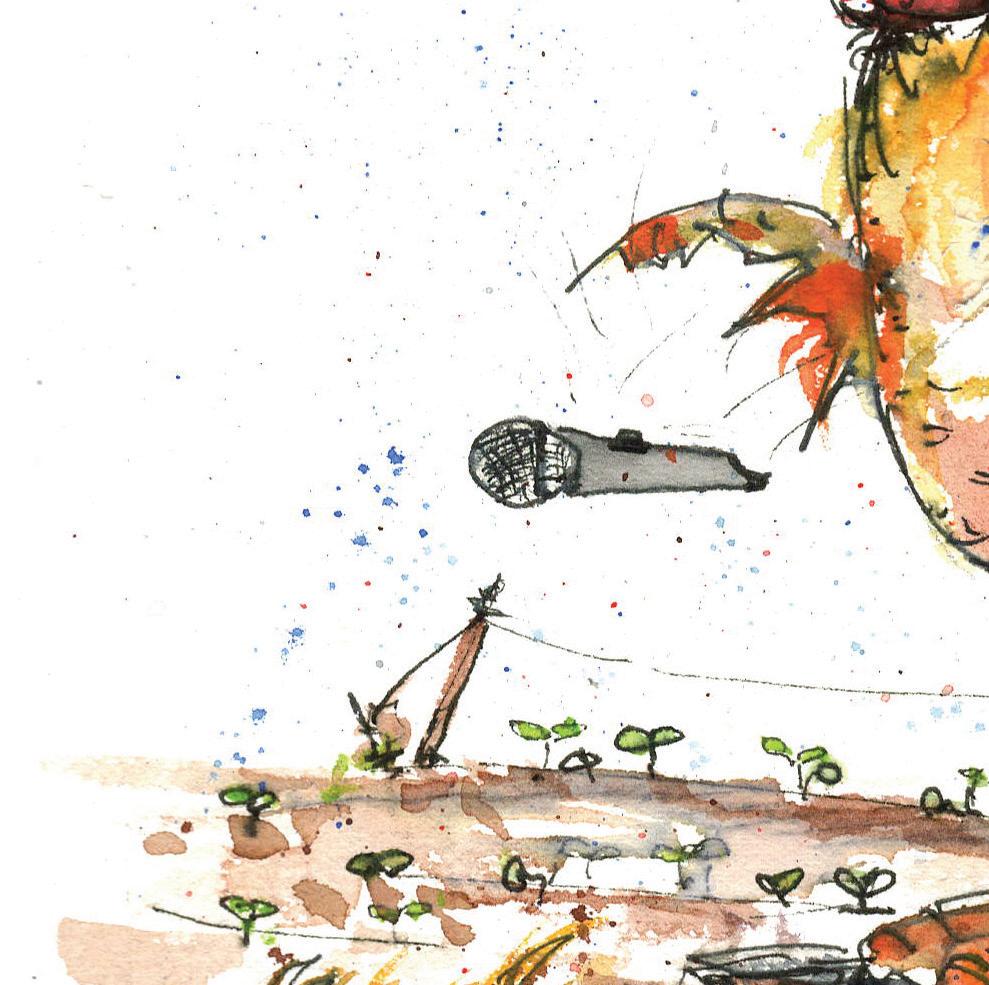
Don’t tell me I don’t know beans. By the way, before you ask, I know corn too. Scratching the ground, grubbing around, It’s just what us farm roosters do.






So, grab that hoe, grab that rake, Scoop a bowl of my favorite brown bunch, A slab of fat back or ham hock, and butter that cornbread. I had be — bean… uh ‘cuse me… I had beans for lunch.

M ICHAEL H AUN
Back in the day, things were made to last. Made to last for a lifetime or two. Call us old-fashioned, but we agree. That’s why our hand-powered mills are backed by an heirloom guarantee. Our durable mills will help you grind your own whole grains, coffee, nuts and seeds. They are hand-built here in the U.S. for dreamers, doers and cultivators like us. Made in Montana ~ grainmaker.com ~ 855-777-7096~406-777-7096




F rom seaside getaways to mountain retreats, the Pacific Yurt goes where you want to be. • Comfortable • Affordable • Easy to Set Up • Eco Friendly Call today 800-944 -0240 yur ts.com Design & price your yurt in 3D at The Original Modern Yurt TM See #19 on page 60





































































 SHEILA CARPENTER ST. CLOUD, MINNESOTA
SHEILA CARPENTER ST. CLOUD, MINNESOTA
 MARILYN GILL VIA EMAIL
MARILYN GILL VIA EMAIL





























 LISA BASINGER ELK, WASHINGTON
LISA BASINGER ELK, WASHINGTON














































































 Both Vi (below) and Deborah (above) have enjoyed cultivating their houseplants.
Both Vi (below) and Deborah (above) have enjoyed cultivating their houseplants.




















































































 Story and photos by Bruce Ingram
Story and photos by Bruce Ingram





 From left: Black-eyed susans, coneflowers, and milkweed are some of the many stunning wildflowers that support native pollinators and provide benefits all year long.
From left: Black-eyed susans, coneflowers, and milkweed are some of the many stunning wildflowers that support native pollinators and provide benefits all year long.











































 By Jenny Underwood
By Jenny Underwood




























































 By Ed Brotak
By Ed Brotak



















 Winter storms can cause a great deal of damage, including downed power lines and widespread power outages.
Winter storms can cause a great deal of damage, including downed power lines and widespread power outages.




















 By Doug Ottinger
By Doug Ottinger











































































































 Double-tilling your garden bed will allow you to add soil amendments while eliminating any dormant weed seeds. Wear safety goggles if applying powders or lightweight fertilizers.
Double-tilling your garden bed will allow you to add soil amendments while eliminating any dormant weed seeds. Wear safety goggles if applying powders or lightweight fertilizers.



 Left: After tilling, break up any large clumps in the topsoil and subsoil. Right: Mulching the garden bed can keep weed seeds at bay and prevent grass roots from appearing.
Left: After tilling, break up any large clumps in the topsoil and subsoil. Right: Mulching the garden bed can keep weed seeds at bay and prevent grass roots from appearing.








































































































































































































































 Conduct a hands-on examination of the item you intend to buy before entering a dickering discussion.
Bring a good attitude into bargaining, and indicate you’re there to buy but not throw money away.
Conduct a hands-on examination of the item you intend to buy before entering a dickering discussion.
Bring a good attitude into bargaining, and indicate you’re there to buy but not throw money away.
























































































































































































































































































































































































































































































































